Short Gokyo Lake Trek 2024-2025
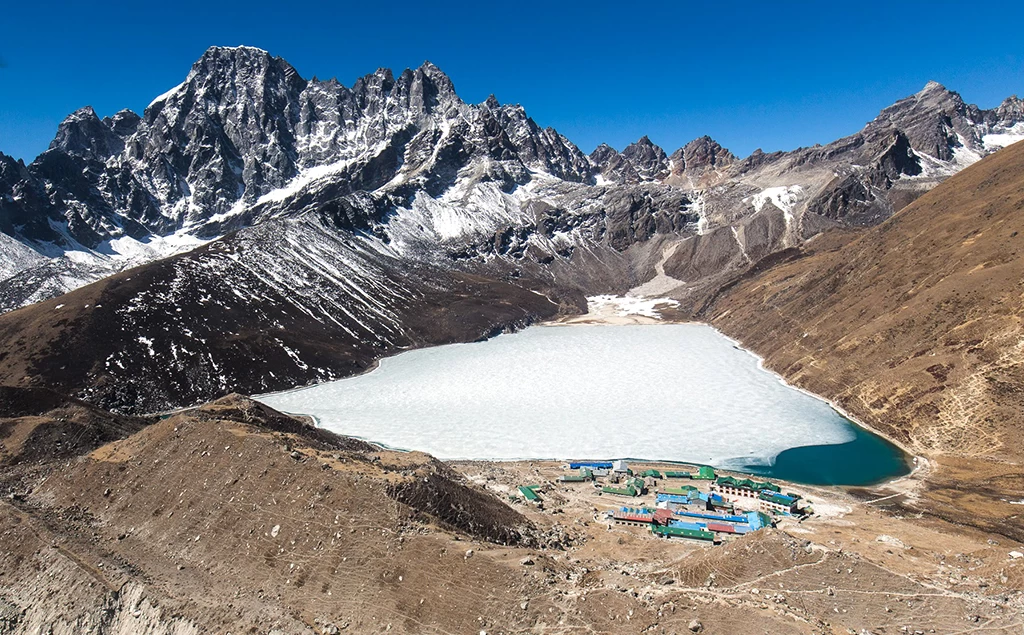
- Duration 10 Days
- Difficulty Level Moderate
- Max. Altitude 5357m.
- Trip Start and End Kathmandu - Kathmandu
- Trip Area Everest Region
- Best Season Spring & Autumn
- Spectacular views of the Himalayan peaks like Everest, Cho Oyu, and Lhotse, as well as some of the world's highest freshwater lakes.
- Visit Gokyo Ri highly popular trekking destination in Nepal.
- A day hike between Dole and Machhermo, which offers views of five stunning Himalayan peaks
- Explore the unique Sherpa culture of the Khumbu region and visit some of their most sacred monasteries
- See lots of different things like forests with rhododendrons, open meadows, and glacial valleys.
- Opportunity to experience a rare glimpse of high-altitude wildlife, including snow leopards and blue sheep.
- Enjoy delicious local dishes throughout the journey.
Gokyo Lake is a really cool trek in Nepal. The primary trek site ranges between 4,700 and 5,400 meters. You can see some of the tallest mountains like Mt. Everest, Makalu, Cho Oyu, and Lhotse from there. Trekking here will be an experience you will never forget!
The trek starts in Lukla, Nepal. You will pass through some of the most beautiful valleys and forests. You can see glaciers and high-altitude lakes, like Gokyo Lake which is special to both Hindus and Buddhists. The best part of the trek is Gokyo Ri (5,357 m). From there you can see four 8,000-meter mountains! You can also visit the highest monastery in the world at Gokyo and explore Ngozumpa Glacier - it's the biggest glacier in Nepal.
You will walk through Sherpa villages, forests, and icy glaciers. In the end, you will reach a beautiful lake called Gokyo. On the way, one can witness some of the most amazing mountain views like Mt. Everest, Lhotse, and Cho Oyu.
Along with a great trekking experience, this trip offers unique cultural insights into the Sherpa life. Additionally, visitors also get to explore several remote monasteries that are scattered throughout the region.
The maximum altitude reached during this trek is 5357 meters at Gokyo Ri and it requires around 11-14 days to complete. September to November and March to May are regarded as the best months for visiting the place. For trekkers who are looking for an alternative to the Everest Base Camp Trek , this can become the best choice.
When you go on the trek, some days will have hills that are hard to climb. Some days will have hills that are hard to go down. But, a well-planned itinerary, proper acclimatization, and fitness are key to having a successful trek.
Gokyo Lake Trek is a great experience to explore Nepal's mountains and culture. You can see different landscapes, learn about the culture, and get amazing views. There is something for everyone - even if you have never hiked before or are an experienced climber.

Best Time To Visit Gokyo Lake and Gokyo Ri
The best time to visit Gokyo Lake and Gokyo Ri is from September to November and March to May. These months offer clear skies and excellent visibility, making it easier for trekkers to enjoy the magnificent views.
The trek can be done throughout the year, however, trekking in winter (December to February) can be difficult due to snow and low temperatures. During the monsoon (June to August) the region receives a lot of rainfall, making it difficult to enjoy the views of the lake and Gokyo Ri. It is therefore best to plan your trip at either end of the season.
Trekkers need to choose the right time to visit to avoid adverse weather conditions and ensure a safe and enjoyable trek. It is also important to plan the trek carefully, being aware of the altitude and terrain. A good knowledge of the local weather conditions and packing suitable clothing will also go a long way towards ensuring a successful trip. With careful planning and preparation, you can enjoy an amazing journey in Gokyo Lake and Gokyo Ri.
Also, check Best Time To Visit Everest Base Camp In 2023
Attractions of Gokyo Lake and Gokyo Ri
While trekking on this route, you can experience several aspects of the Khumbu region along with the scenery. You will never forget the hospitality you get from the Sherpa people from this region while you might want to stick in the place forever.
Scenarist Beauty
The whole of the Khumbu region offers stunning views of the Himalayas and its surrounding landscapes. Trekkers can enjoy panoramic views of Mt. Everest, Lhotse, and Makalu. The trek passes through traditional Sherpa villages like Namche Bazaar and Khumjung, offering a glimpse into the local culture.
Along the trail, trekkers can witness beautiful forests of rhododendron and pine trees.
The turquoise-colored Gokyo Lakes surrounded by snow-capped peaks provide a breathtaking sight. The fifth lake is considered sacred by the locals.
The Renjo La Pass offers a spectacular view of the Everest region. The Ngozumpa Glacier, the largest glacier in the Himalayas, can also be seen on the trek. The trek offers a diverse range of scenery, from lush forests to rocky terrain, providing trekkers with an unforgettable experience.
Sherpa Culture
This trek offers trekkers the opportunity to experience the Sherpa culture. Sherpas are a community of mountaineers who live in the Himalayan region and are known for their expertise in high-altitude climbing.
During the trek, you can visit the Sherpa Cultural Museum in Namche Bazaar, which provides information on various aspects of Sherpa culture. Additionally, you can also interact with local Sherpa people, taste their cuisine, and learn about their way of life.
Is the Gokyo Lake trek right for me?
This trekking is a physically demanding trek that involves high altitudes and challenging terrains. It may not be suitable for children, seniors, or people with disabilities. However, if you are physically fit and have some trekking experience, you may be able to undertake this trek.
It's essential to consult with a medical professional before embarking on the trek and to ensure that you are adequately prepared physically and mentally. Himalayan Scenery Treks can help assess your capabilities and recommend alternative treks that may be more suitable for you.There are also several shorter trekking options available in the region that can be less physically demanding. It's essential to consider your personal capabilities and limitations before deciding to undertake any trekking. With the right preparation and guidance, you can have an enjoyable and rewarding experience trekking in the beautiful Himalayan region.
Preparing for Gokyo Lake Trek
Before embarking on the Gokyo Lakes trekking, it's important to focus on physical fitness by engaging in regular exercise and training. Learning the local language and cultural values can also enhance the trekking experience.
Acclimatization is essential to prevent altitude sickness, and trekkers should allow time for their bodies to adjust to the higher altitudes. Himalayan Scenery Treks can provide personalized guidance for a successful trek by offering information about the trek and the necessary equipment.
Trekkers should also pack appropriate clothing, footwear, and gear for the trek, and carry sufficient water and snacks. It's essential to stay hydrated and nourished during the trek to maintain energy levels.
With proper preparation and guidance, trekkers can have an enjoyable and rewarding experience while trekking to the beautiful Gokyo Lakes.
Trekking Options
There are several variations of the Gokyo Ri trek, including the different routes. Trekkers can choose the variation that best suits their fitness level and time constraints. There are also alternative trekking routes, such as the Bupsa-Salleri route, that can be taken to reach Gokyo Lake.
Why choose Himalayan Scenery Treks for Gokyo Lake Trek?
We, at Himalayan Scenery Treks and Expedition , are a company in Nepal that takes people on exciting adventures. For the past 17 years, we have always prioritized our clients’ safety, comfort, and satisfaction. This service is the reason why we have a huge number of our clients.
To date, we have completed over 1000 tours of the Everest base camp. More than 8000 trekkers from all over the world have completed the trek with us. We are proud to say that we have amazing 5.0-star reviews on Trip Advisor .
Day 1 Fly to Lukla and trek to Phakding 2840m.(9320 ft.) - Approx. 4 hrs.
The journey to the stunning Gokyo region starts with a scenic flight to Lukla. Our team will take you to the TIA. The 45-minute flight offers spectacular views of the Himalayas and lush green hills.
Once we arrive at Tenzing-Hillary Airport, we'll meet other members of our trekking group and hike to Phakding on the same day.
Day 2 Trek to Namche Bazaar 3,440m.(11290ft.) - Approx. 6hrs.
We begin our trekking in this region with a gradual descent to Cheplung village. This village offers a beautiful view of Khumbila Mountain, a sacred mountain that gives its name to the entire region.
We continue along the trail, descending gradually through the settlement of Phakding. We pass through pine and rhododendron forests and cross a couple of suspension bridges over the Dudh Koshi River to reach Monjo, the entrance of Sagarmatha National Park.
We then cross another suspension bridge to pass through the village of Jorsale before walking along a steep trail up towards the Sherpa hub of Namche Bazaar. We can see the first view of Everest from Larja Dobhan and the view of Everest and Lhotse before reaching Namche.
We will stay overnight in Namche Bazaar.
Day 3 Rest day in Namche Bazaar
Today, we have a free day for acclimatization in Namche Bazaar, a culturally rich city popular with trekkers and mountaineers. This bustling city offers a range of government offices, bars, cafes, restaurants, shops, and colorful markets for trekkers to explore.
Trekkers can visit the Sherpa Cultural Museum to learn about various aspects of Sherpa culture and the Everest Summit or opt for a day trek to Khumjung, Kunde, and the Everest View Hotel.
The day trek offers panoramic views of other mountains such as Everest and Ama Dablam and also allows for exploring ancient monasteries, Hillary schools, and hospitals in Khumjung.
Apart from exploring the city, trekkers can also enjoy observing the flora and fauna at various altitudes during the hike. In Namche Bazaar we will spend the night.
Day 4 Namche Bazaar to Dole 4038m.(13250ft.) - Approx. 7 hrs.
As we leave Namche, the trail offers stunning views of mountains such as Ama Dablam, Everest, and Thamserku while passing by stupas.
The trail then descends into pine and rhododendron forests, and at the fork, we take the left route leading to Gokyo Lakes. Along the way, we pass through Mong village, known for its breathtaking views of Tengboche and surrounding areas.
We enjoy waterfalls, rhododendrons, and the challenge of stone stairs before reaching Dole for the night.
Day 5 Dole to Machhermo 4,470m.(14,300ft.) - Approx. 3 hrs.
The trail on this day is a steep ascent, leading through scrub juniper.
After leaving Dole, there is a gradual climb, with a steeper section at the beginning. The trail affords stunning views of the Dudh Koshi River below and Thamserku as you approach the small village of Machhermo.
Day 6 Machhermo to Gokyo 4,790m.(15,700ft.) - Approx. 5 hrs.
This is actually a day hike of around 7 to 8 hours.
After half an hour of the journey’s beginning, the gradient becomes gentle, leading to the ridge above the village of Machhermo. From there, hikers can admire the stunning views of Thamserku while walking through a narrow valley that gradually widens.
Though there are a few short steep sections, the trail isn't too tiring overall. After descending to the Dudh Koshi River, the first Gokyo Lake and Ngozumpa Glacier come into view.
Once we reach the Gokyo Valley we will take a rest here and prepare for a beautiful day tomorrow.
Day 7 Visit Gokyo Ri in the morning and Return to Machhermo 4,470m.(14,300ft.) - Approx. 8 hrs.
Today, early in the morning we will continue toward the North and see the second Gokyo Lake.
As we move further, the third lake and a cluster of teahouses come into sight.
From here you can see the Gokyo Ri, a viewpoint that offers a panoramic view of the mountains above and the lakes and glaciers below.
After lunch here, we will return back to Machhermo, which will take around 7 hours to complete.
Day 8 Machhermo to Namche Bazaar 3,440m.(11290ft.) - Approx. 6hrs.
Leaving early in the morning, start trekking towards Namche Bazaar.
The lively atmosphere and bustling streets of Namche are a welcome contrast to the tranquility of smaller villages.
Spend the last night of the trek in Namche Bazaar before heading back to Kathmandu the next day.
Day 9 Namche Bazaar to Lukla 2840m.(9320 ft.) - Approx. 6hrs.
Follow the Dudh Koshi River, cross the suspension bridges you crossed at the beginning of your trek, and you will reach Lukla. Here, we will spend the night and wait for our flight back to Kathmandu early the next morning.
Day 10 Fly to Kathmandu and rest in Hotel- 30 Mins.
This day wrapping all memories with you of Gokyo, you fly back to Kathmandu.
Rest in your hotel, if you’re not tired then just roam the alleys of the city.
Not satisfied with this regular itinerary?
Are you thinking to plan your custom trip now.
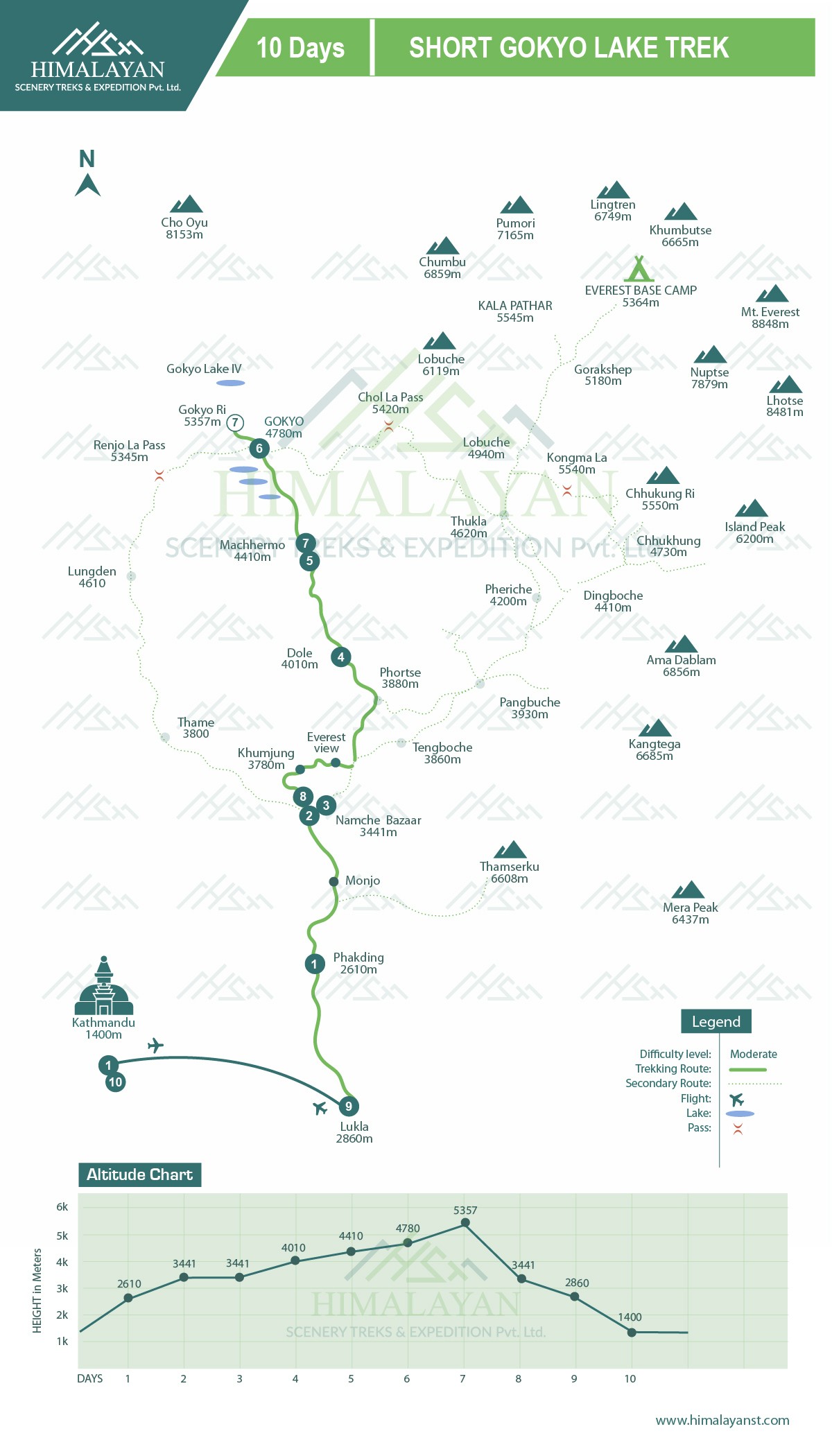
Cost Details
- Pick up from your respective Hotel/ given Location
- Comfortable private vehicles for ground transportation as per itinerary
- Your meals (breakfast, lunch, and dinner) during the trek
- Best available twin-sharing room for lodge accommodation during the trek
- Domestic flights (Ramechhap(Manthali) - Lukla – Ramechhap(Manthali) or Kathmandu-Lukla-Kathmandu
- Trekking Guide-One highly experienced, helpful, and friendly guide.
- Porters (1 porter for 2 trekkers) and their food, accommodation, salary, and equipment.
- Accident insurance for all staff
- Himalayan Scenery Brand Cap, Duffel bag & trip achievement certificate (Upon completion of the trek)
- First aid kit, oximeter for checking pulse, oxygen saturation, and heart rate at higher altitude
- Entry Permit for Sagarmatha National Park and TIMS (Trekkers' Information Management System) Card Fee (Required: 2 passport size photos)
- $20 - Local Government Tax
- Assistance with rescue and evacuation (Insurance is required for evacuation)
- Personal travel insurance
- Kathmandu city tours, tour guide, and private transportation (Day 2)
- International airfare
- Visa Fee: (Available upon arrival at Tribhuvan International Airport in Kathmandu)
- Snacks/drinks and other personal expenses
- Single Supplement Fee- $200
- Personal trekking gear
- Gratuity for team members
Useful Info
Trekkers should be aware of the potential safety risks associated such as altitude sickness and hypothermia. It’s important to hire a knowledgeable guide, be properly equipped for the trek, conduct adequate research before your journey, and make sure you understand the environment and climate of the area. By being prepared and taking the necessary precautions you can enjoy this unique trek without any worries.
It is also important to note that the Khumbu is a conservation area and therefore, trekkers need to obtain permits before starting the trek. The permits are relatively easy to obtain and the cost is minimal.
Difficulty of Gokyo Lake Trek
The route is moderately challenging with risks like altitude sickness, hypothermia, and snow. Proper acclimatization and physical fitness are much important otherwise might result in difficult conditions.
The trek involves a gradual ascent to higher altitudes. Altitude sickness can affect anyone in the mountains, even if they are physically fit. Symptoms include headaches, nausea, and fatigue.
Hypothermia can occur due to cold temperatures at higher elevations. Snow-covered paths can make trekking more challenging. The trek requires an average of 6-7 hours of walking per day.
The trail is rocky and steep at several points. Trekking poles can be helpful for stability. Overall, the trek to Gokyo Lakes requires good physical fitness, proper acclimatization, and careful planning to ensure a safe and enjoyable experience.
Guide requirement for Gokyo Lake Trek
Guides are required during the trek to Gokyo Lakes due to the government's regulation to promote tourism and ensure the safety of trekkers. Unlicensed guides are not allowed to work as they can mislead trekkers or put their lives at risk.
The guides are trained and experienced in handling potential risks such as altitude sickness and changing weather conditions.
Himalayan Scenery Treks provides experienced and friendly guides who have been praised by previous trekkers. Our guides are knowledgeable about the trek and the local culture, making the trek more meaningful. They also ensure that the trek is enjoyable and safe for the trekkers.
Our guides are cost-friendly, making it an affordable option for trekkers. By hiring our guides, trekkers can avoid any legal complications and fully enjoy the trek. With the help of our guides, trekkers can experience the beauty of the Gokyo Lakes and the surrounding Himalayan landscape without any worries.
Permits needed for Gokyo Lake Trek
Foreigners need a Sagarmatha National Park permit and a TIMS card, costing around USD 40-50. Permits ensure proper tracking and safety measures, and Himalayan Scenery Treks can always assist in obtaining them.
Gokyo Lake Trek Safety
The trek to Gokyo can be safe if proper precautions are taken. These include having travel insurance to cover any medical emergencies, acclimatizing to the altitude, and hiring local guides.
Additionally, swimming in the Gokyo Lake is not recommended due to its freezing temperatures, which can cause hypothermia.
In the past, there have been accidents reported in Gokyo Lake due to swimming. In 2018, a trekker drowned in the lake while attempting to swim. Therefore, it is essential to follow the guidelines and avoid taking unnecessary risks during the trek.
Trekkers should also be prepared for changing weather conditions, carry adequate gear, and stay hydrated. The trail can be slippery and rocky, so it's crucial to be cautious while trekking. By taking the necessary safety measures, trekkers can have a safe and enjoyable experience while exploring the beautiful Gokyo Lakes.
Foods and Accommodation during Gokyo Lake Trek
During your walks, you can find teahouses with meals like dal bhat and momos. Western options like pasta and sandwiches are available too. Food options become limited at higher altitudes. Bring snacks for supplementation.
It is important to note that the food options can become more limited as you ascend higher in altitude. At higher altitudes, it can be more challenging to transport food, and some items may become more expensive. Therefore, it is advisable to bring some snacks like energy bars or nuts to supplement your meals.
As for accommodation, teahouses are available along the route. These are basic lodges with simple amenities like a bed, blanket, and pillow. The rooms are usually shared, and the bathrooms are mostly communal, but they are clean and adequate for trekking needs.
Accommodation becomes more basic at higher altitudes. Food and accommodation are basic but adequate. Resources are limited in remote areas. Be flexible and open-minded about food and accommodation options.
Q1. How long is Gokyo Lake Trek?
The Gokyo Trek is typically completed in about 11 days. This will cover a total distance of around 44 miles (71 kilometers).
Q2. How hard is the Gokyo Lake Trek?
The Gokyo Lake Trek is considered to be moderately difficult, with a mix of uphill and downhill terrain, as well as altitude-related challenges.
Q3. Is Gokyo Ri difficult?
Gokyo Ri, which is the highest point of the trek, can be quite challenging due to its steep ascent and high altitude. However, it is generally considered achievable with proper acclimatization and preparation.
Q4. Which season is best for Gokyo Lake Trek?
The best time to do the Gokyo Lake Trek is during the spring (March to May) or autumn (September to November) seasons. These periods offer clear skies, comfortable temperatures, and great views of the surrounding mountains.
Client Reviews
A great experience 100% recommendable
We did the Annapurnas sunrise + 2 days in Pokhara. The Annapurna sunrise was fantastic. The views are spectacular. Our guide, Amar Maga, recommended we change the initial itinerary and it was the best idea. We did a very beautiful trek with a fantastic accomplishment, Amar (guide) and Dawa (porter). 100% recommendable (trip + Amar + Dawa)
Memorable trip to Nepal
Just returned from one of the best trips of my life visiting the beautiful country of Nepal with a group of friends.Nepalese seem to be one of the most friendly and trustworthy people .Visited Kathmandu and then a tour to Pokhara ,trekking up to Pun hill to have a grand vista of Annapurna range. The guide, Amar was very supportive and friendly, and looked after all of us well. We had to change our trekking plans he was quite accommodative and got everything sorted out for us and did his best to make sure we had the best possible experience both culturally and in trekking. Safari at Chirwaan and we were lucky enough to have a glimpse of Bengali Tiger and a bear, and quite a few Rhinos. Now back home with memories to treasure for a life time.

Short Gokyo Lake Trek 2024-2025 Guides
- Why trek Everest Base Camp in 2022/23
- Why People Love Everest Base Camp Trek With Us?
Related Trips
Everest base camp drive, trek in-fly out 2024-2025, nepal bhutan tour - 12 days, 10 days nepal bhutan tour, send inquiry.
We use cookies to ensure that we give you the best experience on our website.

The Gokyo Lakes Trek Itinerary: the ultimate guide
This post offers you the ultimate Gokyo Lakes trek itinerary. The Gokyo Lakes trek in Nepal is a wonderful trek that brings you to a chain of six turquoise, glacial-fed lakes in the Everest region. At around 5000 meters it is the highest freshwater lake system in the world.
Despite the spectacular views of the deep blue lakes surrounded by the snow capped peaks of the Himalayas, the Gokyo Lakes trek attracts less people than the more famous Everest Base Camp trek.
Up till Namche bazaar the Gokyo Lakes trek follows the same itinerary following the Dudh Kosi river and the Khumbu valley. Before Tengboche the path branches off climbing over the Monjola pass entering the high altitude Gokyo valley.

Why choose the Gokyo Lakes Trek
The Gokyo Lakes trek is a great alternative to escape the crowds on the Everest Base Camp trek. For many tourists the idea of making it to Everest Base camp is something romantic. As a result, you will find hundreds of people on the trail in the high season.
But the Gokyo Lakes trek is not only a more quiet option if you want to escape the crowds. It also offers superb scenery. The sight of the turquoise lakes is mesmerizing and from the top of Gokyo Ri you can see 4 peaks above 8000 meters. First of all Everest, but also Lhotse, Makalu and Cho Oyu.
On top of that you can also see the Ngozumpa glacier. This grey wasteland of rocky debris and ice is one of the largest glaciers in the Himalayas. Due to climate change it is shrinking, causing a lake that could flood Sherpa villages down the mountain if it spills over. Like the other glacial hikes I did, visiting the Chalaadi glacier and Shkhara glacier in Georgia, you can see the sad outcomes of climate change in action.
The Gokyo Lakes trek is not that difficult. The trails are easy to follow and do not include steep climbs. I am afraid of heights and the only scary part was a high hanging bridge on the way from Lukla to Namche bazaar.
The biggest challenge on the Gokyo Lakes trek is the altitude. After Namche bazaar you will reach altitudes around 4000 meters with Gokyo village at 4750 meters high. The advice is not to ascend more than 300 meters a day. This means the hiking days after Namche bazaar are relatively short, giving you plenty of time to enjoy the beautiful landscapes.

The Gokyo Lakes Trek itinerary
Day 1: lukla to phakding (2700 meters).
9 kilometers, 4 hours, – 100 meters
For most people this is the first day on the Gokyo Lakes trek if you decide to fly from Kathmandu into Lukla. I decided to start my hiking adventure into the Everest region by doing the Jiri to Lukla trek . Few people still do this trek, but it’s a great way to see the hills and rural life of Nepal.
From Lukla onwards the trail became very busy compared with the days before. More trekkers, more villages, more restaurants and more lodges to choose from.
It was also clear that I was now in the Khumbu region where the Sherpa people live. The Sherpa follow Tibetan Buddhism and almost every village I passed by had prayer wheels, mani stones with tibetan inscriptions and white washed religious buildings.
All day I followed the Dudh Kosi river and decided to break up the journey to Namche bazaar in Phakding. A small village next to the river

Day 2: Phakding to Namche (3440 meters)
8 kilometers, 5 hours, +740 meters
On the second day I continued the hike along the Dudh Kosi river and through pine forests. The trail was busy with trekkers and caravans of donkeys and yaks on their way to Namche bazaar.
I had to cross several suspension bridges over the river. Some at a dizzying height. Soon I reached Jorsale, the last village before the long climb up to Namche bazaar.

Day 3: Namche bazaar
To give your body time to adjust to the altitude it is important to spend a day in Namche bazaar for acclimatization. In fact, if you fly into Lukla the advice is to spend at least three nights in or around Namche bazaar. It is one of the largest towns in the Khumbu region and there are plenty of things to see and do.
You can visit the nearby Sherpa villages of Khumjung, Kunde or Thame on a day hike or just relax at the town itself. After days on the Jiri to Lukla trek it was time for some laundry and indulging in delicious pastries at the Herman Helmers bakery.

Day 4: Namche to Kenjoma (3600 meters)
2 kilometers, 1.5 hours, +160 meters
Some people recommend even three days of acclimatization at Namche bazaar. I decided to stay only two nights in Namche, but hiking only a little bit further on the next day.
Kenjoma is only 2 kilometers from Namche, but it has a nice guesthouse with beautiful views. It is also very close to the Sherpa village of Khumjung that I wanted to explore.
After I dropped my luggage at the lodge in Kenjoma I took a little day bag and hiked up to Khumjung where I had lunch. Khumjung is a small mountain village worth a visit. The local monastery claims to have the scalp of a yeti. You can see it for a small donation and judge yourself.

Day 5: Kenjoma to Mong La (3900 meters)
6 kilometers, 3 hours, +300 meters
So far, the trail is the same as the Everest Base Camp trek, but today the paths will differ. Rather than continuing to Tengboche, the path to Gokyo Lakes branches off with a steep and dusty climb to the Mong La pass at 3900 meters.
With my fear of heights there were a few scary parts. Still I enjoyed this day very much. At the start of the trail I encountered a few yak caravans, but later on the day it was very quiet. The views on the Mong La Pass were a great reward for the effort.
Mong La was one of the few places on the Gokyo Lakes trek where I could still see damage from the earthquake in 2015 . There were only two lodges open, but they both had wonderful views.

Day 6: Mong to Dole (4090 meters)
5 kilometers, 2.5 hours, +190 meters
Today was another short day from Mong to Dole. The path was relatively straight and easy. The fresh morning air was cold and crisp and I passed by several frozen waterfalls that were slowly melting in the rising sun. Probably to freeze over again overnight.
Way before lunch I already arrived in Dole. I could have hiked much further, but felt a slight headache reminding me to stick to the advice of not going too high too fast.

Day 7: Dole to Machermo (4410 meters)
5 kilometers, 1.5 hours, +320 meters
Today I would ascend more than yesterday, but it’s a gentle climb and the hike was very easy. The views on the mountains are simply wonderful and you can see and feel the altitude.
The landscape is more empty and arid with wonderful views all around you. Machermo is a small village. Even with a clear blue sky and a strong sun it was too cold to sit outside for too long.
I spent the afternoon reading books near the stove of the lodge’s dining room and went to the local health clinic for the free daily information session about altitude sickness.

Day 8: Machermo to Gokyo (4750 meters)
7 kilometers, 3 hours, +340 meters
I didn’t think the scenery could become more spectacular and moonlike than yesterday, but it could. The climb up to the first Gokyo lake was steep and difficult and I felt the altitude that forced me to take frequent breaks.
Both the altitude as well as the views took my breath away. It felt like I was on a completely different planet. Then finally the first lake came into view. A deep blue turquoise lake surrounded by rocky snow capped mountain peaks.
The lake was half frozen and I was surprised to see that this desolate icy place was still home to colorful Brahminy ducks and playful marmots. The lakes are in fact an important stopover for migratory birds.

Day 9: Gokyo Ri (5357 meters)
Climbing Gokyo Ri is one of the highlights of the Gokyo Lakes Trek. Unfortunately the mild headache that started the evening before got much worse overnight. At breakfast I didn’t feel like eating anything and all I wanted to do was lay down in my bed again.
These were symptoms of altitude sickness that I could not ignore. With pain in my heart I knew that climbing up to the top of Gokyo Ri would be foolish. Although I planned two full days in Gokyo I decided to head back to lower altitudes.

Day 10: Gokyo – Dole
12 kilometers, 5 hours
From Gokyo you have the choice to walk the same way back or cross the Renjo La pass (5435 meters) and walk back through the Sherpa villages of Lungde and Thame.
Already beforehand I decided not to do the challenging Renjo La Pass and with my symptoms of altitude sickness that was a wise choice. If you are an experienced hiker and well acclimatized it is certainly worth considering though.
Another option is to cross the Cho La Pass and combine the Gokyo Lakes trek with the Everest Base Camp trek or Three passes trek.
I walked the same way back. By the time I reached Machermo my symptoms of altitude sickness were gone. After a nice lunch of daal baat I continued till Dole.

Day 11: Dole – Namche
12 kilometers, 4.5 hours
Today was a lucky day on the trail. Because walking down is easier you have more time to look around you. That is maybe why today I spotted the rare monal pheasant bird and the Himalayan Tahr mountain goat.
Although I was walking the same way back as I came I noticed different things and enjoyed the trail just as much. Back in Namche it was time to treat myself to the comforts that Namche bazaar offers.

Day 12: Namche – Phakding
8 kilometers, 5 hours
It is possible to walk from Namche back to Lukla in one long day, but I decided to break up the journey in Phakding to give me one more day in the mountains.
I got a warm welcome in the guesthouse where I also stayed on my way to Gokyo. The lady still remembered me and I spent the evening in the kitchen watching how she made dal baat adding a local herb jimbu.

Day 13: Phakding – Lukla
9 kilometers, 4 hours
The last day on my one month hiking adventure. Arriving in Lukla I realized I made it and that I hiked all the way from Jiri to Lukla and then to the Gokyo Lakes.
From Lukla I would fly back to Kathmandu. The reason I did not fly into Lukla as well was partly because a friend of mine convinced me that the Jiri to Lukla trek was worthwhile, but also because I was a bit nervous about the flight to Lukla. Lukla airport is one of the most dangerous airports.
In the end it wasn’t as bad as I thought it would be and I arrived safe and well in Kathmandu. My friend was right though that the Jiri to Lukla trek is certainly worth your time and effort .

The Gokyo Lakes Trek Travel tips
The gokyo lakes trek permits.
For the Gokyo lakes trek you need several permits.
Khumbu entrance permit : This permit is necessary once you enter the Khumbu region. You can not get this permit beforehand in Kathmandu. You must buy it in Lukla or Monjo (in case you walk in from Jiri) and it costs 2000 npr
Sagarmatha National Park Entrance Permit ; The actual National Park entrance permit costs 3400 npr. You can get it at the Tourism Board office at Bhrikuti Mandap in Kathmandu or at the checkpoint in Monjo.
Note : In theory, trekkers need to get a TIMS card for every trek they make in Nepal. A Tims Card costs 2000 npr and you need to get this at the Tourism Board Office in Kathmandu. On Everest they felt that most money stayed in Kathmandu. Therefore they installed their own permit (The Khumbu entrance permit). From 2018 they will no longer check your TIMS card in the Everest region. A controversial topic and therefore this situation might change. Check before getting or not getting your TIMS card.

Do I need a guide on the Gokyo Lakes Trek
The Gokyo Lakes trek is moderately difficult, but easy to do without a guide. There is one trail to follow and it is hard to get lost and you will meet plenty of other trekkers on the trail
If you are alone and not that experienced you might want to consider joining a guided trek or hiring a guide, porter or porter guide.
In Nepal there is a clear distinction between a porter and a guide. A guide shows you the way and can tell you more about the history and the culture of the places you visit. A porter will only carry your luggage. Despite their heavy burden they often walk far in front of you and might have reached the lodge when you are only midway. A porterguide is less common, but does both.
If you prefer a female guide I can recommend the 3 sisters adventure trekking that works to empower women and trains women to become trekking guides in Nepal.
Update April 2023 : The Nepal Tourism Board issued a press release that trekking without a guide is no longer permitted from 1 April 2023 onwards. Trekkers planning to hike in Nepal’s National Parks where you normally need a TIM’s card should have a government licensed guide that is registered with the official Trekking Agency Association of Nepal (TAAN) . It is unclear yet how this rule will play out in practice. Everest issued a press release stating that they will not enforce it. Other areas do. However, there are no guidelines on how they are going to implement the ban on solo trekking .

Accommodation on the Gokyo Lakes Trek
The lodges on the Gokyo Lakes trek and the Everest Basecamp trek are some of the best in Nepal. They are less basic than on the Annapurna Circuit trek or than those on off the beaten path hikes like the Langtang trek . If you entered the Everest Region by doing the Jiri to Lukla trek, you will also notice a great improvement.
In Namche you can now book a small number of guesthouses online, but most are still working on a first come, first serve basis. That said, there are enough lodges to choose from and even in high season it is unlikely you will not find a place. In the worst case they will let you sleep on a mattress in the dining room.
The prices of accomodation are incredibly cheap, sometimes even free. However, they do expect you to order dinner and breakfast at their establishment.

Food on the Gokyo Lakes Trek
The good thing about tea house treks in Nepal is that however basic lodges might be, the food is often quite good if you stick to Nepali cuisine . Yes, many lodges try all kinds of international dishes to attract tourists, but in my opinion often not the best choice.
When trekking in Nepal I eat Dahl bath at least once a day. This national dish of rice with lentils knows a huge variety in how it is prepared. Different vegetable curries from fermented spinach to roasted cauliflower and different pickles to spice it up. Not one dahl bath is the same.
Other Nepali foods to try are Tibetan bread, Thukpa and Momo’s.
When to hike the Gokyo Lakes Trek
The best time to go trekking in Nepal is spring and autumn. January and February will be cold and foggy. March, April and May are the warmer months before the monsoon. As the rainy season approaches it can become hot, dusty and humid, but the blooming flowers are very beautiful.
June, July and August are the monsoon months bringing lots of rain and leeches at the lower altitudes.
September, October and November are the most popular months for trekking. Autumn brings clear blue skies and mild temperatures before the cold sets in in December. Autumn is also a festive season with the celebration of Dashain and Tihar . Nepal’s biggest festivals.
In October you can also witness the Mani Rimdu festival in Tengboche. Tengboche is actually on the Everest Base Camp trek, but it will only add two days if you include it in your Gokyo Lakes Trek itinerary.
Mani Rimdu is the biggest festival in Nepal for the Sherpa people in the Everest Region. The 3 day festivities include beautiful masked dances and offer a unique insight into Sherpa culture.

Altitude Sickness on the Gokyo Lakes Trek
The Gokyo lakes trek has a high chance of altitude sickness. The highest point is Gokyo at 4750 meters high. Experts advise to not ascend more than 300 – 400 meters per day once you are above 3000 meters high.
Because of the short distances on the Gokyo Lakes trek it is very easy to go much further than this advice recommends. If you do follow this rule it means that your hiking days after Namche will be short. Unfortunately, places like Mong, Dole and Machermo are very small. There is not much else to do than to enjoy the spectacular views
Yet, it is important to take your time. The key to prevent altitude sickness is to take it slow, give your body enough time to adjust to the height and to drink enough water. Diamox is a medicine that might help your body to acclimatize, but will not cure altitude sickness once you have severe symptoms. In that case, the only remedy is to go down to a lower altitude as soon as possible.
Mild symptoms may include being tired and more easily out of breath. More severe symptoms of high altitude sickness are headache, dizziness, trouble sleeping, breathing problems, loss of appetite, nausea and vomiting.
Severe symptoms indicate you are developing high altitude cerebral edema (HACE) or high altitude pulmonary edema (HAPE). Both conditions are fatal if you do not get to a lower altitude on time.
Take these symptoms seriously and watch out for symptoms in others, even in your nepali guides or porters. It is a misconception that they cannot get altitude sickness.
With the Gokyo Lakes trek itinerary in this post, it is unlikely you will suffer altitude sickness as you will have an acclimatization day in Namche and ascend slowly. Yet, I did suffer mild symptoms of altitude sickness at Gokyo that prevented me from climbing Gokyo Ri.
The Gokyo Lakes Trek Books and guides
Cicerone and trailblazer both have excellent and comprehensive guides about treks in Nepal with detailed guides about the Everest region. Another option is the Lonely Planet’s trekking in the Nepal Himalayas guide.
The Gokyo Lakes Trek packing list
If you need to carry your own gear on a multi day trek the advice is to bring as little as possible. The Poon hill trek is not a difficult trail. There is no need to bring a tent or food. Below a few things to consider
Sun protection : no matter what time of the year you will need to bring protection against the sun. Sunscreen and a hat are a must. There are stretches with little shadow
Rain protection : there is always a risk of rain. I brought a poncho along that protected both me and my backpack from the rain.
Sturdy shoes : There is no need for proffesional hiking boots. However, there are some rocky trails so do bring sturdy shoes that fit you well. It’s important you don’t bring brand new shoes. Make sure your shoes are tested and comfortable to prevent blisters.
Hiking socks : Besides good shoes, good hiking socks are key to prevent blisters. Merino wool socks are lightweight and dry quickly. Wrightsocks are specially designed with double layers to prevent blisters. Decathlon has good merino wool socks too.
Layers : there can be a big difference in temperatures during the day and night. The best way to deal with this is to wear layers. As a base layer I bought merino wool tshirts at Decathlon. They are lightweight and dry quickly. I had a fleece vest as a midlayer and as the upper layer I had a windproof jacket.
Backpack : Your shoes and backpack are two things that will have a big influence on the comfort of your multi day trek. I recommend to go to an outdoor store to get some good advice to buy a backpack that fits your torso length and that is comfortable when you wear it. I own the Osprey Fairview trek 50 that I am very happy with.
Reusable water bottle : to prevent plastic waste I always bring a reusable water bottle with me and a water filter or steri pen.
Sustainable Travel on the Gokyo Lakes Trek
Although the Gokyo Lakes trek is not as crowded as other trails, tourism is increasing. The trails become more crowded and pollution is a growing problem. Traveling sustainably to the Himalayas is essential to minimize your environmental impact and preserve the area’s natural beauty for future generations.
Support the local community : You can support the community by purchasing goods and services from local vendors. It is better to try Nepali Cuisine that uses local ingredients rather than imported foreign foods. Nepali food is vegetarian friendly and it is very easy to follow a vegetarian or vegan diet.
Stay in small scale sustainable hotels : It is also better to stay in locally-owned guesthouses or homestays to support the local economy directly. These accommodations often have a more positive impact on the environment compared to large hotels.
You can try to look for guesthouses or homestays that prioritizes sustainable practices. That said, environmental awareness is still low. It’s up to you to use water sparsely, turn off lights, air conditioning, and heating when leaving your accommodation.
Leave no trace principle : When hiking the Gokyo Lakes Trek, stick to designated trails to protect the fragile alpine ecosystem. Straying off the marked paths can cause soil erosion and damage to plant life. If you are lucky enough to spot wildlife, observe quietly from a distance to prevent disruption to their habitats and help maintain their natural behaviors.
I encourage you to take all your trash back with you and dispose of it responsibly. In other words, leave no trace of your visit. Even better is when you bring something to pick up any of the trash that other people left behind.
To avoid single-use plastics, invest in reusable items. For example, you can bring your own water bottle with a filter. At last, use biodegradable and eco-friendly personal care products to minimize pollution of water sources.
Respect the culture : Besides environmental concerns it is also important to be sensitive of the community’s way of life. Nepal is a multicultural country and on the trail you will encounter different ethnic groups.
People will appreciate it, if you dress modestly. Learning a few basic phrases in Nepali, can go a long way in building meaningful connections and to learn more about the local culture. Not everybody is happy to have their picture taken. When in doubt, ask permission.
Disclaimer : This post with a travel guide about the Gokyo Lakes trek in Nepal contains affiliate links. If you buy any service through any of my links, I will get a small commission at no extra cost to you. These earnings help me to keep Backpack Adventures alive! Thanks for your support!

8 thoughts on “The Gokyo Lakes Trek Itinerary: the ultimate guide”
Well crafted article
Never read this kind of guidebook text concerning the Gokyo Lake Trek. Amazing..
Thank you for this very detailed article! I was wondering if you brought a sleeping bag on the trek and if you recommend bringing one?
Thanks a lot!
I did. Most lodges do have blankets, but I prefered my own sleeping bag.
I myself suggest you bring own sleeping bag.
Great Post. Thank you very much for sharing the interesting information, I read it completely. Excellent Explanation.
WOW Gokyo Lakes trek was an amazing trip. I found the destination from your blog. Thank you
Very helpful, thorough and well-written. Thank you!
Leave a Reply Cancel reply
Your email address will not be published. Required fields are marked *
- Kale by LyraThemes.com.
- +9779851276377
- 977 01 5348594
- [email protected]
- Follow us on:
Gokyo Lakes and Gokyo Ri Trek
Gokyo valley, view from gokyo ri, you can also, things to know before trip, trip introduction.
Gokyo Lakes and Gokyo Ri Trek with its beautiful glacial valley, pristine turquoise lakes, huge icy glaciers, ridges, and the best panoramic views of the highest snow-capped mountains; is regarded as the most stunning place in the Everest Region . It provides an alternative to the famous Everest Base Camp Trek . This is an ideal option for those who want to get stunning panoramic views of the Everest region Himalayas, glacial lakes, and valleys without too much physical challenge.
Overview of Gokyo Lakes and Gokyo Ri Trek
After your arrival at Tribhuvan International Airport and cultural sightseeing around the Kathmandu valley , we board a scenic mountain flight to Lukla and start our trekking activity towards Phakding. Trekking through forests we head up to Namche Bazaar. We rest for a day at Namche for acclimatization. And then onwards, we make our way to Dole and then Machhermo where we get even closer to the Himalayas.
We arrive at Gokyo while viewing the largest glacier in Nepal, the Ngozumba Glacier. At Gokyo, we can view the great scenes of pristine turquoise lakes. Likewise, the top of Gokyo Ri offers stunning panoramas of Everest, Lhotse, Makalu, and Cho Oyu. Finally, we end our amazing trek as we make a descent through Dole to Lukla. We will then catch a flight back to the capital Kathmandu and our Gokyo Lakes and Gokyo Ri Trek is successfully accomplished.
Who can join this trek and how?
Gokyo Lakes and Gokyo Ri Trek is a moderate-level adventure in the Everest region that requires a reasonable amount of fitness and a positive attitude towards walking, hiking, and viewing the best panorama of the world’s highest Himalayas including Everest.
Join this Trek during the autumn months (mid-September to mid-December) and during the spring months (March to May). Whereas in June, and July months, the trails are not so busy and you can have the natural highlights.
Make this trek come true with Nepal Mountain Trekkers for an amazing holiday in Nepal. Simply fill out the Booking form and let us know about your interest. Or you can contact us directly by sending us an email in order to get more information about this trek.
If this itinerary doesn’t suit your requirement or if you want to customize it, please feel free to contact us. This trek could be customized as per your required time frame and budget limits.
- Day 1 Arrive in Kathmandu [1,300 m/4,264 ft]:
- Day 2 Kathmandu [1,300 m/4,264 ft]: Sightseeing and Trek Preparation:
- Day 3 Kathmandu – Lukla [2,800 m/9,184 ft] – Phakding (2,652 m/8,700 ft): 3 – 4 hrs:
- Day 4 Phakding – Namche Bazaar [3,440 m/11,283 ft]: 5 – 6 hrs:
- Day 5 Namche Bazaar: Acclimatization Day:
- Day 6 Namche Bazaar – Dole-[4,200m/13,780 ft]: 6 – 7 hrs:
- Day 7 Dole – Machhermo-[4,470 m/ 14,663 ft]: 5 – 6 hrs:
- Day 8 Machharmo – Gokyo [4,800 m/15,744 ft]: 5 – 6 hours:
- Day 9 Gokyo Valley: Climb Gokyo Ri [5,357 m/17,570 ft] and hike to fifth lakes: 7-8 hrs:
- Day 10 Gokyo to Dole [4,200m/13,780 ft]: 4-5 hrs:
- Day 11 Dole – Namche [3,440 m/11,283 ft]: 4 – 5 hrs:
- Day 12 Namche Bazaar – Lukla [2,800 m/9,184 ft]: 7 – 8 hrs:
- Day 13 Fly back to Kathmandu:
- Day 14 Departure Day:
Detail Itinerary
Day 1 : Arrive in Kathmandu [1,300 m/4,264 ft]::
Welcome to Nepal, the Land of the Himalayas, home to Lord Buddha , and the land of Diversity. As you land at the Tribhuvan International Airport and complete the necessary formalities you will be greeted by our representatives and transferred to the respective hotel of your stay.
Depending upon your convenience, you may get your jetlagged body some rest or later may explore the busy streets in and around the place of your stay. You may also go for shopping the missing gear and equipment for your trekking expedition. Thamel and Durbar Square are some of the nearby preferred places to hang on.
Enjoy Nepalese cuisine at the hotel and the hospitality of the hotel staff. Overnight in Kathmandu.
Day 2 : Kathmandu [1,300 m/4,264 ft]: Sightseeing and Trek Preparation::
Today we shall wander to the heritages that are historical, cultural, and architecturally brilliant and holds a special place among the Nepalese. We shall explore the landmarks listed as the World Heritage Sites by UNESCO . These sites include the sacred Hindu temple with masterpiece architecture, the Pashupatinath Temple, the Buddhist shrines of Boudhanath Stupa, and another landmark of Swayambhunath Temple also known as the Monkey Temple. While the octagonal Mandala design of Boudhanath mesmerizes the visitors, the ‘seeing eyes of Buddha’ painted on four sides of Monkey Temple adorn this 2000-year-old stupa. We shall also meet with the guide for our trip and get the necessary information along with our queries being clarified by our guide. Get ready for the adventure beginning the following day. Overnight in Kathmandu.
Day 3 : Kathmandu – Lukla [2,800 m/9,184 ft] – Phakding (2,652 m/8,700 ft): 3 – 4 hrs::
Today we shall leave Kathmandu to begin the trekking expedition in the beautiful Gokyo region. After around 35 minutes of flight above the breathtaking green hills and glittering majestic mountains, we reach the Tenzing-Hillary Airport in Lukla. After the exciting flight, we shall meet the remaining members of our trekking team at the airport, make some further arrangements and packing and begin our trekking experience. We shall have a short trek today for the purpose of acclimatization. We shall be accompanied by the Dudh Koshi River all along the trail through the prosperous Lukla village to the destination of Phakding. We shall descend to the Chaurikharka and gradually climb up the Dudh Koshi valley to reach our destination for today. Overnight in Phakding.
Day 4 : Phakding – Namche Bazaar [3,440 m/11,283 ft]: 5 – 6 hrs::
We shall traverse through the dense forests dominated by pine groves, an awesome view of the Himalayas seen above the tree line along the way, beautiful gorges, suspension bridges, and torrential rivers decorate this section of the trail. We trek along the torrential Dudh Koshi River and cross it a couple of times and also have a view of Mt Thamserku from Benkar village. After having our permits checked at Monjo, the entry point of Sagarmatha National Park, we gradually reach the village of Jorsale. Crossing through the breathtaking suspension bridge in the last leg of our today’s trail, we reach Namche after a couple of hours’ climb on a wide switchback trail. Intermittently, we shall also have a view of mountains including the mighty Everest, Kusum Peak, Lhotse, Kangaru Peak, and others. Overnight in Namche Bazaar.
Day 5 : Namche Bazaar: Acclimatization Day::
Today is the day set aside for acclimatization so that our body gets adapted to the climatic conditions of the region. An ideal place for acclimatization in terms of altitude, Namche Bazaar provides many options for exploration as well. As recommended by health experts, being active during the day is preferred over resting all day in the hotel room. A side trip to the Everest View Hotel provides you with fabulous views of Mount Everest, Ama Dablam, Nuptse, Lhotse, and other peaks. Another hike to the nearby Khumjung village provides you with the chance to explore the Khunde Hospital and school (also known as the ‘Schoolhouse in the Clouds’) built by Sir Edmund Hillary. Surrounded by the snowy peaks of Kongde, Thamserku, and the sacred Khumbila peak, Khumjung also has a monastery with the skull of Yeti. Another hike to Thame and Khunde is also a viable option for the trekkers. The vibrant Namche Bazaar has traditional shops and markets, souvenir shops, museums, cafes, and restaurants among others. The visitor center near headquarter of Sagarmatha National Park provides information about Sherpa culture, and floral and faunal diversity along with observation of things associated with Everest climbers. Overnight in Namche Bazaar.
Day 6 : Namche Bazaar – Dole-[4,200m/13,780 ft]: 6 – 7 hrs::
A longer day awaits us today. We start from the ascend up to the small village of Kyangjuma from Namche Bazaar which provides us with views of Ama Dablam (6856m), Thamserku (6808m), and Katenga (6685m). Gradually we climb up the trail that shall lead us to the village of Mongla which has a collection of teahouses as well as the amazing and panoramic views of snow-clad mountains all around the village. Further, we descend along the Dudh Koshi River and as the trail gains altitude we pass through the dense forests that have rhododendron, fir, and birch in it.
We trek ahead in the trail to reach the settlement of Dole which provides magnificent views of Kantega and Thamserku Mountain, through the settlements of Tongba and Gyele. Overnight at Dole.
Day 7 : Dole – Machhermo-[4,470 m/ 14,663 ft]: 5 – 6 hrs::
Today we have a relatively shorter trek as compared to the previous day. To reach the overnight destination of Machhermo we pass through the settlements of Lhabarma and the beautiful Luza. We ascend gradually on the initial phase of today’s trek traversing through the scenic ridge above Dole and climbing to Lhabarma.
Further along the trail, we have the opportunity to explore the summer settlements and striking Luza village. Ascending ahead in the trail, we pass through the small communities and sandy spurs as we reach our destination of Machhermo. The confluence of streams originating from Kyajo Ri and Pari Lapche mountains along with the views of several of the mountains are the highlights of today’s trek. Overnight at Machhermo.
Day 8 : Machharmo – Gokyo [4,800 m/15,744 ft]: 5 – 6 hours::
Today we shall end our trekking to the vicinity of Gokyo Ri as we shall get prepared for the ascend to the higher altitudes of Gokyo Valley and Gokyo Ri on the following day. We shall have an ascend from Machharmo initially and reach the settlement of Phangka.
Further, the valley starts to open up and we shall climb down towards the river followed by a steep climb to the terminal moraine formed by the Ngozamba Glacier. Crossing the moraines we shall be welcomed by the iron bridge that marks the starting of Gokyo Lake valley. The first lake, Longpongo on a gentle trail leads us to the other lake of the region called by the name Taboche Tso connected through a stream to the third lake called Dudh Pokhari. The village of Gokyo lies on the ban of the third lake. Our destination is reached. Overnight in Gokyo.
Day 9 : Gokyo Valley: Climb Gokyo Ri [5,357 m/17,570 ft] and hike to fifth lakes: 7-8 hrs::
The most awaited day of this entire expedition awaits today. We shall ascend the Gokyo Ri and view the alpine lakes along with the marvelous glacier and Himalayas. We have a continuous and strenuous ascent to the summit of Gokyo Ri. We shall have a slow and steady climb to the summit.
From the top of the summit, we have a breathtaking view of several peaks above 8000 meters including the Cho Oyu (8153m), Lhotse (8501m), Makalu (8475m), Thamserku (6808m), Louche (6145m), and Mount Everest (8848m) among others. Below us lie the marvelous Ngozumba glacier and the Gokyo lakes. We shall also hike to the fourth lake, Thonak Tsho, which lies about 3 km north of Gokyo, and further on the trail Is the fifth lake called Ngozuma Tsho. Depending on the ground circumstances, we can also hike to the Scoundrel’s viewpoint . After the awesome experience, we trek back to Gokyo village. Overnight at Gokyo.
Day 10 : Gokyo to Dole [4,200m/13,780 ft]: 4-5 hrs::
The day onward shall mark the ending phase of our trekking expedition as we trail back to the path traced earlier on our trek to the Gokyo Valley. We shall have a slower and gradual descent from Gokyo village. We pass through the settlements of Machhermo and the attractive village of Luza and Lhabarma before we reach the village of Dole. Along the trail, we shall have a beautiful view of Thamserku, Cho Oyu, and Kangtega, passing through the Chortens, iron bridge, and terraces. Overnight at Dole.
Day 11 : Dole – Namche [3,440 m/11,283 ft]: 4 – 5 hrs::
Another beautiful trekking section waits for us. We shall have a sharp slope to Phortse Tenga and other sections also have descends in the trail. We shall be marveled at the richness of biodiversity including the wildflowers and rhododendron, wild animals such as pheasants, mountain goats, and musk deer along with others. View of the mountain peaks such as Ama Dablam, Thamserku, Kangtega, and Cho Oyu range along with others, the enchanting waterfalls and beautifully winding trails lead us to the Sherpa capital of Namche Bazaar past the army camp hill. We put our tired bodies to rest in Namche and take time to re-energizing for further trekking expedition sections. Overnight in Namche Bazaar.
Day 12 : Namche Bazaar – Lukla [2,800 m/9,184 ft]: 7 – 8 hrs::
Today shall be one of the longer trekking days of the entire expedition as we take enough time to descend down to Lukla due to the strenuous trekking up in the regions of Gokyo. We trail back along the mighty Dudh Koshi River and through the rich forests as the trail becomes easier as we move towards the Lukla. The trail, though already visited some days back, provides the same magic and amusements that we had experienced a few days back on the initial days of our trekking expedition. Buddhist prayer stones and prayer flags, monasteries and Chortens, and tranquil yet lively villages are the other highlights of the trail back to Lukla, our initial point in the mountainous region for starting the trekking expedition. Marvelous views of mountains are an ever-present companion of this section of trekking as in the other sections of this trek in the Everest region. The completion of a beautiful and memorable trekking experience is further enhanced by the safety of fellow trekkers. Overnight in Lukla.
Day 13 : Fly back to Kathmandu::
A long yet beautiful journey to the mountains of the Everest region comes to an end as we fly back to the medieval city of Kathmandu. The remaining day is upon the trekkers who can either have a full day of complete rest at the hotel or do some shopping for gifts and souvenirs to the near and dear ones back in their respective places. A farewell dinner to the guests shall mark the official end of the trekking expedition. Overnight in Kathmandu.
Day 14 : Departure Day::
This is it! We have marked an end to an extraordinarily amazing trekking experience. What was a decent beginning has already turned into a marvelous experience and created some wonderful memories for the trekkers! Today you have nothing to do except arrange photographs and have last-minute sharing with fellow trekking companions. You shall be transferred to the Tribhuvan International Airport ( TIA ) for your flight to the respective destinations at least 3 hours prior to the time of the scheduled flight. Hope you have enough reasons to plan another trekking expedition, tour, or other activities in this beautiful nation with warm and excellent hospitality combined with the natural, cultural, and biodiversity.
Price Includes
- Airport Pick-up and drop service
- 3 nights Hotel in Kathmandu ( Hotel Green Horizon or similar standard)
- Sanitation: The accommodation we provide will be neat and clean with warm hospitality and quality services.
- Single/Twin-sharing Accommodation (as per budget): Your group won’t have to share your accommodation with anyone else so your privacy is protected.
- We provide hygienic and safe meals to re-energize you.
- We request you not to waste your meals for it is difficult to transport food in the rural area.
- You are not allowed to share your meals with anyone else from another group.
- Transportation costs: Domestic flight in (Kathmandu – Lukla- Kathmandu).
- Local Staff: Our guides are locals of the region which ensures that you will surely get to explore a bit more during the trek than with any other guides.
- Experienced: With the experience of more than a decade of working in this field, our trekking guides possess excellent knowledge of briefing during the trek as well as they are experts in handling all kinds of critical situations that might occur during the trek.
- Insurance: Nepal Mountain Trekkers have an insurance policy for all our trekking staff.
- Local Staff: The porters we hire belong to the same region where we trek in order to provide employment opportunities to the locals as well as to make you explore every prospect of the region.
- Trekking permits: TIMS card , Khumbu Pasang Lhamu Rural Municipality Tax , and Sagarmatha National Park fees
- First aid medical box
- Trekking gear like Sleeping bags and down jackets are made available on rent
- 13% VAT and 10% service charge
- Farewell Dinner
Price Excludes
- Visa fee to enter Nepal( Visa Information )
- International flight tickets and extra baggage charges
- Food in Kathmandu
- Extra night accommodation and meal costs in Kathmandu due to any change in the scheduled itinerary
- Travel insurance / Rescue operation costs
- All personal expenses
- Tip for guides and porters
Trip Gallery
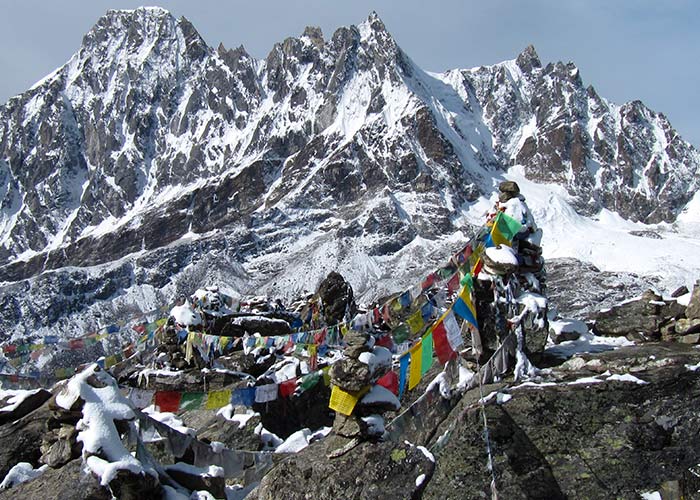
- Sun hat or scarf
- Light balaclava or warm fleece hat
- Suncreams(40+) and Lip Balms
- Cotton t-shirts and thermals
- Fleece jacket
- Waterproof jacket
- Down jacket
- Lightweight cotton pants (long)
- Waterproof pants
- Inner thermals
- Thin inner socks (3 pairs)
- Thick, warm wool hiking socks
- Comfortable hiking boots
- Shower sandals
- Gloves (Cotton and Waterproof)
Accessories
- Sleeping bag rated to -10°C +
- Trekking bag (Rucksack)
- Large plastic bags (for keeping items dry inside trek bag)
- Trekking poles (optional, recommended)
- Water bottle or camel bag
- Toiletries and Tissue Papers
First Aid Kits
- Personal Regular Medicines
- Blister Tape
Miscellaneous
- Medicines: We recommend you bring your regular medicines; we will provide first aid kit from our side.
- Light-weighted Towel
- Swiss Knife
- Passport and extra passport photos
- Water Purifying Iodine Tablets, Drop or Sterilizer
Fixed Departures
- 03/09/2024 2-10 Yes Book
- 27/09/2024 2-10 Yes Book
- 09/10/2024 2-10 Yes Book
Related Trips
You will also like …
- View Details
- Enquire Now
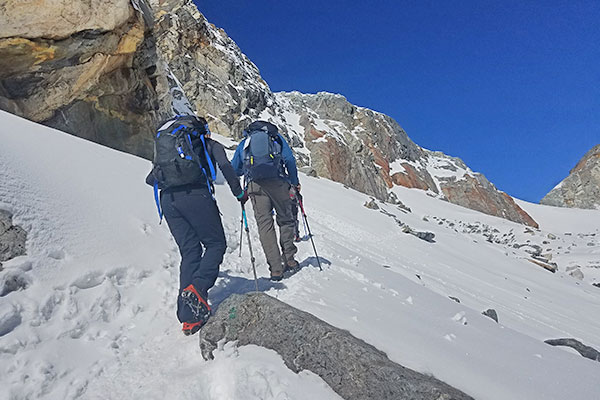
Everest Three Passes Trek
- Strenuous Plus
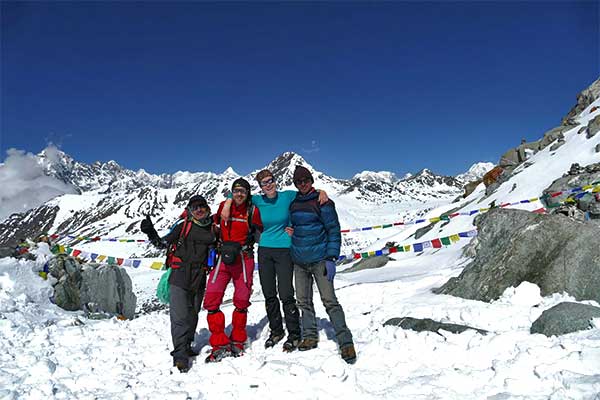
Everest Base Camp and Chola Pass Trek
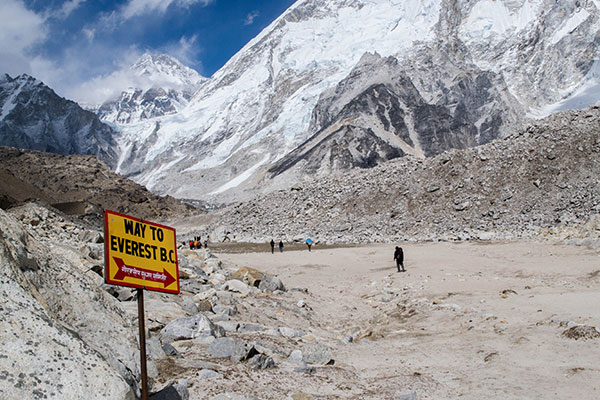
Everest Base Camp Trek
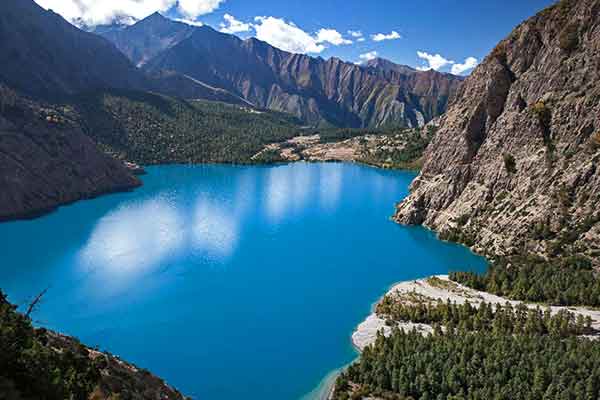
Phoksundo and Rara Lake Trek (Camping)
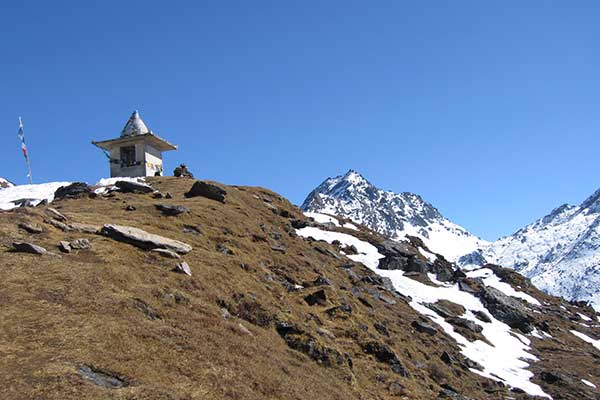
Langtang Gosaikunda Lauribina pass Trek
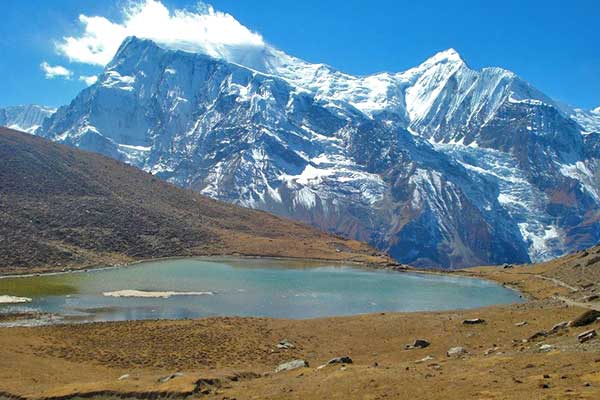
Ice Lake Trek
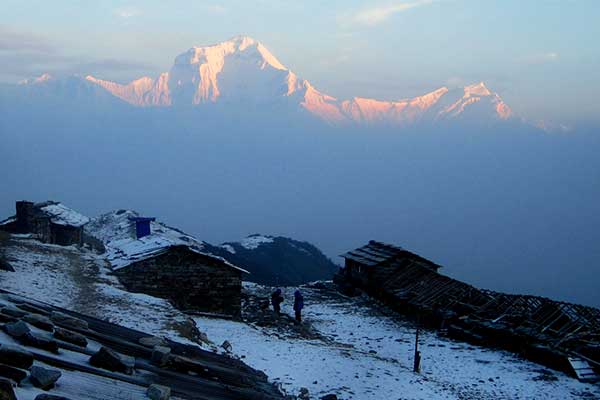
Khayar Lake Trek
Clients review.
What our customers say about us
Great experience!!
I did the Gokyo Ri trek and it was amazing!! They took care of every detail since I arrived at the airport. Krishna was the best guide, always asking how I was doing, making sure I was comfortable in every tea house we stayed in and during the trek. If I come back for another trek in Nepal I will choose Nepal Mountain Trekkers again, for sure!
Gokyo lakes with Nepal Hiking team
Great trek. Many people, mules, and dzopke the first two days to go to Namche Bazaar as lot of people are going to Everest base camp, but after that we see very few trekkers. The day from Namche Bazaar to Dole is hard, while the rest is easier, with not much elevation gain after Dole . Gokyo Rii is fantastic , great views all around of Everest, Lhotse, Cho oyu,… Cold in late afternoon and early in the morning as rooms in guest houses are not heated and dining rooms are not heated at that time. (especially in Dole) Always sunny skies in the morning with great view and visibility of the summits around. Lodges were generally good , however i would not recommend staying in Tok Tok, it is more quiet but lodge service was not good . Better to stay in Phadking with more choices of lodges. Thanks to our guides Ganga and Aypure and to our porters for your dedication and flexibility in making our trek so enjoyable.
Magic of Ama Dablam, Gokyo Lake and Everest
It was another trek in the Himalayas with Nepal Mountain Trekkers. Another great experience. Everything is well prepared, since the arrival to Kathmandu, through flight to Lukla, during trekking. We only have to enjoy the views. If I go to Nepal again, I’m sure it will be trek with Nepal Moutain Trekkers.
Amazing trek to Ama Dablam Base Camp, Sano Taboche view point and Gokyo Ri.
Unforgettable people from Nepal Mountain Trekkers. They will take care of you as the closest friend. Ramesh has provided us with a great guide and Sherpas. Huge respect for Ramesh for professional organization. They will make the impossible possible.
Prachtige trekking, goede gids
10 daagse trekking gemaakt regio Gokyo. Prachtig gebied. Onze gids TB was erg vriendelijk en actief om alles zo goed mogelijk voor ons te regelen. Ik zou dit bedrijf zeker aanbevelen. Het mailcontact voorafgaand aan onze reis was ook altijd vlot en duidelijk.
WE ARE ASSOCIATED WITH
SEND US A MESSAGE

Gokyo Lake Itinerary, Map, And Cost: Complete Guide
- January 1, 2023
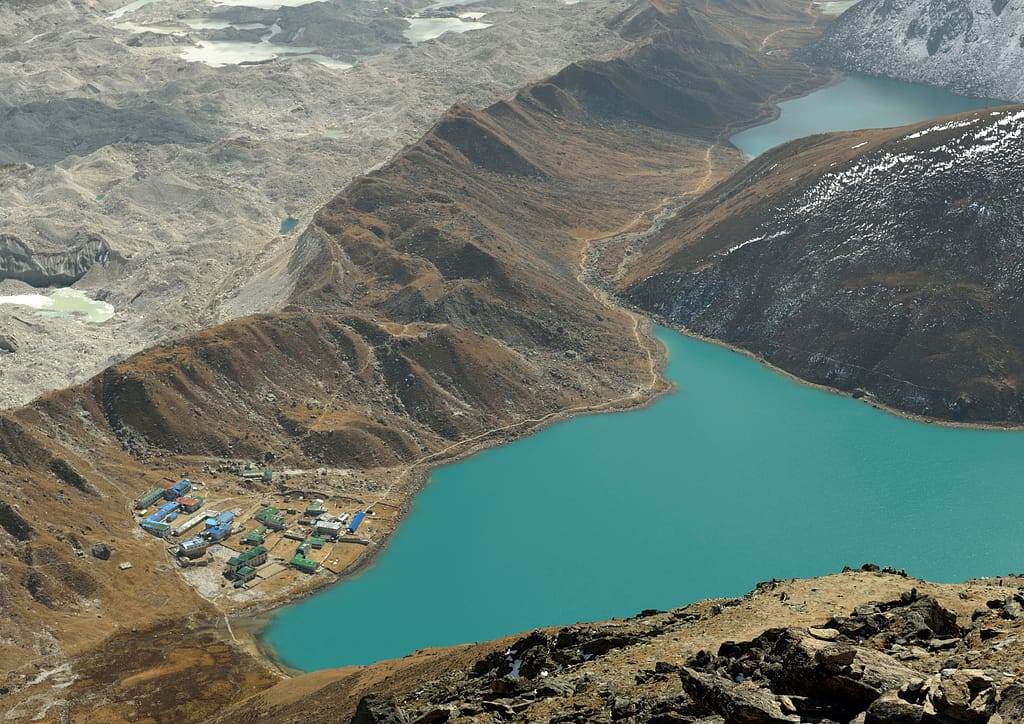
The Gokyo Lake Trek is famous in the Solu-Khumbu region of Nepal , home to the highest mountain in the world, Mount Everest . The hike takes you through the Sagarmatha National Park, a UNESCO World Heritage Site. And offers breathtaking views of the Himalayas, including Mt. Everest, Lhotse, Makalu, and Cho Oyu.
The Gokyo Lakes Trek is considered moderate to challenging, and it typically takes around 7 to 12 days to complete. The trek can be done solo or with a guided group, and it is best to do it during the dry season, which runs from September to November and from March to May.
During the trek, you will have the opportunity to experience the unique culture and way of life of the Sherpa people, who have lived in the region for centuries. You will also have the chance to visit the Tengboche Monastery, the largest monastery in the Khumbu region and known for its stunning views of the Himalayas.
So are you planning a Gokyo lake trek? This complete guide will tell you everything you need to know about the itinerary map, cost, and more!
Table of Content
What to consider before planning a gokyo lake trek.
So, are you planning on undertaking the Gokyo lake trek? Well, you think you are ready, but you might be missing some details before making your final decision.
For a start, what’s your budget? This trek is not cheap and will set you back at least $1,000 (not including flights and other travel costs). Are you able to take time off work? The trek usually takes around two weeks to complete. What’s your fitness level like? The Gokyo lake trek is a strenuous hike requiring a good fitness level.
If you can answer yes to all of the above, you’re ready to start planning your trek.
Gokyo Lake Trek Difficulty Level
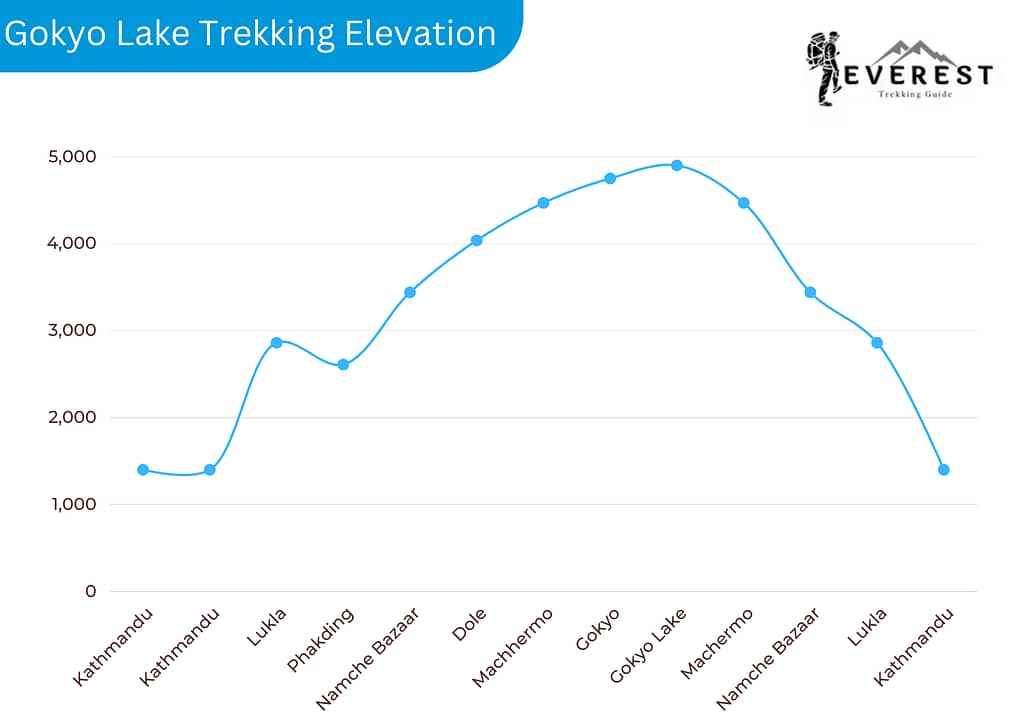
The Trek might be challenging for passive trekkers. But if you dare to take adventures, you might enjoy the hike.
The trek typically takes around 7 to 12 days to complete, depending on the route and pace of the trekker. It involves hiking through rugged terrain and crossing several high passes, including the Cho La Pass, at an altitude of 5,420 meters (17,782 feet).
The trek also involves several days of walking on rough and rocky trails, and there are some sections where you will need to use your hands to climb over rocks or scramble up steep slopes.
Overall, the Gokyo Lakes trek is suitable for fit and experienced trekkers who are comfortable with long days of hiking and have good physical endurance.
It is not recommended for beginners or those not in good physical condition. It’s essential to properly prepare for the trek, including getting in good physical shape, packing the appropriate gear, and taking necessary precautions to stay safe and healthy while on the trail. It’s also a good idea to hire a reputable guide or join a guided group to help ensure a safe and enjoyable trek.
Gokyo Lake Trek Itinerary
Flight to lukla – phakding.
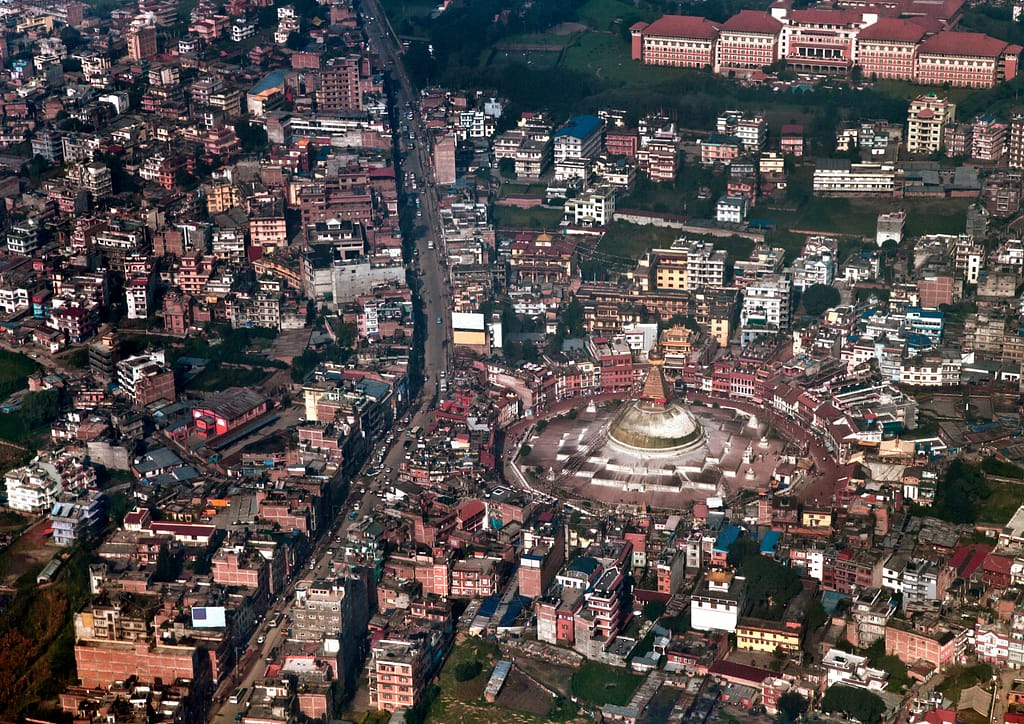
It is the first step you take to start your Gokyo Lake Trek. You have two options to reach Lukla; either by flight or by vehicle. You can get the direct flight service from Tribhuwan International Airport in Kathmandu, which takes around 35 to 45 minutes to reach Lukla Airport.
If you like to go by bus, you will have to either go through Ramechaap or Salleri.
After you reach Lukla, you will have to trek for around 3 to 4 hours to Phakding. Stay calm about the trek since you will cross the beauty of mountains, rivers, and forests.
Trek To Namche Bazaar
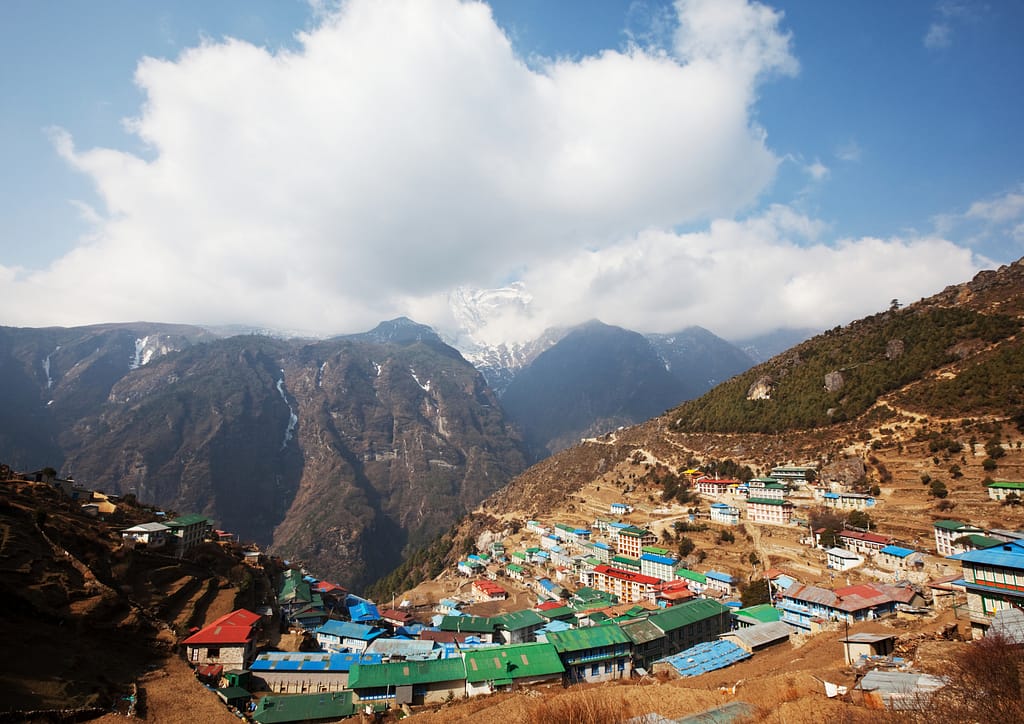
After you move on from Phakding, your next stop is Namche Bazaar , and it takes around 7 to 9 hours to reach the spot.
The trek begins in the small village of Phakding, located at an altitude of about 2,640 meters (8,660 feet) above sea level. From there, you’ll follow the Dudh Koshi River as you make your way toward Namche Bazaar, a busy town that serves as the gateway to the higher regions of the Everest region.
Along the way, you’ll pass through lush forests, villages, and terraced fields as you make your way toward Namche Bazaar, which is located at an altitude of about 3,440 meters (11,286 feet). The trek usually takes about 7 to 8 hours to complete, depending on your pace and the number of rest stops you take along the way.
The Phakding to Namche Bazaar trek is a great way to acclimate to the Everest region’s high altitude and to experience the local Sherpa people’s culture and way of life. It is also an excellent opportunity to see some of the stunning mountain scenery Nepal is famous for, including views of Everest, Lhotse, and other regional peaks.
Trek To Dole
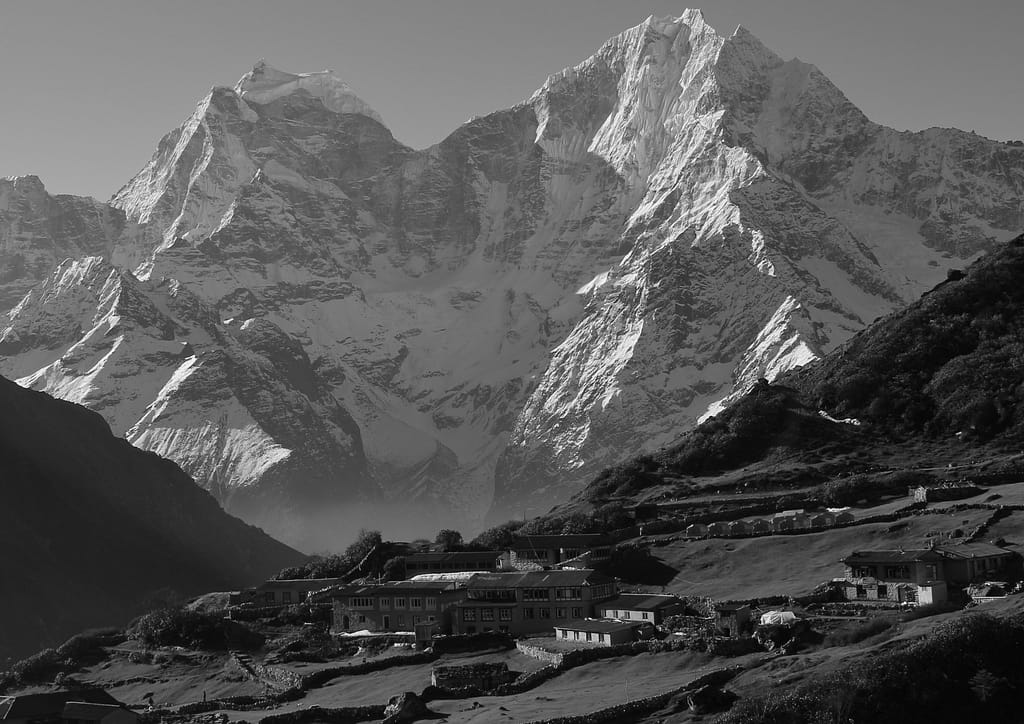
The trek from Namche Bazaar to Dole typically takes about 5-6 hours and involves a moderate to challenging hike through the region’s beautiful landscapes.
Along the way, you can pass through small villages and forests and enjoy stunning views of the surrounding mountains, such as Ama Dablam, Everest, and Thamserku.
Trek From Dole to Machhermo
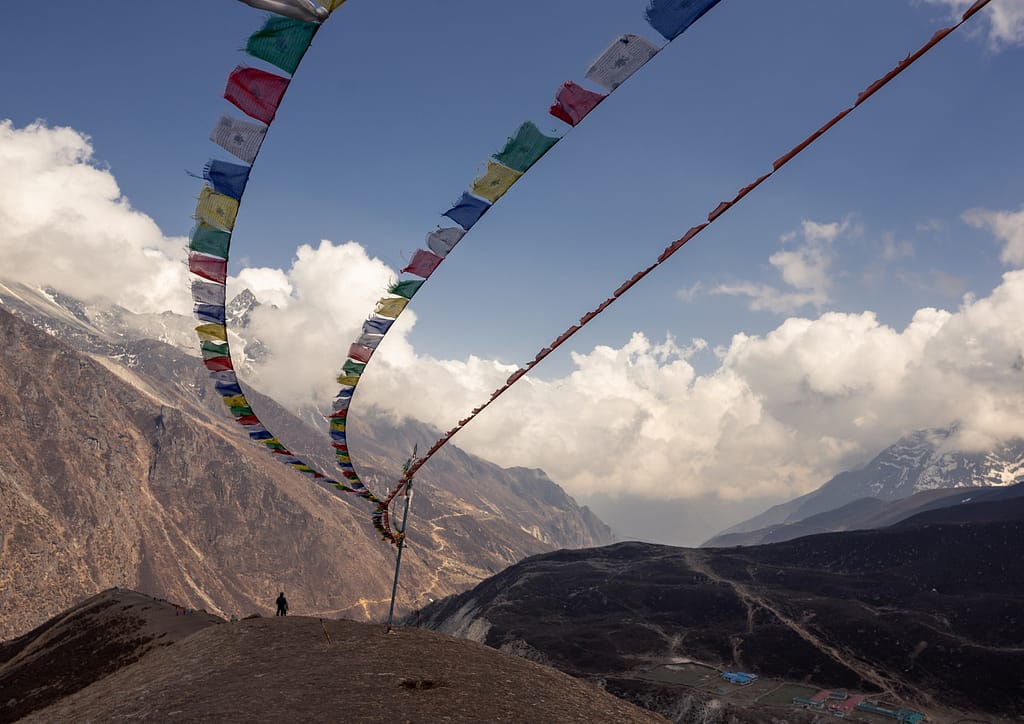
The trek starts in the village of Dole, located in the Khumbu region of Nepal, and ends in Machhermo, situated at the base of the Cho Oyu mountain.
The trek takes you through beautiful, lush forests, several small villages, and the famous Namche Bazaar, the main town of the Khumbu region.
Along the way,
you will have the opportunity to see stunning views of the surrounding mountains, including the famous peaks of Mount Everest, Lhotse, and Nuptse. The trek is moderately complex and typically takes about 7-8 hours to complete.
Trek To Gokyo
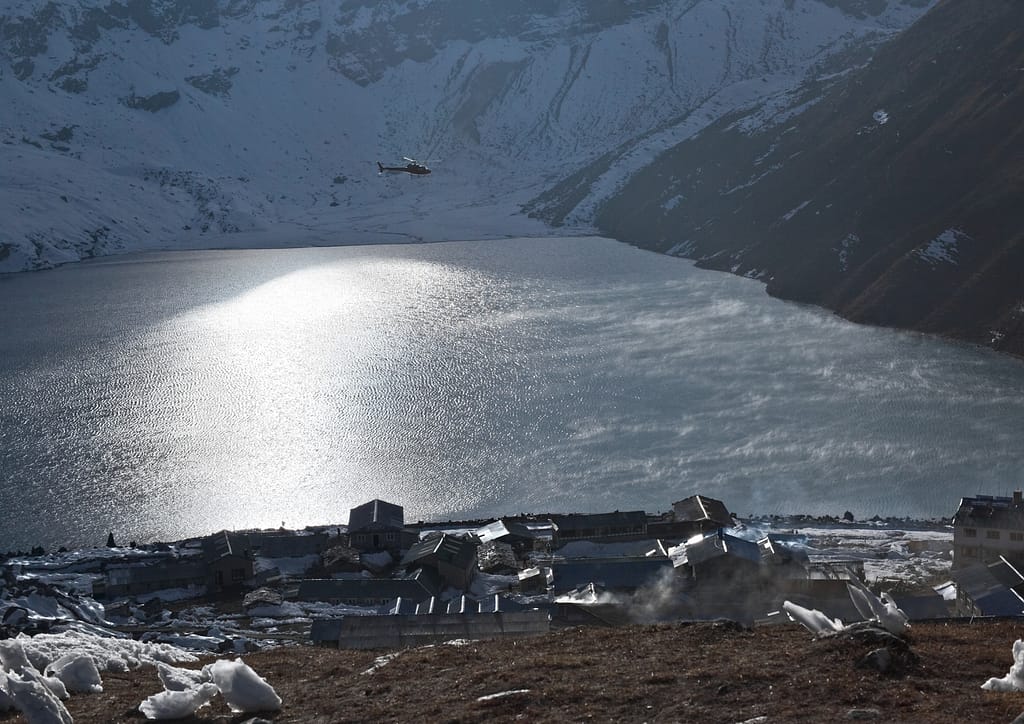
You will reach the gate of Gokyo lake once you start from Machermo to Gokyo. The trek typically begins in the village of Machhermo and ends in the village of Gokyo, and it takes about a week to complete.
You’ll have the opportunity to visit the Gokyo Lakes, a series of high-altitude lakes considered sacred by the local people. You’ll also have the chance to explore the Gokyo Valley and see the Gokyo Ri viewpoint. Gokyo Ri offers panoramic views of the surrounding mountains, including Mount Everest.
Gokyo To Machermo

After you complete your trek to Gokyo Lake, it’s time to get back, and you will be heading back to Machermo first. You can opt for the same return route, which might take over 5 hours.
Back To Namche Bazaar
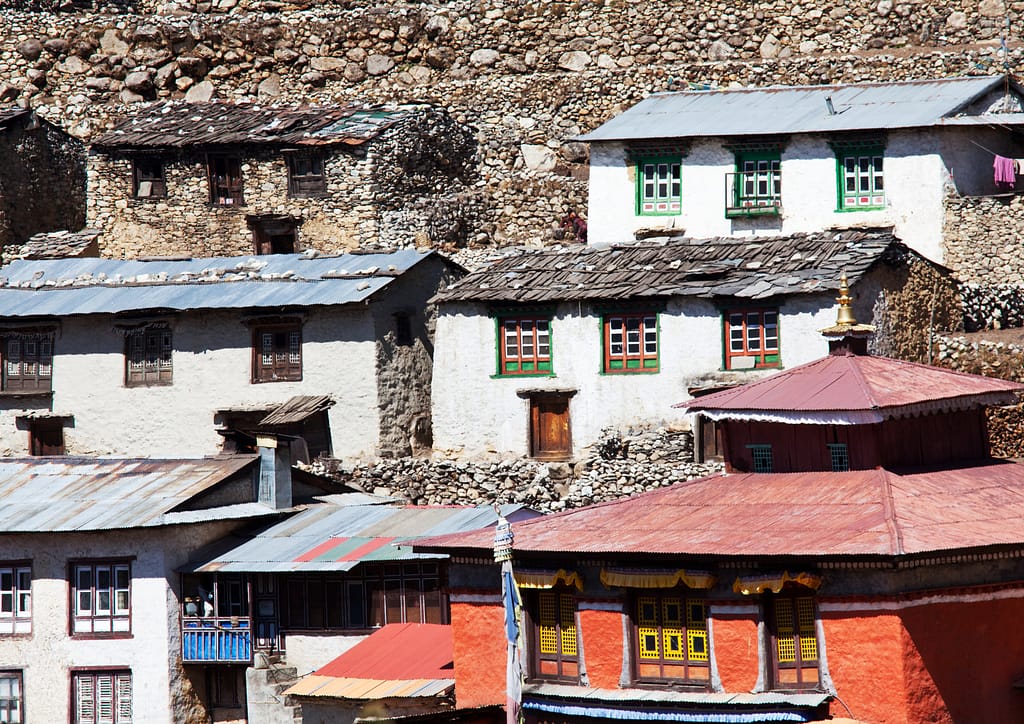
Hiking does not end at Gokyo Lake – you will have to make your way back to Namche Bazaar from Machermo, which takes around 8 hours of hike.
You will be passing across the local villages rich with traditional culture alongside the call of natural beauty.
Namche To Lukla
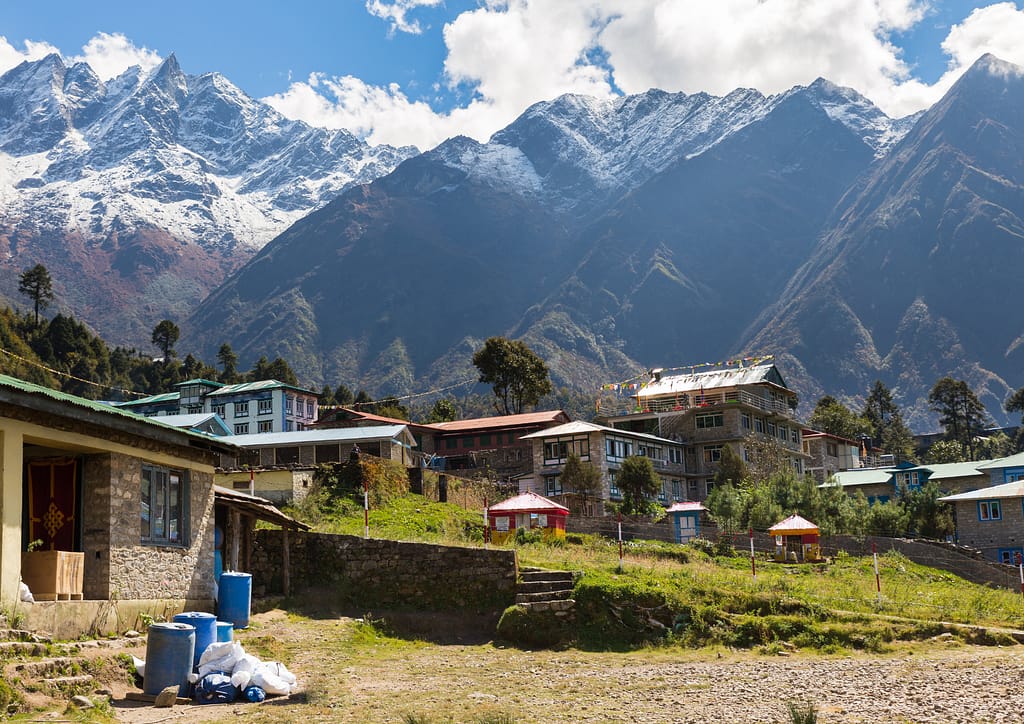
It’s the final day of your trek, and you will hike back to Lukla to get air service to head back to Kathmandu. It usually takes 8 to 10 hours to reach Lukla from Namche. You can stay overnight at Lukla and return to Kathmandu the next day.
What You Need to Know About the Itinerary for a Gokyo Lake Trek
What’s an itinerary, you ask? Put an itinerary outlining where you’ll go and what you’ll do on a given day. When planning a Gokyo Lake Trek, it’s key to understand the route and what to expect there accurately.
The good news is that the region is well-developed, and many trekking routes are available—including short 3-day hikes and longer 7-day treks for more experienced hikers. So no matter your timeline or skill level, you should be able to find something that works for you.
It would be best to start by familiarizing yourself with the region: research potential routes online or speak to locals (or, even better, hire a guide!). You can also double-check with the Ngosi Tourism Office to ensure that you’re choosing from approved trails.
Once you have your route mapped out, it’s time for some logistical planning: organize transportation, accommodation, guide service if needed, and trekking permits/papers if necessary –– all in advance! That way, when it’s time to hit the trail, all that’s left is to put one foot before the other and enjoy your journey.
Safety and Wellness While Trekking to Gokyo Lake
Before getting started, safety should always be your number one priority when trekking. Make sure you’re in good physical condition and take the time to acclimate to the altitude. Drink lots of water and eat plenty of food, especially if you need to get used to high altitudes.
In addition, pack plenty of sunscreens, insect repellent, and trekking gear. And be sure to bring a first-aid kit, just in case. It’s also important to stay aware of potential health risks while trekking and take the necessary precautions to avoid them.
Finally, always let someone know where you’re going and when you plan to return. That way, if something does happen, someone will know where to start looking for you.
Tips for Picking the Best Viewpoints for Your Gokyo Lake Trek

The Gokyo Lake trek offers some of the most stunning views in Nepal. From towering mountains, pristine blue lakes, and breathtaking glaciers, it truly is a landscape that must be seen to be believed.
When planning your Gokyo Lake Trek route, take the time to check out some of the best viewpoints along the way. Whether you’re an experienced traveler or a first-timer, the mountain views will take your breath away.
Here are some tips for picking out the best vistas on your Gokyo Lake Trek:
- Look for elevated areas – Higher points make for better views since there’s less obstruction from other hills and trees. The higher up you get, the more spectacular panoramas you’ll be able to take in!
- Scout out prime spots at sunrise and sunset – The sun rising and setting over the lake are sights you will want to take advantage of. Get up early and find a viewpoint with an excellent view of the lake so you can watch its tranquil waters change color with each passing hour.
- Choose viewpoints that offer multiple landscapes – Be sure to pick out spots that provide various perspectives on their surroundings – think 360-degree vistas! With one glance, you get an unfiltered view of all that nature offers.
The Cost of a Gokyo Lake Trek
A lot goes into the cost of a Gokyo lake trek.
Treks vary in duration and difficulty, so you must consider what type of trek you’re looking for before getting started. There are plenty of options, but most treks will cost a minimum of $1,000 per person.
That price tag includes everything from food and accommodations to permits and transportation. It’s important to factor all these costs into your budget, as they can add up quickly.
But don’t worry – we’re here to help you plan the perfect Gokyo lake trek for your needs!
Recommended Budget for Gokyo Lake Trek
When it comes to budgeting, the cost of the Gokyo Lake Trek ultimately depends on how you plan to do the trek. If you are comfortable trekking independently and are okay with carrying your gear, then you can expect to spend a lot less. On the other hand, if you choose to go with a tour guide and porter, your costs will be higher.
We recommend that you budget around $30-50/day for most of the trek for food, lodging, and incidentals. However, you should also factor in other costs such as permits and transportation (up to $150 total), plus gear rental and miscellaneous expenses like snacks and souvenirs.
If you are planning to hire a guide or porter, be prepared to pay them around $20 per day for their services. Tours and companies can also vary significantly in price depending on their service levels, so it pays to do some research in advance.
The Gokyo Valley Itinerary Map
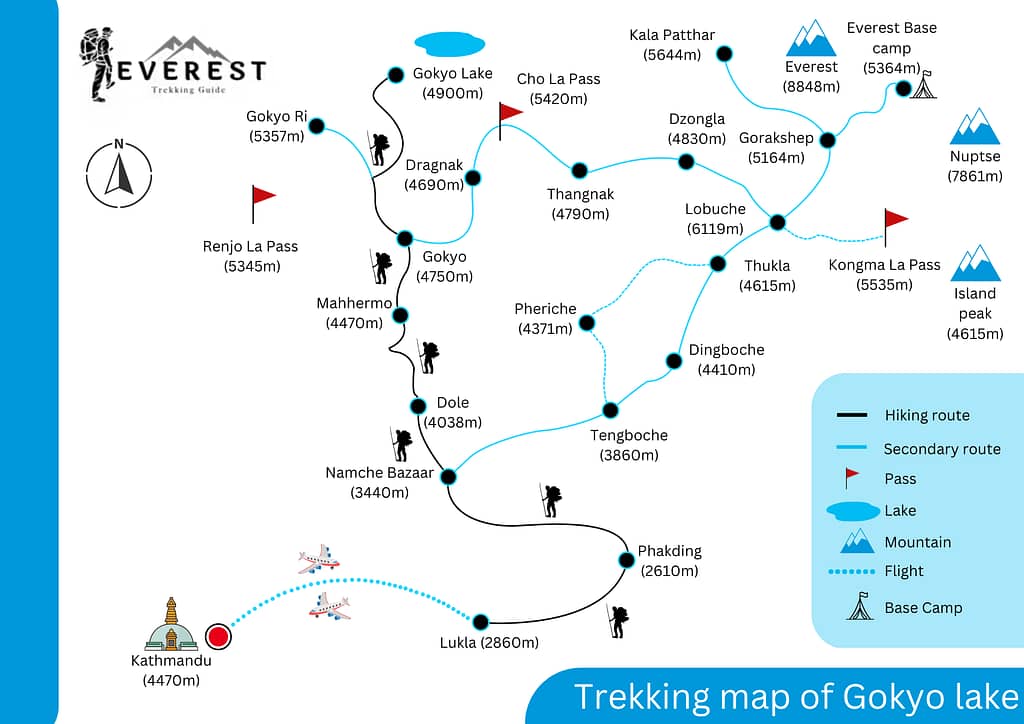
Now’s the time to get into the nitty gritty of your Gokyo trek: the itinerary. This Gokyo Valley Trek itinerary map will help you plan your trekking days and get the best out of your time in Nepal.
On day one, you’ll begin in Lukla, where most treks start in this region. From there, you’ll make your way up to Phakding, where you’ll spend the night. Day two is a relatively easy and short trek from Phakding to Namche Bazar via Monjo.
On days three and four, you can explore Namche Bazar and acclimate for two nights since it will already be your first experience with high altitudes. On days five and six, you’ll move on from Namche Bazaar to Dole via Machhermo before heading up to Gokyo Lakes on day seven. After enjoying some time by the lakes on days eight and nine, you’ll move from Gokyo to Marlung on day ten.
On days eleven and twelve, you’ll head down to Lukla before finally flying back out of Lukla airport at the end of your trek, concluding a spectacular journey all around!
Weather Conditions Around Gokyo Lake
The weather in Gokyo Lake is generally cold and dry, with temperatures ranging from -10 to 10 degrees Celsius (14 to 50 degrees Fahrenheit) during the day and dropping to below freezing at night. The region receives very little precipitation, with most rain falling during the monsoon season from June to September.
However, even during the monsoon season, the weather can be unpredictable, with clear skies and sunshine often alternating with heavy rain and fog. When visiting Gokyo Lake, it is essential to be prepared for various weather conditions, as the high altitude and extreme temperatures can risk your health. Be sure to bring warm, waterproof clothing, sunscreen, and sunglasses to protect yourself from the sun’s harmful rays. It is also a good idea to bring a first aid kit, any necessary medications, and a map and compass in case you get lost.
Overall, the Gokyo trek is a challenging but rewarding experience that will take you through some of the most beautiful landscapes in the world. With careful planning and a good map, you can make the most of your trek and enjoy everything it offers.
Gears Needed For Gokyo Lake Trek
When planning the Gokyo Lake trek, it’s essential to be prepared and have the necessary gear. Here is a list of some of the essential items you should bring:
Warm waterproof clothing
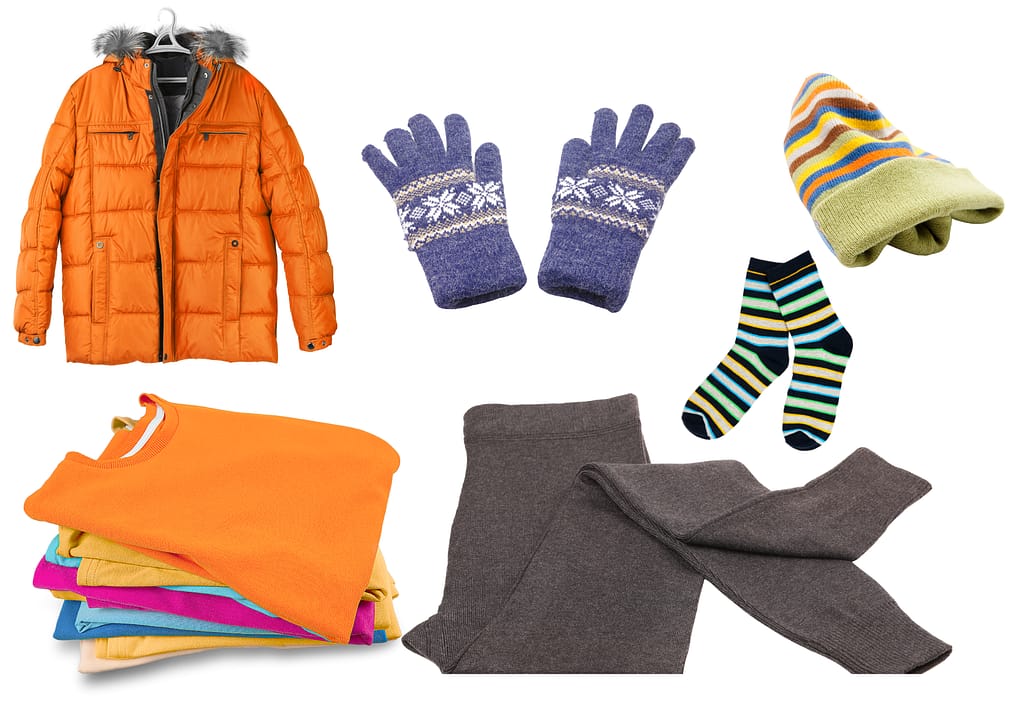
The weather in the mountains can be unpredictable, so it’s essential to bring warm, waterproof clothing. This includes a jacket, pants, gloves, and a hat.
Good hiking boots
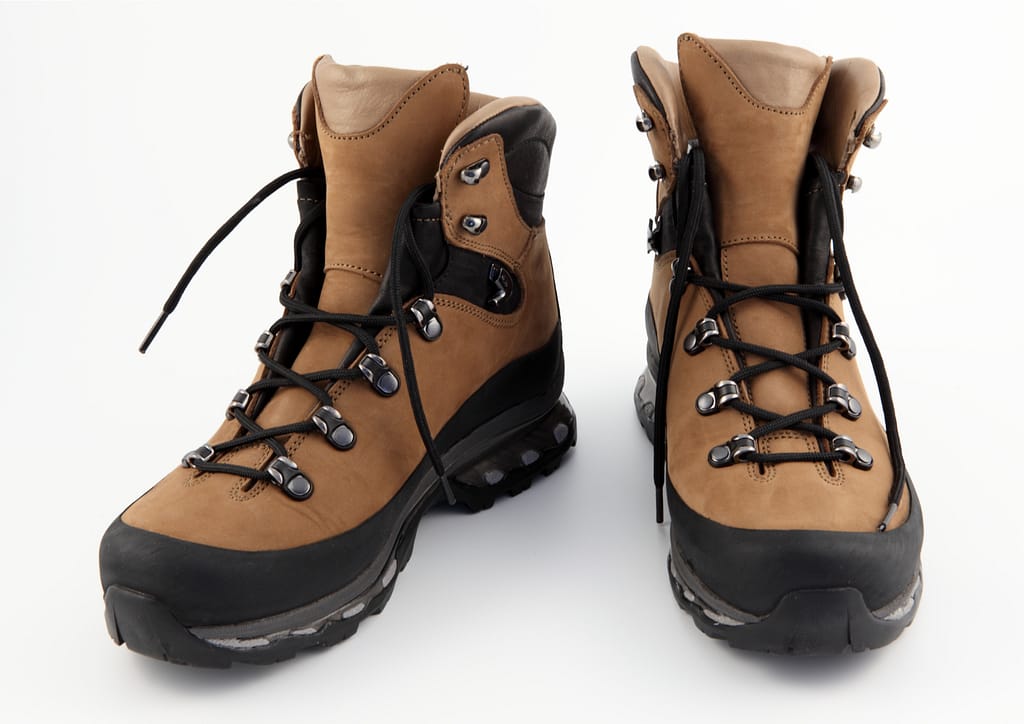
The Gokyo Lake trek involves a lot of walking, so it’s essential to have a pair of good-quality hiking boots that are comfortable and provide good support.
Sleeping bag
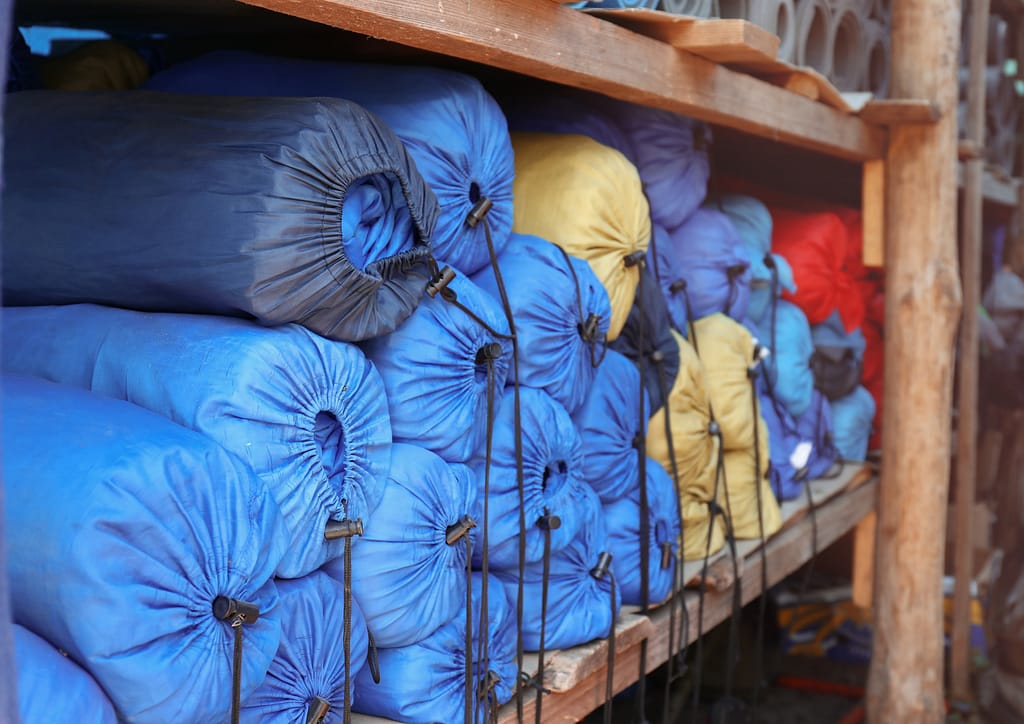
Nights can be cold at high altitudes, so it’s essential to bring a warm sleeping bag .
Water bottle
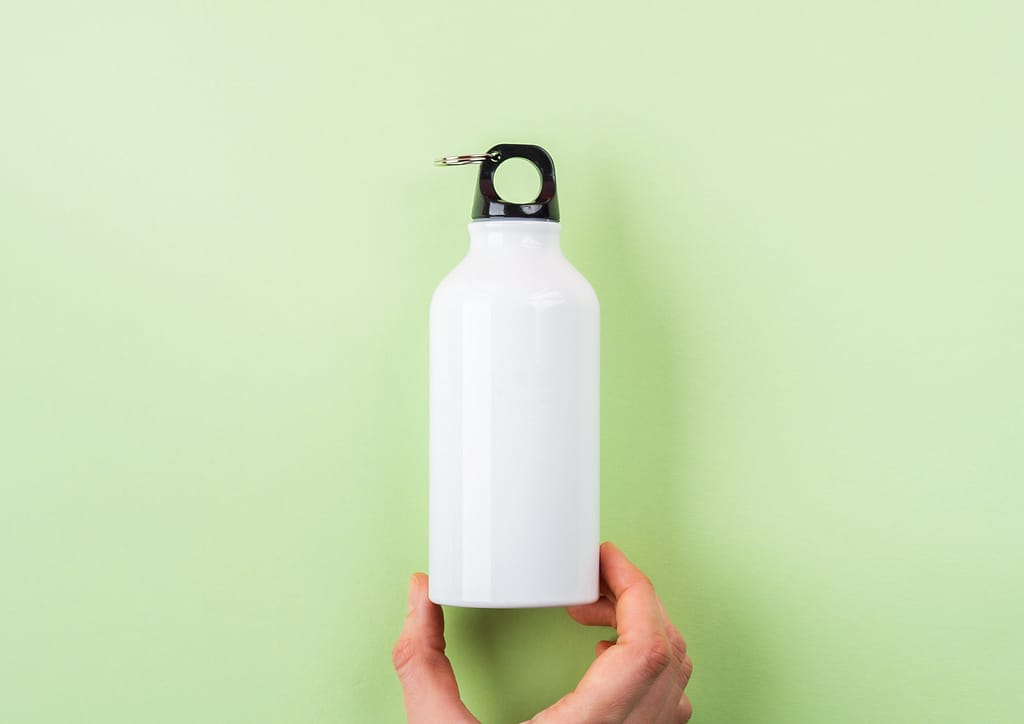
You’ll need to stay hydrated during the trek, so bring a water bottle you can refill along the way.
Headlamp or flashlight
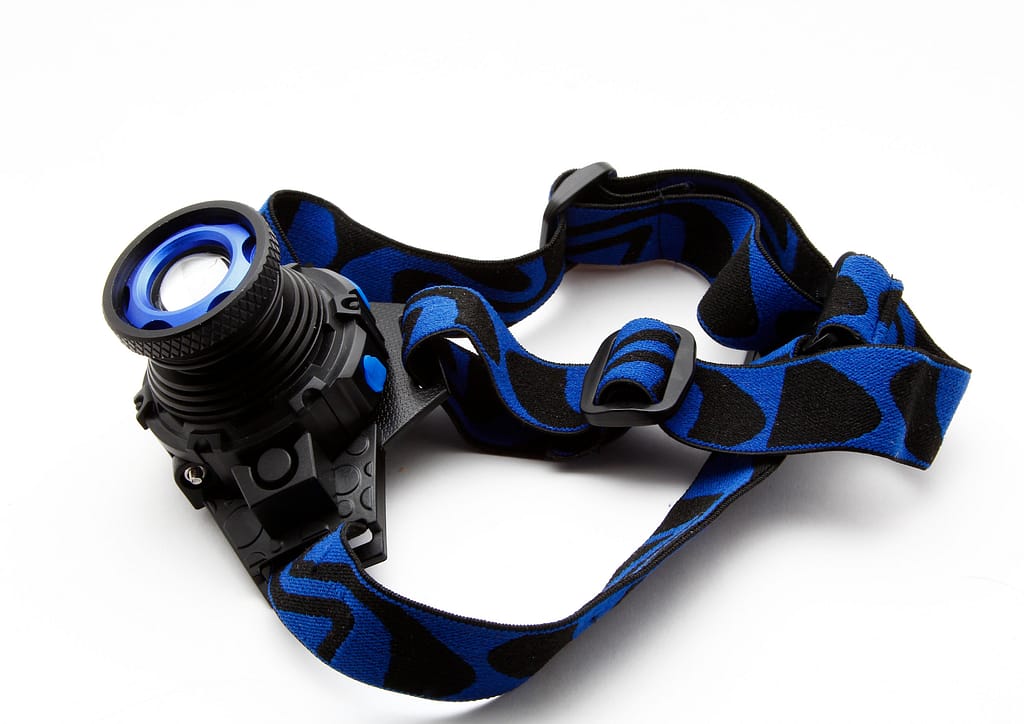
It can get dark early in the mountains, so it’s a good idea to bring a headlamp or flashlight.And it can also be used in case of power outages.
Sunscreen and sunglasses
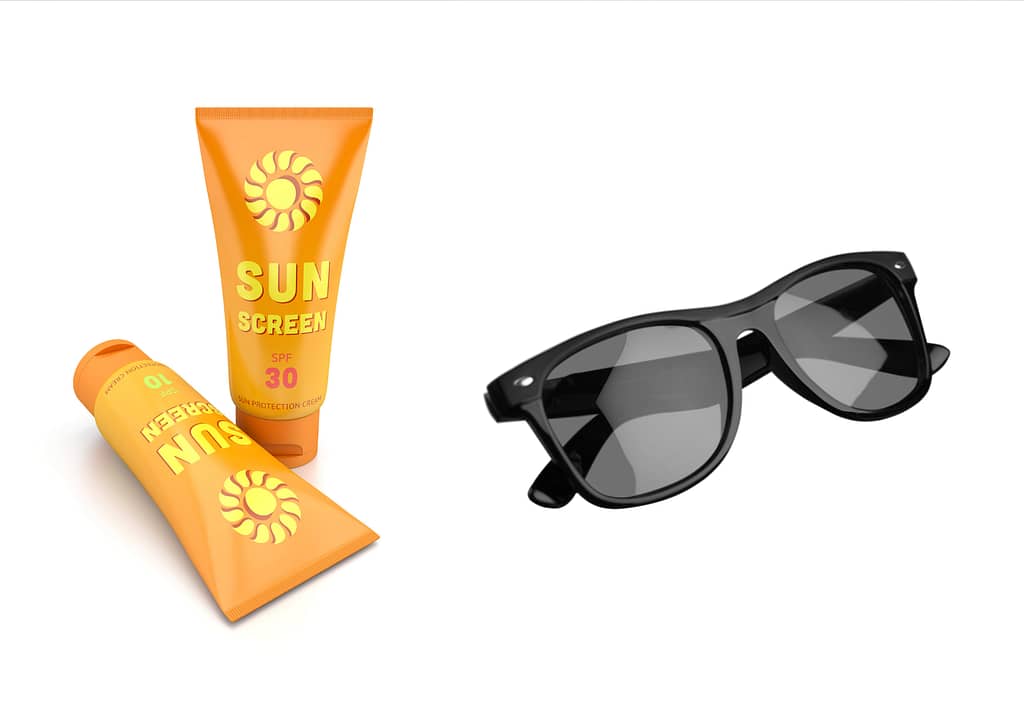
The sun is often intense at high altitudes, so bring sunscreen and sunglasses to protect your skin and eyes.
First aid kit
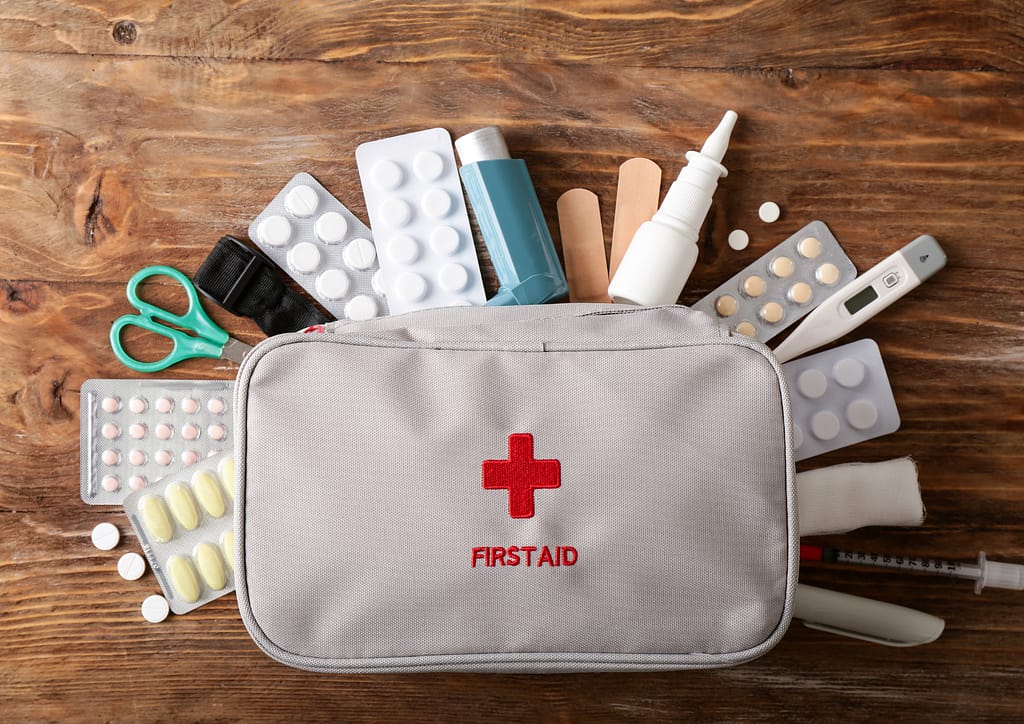
It’s always a good idea to bring a basic first aid kit on any trek. And it must includes bandages, gauze, and pain medication.
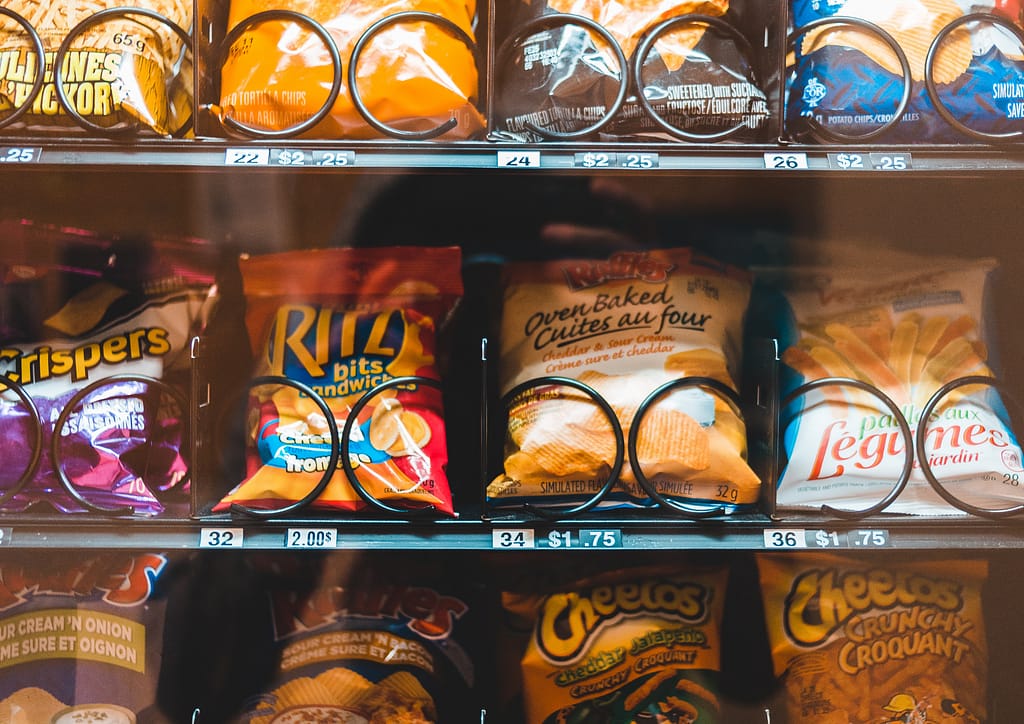
Bring snacks such as energy bars or nuts to keep your energy levels up during the trek.

Don’t forget to bring a camera to capture the stunning views along the way.
With these gears, it’s sure that your trek to Gokyo Lake will be a once-in-a-lifetime experience.
What is the difficulty level of the Gokyo Lake trek?
The trekking season begins in October and ends in May, and it’s suitable for beginners and experienced hikers alike. However, it would be best to be physically fit to endure high altitudes, cold temperatures, and long days of hiking on uneven paths.
Do I need a guide?
A guide can be helpful on a Gokyo Lake Trek, as they are often local and can provide insight into the region’s culture, customs, and stories. They also know how to get around safely and efficiently, making it easier for travelers to do their hikes confidently.

What kind of food will be available?
Many guesthouses offer delicious meals , including local cuisines such as Dal Bhaat and traditional Sherpa stew. Additionally, you can find snacks like nuts, candy bars, and energy bars along your route.

Subtitle for This Block
Title for This Block
Text for This Block
What type of equipment do I need for trekking?
The required equipment for the trek includes turdy hiking boot, warm clothing layers (fleece or down jacket), rain gear, a hat and gloves, sunglasses, and sunscreen. You’ll also need a sleeping bag rated for temperatures below freezing point.
How many lakes are there in Gokyo?
Altogether, there are 19 lakes in Gokyo ranging from an altitude of 4,600 and 5,100 meters above sea level.
Can I see Everest from Gokyo Ri?
Yes, Gokyo Ri offers a majestic view of Mount Everest and other beauties like Cho Oyu and Ngozumpa Glacier.
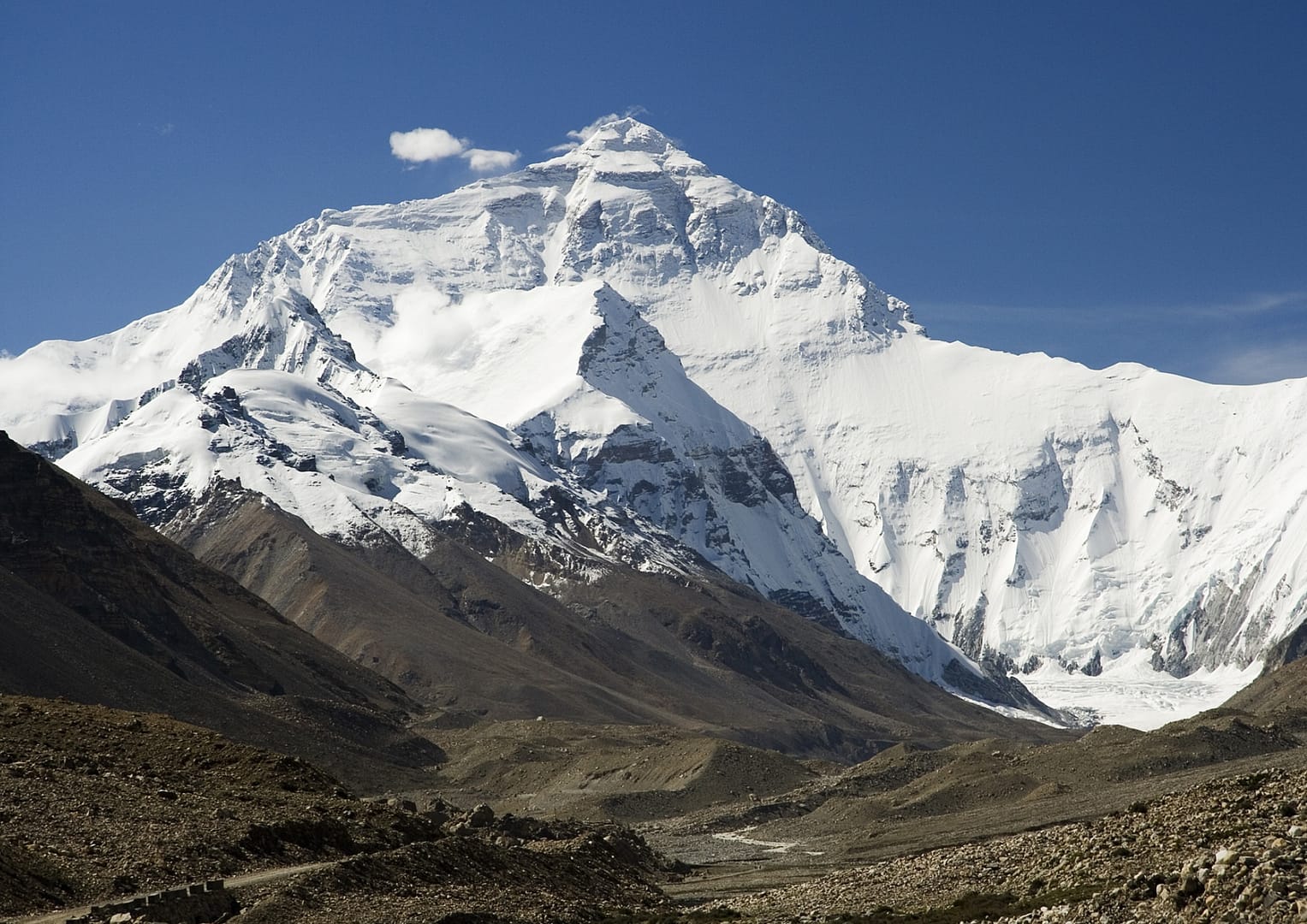
Related Posts
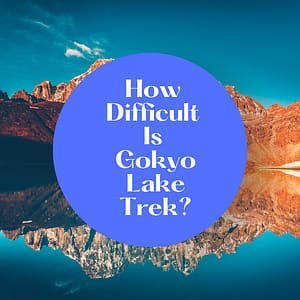
How Difficult Is Gokyo Lake Trek?
- January 6, 2023

How Much Does Gokyo Lake Trek Cost?
- January 4, 2023
Leave a Reply Cancel Reply
Your email address will not be published. Required fields are marked *
Name *
Email *
Add Comment
Save my name, email, and website in this browser for the next time I comment.
Post Comment
Find your adventure. The mountains are calling.
Discover A New Adventure
- Duration 0 - 10 10 - 20 20 - 30 30 - 40
- Trip Difficulty Easy Moderate Moderate to Strenuous Strenuous Very Strenuous
- Group 1 - 20 1 to 20 1 to 5 1-10 2 to 20 2-20 2+
- Altitude 0 - 500 500 - 1000 1000 - 1500 1500 - 2000 2000 - 2500 2500 - 3000 3000 - 3500 3500 - 4000 4000 - 4500 4500 - 5000 5000 - 5500 5500 - 6000 6000 - 6500 6500 - 7000 7000 - 7500

- Everest Region
- Annapurna Region
- Langtang Region
- Manaslu Region
- Other Treks
- 10 Days Himalyan Buddhist Pilgrimage Tour Nepal
- 13 Days Nepal Buddhist HimalayanTour
- 14 Days Nepal Bhutan and Tibet Tour
- 11 Days Nepal and Tibet Tour
- 9 Days Nepal and Bhutan Tour Package
- 11 Days Delights of Bhutan tour
- 5 Days Bhutan Highlights tour
- 5 Days Bhutan Cultural Tour
- 7 Days Taste of Bhutan tour
- 4 Days Tibet Lhasa Tour
- 14 Days Manasarovar and Mt. Kailash tour
- 8 days Lhasa EBC Tour and Trek
- 1 Day Kathmandu world heritage sites tour
- 6 Days Kathmandu Pokhara Tour
- 5 Days Kathmandu Nagarkot Dhulikhel
- 10 Days Highlight Nepal Tour
- 28 Days Himlung Expedition
- 36 Days Ama Dablam Expedition
- 22 Days Naya Kanga Peak Climbing
- 19 Days Tharpu Chuli Climbing
- 16 Days Lobuche East Peak Climbing
- 14 Days Chulu East Peak Climbing
- 16 Days Yala Peak Climbing
- 15 Days Pisang Peak Climbing
- 14 Days Island Peak Climbing
- 18 Days Chulu west Peak Climbing
- 14 Days Mera Peak Climbing
- 14 Days Everest Base Camp Trek
- 16 Days Everest Base Camp Trek By Road
- 20 Days Everest Classic via Jiri Trek
- 18 Days Everest Base Camp With Gokyo Trek
13 Days Gokyo Lakes Trek
- 12 Days Scenic Pike Hill Trek
- 1 Days Everest Base Camp Helicopter Tour
- 11 Days Everest Base Camp Heli Trek
- 20 Days Everest Three Passes Trek
- 9 Days Everest panorama Trek
- 14 Days Everest Base Camp Luxury
- 12 Days Ama Dablam Base Camp Trek
- 13 Days Annapurna Circuit Trek
- 10 Days Annapurna Basecamp Express Trek
- 12 Days Annapurna Base Camp Trek
- 8 Days Annapurna Panorama View Trek
- 11 Days Khopra Danda Trek
- 10 Days Mardi Himal Trek
- 11 Days Mohare Danda Trek
- 14 Days Annapurna Sanctuary Trek
- 8 Days Jomsom Muktinath Trek
- 21 Days Nar Phu Valley Trek
- 10 Days Langtang Valley Trek
- 11 Days Langtang Gosaikunda Trek
- 10 Days Tamang Heritage Trek
- 15 Days Tamang Heritage and Langtang Valley Trek
- 8 Days Helambu Trek
- 13 Days Ganja La Pass Trek
- 22 Days Manaslu Trek with Tsum Valley
- 20 Days Tsum Valley Trek
- 34 Days Manaslu Circuit Nar-Phu Trek
- 16 days Manaslu Circuit Trekking
- 17 days Upper Mustang Trekking
- 5 Days Nagarkot Chisapani Trek
- 18 Days Lower Dolpo Trek
- 24 days Kanchenjunga Trek
- 26 Days Upper Dolpo Trek
- Why Book with Us
- Legal Documents
- Our Friends
- Terms and Conditions

The Ultimate Guide to Gokyo Lake Trek
The Gokyo Lakes trek is one of the most breathtaking treks of the Khumbu region of Nepal. There are many interested visitors and nowadays, these are a destination of choice for trekking enthusiasts due to its unmatched beauty. The high peaks, steep glacier facets, and colorful lakes provide the trip with an adrenaline rush. For trekking at elevated altitude, the most important thing to consider is the weather.
Here you would be able to see varied landscapes and splendid valleys. The rolling hills look really inviting. The Trek is made tough by the changing weather. The weather in high elevations is extremely severe and often quite unpredictable. It is necessary to consult the weather forecast every day prior to hiking in order to prevent the risk.
Spring, Autumn, Winter, and Summer are the four seasons of Nepal. The nature of the region differs by the seasons. The spring and autumn can be identified as the most appropriate times to climb high. Nonetheless, trekking in the off-season is available as an option. Let’s explore the Gokyo weather in four different periods with us!
Gokyo Lake Trek is famed as the largest glacier in the Himalayas of Nepal. It is west of Ngozumpa Glacier in the Khumbu Region of Solukhumbu District. This Trek takes you to the viewpoint of an altitude of 5357 m. This location with many glacier lakes is well-known for its bright turquoise features.
The Gokyo Lakes trek is the quietest, least touristy trek in the Everest Region. The flight amazes you both visually and aurally when you fly towards Lukla through the marvelous mountains. This trek is a moderate-level trek that will take you through renowned Sherpa villages, Phakding, Namche, and Dole, and then to Gokyo.
The view of glacial lakes ringed by huge mountains will remain with you all your life. This Trek refreshes your soul with the raw nature before the cradle of the Himalayas.
Table of Contents

Best Time for the Gokyo Lake Trek
Below it is described in each season for the Gokyo Lake trek.
Spring Season (March-May)
Spring is the best time to trek Gokyo Lakes. The weather and atmosphere of this season are pleasant, making it best suited for trekking. Spring starts in March, and May is the ending. The climate is moderate, neither hot nor cold, and persists throughout the season.
It is mildly warm during Spring, with sunny days and chilly nights. The early Spring is pretty cold but warm by late Spring. There is no rainfall in Spring, but you can encounter light snowfall in the early season, the first week of March. March could be challenging, but the beautiful views cover the harsh weather.
After March, the temperature starts rising at the beginning of April. The chance of severe weather with high winds and storms is possible at the end of May. The average temperature is -2.6 degrees to 11.5 degrees. Slowly increasing temperatures and clear skies make the glimpse of mountains and landscapes more vivid.
Spring is also known as the blooming season. So you can witness lush green forests and colorful flowers blooming along the trail. You can see new species of birds migrating here due to warmth. Animals also leave their habitat to enjoy the warmth of the sun and beautiful nature.
Everything is perfect during this season, attracting many trekkers to enjoy the Trek—the long days of spring favor you to explore more in natural light. There are many trekkers in this season, so the trail gets busy. You get to meet many foreigners from all around the world.
Autumn Season (September – November)
Autumn is also the best season to trek this region. The weather is fine, neither cold nor hot, with bearable temperatures. Autumn begins in September and ends in May. The climate is temperate, with low humidity throughout the season.
As Autumn comes after a hot summer, early Autumn tends to be hot, up to 2.9 degrees. The moderate climate is quite similar to Spring but chilly at night. The beginning of this season gives summer vibes. The days are warm and bright, while nights are crisp and chillier.
The temperature starts getting cooler from mid-October and colder by the end of the season, reaching -12 degrees. But as a whole, the coldness is still bearable. However, a few downpours, occasional wind storms, and snowfall are inevitable. The days are smaller, so trekkers need to hurry a bit.
It is fall season, so changing tree leaves and colors are highlights of the Trek. In October, the annual festivals of Nepal, Dashain and Tihar, are celebrated. You will get to know more about the culture and traditions of Nepal.
It is also a seasonal trek, so you coincide with many trekkers along the route, making it busy. There is the hustle and bustle all around the trail. The accommodations are also quite hard to find. Make sure you book it beforehand.
Summer Season (June – August)
Summer begins in June and ends in April. Summer is also called monsoon season, which means lots of downpours, making trails challenging to trek. The highest rainfall, tropical storms, and lighting make it more challenging. So, we don’t recommend it in this season.
Summer is hot and humid. The average temperature is 1.5 degrees to 2.2 degrees. The days are warm and sunny, while the morning and evening are cold. July and August are the hottest among all seasons, with temperatures rising to 4.4 degrees.
The foggy weather and cloudy days make the journey very uncomfortable. It obstructs the visibility of nature. The regular rainfalls make the trail muddy and slippery. Walk carefully, and don’t slip. Use waterproof boots to prevent injury.
Also, the weather is hot and dry, leading to dehydration and sunburn. Hydrate yourself often. Pack sunglasses, sunblock, and moisturizer to care for your eyes and skin. Due to the weather conditions, trekkers avoid this season. So the route is less crowded. If you love adventures, you can prefer this season, but at your own risk.
Winter Season (December – February)
Winter is cold, damp, wet, and frigid. It begins in December and ends in February. The temperature drops up to -18 degrees. The morning and night are chilly, while the days are warm and sunny. The heavy snow and ice keep the trekkers away during winter.
Many accommodations can be out of service during winter, so book it beforehand. But you can get a chance of discounts. The deadly snow and slippery trails make it difficult to trek.
However, the weather is better by the season’s end, increasing the temperature to 0 degrees. You must be more careful of long, cold nights with frequent snowfall and blizzards. Be prepared with your stuff, including warmer clothes and proper equipment like crampons.
You can enjoy the best winter views with snow-covered mountains, frozen lakes, and stunning scenery. Fresh snow on the rooftop of the cottage house gives authentic vibes.
This season is also off-season with less trekkers. Winter is suitable if you enjoy a cold climate without any crowds. Wear more and keep yourself extra warm during the journey.
Gokyo Lakes Trek Difficulty
Gokyo Lakes Trek has a minimum duration of two weeks. During this Trek, we will gain a maximum altitude of 5357 m (Gokyo Ri) in a span of a few days. Low oxygen levels and air pressure in these high-altitude conditions make breathing difficult. Trekking at a high altitude means there is a high chance of altitude sickness. Headache, Nausea and Vomiting, diarrhea, insomnia, Shortness of Breath and a desire to eat are common symptoms of altitude sickness. Altitude sickness is a serious matter which can turn fatal if not treated in time.
Another major problem is during peak time getting proper accommodation. You might have to share rooms with fellow trekkers due to the overcrowding. When you’re up in the high altitude, there aren’t as many bathrooms, so you might have to wait in line to use one. This can be pretty frustrating.
You will walk an average of 5-6 hours daily during this Gokyo Lake Trek. Imagine carrying Heavy luggage on this long-distance Trek uphill and downhill is extremely difficult. Trekkers need to be physically fit, and proper packing with proper planning is required to make this Trek successful.
Food and Accommodation
There is well-equipped accommodation in the city from the 3-star hotel to the 5-star hotel. Depending upon the budget you can choose the hotel and lodge. But after you reach the high altitude area, the accommodation is called a tea house. You will spend the night at the tea where you will get the basic facility of room and food.
Even though the room and the food at the high altitude area are basic, it will give you comfort. You will have the chance to taste the typical Nepali popular dish like Dal Bhat and ghee tea. You can also try Indian and Tibetan cuisine. You will be amazed by the great hospitality from the Sherpa People.
How much does the Gokyo Lake Trek cost?
The Gokyo Ri trek cost ranges from USD 1000 to USD 1800 per person. The cost varies on several factors like the number of days you stay, food, accommodation, insurance, flight ticket, Guide, porter, and the route you can choose. Also, the cost may be higher during the peak season.
Therefore, we recommend you choose the right package that is suitable for you. Our company has been in this sector for a long period of time therefore we can make the right itinerary for you depending upon your budget.
Related package: 18 Days Everest Base Camp and Gokyo Trek
Packing a Trekker’s Kit
To make this Trek successful and comfortable, it is extremely necessary to plan early and pack the right things. Even though you can get the facility of the porter we request you to carry necessary things which will not add burdens to the porter. Packing for your trip depends on the seasons you’ll be traveling in. It’s important to select the right items that suit the weather and conditions during your travel months. Below are the basic things that you will need while trekking in the Gokyo Lake Trek.
- A comfortable, light backpack.
- Down Jacket or lightweight fleece jackets
- Lightweight trekking pants, shorts, long-sleeve shirt, winter gloves, wool thermals
- Waterproof items (rain jacket, poncho, etc.)
- Hiking shoes, Sturdy climbing shoes, Synthetic or wool socks
- Tripod and camera straps
- First aid kit
- Warm clothing
- First aid and medication
- Water bottles and water purification
- Personal toiletries and hand sanitizer
- Journals and pens
Related article: Nepal Trekking Packing List
Permit required for the Gokyo Lake Trek
To accomplish this Trek, permits are mandatory. Permits are the legal licenses authorized by the Government of Nepal. Without permits, you won’t be allowed to enter the protected regions. Gokyo lies in the Khumbu region. So, the first permit is a local permit. To reach Gokyo, you must enter through the national park, which requires another permit.
So, in total, you will need two permits to complete this Trek legally. But if you want to trek through a different route, then an additional permit is required. We will discuss all the permits in detail below.
Khumbu Pasang Lhamu Rural Municipality Entrance Permit
The Gokyo trek lies in the Khumbu region. So, you need a permit to enter this local area. This permit is called the Khumbu Pasang Lhamu Rural Municipality Entrance Permit. Before 2018, there used to be a TIMS card to enter this region. However, after a huge debate among authorities, the local government of Khumbu Municipality decided to go for a local permit.
The budget of this permit is used for the development and preservation of the Khumbu region. You cannot obtain this permit from Kathmandu. It is available either in Lukla or at the entrance gate of Monjo.
The cost of this permit is US$ 18 per person.
Sagarmatha National Park Permit
You have to enter through Sagarmatha National Park on this Trek. National Parks are the protected treasures for the welfare and protection of wildlife. So, you need a permit for the legal rights to surpass this national park. This permit is called the Sagarmatha National Park Permit.
You can obtain this permit either from the Nepal Tourism Board Office in Kathmandu or directly at the entrance of Monjo.
The cost of a Sagarmatha National Park Permit depends upon your nationality. If you are from a SAARC country, it costs US$ 15 per person. Besides, you will have to pay US$ 27 per person.
Additional Permit
You will need an additional permit if you choose the classic route of Jiri. You must enter the Gaurishankar Conservation Area if you trek through this route. So, a Gaurishankar Conservation Area Permit is required.
It can also be obtained from the Nepal Tourism Board in Kathmandu.
The cost of a Gaurishankar Conservation Area Permit is US$ 27 per person.
Note: All the permit costs are payable only in Nepalese Currency (NRP). So, change your currency to NRP before getting your permits.
Documents Required for Permit
- Passport details
- Two passport-sized photographs
- Filling forms with proper details
- Nepal entry Visa
- Travel insurance is also mandatory. It is because you may encounter some risk in this journey. It is compulsory for trekkers and guides as well.
Frequently Asked Questions
What are the best seasons to trek to Gokyo Lake?
Autumn and Spring are the best seasons for trekking Gokyo Lake Trek. Even though the Gokyo Lake Trek is still possible during the winter seasons with adequate preparation, you should be well prepared if traveling during the winter with proper clothing, proper gear, and, more importantly, to bear the extreme cold temperature.
What is the maximum elevation of the Gokyo Lakes Trek?
The maximum elevation of the Gokyo Lakes Trek is 5357 m.
Are permits mandatory for the Gokyo Lakes Trek?
Yes, two Permits, the Sagarmatha National Park Permit and the Khumbu Rural Municipality Permits, are mandatory for Gokyo Lake Trek.
Where are the Gokyo Lakes situated?
The Gokyo Lakes are in the Everest Region of Solukhumbu District in the Northeastern part of Nepal.
How do you rate the difficulty of Gokyo Lake Trek?
The difficulty of the Gokyo Lake Trek is high. It is 8.5/10 in number. With the right preparation and plan this Trek is not as difficult as you think. Even though it’s tough, many people have made it to the top of this Trek. It’s totally worth taking the chance because the beauty of it will truly amaze you.
Is Gokyo Lake Trek possible in the winter?
Well, trekking during the winter season is risky, but it is still possible with proper planning. Trekkers need to pack their clothes and gear stuff well to bear the extremely cold temperatures during these months. There is a high chance of heavy snowfall, avalanches, and altitude sickness. So, to tackle these challenges, it’s important to trek with a guide who knows what they’re doing. Follow safety measures and precautions to ensure a successful trek.
Do you need a guide and porter for the Gokyo Lakes Trek?
There are several reasons for you to hire the Guide and the porter for this Trek. During this Trek, you will trek in the high altitude area; therefore, safety is the main reason. Also, trekking at a high altitude area with a heavy bag is not possible, so it will be better if you hire a porter. The Guide and the porter play a vital role in making the Trek easier, comfortable and, also, in case of any emergencies, it will help you a lot.
How much does it cost to do the Gokyo Lake Trek?
The average cost for the Gokyo Lake Trek is between 1000$ and 1800$. The cost depends upon several factors like itinerary days, food, drinks, accommodation you choose and transportation. The more days you spend, the more cost you require; therefore, choose the right package depending on your budget.
Can you see Everest from Gokyo?
When you trek in the Everest region, you get to see the biggest mountain, Mt. Everest, and four other really tall mountains named Lhotse, Cho Oyu, and Makalu. The views of these huge mountains and several other mountain peaks in the Himalayas are amazing.
Do I need to carry the oxygen during this Trek?
Our trekking agency will plan this trek itinerary in such a way that there will be enough days for acclimatization. Therefore you don’t have to carry oxygen, and in case you need oxygen, our Guide will provide you from the tea house. Your safety is our top priority. Our trekking agency is dedicated to ensuring your well-being and making your Trek both safe and successful in every possible way.
Gokyo Lake Trek takes you to the glaciers surrounded by the Himalayas. This Trek gives you an unforgettable memory with its memorable journey and panoramic destinations. The villages you pass through make you realize the meaning of life. The warm, welcoming people of this region will melt your heart for sure.
So, get ready to enjoy this amazing trip. Get your permits from an authorized local travel agency in Nepal and plan your Trek with them. All you need to do is submit the required documents, and the agency will be responsible for getting your permits ready before your Trek.
Also, having a professional guide makes this Trek a lot easier. Have fun trekking to Gokyo Lake. Talk with our local travel specialist, who can help organize the Gokyo Lake Trek. You can inquire about this package directly on our WhatsApp .
Recent Blogs
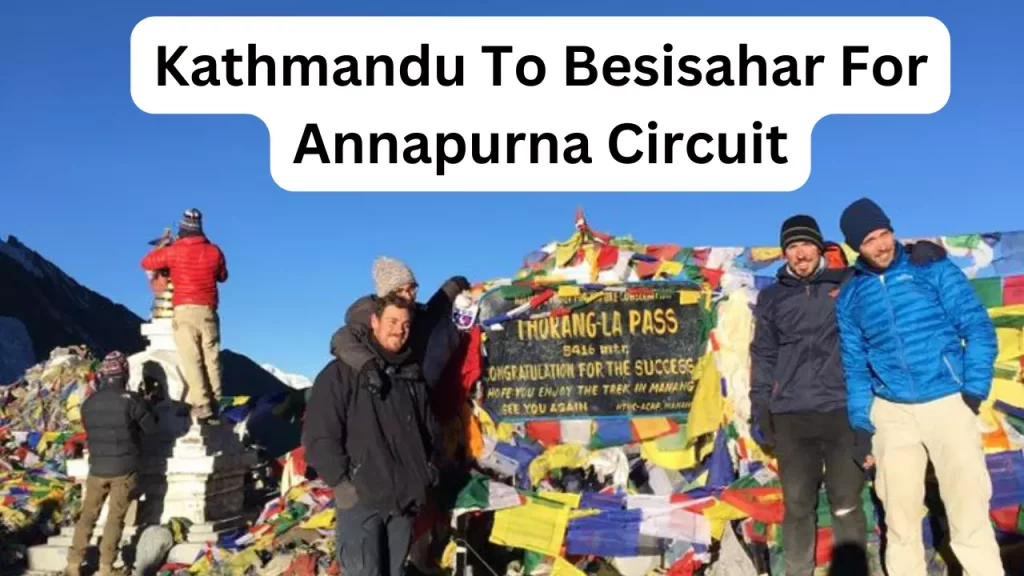
How To Get from Kathmandu to Besisahar? Flight, Bus
Kathmandu to Besisahar is an iconic journey for anyone traveling to Nepal. The 173 km journey takes you through some of the most breathtaking landscapes in the country. Travelers have the option to take a bus, plane, or jeep, depending on the kind of experience they are looking for.
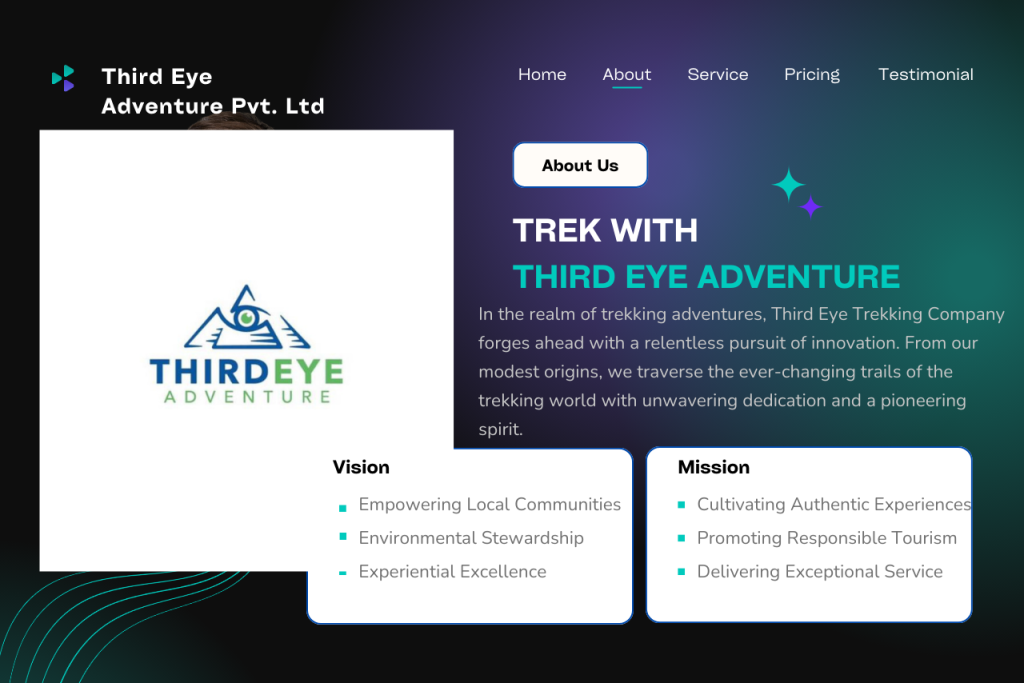
Why Trek with Third Eye Adventure
Nowadays, when discovering the world goes beyond sightseeing and experiencing, the most important choice you will face will be to find a partner for an...
![Ama Dablam Expedition [The Essential Guide] 4 Ama Dablam Expedition](https://www.thirdeyeadventure.com/wp-content/uploads/2024/05/blog_thumbnail-29-1024x683.png)
Ama Dablam Expedition [The Essential Guide]
Mt. Ama Dablam Expedition is a renowned adventurous climbing tour for the world-class steep peak that involves climbing Mt. Ama Dablam which is the most...
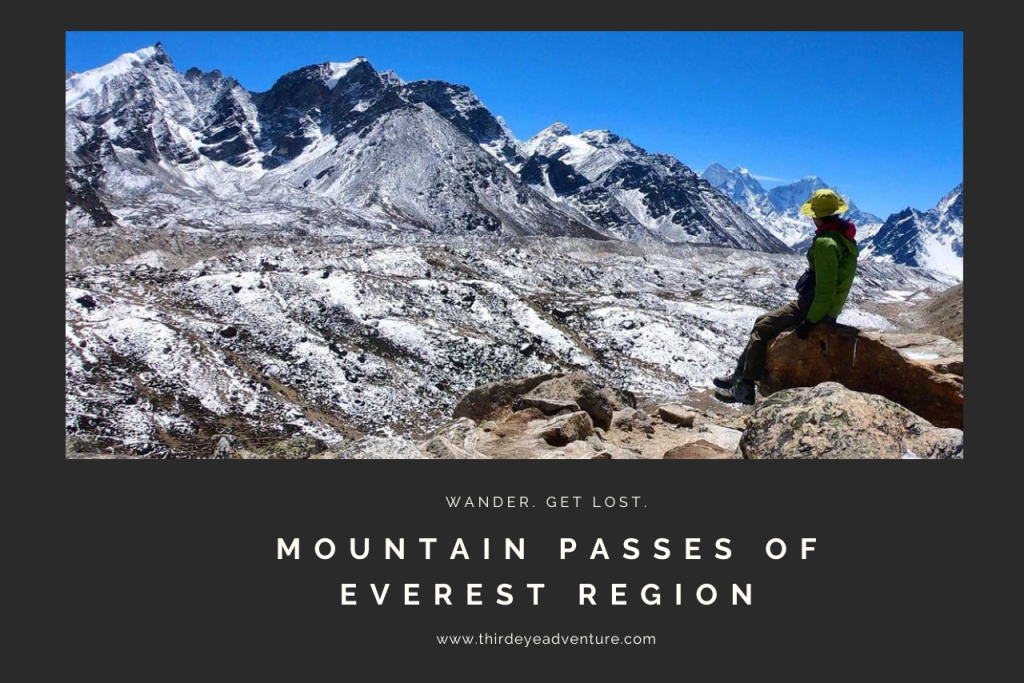
Mountain Passes of Everest Region
Everest Region which is also known as the Khubu region, has an almost mystical status in the world of trekking. It's often described as a...

- Why Do You Choose NHTE?
- Who Are We?
- Legal Documents
- Terms and Conditions
- Clients Reviews
- Ghorepani Poon Hill Trek: Poon Hill Trek 3 Days From Pokhara
- Ghorepani Poon Hill with Mardi Himal Trek
- Short Annapurna Base Camp Trek
- Annapurna Base Camp Trek 6 Days
- 7 Days Annapurna Base Camp Trek
- Annapurna Base Camp with Poon Hill Trek 10 Days
- Annapurna Circuit Trek 10 Days
- Annapurna Base Camp Trek: A lifetime journey to the world’s 10th Tallest Peak
- Annapurna Circuit Trek 12 Days
- Mardi Himal Trek
- Khair Lake and Khopra Ridge Trek
- Mohare Danda Trek
- Jomsom Muktinath Trek
- Annapurna Circuit Trek: Explore the world’s longest Thorong La Pass
- Annapurna Tilicho Lake Trek
- Ghale Gaun Trek
- Nar Phu Valley Trek
- Poon Hill Trek 3 Days
- Langtang Trek
- Langtang Valley Trek
- Short Langtang Trek 5 Days
- Langtang Gosainkunda Trek
- Langtang Tamang Heritage Trek
- Gosainkunda Pass Trek
- Helambu Trek
- Langtang Valley and Ganja La Pass Trek
- Everest View Trek
- Everest Base Camp Trek 9 Days
- Everest Short Trek
- Everest Base Camp Trek 10 Days
- Everest Base Camp Trek 12 Days: Everest Base Camp Short Trek
- Everest Base Camp Trek: Experience Nature’s Majesty at Its Peak
- 14 Days Everest Base Camp Trek
Gokyo Lake Trek
- Gokyo Chola Pass Trek
- Everest Base Camp Trekking
- Everest Three Pass Trek: Three High Passes Trekking in Nepal
- Everest Base Camp Trek Cost
- Ama Lapcha Pass Trek
- Pike Peak Trek
- Everest Base Camp Luxury Trek
- Everest Base Camp Trek Guide Cost
- Manaslu Circuit Trek
- Manaslu Trek
- Manaslu Circuit Trek 10 Days
- Manaslu Tsum Valley Trek
- Lower Dolpo Trekking
- Lower Manaslu Scenic Trek
- Rara Lake Trekking
- Rupina La Pass Trek
- Upper Dolpo Trekking
- Upper Mustang Trek: Discover the Hidden Nature & Culture of Mustang
- Chepang Hill Trek
- Ganga Jamuna Trek
- Kathmandu Valley Tour
- Kathmandu Chitwan Tour
- Kathmandu Chitwan Pokhara Package Tour
- Kathmandu Chitwan Lumbini Via Pokhara Tour
- Bandipur Pokhara Tour
- Bungy Jump in Nepal
- Helicopter Tour In Nepal
- Mountain Flight in Nepal
- Paragliding in Nepal
- Island Peak Climbing: Popular Trekking Peak Climb in Nepal
- Lobuche Peak Climbing:
- Mera Peak Climbing
- Pisang Peak Climbing
- Yala Peak Climbing
- Amadablam Expedition in Nepal
- Chulu West Peak Climbing
- Trekking in Nepal
- Packages Tour in Nepal
- Peak Climbing in Nepal
- Expedition in Nepal
- Rafting in Nepal
- Chitwan Jungle Safari
- Paraglading in Nepal
- Mount Kailash Tour
- Cho Oyu Expedition in Nepal
- Bhutan Tour
- Bhutan Cultural Tour
- Compulsory Equipment List
- Nepal Visa Information
- Currency & Payments
- Travel Insurance

- Destination Nepal
- Region Everest
- Duration 12 Days
- Transportation Flight
- Max Height 5340m.
- Activity Trekking
- Trip Grade Moderate/Adventure
- Accomodation Hotel/Lodge
- Group Size Mini. 1 Pax
- Best Season Sep-Nov & Mar-May
- Meals B.L.D.
- Start / End Point Lukla to Lukla
Trip Overview
Up in the mountains, there is a gorgeous blue-turquoise glacial lake. With an image of gigantic mountains on the lake water, the scenery looks purely fictitious and mythic. Sherpa, mountains, myth, and lakes present splendid holiday moments. Gokyo Lake Trek in the Everest region of Nepal is probably the most beautiful trekking route of Khumbu. This trek offers adorable scenarios of Gokyo lakes, glaciers, and fabled mountains with hidden Sherpa cultures.
The Everest region of Nepal is the epitome of all trekking adventures. It is probably the most kept travel bucket list destination. After Everest Base Camp Trek , Gokyo Lake Trek is the most eminent trekking route in the Khumbu region of Nepal. However, you can extend the trek to Everest Base Camp as well via Chola Pass (5420m). Nepal High Trek & Expedition has probably the latest and correct itinerary of the Gokyo Valley Trek. The major reason behind this is the trekking crew members. All of our guides and porters for the Khumbu trekking are either Sherpa or locals.
Blue Turquoise Lake and Sherpa Hamlet
At an altitude of 4700 m from sea level, you can find five outstanding lakes. These lakes are listed in the Ramsar Site as well. Even if there are five lakes, the most popular one is the third lake. However, people explore all three lakes including the Gokyo Ri hiking during the trip. The lake is not only beautiful but also has religious significance. Sherpa people worship the lake every year as they believe the god resides in the lake. Interestingly all five lakes are connected underground as well. However, it is just a myth.
1st, 2nd, and 3rd Lakes are on the way to the teahouse area. However, the fourth and fifth lake is above the teahouse valley. Earlier the place was the pasture land used by the Sherpa people of Khunde and Khumjung. Nowadays, a small hamlet is there but no houses. The shores of the lake are full of teahouses.
A Mesmerizing Gokyo Ri Viewpoint in the Khumbu
Probably, Gokyo Ri Viewpoint is one of the best and most marvelous viewpoints in the Khumbu region. The highlight of the Gokyo Lake Trek in Nepal is the hiking of Gokyo Ri as well. Witness either sunrise or sunset from the top of Gokyo Ri (5357 m/17575 ft). You can get the outstanding scenery of mountains as far as Mount Everest, Mount Makalu, Mount Choyou, and Mount Lhotse , and panoramic views of the stunning Himalayas . Bask in the fantastic vantage point from where you can get the view of four of the top ten mountains of the world. The panoramic view of the mountains helps trekkers to forget all the hardships of the journey.
Gokyo Fifth Lake – The Place for a Unique Everest View
During the Everest Base Camp Trekking journey, trekkers get a glimpse of Mt. Everest. However, it is through a small window in between the Lhotse and Nuptse walls. But the view of Mount Everest from Fifth Lake is outstanding. Therefore, lots of people trek to Gokyo Lake for the splendid and different view of Mount Everest.
Route Overview of Gokyo Lake Trek
Almost every trekking trip in the Khumbu region starts from Lukla except for some classical treks. It is similar to Gokyo as well. Check out the Everest Base Camp Trek itinerary for more information on the route up to Kyangjuma nearby Namche Bazaar. Trekkers leave the main Everest Base Camp Trail in Kyangjuma and head to the Mongla Danda route. After the acclimatization rest in Namche Bazaar, trekkers have to stay overnight in places like Dole and Machhermo before reaching the Gokyo Valley.
Altitude Sickness, Travel Insurance & Acclimatization
Trek to Gokyo Lake is also one of the high-altitude trekking in Nepal. The highest point on this trip is 5357 m from sea level. However, overnight high altitude resting place is an altitude of 4700 m. Therefore, the trail is prone to altitude sickness. Interestingly, trekkers don’t need to worry about altitude sickness during this trek. The acclimatization rest in Namche Bazaar is enough for the trekkers to continue walking higher.
The Gokyo Lake Trek in Nepal requires travel insurance. Trekkers must buy an insurance plan. The plan must include helicopter rescue, accidents, flight delays, and medical expenses.
Sherpa Culture & Diverse Forests
The trail is good for understanding the Sherpa people and the diverse forest environment of Khumbu. Trekkers start the trek from the deciduous forests belt and reach high up to the alpine forests belt. Therefore, vegetation lovers can find wonders on the trail.
As for the cultural attractions, Sherpa villages and monasteries are the highlights. There are many pagodas, Mane walls, and monasteries along the way. Moreover, a visit to the Sherpa villages offers an authentic chance to understand these intrepid mountain climbers. Understanding them in their comfort is always fascinating. Imagine yourselves interacting with the fierce mountain climbers. Well, it is a truly remarkable experience to view mountains and their conquering beast in just one single trip.
Can I do the Everest Base Camp Via Gokyo Lake Trek?
Yes, it is possible to do Everest Base Camp Trek after the Gokyo Lake excursion. Moreover, you can buy the Everest Base Camp Chola Pass Trek package . It includes Everest Base Camp, Everest Three High Passes Trek , Chola Pass, and Gokyo Valley. Therefore, if you wish to add the base camp then it is wise to get the EBC Chola Pass Trek package.
Apart from the Everest Base Camp, Gokyo Valley is also the focal point during the Everest Three High Passes Trek. After crossing the Renjo La Pass, trekkers can reach the Gokyo Lake area. The Khumbu Circuit Trek consists of Gokyo Valley as well. The place is at a crossroads. Therefore, you can add either adventure three-pass trek or Everest Base Camp to your itinerary.
Nepal High Trek – A reliable Trekking partner for Everest Region Travel Activities
It’s been more than a decade since the company is operating trekking in the Everest region of Nepal. Our guides and porters are from Khumbu. Therefore, we have the latest information and authentic data about mountains, people, culture, and climate. For high-altitude trekking, it is essential to have the perfect guidance and itinerary. We have the highest success rate. So, without any delay contact our travel planners. Plan your Gokyo Lake Trek in Nepal with Nepal High Trek And Expedition.
Related Picture Gallery

Details Itinerary
Day 01: reach kathmandu and transfer to hotel.
The representatives from Nepal High Trek & Expedition Pvt. Ltd. will welcome you at TIA. Then we will take you towards the hotel arranged by our company for the overnight stay. We will have a discussion about trekking with delicious dinner.
Day 02: Fly to Lukla 2,820m and trek to Phakding village 2,640 m – 04 hrs.
Everest Base Camp Trek begins with the sweeping short flight to land at Lukla, during 30 minutes on air view of stunning mountain range with Mt. Everest, as the plane lands at Lukla named as ‘Tenzing-Hillary Airport’ in honor of legendary climbers’ first summiteers of Mt. Everest.
From Lukla, our first-day walk starts on winding downhill path with short climb passing many traditional Sherpa farm villages with views of peaks, after a pleasant walk reaching at Phakding for an overnight stop near the glacier-fed Dudh Kosi (river).
Day 03: Trek to Namche Bazaar 3,440 m – 06 hrs.
After a pleasant overnight stop in Phakding, morning walk starts following Dudh Kosi, and crossing bridges to reach Sagarmatha National Park at Monjo village, from here walk to last Jorsalle village before Namche Bazaar and then on crossing a last high bridge climb leads with beautiful views of Everest and other peaks, walk finally ends at famous Namche Bazaar for two over nights in this prosperous town or large village with facilities of ATMs, Cybercafes, stores, shops, restaurants, banks and fresh bakery with a busy colorful Saturday market.
Day 04: Rest day at Namche Bazaar for acclimatization.
Namche an ideal spot for rest and acclimatization, free day with morning short hike up to park museum with necessary information of mountaineering, flora/fauna with Sherpa culture and Buddhist religions, this scenic spot offers grand views of mountains Mt. Everest and stunning Amadablam, for interested people hike uphill to Everest View Hotel for best views of Mt. Everest and other mountains.
Day 05: Trek to Dole 4,110 m – 05 hrs.
After a pleasant stop at Namche Bazaar, our walk leads to a short climb and then on the gentle winding trail with eye-catching views as the walk leads near Shanasa village. From this spot, our route diverts away from the main Namche-Everest base camp trail towards quiet areas towards Gokyo Lake. The path climbs with the steep climb to reach a Mong 3,973 meters with amazing views and then downhill walk to Dudh Kosi River at Phortse Thanghka for lunch.
After Phortse, continue to walk to Dole as the trail climbs steeply out of the valley through a patch of rhododendron forest which gives way to juniper and conifers trees. In the springtime, this place will be magic with wildflowers in full bloom. This path passes summer Yak pastures. The trek leads past Tongba and Gyele villages to reach at Dole with super view of Khumbila and Tawache 6,542m.
Day 06: Trek to Macherma 4,470 m -04 hrs.
Morning walk from Dole climbs along the side of the valley, where rhododendron forest stops, giving way to smaller bushes of juniper as you gain altitude slowly. Finally, walk leads on the level path for an hour to Lhabarma Kharka and to Luza at 4,390m; and then skirting around a ridge with downhill to Macherma village. Arriving at Macherma for lunch and overnight stop with time in the afternoon for a short walk or just relax.
Day 07: Trek to Gokyo 4,790m -04 hrs.
From this small settlement, our walks continue to Gokyo 3rd Lake, following a scenic path to Pangka small area and then descend slightly, following one of the glacial fed rivers which flow from Ngozumba Glacier of high world 6th highest Cho-Oyu and other adjoining peaks.
The walk leads to a climb by the side of a glacier, passing first lake and the second lake, crossing the path to reach at the third lake known as Dudh Pokhari or Gokyo Lake a summer settlement with fantastic views of Mt. Cho Oyo and Gyachung Kang that reflects on emerald green waters of Gokyo Lake.
Day 08: Morning hike to Gokyo-Ri and walk to Na or beyond – 04 hrs.
Morning hike uphill to Gokyo Ri one of the highlights of this trip, a small peak above the lake, Gokyo Ri at 5,357m offers the panorama of Mt. Cho Oyo, Gyachung Kang, Mt. Everest, Lhotse, Cholatse, Taweche and far as to Mt. Makalu.
After a wonderful stop at Gokyo Ri, head downhill to Gokyo for lunch and rest, afternoon short walk of few hours to Na, a small place located at the foot of Ngozumba glacier with time head further for another hour for an overnight stop.
Day 09: Trek to Phortse village 3, 810 m – 04 hrs.
Starting from this isolated area beneath towering Cholatse peak on the least trekked trail to Phortse village, morning walks leads downhill for short 3-4 hours, to reach another sleepy village at Pangboche for lunch and overnight stop. Afternoon explores this nice small Sherpa village, where trekkers seldom walk on this route.
Day 10: Trek to Tengboche 3,867 m – 05 hrs.
Leaving Phortse village with super views of Amadablam, on the gradual winding path uphill to reach upper Pangboche near an old Gompa (monastery), after a rest with lunch break then downhill back into tree lines, from the bridge few hours climb to Tengboche Monastery, located on a small plateau with marvelous views of mountains including Mt. Everest and majestic Amadablam surrounded with pristine rhododendron-pines-oaks and birch tree woodland.
Here with time to visit this interesting monastery which was badly damaged by fire in 1991 and rebuilt back into original shape
Day 11: Trek to Monjo 2,880 m through Namche Bazaar – 06hrs
Morning walk leads to long descend reaching at Imjatse River in Phunge Tenga, after crossing a bridge with short steep uphill and then on gradual winding trail to Namche Bazaar, after a short break at Namche, continue to walk on downhill to Dudh Kosi River valley, and then with short ups and downs to reach at the entrance and exit gate of Sagarmatha National Park, a short walk from brings you at Monjo village for overnight stop.
Day 12: Trek back to Lukla for last overnight in Khumbu area – 04 hrs walk.
After a marvelous and enjoyable time on high Khumbu valley and ridges around Gokyo Valley, our last day walk of this adventure leads back on the same trail to Lukla, arriving in Lunch by lunchtime with last overnight stop within Everest region, after lunch free and celebrate dinner with fellow members, staff and guides.
Day 13: Fly back to Kathmandu and transfer to hotel.
Waking early morning to catch the flight back to Kathmandu, transfer to Lukla airport terminal and then board in a small aircraft either twin otter or Dornier, for super scenic flight to reach at Kathmandu, on arrival in Kathmandu airport, transfer to your respective hotels with rest of day free for individual activities and souvenirs shopping.
Day 14: In Kathmandu free and reserve day for individual activities.
An important and necessary to have one extra day in Kathmandu in case of flight delay and cancellation, due to bad unfavorable weather which can happen sometimes as Himalayan weather is unpredictable. If all goes well as per our itinerary days, one can join in our delightful and interesting tour of Kathmandu-Patan and Bhaktapur, all these places full of world heritage site of historical-culture and religious importance.
Day 15: International departure for homeward bound.
Your last day in Nepal, amazing country of Himalayan wonders, as per your flight time leaving your hotel where our staff transfers you to an airport, after a great memorable adventure with enjoyable time on Gokyo Valley trekking.
- All ground transportation.
- Meals During Trek: (Breakfast, Lunch, and Dinner).
- Two-night hotel in Kathmandu with breakfast.
- Three cups of tea during the trek.
- Everest National Park Permit.
- Khumbu Municipality Entrance Ticket.
- Domestic Flight Ticket From Kathmandu to Lukla / Kathmandu.
- Good Accommodation on the trek.
- Fresh fruit during the trek
- NHTE’S Dawn jacket, sleeping bag & duffle bag. (If required )
- An experienced, expert, helpful and friendly Guide and Their well-paid Salary, Food, Drinks, Accommodation, Transportation, and Insurance for the Guide.
- Adventure Certificate: NHTE provides Adventure Certificate.
- An arrangement of Emergency Helicopter service which will be paid by your Travel insurance company.
- Medical kit bag.
- Farewell dinner.
Cost Exclude:
- Nepal entry visa fee.
- Your Travel insurance.
- Personal porter for carrying your luggage.
- All the Food in Kathmandu. Also in the case of early return from the mountain (due to any reason) then the scheduled Itinerary.
- All the expenses in the mountain over than scheduled itinerary (due to strike, delay, or canceled flight)
- Extra night Hotel in Kathmandu if arrive early or late departure than scheduled Itinerary.
- All the Bar bills and personal expenses (phone call, laundry service, battery recharge, a bottle of water, hot water, shower.
- Tips for the guide and porter.
Gokyo Lake Trek Route Map

Frequently Asked Questions
Cost & date, client reviews, similar trips.

Our Partners

Sign Up for Our Free Newsletter
Make an inquery.
Trip Name : Your Name : Your Email : Telephone No : Your Message :
Nepal Govt. Reged. number: 39829/2005
Tourism License number: 805/2005
VAT/TAX Number: 302385791

Gokyo Treks Nepal
Nepal Trekking Agency
From 2015 - 2024 contineously
+977 9841 249 988
Gokyo Ri Trek
Home » Gokyo Ri Trek
Based on 12 Reviews
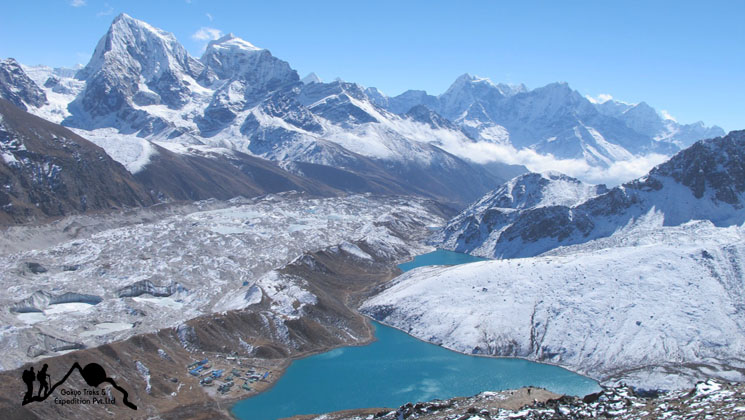
Gokyo Ri Trek Summary
- Gokyo Trek Duration: 10 Nights 11 Days
- Trek difficult Level: Moderate Grade
- Gokyo Ri Altitude: 5,357m/17,576 feet
- Trek Hours: 5-6 Hours daily
- Trip Mode: Hotel – lodge Basis
- Group-Size: 1 – 15 People
- Best Time to Hike: March, April, May, October, November and December
- Foods on Trekking: Breakfast, Lunch, and Dinner
- Transportation: Car/Plane
The Gokyo Ri Trek is a popular trekking route in the Himalayas that offers breathtaking views of the mountains and glaciers in the Everest region of Nepal. Gokyo Ridge is the highest point of entire trek stands at 5,357m above the Gokyo lakes.
Hike to Gokyo valley, you pass through the Sherpa villages, where you have an opportunity to experience their unique culture and lifestyle. Additionally, traveler’s can see stunning views of the Everest, Lhotse, Makalu, and Cho Oyu mountains including many other popular summits.
Gokyo is a glacial lake, a holy pilgrimage place for both Hindus and Buddhists. Lakes at Gokyo are formed by a freshwater system, collectively known as Gokyo Lakes that are situated above 16,000 feet above the sea level.
Ngozumpa glacier situated at the Mount Cho Oyu base camp, the sixth-highest mountain in the world. It’s 36 kilometers (22 miles), is the longest glacier in the Himalayas in Nepal. Walk into this unique valley inhabited by a solitary Tibetan-Buddhist civilization of Sherpa with antique establishments centuries years old.
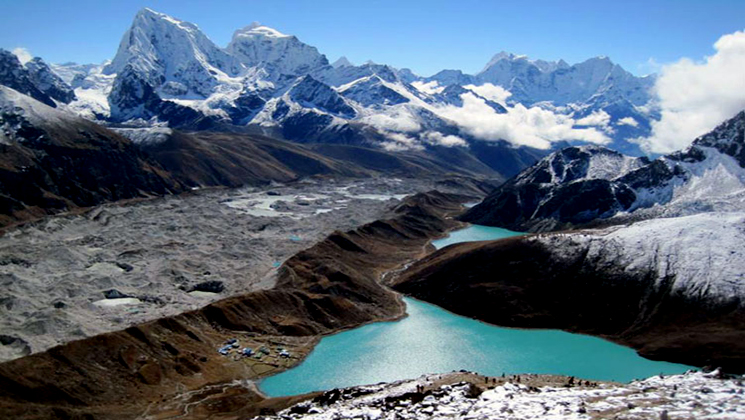
Completing the Gokyo Ri trek typically takes around 9 to 11 days, covering a distance of approximately 70 kilometers. Airport at Lukla serves as a gateway to traversing delightful valleys and crystal-clear blue and green pristine lakes.
It is dominated by the world’s biggest ice glacier and the nearby Everest mountain range. Acclimatization is essential during the trek, so it is important to take your time and ascend gradually to avoid altitude sickness.
In general, Gokyo Ri Trekking is a challenging but rewarding experience that offers stunning views of the mountains and a chance to immerse yourself in the culture of the Everest region.
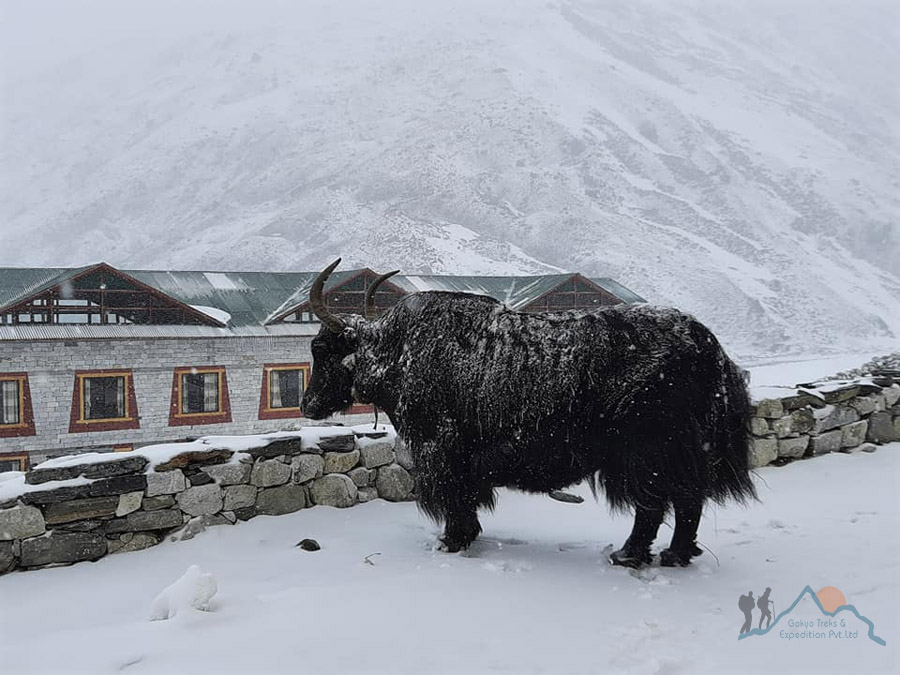
How much is the Gokyo Ri Trek Package Cost?
The cost of a Gokyo Ri trek package with Gokyo Treks local agency ranges between US$ 998 and US$ 1435. This trek to Gokyo valley price depends on the services you choose and the size of your group. This cost includes Lukla flights, transportation, a guide/porters, hotels, food, accommodation, and hiking permits.
We also offer discount deals for hiking group leaders. For example, if you could bring 10+ travelers (except you) on your trip, you are treated as a group leader. So you can hike to Gokyo ri at a 50% discounting price.
Despite that, we often arrange private trips to avoid group tours with strangers, providing a more personalized hiking experience. If you value customization, flexibility, and in-depth experiences, a private trip tailored to your personal needs is the best option.
It’s a standard trip package price for 11 days hike to Gokyo Ridge in the Everest territory. If you are 2 Tourist for Gokyo Ri Trek Package Cost US$ 1175 for 11 days trek as per the above plan. We can modify the trek route and the price as per your wish. Here is the price list for the Gokyo ri trek.
Price Per Person for 11 days Gokyo Ri Trek in the Everest region.
Generally the price covers your trekking permits, transportation, food and accommodation, guide, porter, and more. For details on what is included and excluded from this trip price, please refer to the Gokyo Trek cost information provided on the tab button.
Gokyo RI trek itinerary details.
Exploring the 11-day Gokyo Ri trek itinerary offers a unique route in the Everest region, culminating at the Ngozumpa glacier lakes. Designed for both novice and seasoned trekkers, this path caters to those eager to conquer the stunning Gokyo summit but are limited by time.
For those seeking a more leisurely journey to Gokyo peak, this itinerary offers a balanced pace. If this plan doesn’t align with your preferences, feel free to request a customized itinerary tailored to your needs.
Take an early morning flight from Kathmandu to Lukla airport at 2,840m (distance from Kathmandu to Lukla airport is 138 kilometers) that takes 35 minutes of flight. However if you plan to hike in the high season then there will be flight to Lukla via Manthali Airport , base of Ramechap district.
For safety reasons and to reduce air traffic congestion at Kathmandu airport, the Civil Aviation Authority of Nepal (CAAN) has redirected all Lukla flights to operate via Manthali airport. Additionally, flying from Manthali to Lukla is considered safer and more reliable as the route follows the river valley.
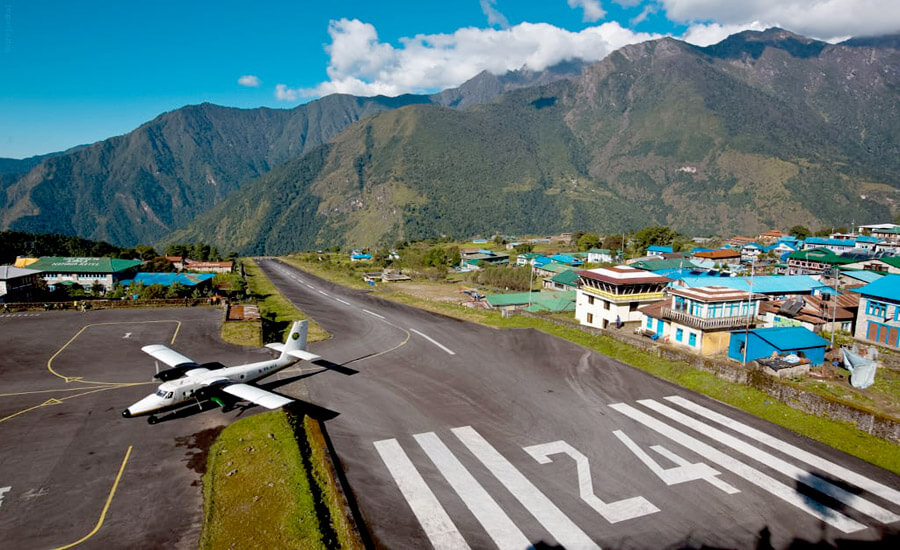
After reaching Lukla, enjoy breakfast at the hotel while our hiking crew organizes and secures your luggage for the trek ahead. Taking a few hours to acclimate in Lukla helps your body adjust before starting the journey toward Phakding village.
Phakding, situated at an altitude of 2,640 meters, is a sizable settlement with approximately 50 lodges. Our trek involves a gradual ascent along the mountainside, following the left bank of the Dudh Koshi river. Along the way, we pass through several Sherpa villages, including Ghat, and cozy guest houses, eventually arriving in Phakding.
Continuing along the trail marked by various ascents and descents, we navigate across a stream and pass through the curious village of Monjo. Our path leads us to the Sagarmatha National Park office, where the necessary park entrance fee is settled. Following a brief stroll along the valley’s riverbed, we encounter the convergence of major rivers in this area.
Cross the Hillary bridge and proceed to undertake a steep ascent toward Namche Bazaar. Along this route, breathtaking views of Everest (8,848m) and Lhotse (8,516m) unfold. Nestled amidst mountain ranges on three sides, Namche Bazaar at 3,440 meters stands as a bustling central hub offering provisions ranging from food to essential trekking gear.
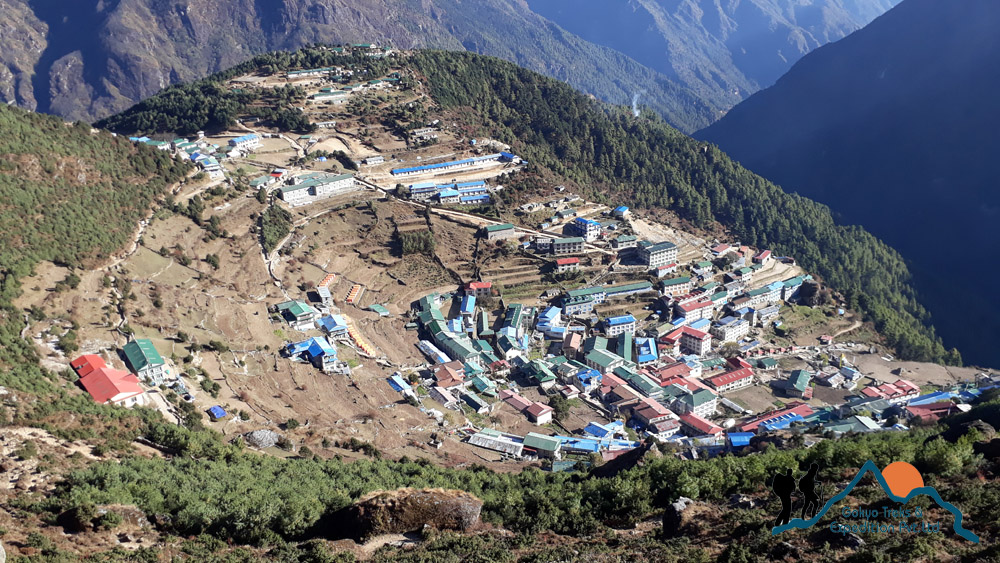
Today is an acclimatization day that amidst the vibrant energy of Namche Bazaar, a time to delve into the hills and bustling markets. Our journey kicks off with an invigorating one-hour ascent to the Sengboche airstrip.
From there, we gradually ascend towards Khunde, passing a trail adorned with numerous chortens—stone Buddhist monuments—and hill stations. Trekking through these stations offers panoramic views of Mt. Everest, Ama Dablam, Thamserku, Nuptse, Lhotse, Kongde, and a myriad of other snow-capped peaks from a 360-degree view.
A visit to Khumjung village is a largest settlement in the entire Khumbu, situated at the base camp at Khumbila peak. It has an opportunity to visit the Khumjung school established in 1961 with support from Sir Edmund Hillary’s Himalayan Trust. Time permitting, we can explore the Khumjung monastery, a spiritual sanctuary in this ancient Sherpa community.
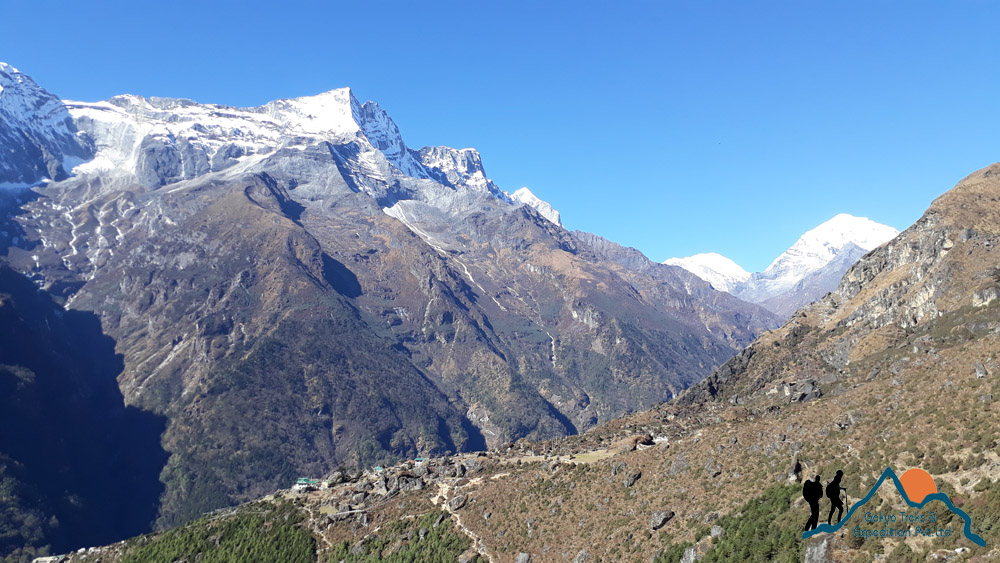
Khumjung holds a wealth of Sherpa cultural heritage, woven by a people whose roots extend deep into the history of Everest’s first summiteers. Born and raised amidst the secluded Himalayas, these individuals have thrived at altitudes surpassing 11,500 feet.
After delving into the array of experiences, from the mesmerizing vistas of the HEV (Everest View Hotel) to the invaluable treasures housed in the National Park Museum, we descend to spend another night at the same hotel, absorbing the essence of this remarkable place.
Our ascend is a same direction to Tengboche and base camp until Sanasa, trail thereafter ascends gently up to Mongla hilltop lodges. Mong la hill situated at 4,000 meters elevation and offers a terrific view of splendid mountains like a beautiful Shangri-La.
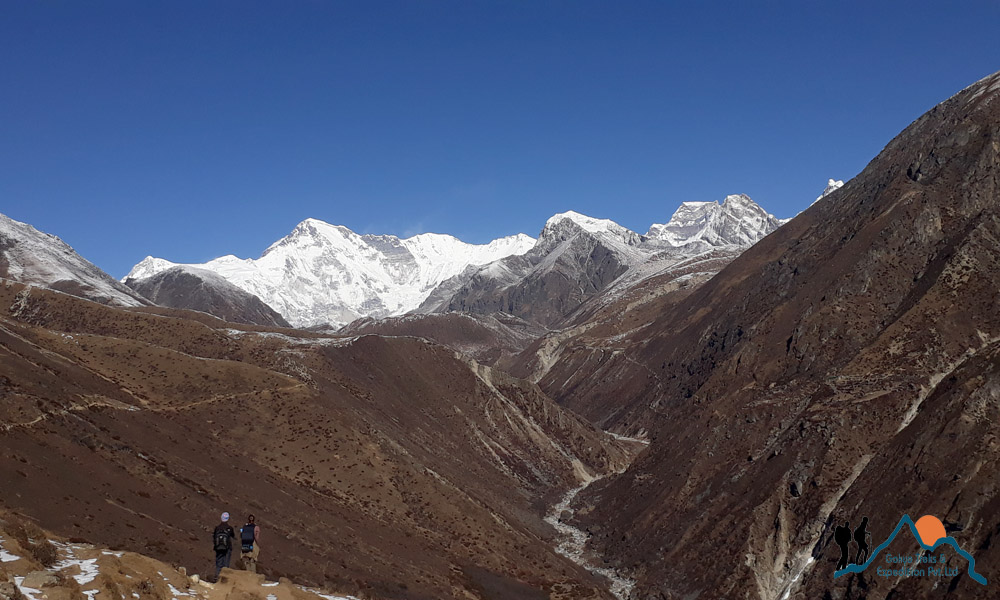
Descend to Phortse Tenga and rises steeply to Dhole passing through rhododendron and birch forests decorated with hanging mosses and lichens.
Leaving your footprints, we continue along the side of the valley, where the small and thorny bushes give way to scrub juniper as the altitude increases. Pass many summer settlements using yaks are taken to these pastures to graze in the summer months. Ahead of you are excellent views of Cho Oyu, while back down the valley are the peaks of Kantega and Thamserku.
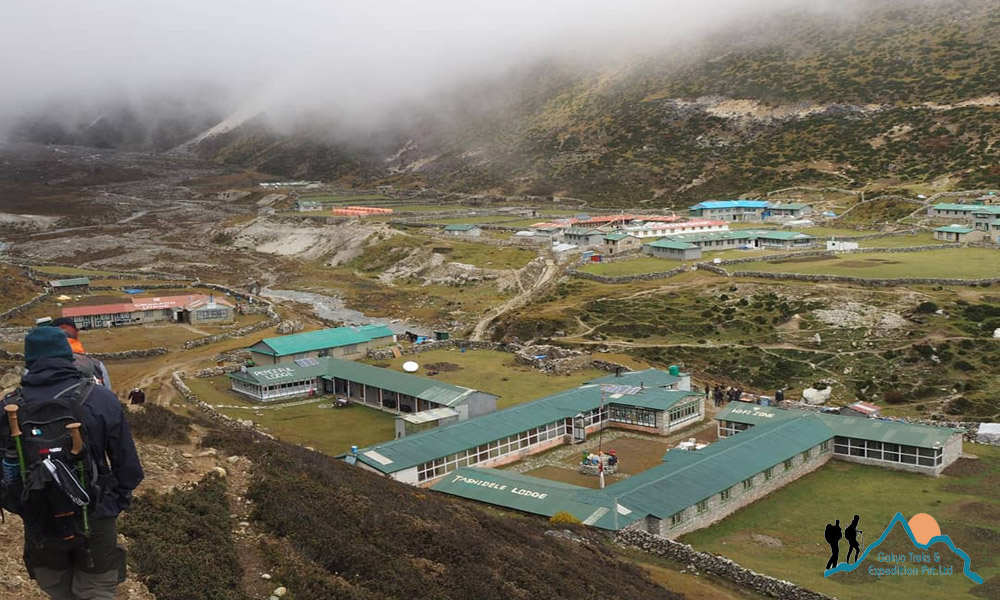
Today, our Gokyo trek leads over a very scenic path to Pangka and descend slightly. Continue to follow one of the melt-water Rivers which flow down the west side of the Ngozumpa Glacial moraine. Climb a steep rocky sloping into the Gokyo glacier valley and pass the first holy lakes.
Cross the path and soon we arrive at the second glacial lake that heads across the glacier to Cho La. Third lake known as Dudh Pokhari will appear and on its eastern shore is the settlement of Gokyo resorts.
Walk on the bank of the glacial Gokyo lakes, and we reach our final destination at Gokyo lodges where we stay overnights. This whole Gokyo valley hiking represents a Gokyo trek in Everest territory. It’s a small settlement that serves tourists and normally closes in winter due to extreme cold, ice, and snowfall.
Everest Gokyo is a trade center where the Sherpa people run lodges to provide the best services to guests. Gokyo 5th lake is situated with Ngozumpa glacier, the biggest glacier in Nepal. Today, we walk around the glacial lakes to the fifth lake.

An optional trip will be to discover the 5th lake on your day trip but if you are only physically fit. Ngozumpa glacier excursion is not an easy-to-reach 5th lake although it is the best glacier hike in Nepal. Reaching out to the 5th lake is another most beautiful part of the journey like the iceberg lake glacier.
Gokyo Ri hike looms above the village on the northern edge of the lake and we leave camp just after first light, following a steep path up the hillside. About 90% of hikers make their plan to reach the Gokyo ridge summit to achieve impressive sunlight over the mystical glacier lakes. Sightseers can get an almost outstanding sunrise view from Gokyo hill.
In addition, the Gokyo Ri summit offers the highest Cho Oyu mountains, Everest, Lhotse, Makalu ..etc. Likewise, the jaw-dropping view from Gokyo Ri additionally includes several other tallest peaks in a line.
The view of Mount Everest is much better from Gokyo ridge comparing Kala Patthar hill. After photography, we return to the Gokyo guesthouse for breakfast. Roughly we take Lunch at Machermo and continue to walk to Lhabarma or even downhill to Dhole to stay overnight. Journey after Machermo lodge to Dole is an easier grassy trail that takes tourists about two hours.
Gokyo valley trail gently descends to Photse Tenga at 11,975 feet passing across rhododendron forests. Immediately ascends to the Mongla hilltop at 4,000 meters, a great Shangri-la to obtain a glimpse of the tallest Himalayas together with the Mount Everest range and Cho Oyu.
Short staying at Mong-la hill station is a trekker’s paradise, thus tourist have a short break seeing the Everest view on the right and Gokyo valley on the left. Gently descends to Kyanjoma at 3,500m and follow a classic path with small ups and down to Namche Bazaar, the backpackers’ paradise.
Enjoy your last minute to watch the amazing mountains and continue to descend footsteps to cross to Hillary Bridge over the Dudh Koshi river. Walk and cross an iron bridge over Dudh Koshi to Jorsale. Jorsale offers nice lodges with comfy bedrooms and super delicious foods.
20 to 30 minutes trek further to Monjo village we checkout our Everest trekking permits. Monjo is a tiny village stands at an altitude of 2,835 meters has nice terraces and is a good place to view the entire valley.
Our way back to Lukla following the familiar trail that we took on our ascent. It’s a final day of our unforgettable journey. Therefore, upon reaching Lukla, we settle into our comfortable hotel near the airport, where you can relax and unwind.
Alternatively, you’ll have an option to explore the charming shops in the vicinity, offering a variety of souvenirs for you to cherish the memories of this remarkable trip.
In the evening, a special occasion awaits as you invite for delicious dinner with your porters and guide. As a gesture of appreciation for their support throughout the journey, we kindly cover their expenses for this dinner. It’s a time for camaraderie and reflection on the incredible experiences we’ve had together, making it a truly memorable final night of our trekking adventure.
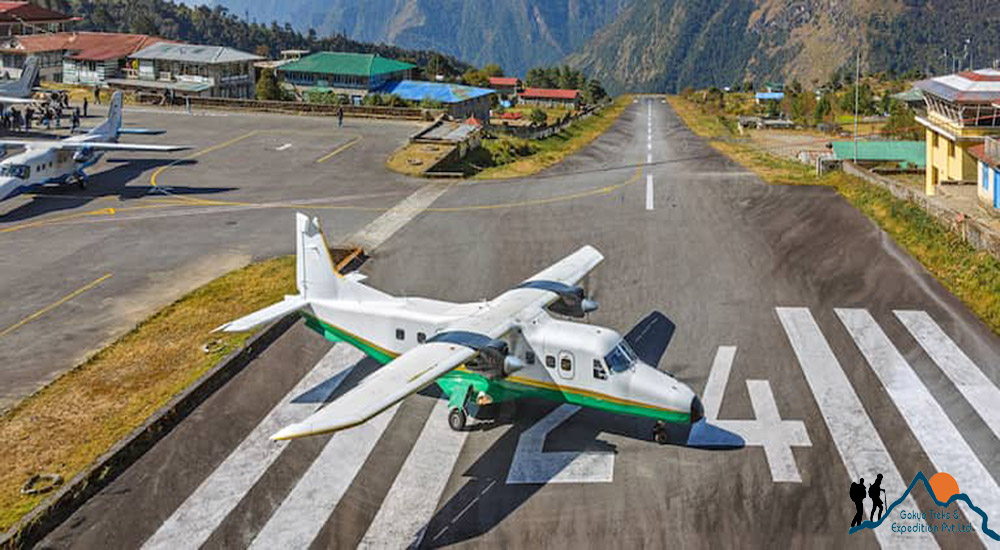
We embark on an early flight from Lukla to Kathmandu. Once we land at Tribhuvan International Airport, your guide will assist in organizing your transfer to the hotel. In the afternoon grants an opportunity for shopping or, if desired, you can opt for a guided exploration of Kathmandu at an additional cost. This marks the conclusion of the trip. !
Not satisfied with above plan?
Interested in planning a custom trip? this might take 2 to 3 minutes.
How much does the Gokyo Ri trek package price?
This 11 Days Classic Gokyo Ri Trek price starting at US$ 998 per person on a double occupancy basis, with the potential to reach up to US$ 1435. Gokyo Treks and Expedition agency has set these rates for the express Gokyo Ri Trek Package for 2024 and 2025, considering the group size you’ll be traveling with.
For those seeking deluxe and luxury trekking experiences, we offer enhancements such as 3-5 star category hotels in Kathmandu with deluxe air-conditioned rooms including breakfast. Throughout the journey, comfortable bedrooms with attached toilet/bathroom facilities are arranged in feasible locations. Remember, we are flexible and open to tailoring your trek and adjusting package prices according to your specific requirements.
Nepal Gokyo ridge trek package price includes:-
- Kathmandu to Lukla flight and return round trip airfare with applicable domestic airport tax.
- 10 Breakfast serve with a cup of tea/coffee, 10 Lunch and 10 Dinner [main course] along the journey in the mountains.
- 10 Nights Lodge accommodation with a sharing/common toilet basis during the Gokyo trekking.
- License holder Professional Mountain Trekking Guide for Gokyo valley trek.
- An assistant guide will provide for 7 plus group tourists.
- Required number of porters during the trek (one porter = two guest basis) because our porter can carry maximum of 24 kilos of tourist bag pack.
- Well-paid salary, food, accommodation, and insurance of Nepalese Guide and porter.
- Sagarmatha National Park entrance permit for Gokyo hike.
- Khumbu Pasang Lamu municipality entrance permit fees
- Agency’s duffel bag (50 liters capacity) and trekking poles if Necessary – return after a trip.
- Trek completion certificate and Gokyo Ri trek map – keep them as a souvenir.
- First Aid kit bag including fingertip Pulse Oximeter every day to monitor oxygen level and pulse rate to prepare for high altitude risk. However, in a worst case, help with all Rescue and evacuation arrangements (but not the rescue bills).
- Nepal Government Tax, VAT, and as well as Company service charge.
Gokyo ridge package trek price excludes:-
- Lunch and Dinner on your stay in Kathmandu city.
- Battery charges, laundry service, phone calls, and hot showers on Gokyo valley trekking.
- Personal trekking equipment and Clothing.
- Kathmandu city tour guide, entrance fee, and a private car transfer if you wish to add on tour.
- Private nature expenses, all types of drinks, desserts, and bar bills.
- Travel Insurance to cover emergency Rescue and Evacuation in case of an emergency.
- Any donation and monument entrance fees.
- Gratuities for guide and porters [Tip is a culture, so they expect highly].
Prepare your hiking essentials, from dawn jacket to a cozy sleeping bag, and embark on an adventure across the vibrant trekking circuits of Nepal. Whether you’re geared up for solo exploration or seeking a private trek to Gokyo Ri, we’re ready to arrange a journey that fits your schedule. Get in touch with us for further details and the best possible deals.
Guaranteed – Trip is Guaranteed to run.
Available – Trip is available to run if minimum group size is filled
Limited – Only few space available
Question: I am first timers in Nepal – do I need experience for Gokyo Valley Lodge trekking?
Answer: As a first-timer in Nepal, you don’t need prior trekking experience for the Gokyo Valley Lodge trek. It’s designed to accommodate both novice and seasoned trekkers, offering a manageable and rewarding adventure with stunning views and comfortable lodges along the way.
Question: Is pick up service available on my arrival day in Kathmandu?
Answer: Yes sure. Provide us with your flight details and request to pick you up from Kathmandu international AIRPORT. Our representative will pick up you from Kathmandu international airport to your hotel in Thamel.
Question: Can I store my luggage/stuff in Kathmandu?
Answer: Yes, you can store your luggage and extra stuff in Kathmandu. Many hotels also offer secure storage facilities for your belongings while you are on your trek. Storing your stuffs in the Gokyo Treks agency office is also for free.
Question: Is Gokyo valley lodge trekking Safe for a Solo Female Trekkers?
Answer: Yes, this Gokyo valley lodge trek is widely regarded as safe for solo female trekkers. However, as with any trekking adventure, it’s crucial to take precautions and remain aware of your surroundings.
Our team consists of honest and friendly guides who treat every trekker like a family member. We have been organizing treks for solo female travelers since our establishment, ensuring their safety and enjoyment throughout the journey.
Question: What kind of accommodation and food can I expect on trek route?
Answer: We provide you with the tourist standard accommodation along the trekking routes. Rooms are clean with cozy beds with nice mattresses and a blanket. However we recommend you take your own sleeping bags if you have one with you otherwise, you may rent them while you are in Kathmandu.
At the Guest houses en route, they have attached restaurants. They cook a delicious range of vegetarian meals such as Pasta, tuna bakes, noodles, potatoes, eggs, veg curry rice, bread, and soups. Likewise, Dinner and breakfast are provided in the same lodge you spend the night every day and Lunch will be served on the way to the next place where you hike.
Question: What opportunities will I have for a shower?.
Answer: Along the Gokyo Valley trek route, most teahouses and lodges offer hot basic shower facilities. While some places might provide hot showers for an additional fee, the availability and quality of these facilities can vary. Talk with your guide and it’s a good idea to check with your accommodation each day about shower options.
Question: How do I get drinking water on Gokyo Ri trekking?.
Answer: Along the Gokyo Valley trek route, there are hotels and shops where you can buy mineral water. However, we advise against purchasing plastic bottled water due to the lack of disposal facilities. Instead, tourists can buy boiled water or use aqua tablets to purify tap or campsite water, which is readily available.
Question: What should my insurance policy cover during the Gokyo trek?.
Answer: Purchasing a good insurance policy cover emergency medical treatment, evacuation by helicopter, trip cancellations, loss or theft of personal belongings, and any potential trekking-related injuries or illnesses. In case you haven’t bought travel insurance on your arival in Kathmandu; we can assist you to get one.
Question: How to prevent altitude sickness during Gokyo valley lodge trekking?.
Answer: You should never walk too quickly or too high ignoring your body’s symptoms. Proper altitude acclimatization is the best way to prevent altitude sickness . Listen to your body, trek gradually enjoying the best of culture and nature while giving sufficient time for your body to adapt to the changing atmosphere. Drink a lot of fluid & keep your body hydrated. If symptoms like a headache, difficulty in breathing, and others occur descend to a lower altitude and we take them to the hospital. If the condition worsened you will be airlifted to a hospital in Kathmandu.
Question: What happens if my schedule flight to Lukla route gets delayed or canceled?.
Answer: The Himalayan weather remains unpredictable, leading to frequent flight delays and cancellations in Lukla. In such cases, you may need to catch an early flight the following day and potentially stay an extra night either in Lukla (if returning to Kathmandu) or in Kathmandu (if heading to Lukla). In emergency situations, rescue helicopter services might be utilized. Hence, we strongly advise planning for a buffer of a few extra days post-trek to ensure you won’t miss your return international flight.
Question: How to get to Gokyo Ri or a Gokyo peak from Kathmandu?
Answer: To reach Gokyo Ridge from Kathmandu, the journey typically begins with a scenic flight to Lukla, a town serving as the gateway to the Everest region. From Lukla, trekkers embark on a multi-day trek that winds through picturesque Sherpa villages, alongside the Dudh Koshi River, and ascends gradually towards Namche Bazaar.
Trail continues past serene valleys, crossing suspension bridges and diverse landscapes, ultimately leading to Gokyo village. Beyond Gokyo, a challenging ascent up Gokyo Ri rewards adventurers with astounding views of the Everest region, showcasing its majestic peaks and glacial lakes.
Question: Are there any alternates instead from Kathmandu to Lukla airport flight?.
Answer: The best-recommended way to go for any Everest trek is to board a Kathmandu to Lukla airport of 35 minutes scenic mountain flight. Another available option is to drive from Kathmandu to Phaplu (a 12-hour drive) and trek for 2 days to reach Lukla. In the present day, there is also a regular jeep service from Kathmandu to Salleri.
Question: Can I charge my Mobile phone or a digital camera battery on my trip?.
Answer: Yes! You will have a chance to charge the battery at the lodges however we suggest you to bring an extra pair in case. Remember to bring your adapters! And we recommend you take extra batteries along with you.
Question: Are there any communication facilities on Gokyo treks?.
Answer: Everest Link, established in 2014, is an internet service provider offering high-speed internet and Wi-Fi in the Everest Region. As the sole provider on the Gokyo Ri trail, it boasts the world’s highest internet service.
For those seeking reliable connectivity, we recommend purchasing Everest Link internet. It surpasses other network connections, and Everest Link cards are available for purchase throughout the Everest area.
Question: Can I use credit cards?
Answer: No! So, for the Gokyo valley trekking routes, you should take cash Nepali rupees with you to maintain your daily expenses which are not including in a package plan. But if you wish to stay in comfort hotels en route or shop either in Namche or in Lukla then take a credit card along with you to pay.
Question: When should I book my trip and what are the payment terms?.
Answer: To ensure a smooth booking process, we advise booking our trips well in advance. While we strive to accommodate last-minute bookings, availability may be limited. For reservations, we require a 15% advance deposit of the total trip cost to confirm your booking before your arrival in Nepal. The remaining payment can be settled upon your arrival in Kathmandu.
Question: Who will carry my luggage on Gokyo treks?.
Answer: We provide porters to transfer your luggage along the Gokyo journey. As we are a responsible trekking tour operator agency, every porter carry a maximum of 24 kilos of your backpack which means 2 guests (12 kilos luggage of each guest): 1 porter basis.
Question: How much distance do I need to hike every day?
Answer: When walking/trekking in the mountains, the distance you cover each day can vary greatly due to gradient, terrain, and altitude. As such it is very hard to give specific distances for each day, however, you have to be prepared to walk for roughly about 5 hours each day.
Question: Do I need walking poles for quick Gokyo treks?.
Answer: It is better to hike with walking poles. Learn how to use trekking poles for balance and stability, whether on the sidewalk or on trails. Walking poles can help prevent slips and falls. They are just recommended but not compulsory.
Question: By the way, is it possible to hire a Sherpa guide for the Gokyo trek?.
Answer: Yes, it is possible to hire a Sherpa guide for the Gokyo Valley trek. Sherpa guides are experienced and knowledgeable about the region, enhancing your trekking experience.
Question: How much additional money do I need per day?
Answer: You can allocate US$ 08 – 12 for lunch/dinner in Kathmandu. It depends on choosing a meal menu but the cost is depending upon your spending habits. US$ 7 to 10 US$ each day is enough to buy bottles of water, chocolates, tea coffee, and some drinks while you are on your trek.
The best Gokyo ri trek highlights and side trips
- Lukla airport is popular as a Tenjin Hillary airport which is top thing to experience on your journey on a flight.
- Namche Bazaar is a gateway to discover several things like to get a beautiful loop of Mountains, hotels, museums, and Nagpa La at 5,716m to Tibet.
- Sengboche Hill at 13,000 feet altitude Everest view Hotel offers a top amazing view of the highest Mountains including Everest itself.
- Khumjung village is 12,434 feet, making it one of the highest settlements in Nepal and in the world.
- Discover the best Himalayan view at 360 degree angle from top viewpoints (Sengboche, Mongla, and Gokyo peaks).
- Journey across the impressive glacial lakes 4th lake and 5th lake.
- The Ngozumpa glacier, below the sixth-highest mountain in the world Cho Oyu in Nepal, at 36 kilometers (22 miles), is the longest glacier in the Himalayas.
- Stunning view of Mt Everest, Lhotse, Nuptse, Amadablam, Thamserku, and many other mountains
- Sherpa Buddhism, tallest monastery, Local Sherpa, and their lifestyles.
How hard is a Gokyo Ri trek? – Trekking difficulty
The Gokyo Ri trek difficulty level ranges from easy to moderate, involving some high passes, challenging landscapes, and more extreme terrain in a few areas. However, the trek does not require technical climbing skills. As it is a long day hiking, you need to prepare roughly to walk for about 6 hours every day.
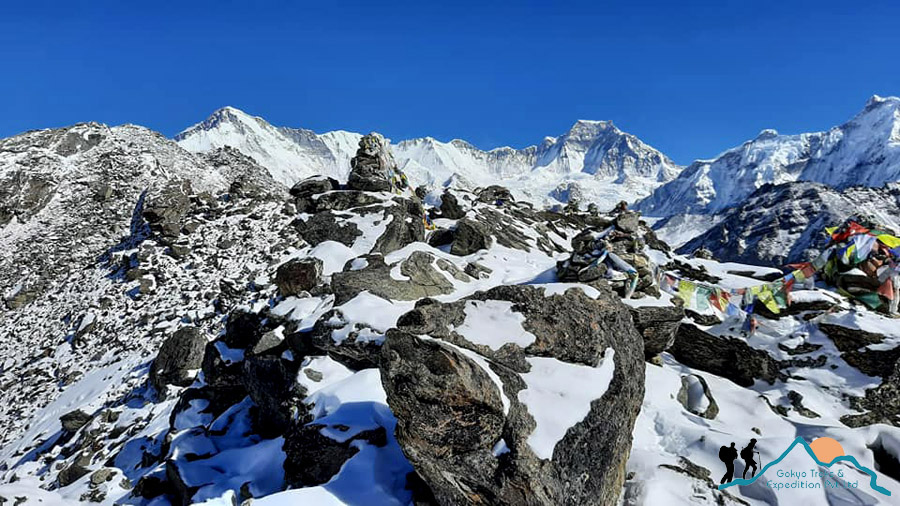
Likewise, Gokyo lakes are often not frozen with turquoise waters and are a gateway to exploring the Everest base camp and Kala Pathar routes. Tourists who have planned to Everest base camp after or before visiting Gokyo lakes should cross over Chola Pass which is a tough activity and not easy for everyone.
Therefore, only professional trekkers can cross Cho la to get to Everest base camp and Kala Patthar or vice versa. Moreover, Gokyo ri trek solo is also possible with hiring a private trekking guide but we recommend you travel within a group to find easy accommodation.
Best time for a hike to Gokyo Ri
The best time to hike to Gokyo Ri in the Everest region is during the pre-monsoon season and post monsoon season. During these months, the weather is dry and clear, and the views of the mountains are spectacular.
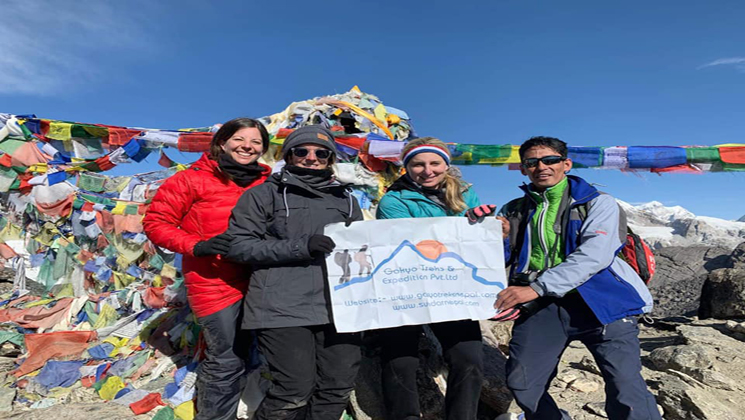
In March and April, the weather is still relatively cold, especially above Mong La at the higher elevations. Thriving Rhododendrons makes the trails more charming. Hike to Gokyo valley especially in March and April is crowded rather than hike in May month. Trek to Gokyo in May is also consider as a peak season for trekking in the Everest region, and the trail is not much busier but the weather is generally warmer and drier.
A journey into the Gokyo valley in the monsoon time is also feasible, but it’s important to prepare well for certain challenges. Monsoon starting from June to August brings heavy rainfall and can lead to muddy and slippery trails, and occasional flight cancellations to and from Lukla due to weather conditions.
However, the landscape is lush and the crowds are thinner, offering a unique experience. Proper gear, flexible plans, and caution are essential if you choose to trek during this season.
Likewise, post-monsoon season trekking starts from September to November. Generally, the weather is stable and dry, and the skies are clear, providing excellent views of the mountains. The temperatures are also soft that makes more comfortable time to trek. Likewise, the sceneries are sublime and have less chance of flight cancellation trekkers to broaden their trip more comfortable.
Similarly, it’s also possible to trek to Gokyo valley during the winter months (December to February), but it comes with certain difficulties. Certainly, the climate is cold, especially from Namche to Gokyo lakes might have snow, making the trails more difficult to navigate. However, if you’re well-prepare with suitable gears and have some experience of high and altitude trekking in winter conditions, it can be a fruitful. We provide the local guide that can provide valuable insights and support to ensure a safe and enjoyable winter trek in the Gokyo Valley.
Mount Everest Base Camp vs Gokyo RI with Everest Trek
Choosing between the Mount Everest Base Camp (EBC) trek and the Gokyo Ri with Everest trek depends on your preferences and trekking goals. The EBC trek is renowned for its iconic views of Everest from the base camp, offering a sense of achievement and the opportunity to witness the bustling campsite. It is a more popular route, often crowded during peak seasons.
On the other hand, the Gokyo Ri trek provides breathtaking panoramic views of Everest, Lhotse, Makalu, and Cho Oyu from Gokyo Ri, along with the stunning turquoise Gokyo Lakes. Generally this trek consider slightly less strenuous and offers a more serene and less crowds experience.
Additionally, Gokyo Ri trek allows for side trips to the beautiful Gokyo Lakes, adding a unique element to the journey. Both treks offer unforgettable experiences; the choice depends on whether you prioritize the iconic base camp experience or seek a more tranquil trek with diverse scenery.
Day trip to Gokyo 5th lakes versus the top of Renjo La Pass?
Deciding between a day trip to the Gokyo 5th lakes and a hike to the top of Renjo La Pass depends on your interests and physical fitness. 5th lake at Gokyo, offer stunning views of the surrounding mountains and are known for their vibrant colors. Likewise, a hike 5th lake is relatively moderate, making it accessible to most trekkers.
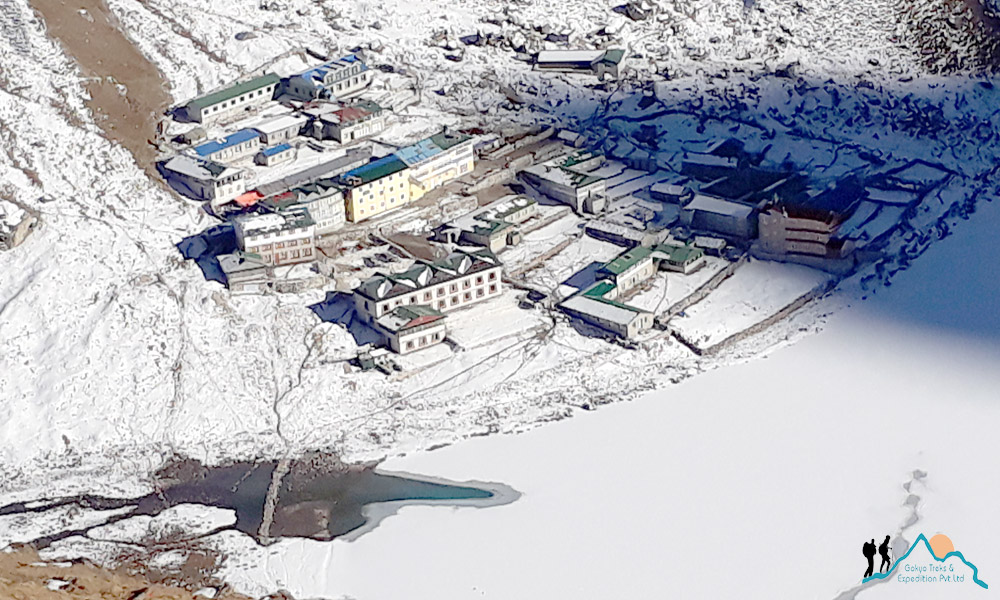
On the other hand, reaching the top of Renjo La Pass at 5,300 meters, is a challenging trek that offers panoramic views of Everest, Lhotse, and other peaks. In terms of view, Renjo la is also a great vantage point for observing the Ngozumpa glacier, lakes and the majestic mountains.
If you’re looking for a shorter, less strenuous hike with beautiful lake views, the Gokyo 5th lakes may be the better choice. However, if you’re seeking a more challenging trek with unparalleled mountain vistas, conquering Renjo La Pass could be the ideal adventure for you.
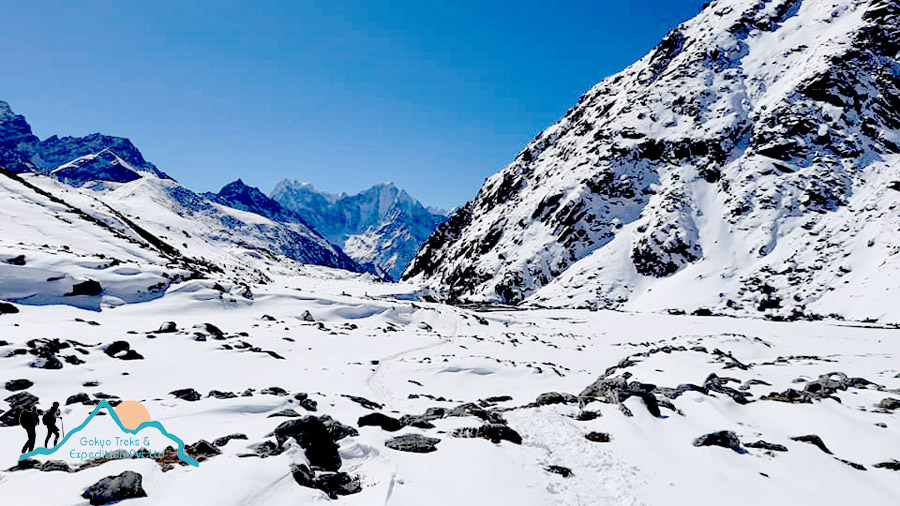
Lukla Flight via Manthali Airport!
During the high trekking season, typically in October, November, March, April, direct flights from Kathmandu to Lukla are not available due to significant air traffic congestion. As a result, all flights to Lukla are rerouted through Manthali Airport in the Ramechap district, located approximately 5 hours away from Kathmandu’s international airport.
This measure, implemented by the Civil Aviation Authority of Nepal (CAAN), aims to ensure a smoother and safer travel experience for passengers heading to Lukla during the high trekking season. While the alternative route may add some travel time, it is necessary to address the air traffic situation and enhance overall aviation safety.
Notes for Gokyo Ri trekkers
For trekkers commencing on the Gokyo Ri trek, it is important to acclimatize properly to the high altitude to avoid altitude sickness. Take your time and ascend gradually, allowing your body to adjust to the altitude. It is also essential to stay hydrated by drinking plenty of water and to protect yourself from the sun by wearing sunscreen and a hat.
Weather in the Himalayas can be unpredictable, so be prepared for sudden changes and pack accordingly with warm clothing and rain gear. Respect the local culture and customs, and follow the guidance of your guide to ensure a safe and enjoyable trekking experience.
Travelers can explore Gokyo Ri and the Glacial Lakes within a week’s time. The trek to Gokyo Lakes typically takes 5-6 days, and travelers have the option to return from Gokyo lakes trek with heli back to Lukla airport (additional cost), from where they can catch a regular airplane back to Kathmandu. This option is available upon request at any time.
Have in mind that the Gokyo trek information is a standard travel plan however, we can modify upon your request to accommodate your specific requirements. Factors such as local politics, landslides, flight cancellations, weather conditions, transportation issues, or other unforeseen circumstances beyond our control may necessitate changes to the itinerary during the trip.
While significant alterations are unlikely, if changes are necessary, the trip leader will decide on the best alternative option for the group. We strive to minimize the impact of any changes or delays, but we cannot be held responsible for the results of such circumstances.
What makes Gokyo Ri trek special?
This Gokyo Ri trek is highly regarded by visitors for its stunning mountain views, pristine turquoise lakes, and unique Sherpa culture. A journey to Gokyo valley offers a more peaceful and less crowded alternative to the Everest Base Camp trek, allowing trekkers to immerse themselves in the natural beauty of the Himalayas.
Viewpoint of Gokyo ridge offers panoramic views of Everest, Lhotse, Makalu, and Cho Oyu, among other peaks. Additionally, the trek passes through charming Sherpa villages, providing an opportunity to experience the local culture and hospitality.
At Gokyo Treks and Expedition, our core values prioritize quality services, safety, and the success of our clients. Our team comprises professional, experienced, well-trained, and licensed local guides who possess an in-depth knowledge of the destination. Beyond providing exceptional experiences, we are committed to benefiting the local society and conserving natural resources, which not only reduces costs but also minimizes environmental impact.
Gokyo Ri Trek Review
Great, relaxing trip with gokyotreks.
We had a super experience in Nepal as organised by Ammar. The communication was clear and easy, while the trip itself was quite flexible – we could decide from one day to the other what we want to do, including taking astrophotography, one of our primary goals there.
Our guide, Som, is an exceptionally friendly and knowledgeable person that made sure not only that our trip is absolutely stressing free, but also creating a very positive atmosphere through his personality. The porter chosen by the guide (Buddhi) was always on time, super friendly and with a huge smile on his face at all times.
We can only fully recommend using the services of Gokyotreks and also that you try to go off-season when the trails are nearly empty and you can more fully enjoy the trek.
Response from Gokyo Treks Nepal
Thank you Alex for your amazing feedback.
Our guide was exceptional
Gokyo Treks and Expeditions was exceptional. My friend and I went on a 14 day trek of Gokyo and EBC, and hired a guide through the company. Our guide Kamal made our trip incredible (request Kamal if you can, he’s the best!). He was so warm, caring, and knowledgeable. We learned so much from him about the mountains, Nepali culture, etc.
He went out of his way to take great care of us by making sure we got nicer rooms at lower rates. When my friend was having some altitude sickness symptoms, he knew exactly what to do and immediately took care of him. I don’t think our trip would have been nearly as rewarding and stress-free if not for Kamal!
Because we were not part of a big tour group, we could be flexible with our itinerary. This allowed us to spend more time in some places and keep going in others.
The booking process was also very smooth thanks to the owner, Ammar. He could be easily reached by WhatsApp any time we had a question during the booking/planning process.
Dear Kailash Raman,
Your wonderful review is deeply appreciated. We are thrilled that you had a fantastic experience with us. Your satisfaction is our utmost priority, and we cannot wait to have the pleasure of serving you on another remarkable trip to the Himalayas very soon.
Thank you once again, and we eagerly anticipate your return.
Regards, Ammar
Wir waren zu zweit im Oktober mit dem Guide Raj und einem Träger unterwegs von Lukla bis zum Gokyo und wieder zurück.
Doch der Reihe nach: Via Internet haben wir bereits vor Monaten mit dem Geschäftsführer von Gokyo Treks & Expeditions, Ammar, Kontakt aufgenommen. Er hat uns schnell, präzise und immer geduldig Antworten gegeben, so dass wir gerne bereit waren, einen kleinen Teil der vereinbarten Summe als Anzahlung zu überweisen. Die Planung war professionell und geschah zu einem wirklich sehr fairen Preis.
Leider konnten wir nicht von Kathmandu aus nach Lukla fliegen, was aber außerhalb des Einflussbereichs von Gokyo Treks & Expeditions liegt, da nahezu alle Trekker mittlerweile zunächst per Kleinbus ins 140km entfernte Ramechap fahren müssen. Dies bedeutete, dass man etwa gegen 1 Uhr nachts aus KTM losfährt, um einen der ersten Flieger zu bekommen, um auf dem berüchtigten Flughafen von Lukla zu landen – eine echte Strapaze.
Unser Treffen mit unserem Guide geschah dann am Flugplatz und von dort an kümmerte sich Raj wirklich hervorragend um all unsere Belange. Da wir bereits zum zweiten Mal in Nepal waren, kann ich wirklich fundiert behaupten, dass dieser Guide (zusammen mit seinem Porter) wirklich alles in seiner Macht stehende getan hat, damit wir ein einmaliges Trekking-Erlebnis hatten. Auf unserer ig. 10tägigen Tour war Raj stehts an unserer Seite und hat sich über das normale Maß hinaus sehr um uns und unsere Belange gekümmert. Dafür 5 Sterne!
Der Trek war insgesamt sehr anstrengend, die Ausblicke toll und die Lodges sind wirklich sehr sehr einfach. Wichtig ist es, dass man unbedingt warme und regenabweisende Kleidung mit sich trägt; ein paar Feuchttücher müssen gelegentlich die fehlenden Waschmöglichkeiten ersetzen. Beim Essen empfiehlt es sich, auf rohe und ungekochte Dinge zu verzichten. Wasser gibt es überall zu kaufen. Europäer fühlen sich evtl. sicherer, wenn sie ihr Bett vor der Benutzung desinfizieren. Wenn man das alles weiß und sich darauf einlässt, kann man wirklich wundervolle Trekking-Tage erleben. Ach ja: bei der Höhe bitte langsam akklimatisieren (am besten nicht mehr als 500m pro Tag) und ggf. ein Mittel gegen Höhenkrankheit z.B. Diamox mitnehmen. Und überhaupt empfiehlt es sich, eine kleine Auswahl an Medikamenten mit sich zu führen, damit der Trek ein Erfolg wird. Übrigens gehen geschätzt 90% zum EBC, von daher ist der Gokyo-Trek eine echt empfehlenswerte Alternative. Den Hinweg haben wir in ca. 5-6 Tagen erwandert, den Rückweg haben wir in 3 Tagen bewältigt.
Insgesamt bleibt zu konstatieren, dass Gokyo Treks & Expeditions eine wirklich toll geführte Company ist, die zu einem günstigen Preis tolle Gegenleistung bringt. Ammar hilft geduldig, wo und wie er kann, bleibt auch während des Treks immer per WhatsApp in Verbindung und ist auch bereit, spontane Bedürfnisse nach Hoteländerung usw. zu erfüllen ohne sich daran auch nur im geringsten zu bereichern. Im Gegenteil: Ammar setzt sich für die Bildung seiner Landsleute ein – ein wirklich vorbildliche Firma, der man nur weiterhin alles Gute wünschen kann!
Für uns steht also fest: falls wir jemals wieder eine Tour in Nepal machen sollten:
Gokyo Treks & Expeditions ist hier die allererste Adresse!
Thank you so much for the great feedback.
Wonderful experience!
Three of us friends used Gokyo Treks for our trip to Nepal. Our guide, Kamal, was absolutely fantastic. We did the Gokyo lake and gokyo ri trek and he ensured our needs were met 24/7. He was patient when we were tired, and motivating when we needed an extra boost of energy. I highly recommend this company, especially Kamal khatri, for your Nepal adventure!
Dear Guest Wasserman B, California, USA
Greetings from Gokyo Treks & Expedition Pvt Ltd, Nepal. Thanks a lot for your excellent review about Gokyo lakes and Gokyo ri trek 5,380 meters above the sea level in Nepal with our guide Kamal kc and porters. So, we are very much pleased that you are highly satisfied and writing us an excellent experience exploring Nepal. Be in touch as we are looking forward to serve you again for your other holidays in Nepal Himalayas!
With best regards,
Ammar Raj Guni
From US$ 1464

Quick Inquiry
No of People : 1 2 3 4 5 6 7 8 9 10 11 12 13 14 15 16 17 18 19 20
Cost & Departures
Your Trip Your Style!
ITINERARY, COST, DEPARTURES, will adjusted according to your GROUP SIZE NEED TIME
Book with Confidence
- Local Guides Company.
- 18 Years in Business.
- Lowest Price Guaranteed.
- 100% Customizable Trips
- Excellent Customer Service
- Hassle Free Booking.
- 90 % Repeated customers
- Highly Recommended agency
- Private/group tour options
Useful Information
- Trek in Nepal Himalayas
- Altitude Sickness
- Foods on the Trekking
- Trek Porters and Guides
- Trek TIMS Permit
- Trekking Equipment List
- Trek Permits & Fees
- Best Season for trek
- Trek Difficulty/Grade
- How to get Nepal Visa
Add on Safari Trip
- Chitwan Jungle Safari
- Bardia Jungle Safari
- Koshi Tappu Wildlife Reserve
Extra Fun on Adventures
- Mount Everest Flight
- Everest Helicopter Travel
- Bungy Jump Tour
- Paragliding Flight
- River Rafting
- Experience Zipline
- Wild Honey Hunting
- Mountain Biking
Book My Trip
- Booking Terms - Condition
- How to make Payment
Trek & Return with Heli
- Trek to Langtang with heli return
- EBC Trek with a Heli return
- Gokyo Trek with a Heli return
- Trek to ABC with a Heli return
- Tours by Helicopter in Nepal
Reference Contact
- Germany : Klaus Kummer
- Germany : Martin Aigner
- Austria : Verena Laner
- Austria : Dorothee Plunger
- Chicago: Beth Pekol
- Australia: Mark Panico
- Zürich: Marta Blickenstorfer

Gokyo Lake Trek
Destination, accomodation, hotel, lodge and tea house, everest region, start / end point, lukla/lukla, 13 nights 14 days, max. altitude, meals included, nature of trek, lodge to lodge trekking, best season, march-may / august-november.

Activity Per Day

Transporation
Flight, jeep.

Gokyo Lake trek is a beautiful and challenging trek in the Solu-Khumbu region of Nepal. Located at an altitude of 4,700 meters, the trek offers stunning views of the Himalayas, including the world's highest peak, Mount Everest. The trek begins in the town of Lukla, where trekkers catch a flight from Kathmandu. From Lukla, the trek follows the Dudh Koshi river and passes through the villages of Phakding, Namche Bazaar, and Dole.
En route, trekkers have the opportunity to visit the famous Tengboche Monastery, which is home to one of the largest Buddhist monasteries in the region. As the trek continues, trekkers will experience the changing landscape and vegetation, from lush forests to alpine meadows. Along the way, they will pass by several small lakes and streams, including the Gokyo Lakes, which are the highlight of the trek. The Gokyo Lakes are a chain of lakes of six crystal-clear bodies of water located in the Ngozumpa Glacier region. The lakes are fed by the melting glaciers and consist of deep blue water making a popular spot for trekkers to rest and enjoy the breathtaking views of the surrounding peaks.
One of the main attractions of the Gokyo Lake trek is the opportunity to climb Gokyo Ri, a small peak located near the lakes. From the top of Gokyo Ri, trekkers can enjoy panoramic views of the Himalayas, including Mount Everest, Lhotse, and Makalu. In addition to the stunning natural beauty, the Gokyo Lake trek is also rich in cultural and historical significance. Trekkers will have the opportunity to visit the local villages and interact with the friendly Sherpa people, who are known for their hospitality and mountaineering skills.
Overall, the Gokyo Lake trek is a challenging yet rewarding journey through the heart of the Himalayas. With its stunning views, rich culture, and friendly locals, the trek is a must-do for any adventure seeker visiting Nepal.
Fewer tourists go on the Gokyo Valley Trek compared to the traditional Everest Base Camp Trek. However, this is arguably a better choice for a number of reasons:
- The trail has more variation as you traverse through different landscapes.
- The lakes of Gokyo are astoundingly beautiful to see.
- You can see a stunning view of Ngozumpa glacier; the longest glacier in the Himalayas.
- You will witness the more spectacular and grander sight of Everest.
The best time to do the Gokyo Lake Trek is during autumn and spring. We make sure that your trek will be adventurous as well as fulfilling. Moreover, we also ensure that you get high-quality service at the best price.
The Grandeur of Gokyo Lakes
Gokyo Lake is not a single lake but a collection of 6 crystal-clear lakes that are situated between the heights of 4700 meters to 5000 meters. There are six clearest lakes comprising the Gokyo Lake. These include are Gokyo Cho (Dudh Pokhari), Thonak Cho, Ngojumba Cho, Tanjung Cho, Longbanga Cho, and Gyazumpa Cho. These lakes have high hydrological value as they are permanent sources of fresh water. Gokyo lakes mostly feed on the waters from glaciers nearby such as the Ngozumpa glacier, the longest Khumbu glacier.
Among these lakes, Gokyo Cho is arguably the most significant one. Not merely a heavenly destination for trekkers, it also has considerable religious significance among Hindus and Buddhists as well. On the occasion of Janai Purnima, Hindus take a holy bath in the crystal clear waters of the lake. Also, the place is worshipped and revered as the residing place of Naag Devata (Snake God). Moreover, there is also a temple of Lord Vishnu and Shiva near the lake. Religious traditions also stop anyone from harming the wildlife that exists here.
Temperature and Weather of Gokyo Valley.
The weather in this valley is unpredictable so, the viable option is to pay attention to the weather forecast. In case of bad weather, we will halt our exploring or reschedule for the next day. Usually, the average temperature during the daytime reaches 3-7 degrees celsius whereas the temperature dwindles to -5 to -8 degrees celsius.
Extended Gokyo Lake Trek.
The trek can be extended further to ascend the worldly famed Everest Base Camp sitting at an altitude of 5364m. We can also further ascend to Kala Patthar which is at an altitude of 5550m. The best view of Everest is perceived from the base camp. This trek will traverse you through the blue-green alpine lakes of Gokyo valley as well as Everest base camp, it can be a little more challenging but, the rush of adrenaline and enchanting views of the Himalayas makes it worthwhile.
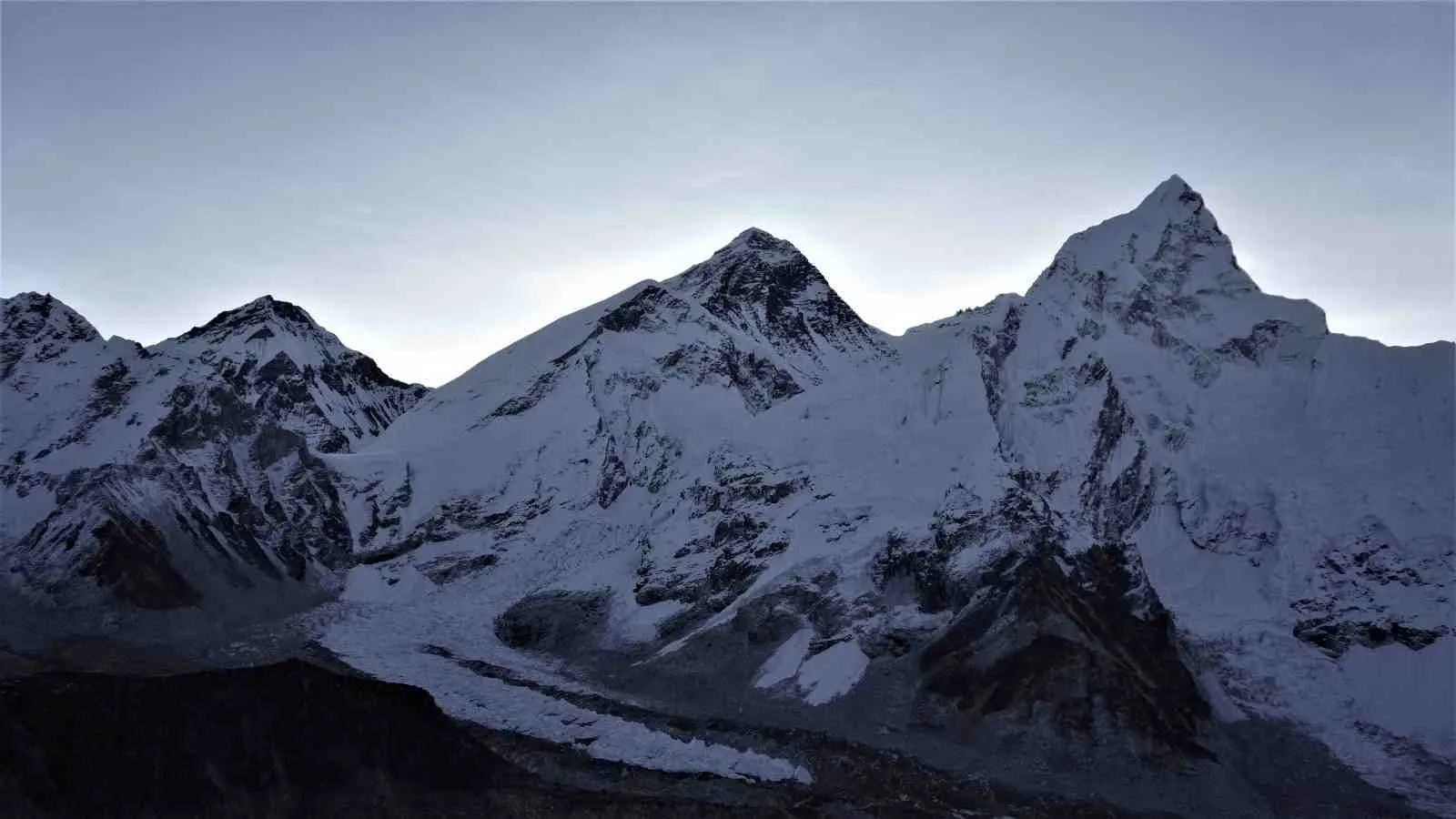
Gokyo Lake Trek Itinerary
Arrival at airport and transfer to hotel.
After arriving at Tribhuwan International Airport, our representative will greet you and welcome you. After briefing about the trek, we go to our hotels.
- Overnight stay in a Hotel
- Includes Breakfast
Kathmandu Sightseeing (Optional)
After having breakfast, we start our guided tour of Kathmandu sightseeing. We will visit many of the World Heritage Sites, including Swayambhunath, Bouddhanath, Pashupatinath, and Durbar Squares. These places are of vital historical and cultural significance. The temples are sacred sites for Hindu and Buddhist devotees. Similarly, the durbar square areas represent the various kings and rulers throughout Nepal’s rich history. We will have lunch during the day along with dinner in the evening before returning to our hotel.
- Overnight stay in a Lodge
Fly from Kathmandu to Lukla (2860m) and trek to Phakding (2610m)
We take an early morning flight to Lukla from Kathmandu. We fly across some lush mountain views and verdant hills. After the 40-minute flight, we will finally reach Lukla airport. Our trek begins from here. We only walk for about 3 hours to Phakding
Phakding to Namche Bazaar
We will hike to the commercial site of Khumbu, which is Namche Bazaar. We mostly walk alongside the Dudh Koshi River and walk along rhododendron forest. Moreover, we walk across several suspension bridges. After 6 to 7 hours of walk, we reach Namche Bazaar.
Rest and Acclimatization at Namche
We will spend the fourth day acclimatizing. However, we will not sit still as we will hike to the Syangboche Airport and Everest Hotel. Syangboche Airport is the highest airport in the world. On the other hand, Everest Hotel offers some splendid views of mountains like Everest, Ama Dablam, Lhotse, etc. We will also visit a museum and a photo gallery.
- Included meals (Breakfast + Lunch + Dinner)
Namche Bazaar to Dhole
After leaving Namche, we follow the Dudh Koshi further ascend on a trail filled with prayer flags. We pass through small monasteries and Sherpa villages.
Dhole to Machhermo
We hike along a narrow path with a continuous view of snow-clad peaks like Cho Oyu, Toboche, Cholatse, and Everest, among others. After ascending from the valley and passing through human settlements at Kele and Luza, we finally reach Machhermo.
Machhermo to Gokyo
We will reach our ultimate destination today, which is the Gokyo Valley. We ascend further along the banks of Dudh Koshi and pass through monasteries and chortens along the way. We then arrive at the first Gokyo Lake. After hiking along the moraines of Ngozumpa Glacier, we arrive at the second lake. After walking further, we finally reach the third lake. There is an ancient Sherpa settlement of Gokyo near the lake where we will spend the night.
Explore Gokyo valley/ Hike to Gokyo Ri (5483 m)
We will spend this day entirely near Gokyo. We can stroll around and explore the village. However, a better alternative will be to hike up to Gokyo Ri from where we can witness some mind-blowing vistas of Everest and Cho Oyu. In that case, we will trek back to Gokyo village for the night.
Trek back from Gokyo (4800m)-Dole (3680m)
We now start our way back. We trace back our steps through the Gokyo Lakes and pass through the settlements in Phanga, Luza, Machhermo, and Kele to finally arrive in Dhole.
Dole to Namche Bazaar
We head back to the vibrant village of Namche Bazaar. We pass through Phortse to join the Everest Base Camp trail. Walking further, we then reach Namche Bazaar in about 4 hours.
Namche Bazaar to Lukla
We trace our steps from Namche to Lukla, passing through the same rhododendron forests and Sherpa villages. As the flight from Lukla to Kathmandu only takes place in the morning, we spend the night in Lukla.
Lukla to Kathmandu flight
We board the plane early in the morning, which will bring us back to Kathmandu. However, we will enjoy the flight back as we look over the mountains and feel satisfied for completing the trek. Upon reaching Kathmandu, you will head to your hotel. Additionally, you can explore different sites of Kathmandu valley during the day.
We will drop you at the airport and bid you farewell.
Gokyo Lake Trek Map and Altitude Graph

WHAT’S INCLUDED
- All permits such as National park, and TIMS Permit.
- All nights lodge accommodations on the mountain.
- Breakfast: Cereal, Porridge, rice pudding, egg dish with bread and toast, bread with jam and honey, Pancakes with jam and honey, with tea or coffee.
- Lunch Items: Dal Bhat (mostly recommended), noodles soup, fried noodles, momo, spaghetti chapati, Spring roll, macron, sizzlers, swiss rosti, pizza, veg curry with plain rice,
- Tibetan Momo, Thukpa, Thenthuk, french fry, fry potato, boil potato and much more. Dinner: Mostly same as lunch items but may vary in some hotels.
- Note: The menu also depends on the Teahouse or Hotel, so the food items may vary.
- Trekking gear duffel bag for your trekking stuff.
- Sleeping Bag, Trekking pole ( Return after trekking)
- Medical Kit Bag on every trip. Eco trained English Speaking professionals guide.
- Kathmandu to Lukla and Lukla to Kathmandu flight tickets.
- Domestic airport Tax.
- Farewell dinner in a famous Nepali restaurant with a Nepali culture dance program.
- Staffs insurance, well-paid salary, equipment, food & Hotel Rescue Arrangements of course, not the rescue bills!
WHAT'S EXCLUDED
- International airfare & Nepal visa fee.
- Lunch and Dinner in Kathmandu.
- Excluded Hotel cost in Kathmandu.
- Personal Insurance & personal expenses.
- Tips for Guide and Porter (it is expected).
- Cold drinks; coke, mineral water, beer, Fanta, etc.
- Anything not included in the What's included section.
Gokyo Lake Trek Trip Information
Guided Gokyo Lake Trek Package Information
You will be arriving at Tribhuvan international airport in Kathmandu where our company’s representative will receive you. We can arrange hotels for your stay at Kathmandu although our trek package does not cover hotel expenses before we depart for the trek.
Our trekking journey will start with a flight to Lukla the next day which will take approximately 40 minutes.
Accommodation details
Gokyo Lake trek is an 11days trek with 10 nights in lodge-to-lodge accommodation. We select the best available services for your stay.
For solo trekkers, a single private room with an attached bathroom is easily available throughout the journey. You will get standard rooms at Dole, Machhermo, Gokyo, and Phortse.
As you climb higher the choices of food will get short. But you will get nutritious food as the trek demands. Basic meals for lunch and dinner that we get around the trekking regions are national foods such as Daal, Bhaat, Tarkari, pickles, and curry. For breakfast, you can find bread, fruits, local porridge, sandwiches, noodles, and soft drinks.
We do not recommend meat items because of quality concerns in higher regions. It is best you take fresh vegetables, fruits, hot liquids, green tea, lemon tea, and garlic soup that assists you in your trekking journey.
Mineral water bottles are available in all lodges, you can also fill your water bottle with boiled water which you have to pay extra for.
Electricity for mobile and camera, internet for communication is available throughout the trek in all lodges but comes with an extra service charge.
Trip Difficulty and Best Season to Trek
The Gokyo Lake trek is a moderate trek. Those who can hike for 4 to 6 hours a day with an 8-12 kilogram bag pack can complete the trek easily. In case of any medical conditions such as respiratory, or heart it is best that you consult with your doctor before you decide to go on a trek.
Spring (March-May) and autumn (September-November) are the two most popular trekking seasons in Nepal as they have moderate climates with warm days and chilly mornings and evenings.
During the winters, the Gokyo lake trek is challenging due to extreme cold and heavy snowfall.
Travel Insurance Policy
This trip comes with high-altitude trekking risks such as potential altitude sickness. Hence, travel insurance is compulsory.
All trekkers must provide a copy of their comprehensive travel insurance policy to North Nepal Trek. The policy must cover medical and emergency repartition above 3000 meters- including helicopter rescue and evacuation expenses.
Permit Requirements for the Gokyo Lake trek
As the trekking destination is inside the Annapurna Conservation Area , it requires a permit from the Nepal government for tourists. You need to have a TIMS card and ACAP (Annapurna Conservation Area Permit ) which you can receive at the Tourism Information Center in Pokhara. For issuing the permit, you need to bring the following documents:
- 2 photographs (pp-size)
Written by: Mohan Bhandari
1: When is the best time for Gokyo Lake Trek? Months from March to May and from October to December are the best time to commence this trek. During March-May, the weather is usually clear and Gokyo Lake along with other lakes is frozen during this time of the year. In addition to that, snowfall is very common at this time of the year. But, the clearest and mind-boggling view of the Himalayas can be seen in October as the skies are very clear with no rainfall and meager fog. However, the trekking routes are usually more crowded from October to December than in any other season
2: What about food and accommodations? In particular to this trek, the nights are spent on lodges with good facilities and quality food. This trek lies in the Everest region which is famed for its highest peak in the world so, it welcomes many hikers and pilgrims every year, so, the lodges and tea houses are advanced and offers various option for our meal and breakfast. However, these trails and lodges may be crowded and packed during the trekking season.
3: Is this trek possible with children? This trek is moderately challenging for adults but, tagging children on this expedition may escalate the difficulty. However, with additional care and attention from the guardians, this trek can be easily concluded. Also, the parents may opt to hire an extra guide to look after their children.
4: Do I need any permits for this trek? Yes, the officials will ask for a permit as well as other documents before entering the Everest region in Namche Bazaar. The trekkers need to pay US$ 20 per person for the first four weeks in the Everest region. Beyond the four weeks, the cost increases to US$ 25 per person.
5: Can we connect this trek with other treks from the Everest region? Yes, this trek can be connected to other equally famed treks of this region. They are Everest Base Camp Trek and Everest Three Passes Trek .
6: Can we do any activities in Gokyo Lake? The lake remains frozen during the winter season. Since this lake carries religious significance boating and other activities are not done.
Trip Downloads

Related Trips
.jpg)
Dhaulagiri Circuit Trek: Strenuous Trek in Nepal - 17 Nights 18 Days

Short Everest Base Camp Trek - 10 Nights 11 Day Trek

Upper Mustang Trek - 11 Nights 12 days
.jpeg)
Gosaikunda Lake Trek: A Place of Religious Prominence - 7 nights 8 days
We are associated with.
.png)
We are associated with:
.png)
Start your next adventure here, join our newsletter
Your experience on this site will be improved by allowing cookies. Allow cookies
Read our Privacy Policy
- Join Group - Annapurna Base Camp Trek
- Join Group - Everest Base Camp Trek
- Join Group - Manaslu Trekking
- Join Group - Annapurna Circuit Trek
- Join Group - Everest Base Camp and Gokyo Lake Trek
- Join Group - Langtang Trek
- Join Group - Langtang & Gosainkund Trek
- Join Group - Best of Nepal Tour
- Join Group - Everest Panorama Trek
- Join Group - Tsum Valley Trek

- Our Mission
- Our Philosophy
- Why Trekking Team Group?
- Responsible Business
- Financial Security
- Write Review

- Art | Culture Tours | Round Trips
- Trekking | Hiking Holidays
- Gay and lesbian Travel
- Wellness-Mind, Body & Soul
- Climbing | Expeditions
- Cycling | Mountain Biking
- Family Holidays
- Local living | Home Stay
- Flora | Fauna Study
- School Travel
- MICE Tourism
- Safari Tour - Jungle Safari
- Treks of Great Himalaya Trail
- Charity Treks
- Philanthropic Travel | Travel for a cause
- Cooking Classes | Cook like a local
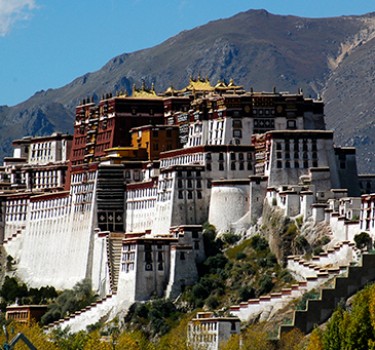
- Best of Western Bhutan
- Best Of Tibet
- Beijing to Kathmandu
- Central Tibet Overland Tour
- The Dragon Kingdom Tour
- Kailash Mansarovar via Lhasa
- Kailash Tour via Simikot
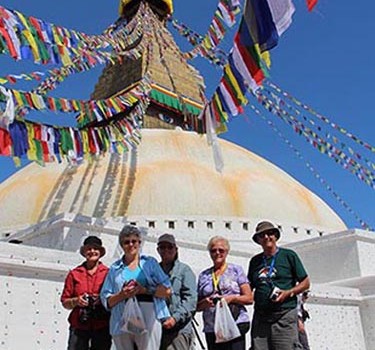
- An Experience Of School Visit (Go local)
- Nagarkot Hiking
- Visit Heritage Sites of Kathmandu
- A Day For Body, Mind & Soul
Everest Experience Flight
- Philanthropic Travel
- Rafting | Kayaking
- Hike the Shivapuri to see 8000'ers
- Hiking - Kakani To Jhor
- Explore Valley By Mountain Bike
- Paragliding In Pokhara
- Cook like A local (Cooking Class)
- Ultra Flight In Pokhara
- Tailor Made
- Partner with us

Gokyo Lake Trek | 17 Days
Ratings

- Dates & Price

Trip Description
The Gokyo Lake Trek at the head of the Dudh Kosi Valley provides a great alternative to the popular Everest Base Camp trek . It is a more tranquil trek through the Sherpa heartland that affords ample time for acclimatization with opportunities to savor mountain panoramas.
The highlight of Gokyo lake trek is the ascent of Gokyo Ri (5483m). From the summit at over 5000m, we gain superb views of Everest as well as the 8000m peaks of Lhotse, Makalu and Cho Oyu in Tibet. Many trekkers will argue that this is one of the finest views in the Himalaya, with the awesome bulk of Everest dominating the skyline. Late afternoon is a fine time to make the climb above the shimmering lakes to capture a sunset over one of the most awesome spectacles the Nepal Himalaya has to offer.
There are numerous alternatives on this trek depending on your time frame and interest. You can return through Renjo- la pass (17,560 ft / 5,360m) visiting, rarely-visited western valley of Khumbu Like Lungde & Thame. Thame is stunning village and home of many famous Sherpa climbers who have kept many world’s record on climbing the Himalayas. You can even meet and talk with them if they are available if not at least meet with their family and have a cup of Tea.
The other alternative is to trek through Ngozumpa glacier, the biggest glacier in the Himalayas and cross the Cho-la pass (5,420 metres (17,782 ft) and get to Easter valley which gets you to the Everest Base Camp. If you prefer this, you can check Everest base camp and Gokyo lake trek .
You can also read a blog article about Why Gokyo Trek Should Be Your Top Priority ?
Is Gokyo Lake Trek right for you?
- If you want to trek in the Khumbu region but wanted to avoid the big crowed of Everest Base camp, this is the right trek for you.
- Trekking in the Himalayas is not like walking in the park. It goes with many ups and down reaching altitudes of over 5500 meters. We will also spend few nights above 4000m. You have to be in good health condition to participate, however the rewards are worth it. If you can cope with it then this is the right trek for you.
- The weather can be unpredictable in the Himalayas and every year a significant number of flights to or from Lukla delayed or cancelled due to weather conditions. So please prepared for this mentally and economically. If you are flexible with timing this is the right trek for you.
- The trekking lodges, known as teahouses, that we stay in on the trek are very simple with only basic facilities. You have to use sharing bathroom and toilet especially in high altitude. In the lower village we will provide you attached bathroom with hot shower. If you are not looking for a luxury then this is the right trek for you.
Outline Itinerary
Day 1: arrival and transfer to hotel, day 2: kathmandu sightseeing, day 3: fly to lukla (2,864m) & trek to phakding, about 4 hrs, day 4: trek to namche (3440m). walk approx 6-7 hours, day 5: rest day in namche for acclimatize, day 6: trek to portse thanga (3680m). walk approx 6 hours, day 7: trek to dole (4000m). walk approx 3 hours, day 8: trek to machhermo (4410m). walk approx 5-6 hours, day 9: trek to gokyo (4750m), gokyo lake. walk approx 5-6 hours, day 10: ascent of gokyo ri (5480m). walk approx 4 hours, day 11: trek to thare (4500 m). walk approx 5 hours, day 12: trek to tengbuche (3870m). walk approx 6 hours, day 13: trek to monjo (2840m). walk approx 6 hours, day 14: trek to lukla (2864m). walk approx 5 hours, day 15: fly to kathmandu (1330m), day 16: day at leisure/ reserve day in case of flight cancel/hotel, day 17: drive to airport for return flight.
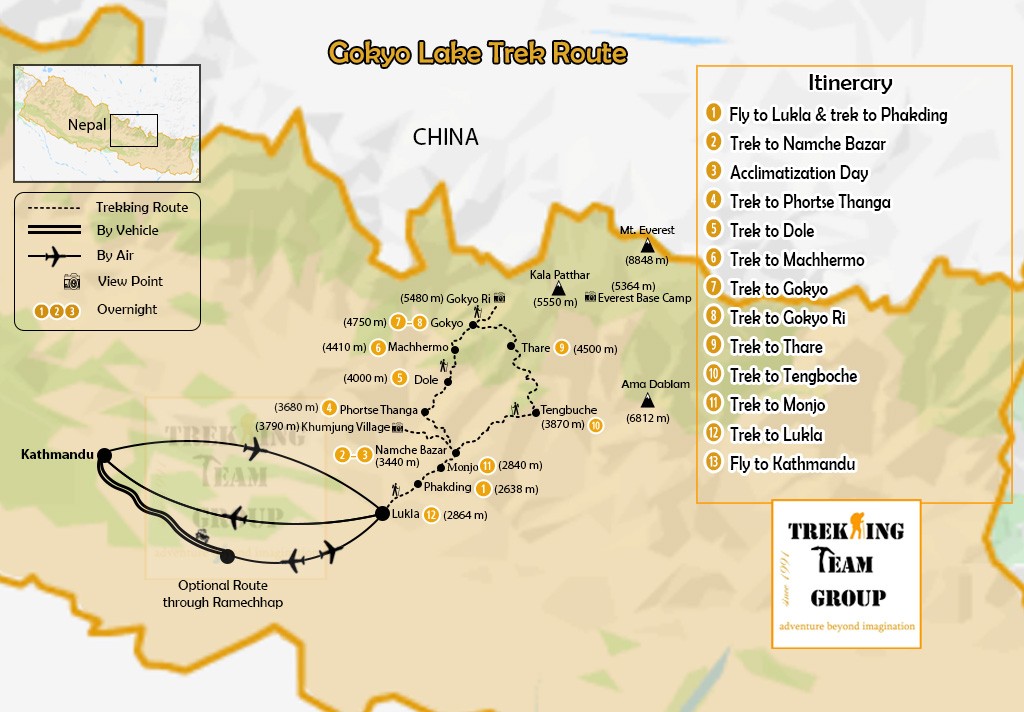
Highlights of the tour:
- The most beautiful trek of Everest Region
- Ascend of Gokyo Ri (5483m) & enjoy Gokyo lake
- Observe the stunning scenery of Mt. Everest, Makalu and Cho Oyo
- Spectacular Himalaya mountain views, mani walls, chortens and prayer flags,
- Encounter highland Sherpa people's life style and their unique cultural hospitality
- Breathtaking Mountain flight to and From Lukla
- Visit palace, Monastery, Stupa and Temple of Kathmandu
What's Included:
- Kathmandu Airport transfers
- An experienced insured and equipped English speaking Guide
- Guided sightseeing and entry fee in Kathmandu
- 3 meals during trek
- Internal flights and land transport involved in the itinerary
- Flights of guide
- Airport tax
- Good standard Hotel ( 3-4*) accommodation in Kathmandu with breakfast
- Tims permit
- National park permit
- Insured and equipped porter as on IPPG rules
- Ascents of Gokyo Ri (5483m) and explore Gokyo lake
- Acclimatize day to explore in Namche
- Trekking off the main trail to the village of Phortse - one of the more traditional Sherpa villages in the Khumbu region
What's Not Included:
- Travel Insurance
- Nepalese Visa
- Tips for Guide and other trek staff
- Lunch and dinner in the city.
- Additional costs due to illness, rescue etc
- Additional cost due to force majeure, changes of flight and itinerary
- Personal drinks and Bar Bill
Elevation Chart
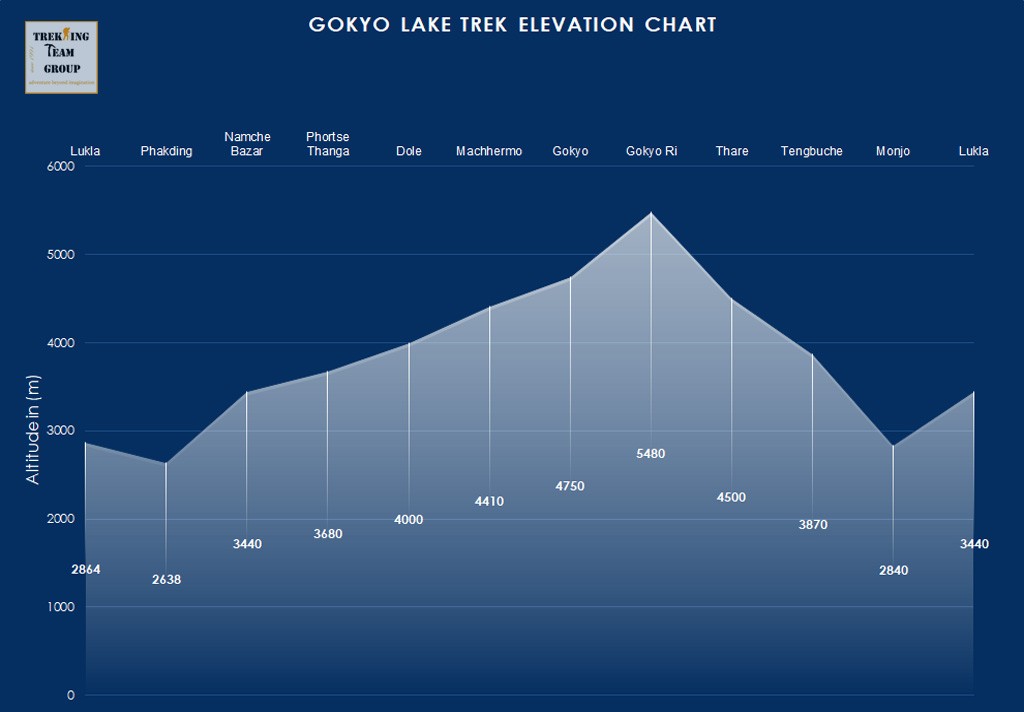
Dates & Price:
The Following dates and prices are LAND ONLY itinerary joining in Kathmandu. Please make your own flight arrangements. If you need some help to arrange an international flight, we can suggest you some agents who are specialized on ticketing.
BOOK WITH CONFIDENCE - No surcharge guarantee whether you are booking for this year or the next, we have undertaken to guarantee that all of our Land Only prices will not change once you have booked your holiday.
DATE WITH FESTIVAL & EVENTS - recommended If you are planning your holiday and want to have once in a life time experience then chose the date that combined with events or festivals. It will enhance an experience of life time in your holiday.
Our Tours Status Index...

- Small Group Journey
- Tailor made Journey
- Private Journey
Your Journey, Your Way -this itinerary can be tailored to your desire
You can also use this tour as a base for a tailor-made itinerary. Like your personal architect creating your one-of- a-kind home, our Travel Specialists will execute the trip of a lifetime. It's all up to you - logistics, pace, budget, dates, performances, visits, explorations, meals and lodging are hammered out down to the finest customized detail. Please fill in our tailor-made request form .
Private Journey - customize the departure dates suitable for you
If you do not want to join a group then you can also make this a private trip with your friends and family one at your own schedule. Considering this, Trekking Team Group organizes private journeys as well. Please choose your own departure date .
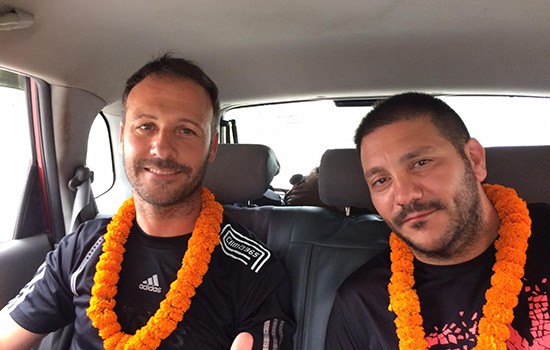
Arrival at Tribhuwan International Airport, Kathmandu. A traditional warm welcome by our airport representative. Short briefing about the package in the hotel. Typical welcome dinner in the evening.
- Accomodation: Hotel
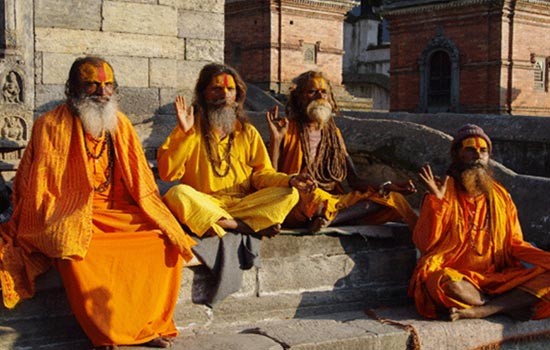
Your first day will begin with breakfast at your Hotel. You will be taken for sightseeing of Kathmandu Valley to explore color and contrast of the vibrant city. Drive to famous Buddhist Stupa "Swayambunath" or known as Monkey temple on the hill of Kathmandu Valley where you can see stunning view of mountains and Kathmandu. This temple attracts Buddhists and tourists from round the world. Swayambhunath Stupa is the most ancient and enigmatic of all the holy shrines in Kathmandu valley. Its lofty white dome and glittering golden spire are visible for many miles and from all sides of the valley. Then you will be taken to pashupatinath Temple. Pashupatinath is the most important Hindu temple dedicated to god Shiva. Every year this temple attracts hundreds of elderly followers of Hinduism. This is also the cremation center. After exploring this temple you will visit fascinating sights of Patan Durbar Square, one of the most glorious examples of traditional Nepalese architecture, full of century’s old temples and palaces
- Time: 6-7 hrs
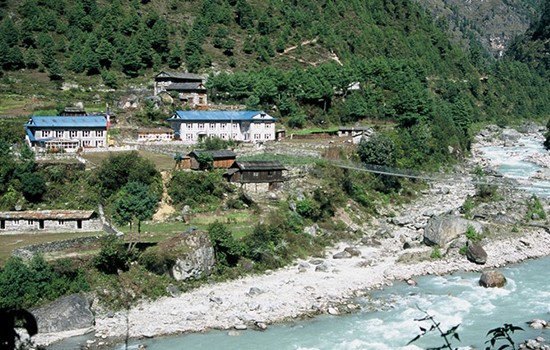
You will take stunning flight from Kathmandu to Lukla. Upon arrival meet the trekking crew and after short tea break trek northwards up the valley of the Dudh Kosi. Descend from the small plateau, down into the forested valley. The trek is very easy and short today, however the altitude difference between Kathmandu and this place can make a people a bit difficult. After lunch trek north down towards Phakding. The trail crosses several tributary streams and you will have some tantalizing views before reaching the small settlement of Phakding (2638m), where you will spend your first night.
- Accomodation: Lodge
- Meals: B L D
- Distance: 10km
- Ascent: 100m
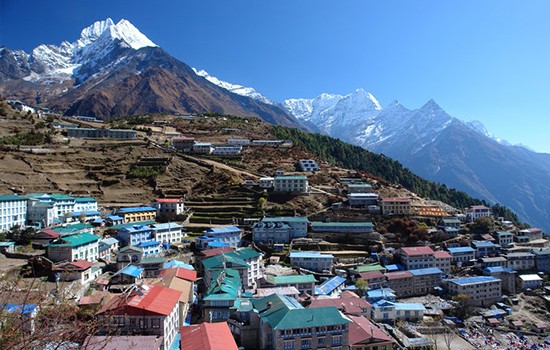
Hike through fields and villages from Phakding to Namche Bazaar. Heading out of Phakding you will follow the Dudh Kosi northwards. This day's walk takes you through magnificent forests of rhododendron, giant fir and magnolia trees. You will cross the west fork of the river, the Bhote Kosi, and start the steep climb to Namche Bazaar. Namche is the largest Sherpa village and has long been the primary staging area for major Himalayan expeditions. Namche is a prosperous Sherpa village and an important trading center with a weekly market selling fresh foodstuffs brought up from lower villages.
- Distance: 6km
- Time: 6-7 Hrs
- Ascent: 1000m
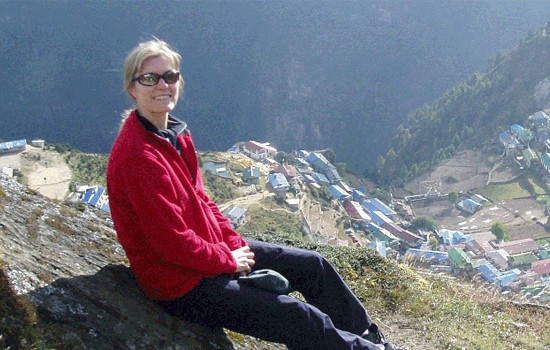
You will take a rest day in Namcha and explore the village Thamo or synboche. Make fit yourself for the further journey. This day is for acclimatization. Physiologically prepare yourself for adaptation to changes in climate or environment. We recommend you to stay active even in a rest day as it is better than being idle while on a trekking journey
- Descent: 500m
- Distance: 11km
- Time: 5-6 hrs
- Ascent: 500m
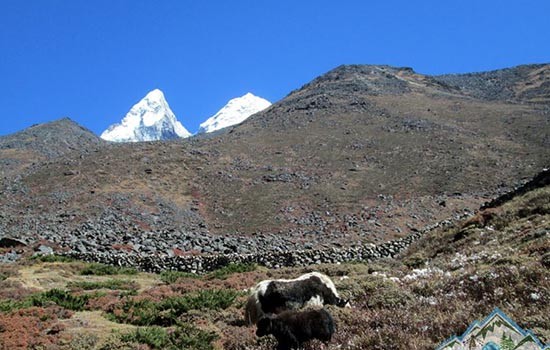
Your day will begin with breakfast at your Hotel. You will start trekking to Portse Tenga today. Heading North-East you initially follow the main trail to Thyangboche as it contours around the hills, before you branch off on a short climb on the flanks of the sacred peak of Khumblia (5761 m). You will traverse for some time across yak pastures as the trail gradually ascends to Mon La. Below you is the confluence of the Dudh Kosi and Imja Khola and across the valley Thyangboche monastery is framed by Ama Dablam and Kantega. You will reach a stupa draped with prayer flags atop a ridge at 3992 metres and then descend steeply through forest to the Dudh Koshi. Following the trail and walking up to the ridge will bring you the village of Portse. Overnight in Portse Tenga.
- Descent: 100m
- Distance: 13 km
- Time: 5-6 Hrs
- Ascent: 200m
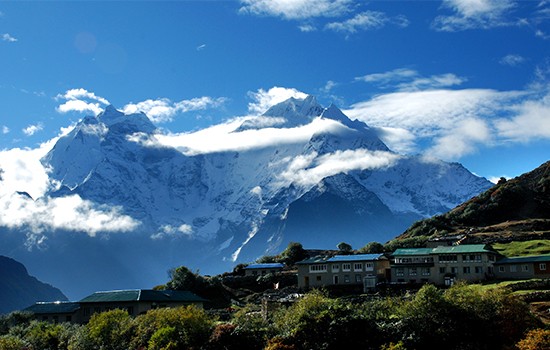
Retracing our steps back to Dole. The views during the return have a different point. The trail meanders around the constantly changing obstacles and affords great views of Cho Oyu and Cholatse. You will be crossing Machhermo and reach your destination at Dole. You will see the slopes of Cholatse and Taweche. You can enjoy excellent views of Kyajo Ri (6186 m) and the mountains and glaciers of the range. Overnight at Dole.
- Distance: 5-6 km
- Time: 2-3 hrs
- Ascent: 400m
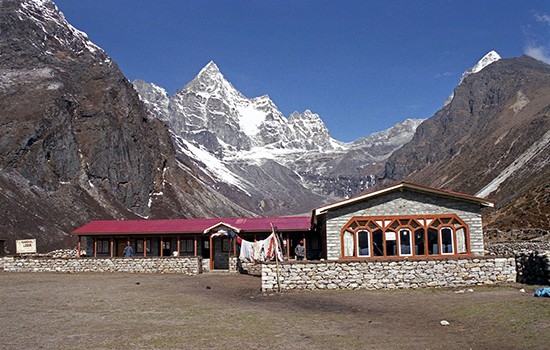
Today, after breakfast continuing a steady but constant climb, you will reach the village of Machhermo. Short time lunch break. You can visit the local villages and interact with local villagers about their lifestyle and culture. This afternoon can be spent relaxing or you may wish to stretch your legs and take a walk up the ridge behind Luza for a view of the Gokyo Valley. Overnight in the lodge of Machhermo.
- Distance: 11 km
- Time: 5-6 Hours
- Ascent: 410 m
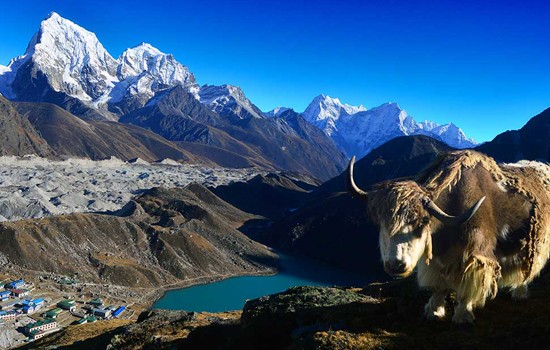
This day you will climb through a ridge chorten from where you can see fabulous view of both down the valley and the Mt.Kangtega, Thamserku and northern part to the Cho Oyu. After some gentle walk you will reach Phanga. Continuing the path you descend to the river bank before beginning to climb up to the terminal moraine of the Ngozamba Glacier. The trail follows the valley past the first lake, known as Longpongo. At the sight of the second lake, Taboche Tso and then you will reach the third lake Dudh Koshi, the two linked by a surging stream. Gokyo village stands by the third lake. Dinner and night stay in the Gokyo.
- Distance: 12 km
- Ascent: 300m
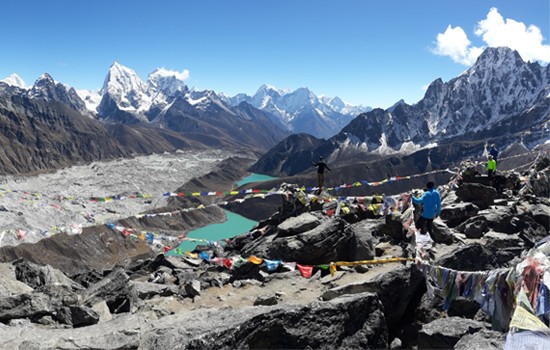
You will be woken up early to climb to the Gokyo Ri, which hangs above the Gokyo village at the northern edge of the lake. From this spot, you will catch the most exquisite view ever of the Himalayas especially that of the Everest, Lhotse, Makalu, Nuptse, Cho Oyu and other neighboring snow peaks. Later on, you can hike up to the Scoundrel’s Viewpoint, exploring the fourth, fifth and even the sixth lake of Gokyo if time permits. In the evening dinner and night stay in the lodge of Gokyo.
- Time: 4-5 hrs
- Ascent: 600m
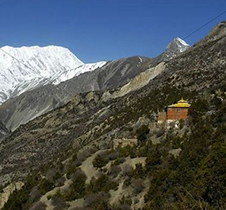
Today after breakfast you will trek to Thare. Walk approximately five hour to reach your destination. Thare is the place where you can explore Thare monastery and beautiful village. You can know the people living there including their life style, culture and costumes. Overnight in the lodge of Thare.
- Descent: 1000m
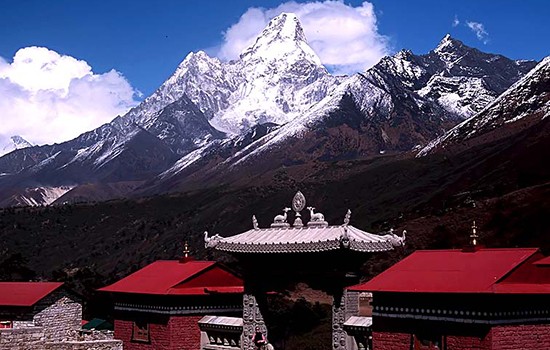
Trek to Tengbuche and visit the famous monastery. You will descend the Pheriche valley with spectacular views of Ama Dablam and join the main Imja Khola Valley, which you follow down to Pangboche with superb views looking back to the great ridge of Lhotse-Nuptse. Pangboche, at 3985m is the highest permanent settlement on the approach to Everest. Dropping down to the rushing Imja Khola you then walk through rhododendron forests to Thyangboche at 3867m.
- Descent: 700m
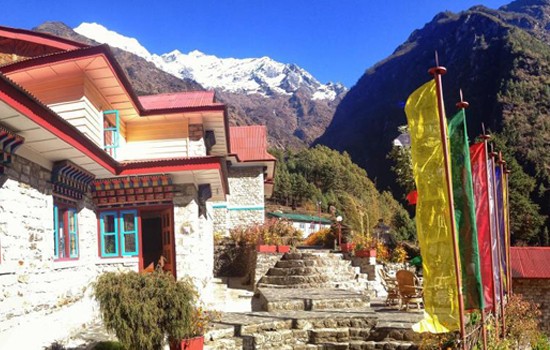
An easy trail contours round the hillsides back to Namche Bazaar. From here you will drop down to the river and retrace your path through Monjo. Monjo is a small village in the Khumbu region. It lies in the dudh Kosi River just north of Phakding and south of jorsale on the edge of the Sagarmatha National Park. You will visit Buddhist Monastery and explore surrounding and enjoy natural beauty of Monjo.
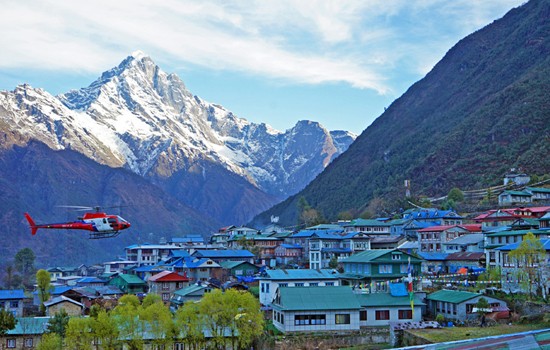
Retrace the way alongside the Dudh Koshi River to the small town of Lukla. You’ll have a long and leisurely trek back to Lukla. You can explore the area if you like or just rest for the day.
- Descent: 50m
- Distance: 8 km
- Time: 3-4 hrs
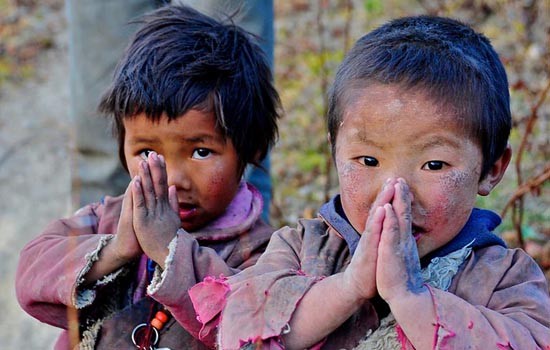
Fly from Lukla to Kathmandu, Enjoy panoramic mountain views and spend the rest of the day sightseeing, exploring, shopping or just relaxing in Kathmandu’s numerous cafés and roof-top restaurants before spending the evening celebrating your achievements!
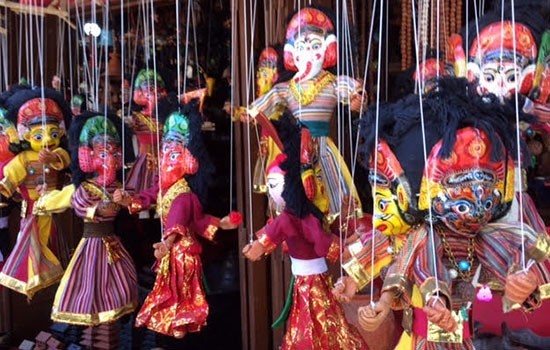
It’s a leisure time in Kathmandu, where the rest of the day is free for shopping, sightseeing or relaxing. This is an extra day in case of bad weather. Free time to explore Kathmandu before transferring to the airport for flight back.
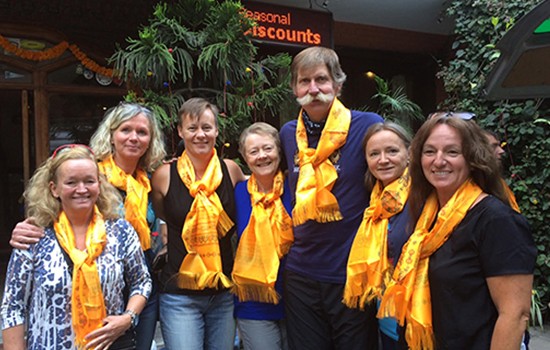
Your final day in Kathmandu is a free day to you to do as you choose. Many people take the time to shop, others enjoy exploring the cultural side of the city. Our local guide can advise you on the best shops in the area. Final Farewells! Our airport representative will travel with you to the airport.
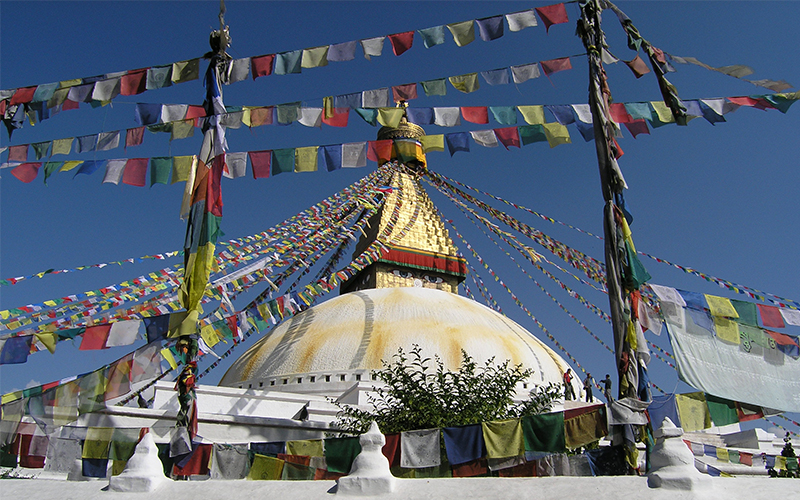
Gokyo lake Trek
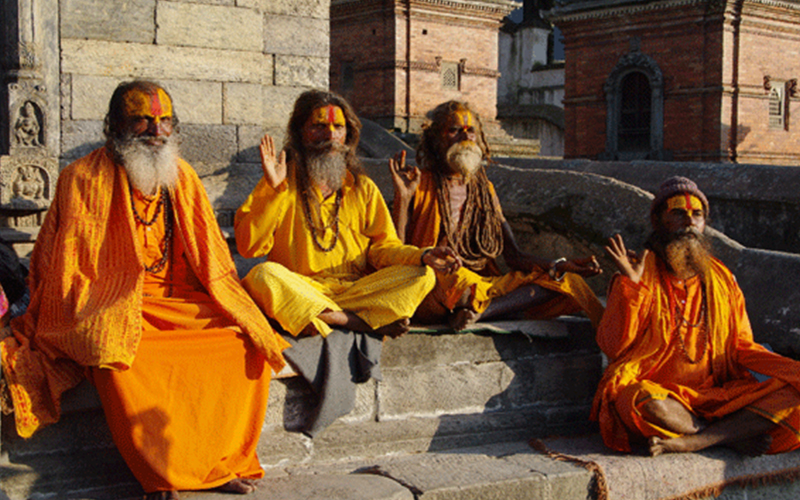
Gokyo lake Trek
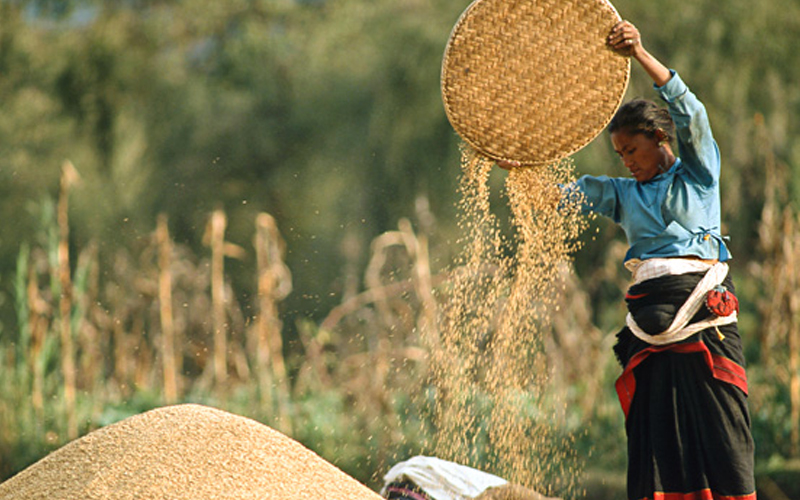
Sep 29 2018
I booked with TTG a trek to the Gokyo lakes, returning via Renjo La. The package had me in their care from landing to take off in Kathmandu. I'm a returning client, following a booking for the whole family to Mustang + surround Annapurna trek. As in the past, I was very satisfied with the care and personal attention of Shreehari, the company's director, and with the professional level of Birman, the guide. The company is dedicated to provide value to the client, while promoting safe and responsible trekking, as well as connecting you with Nepali heritage and traditions. I will certainly make my next booking in Nepal with TTG.
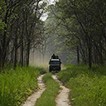
Sep 23 2016
I have visited Gokyo lake many times by taking my trekking groups from many countries. Every time I found different views of Nature. Sometimes blooming all the Himalayan alpine flower and Yak grazing in high meadow. I saw must endanger spices Musk dear and Himalayan Thar walking around the bushes. Gokyo is only trekking in the Himalayas where you can see six turquoise mountain lakes with 4 over 8000 m mountain including Mt. Everest (8850m), Lhotse (8516m), Makalu (8463m) ,Cho-Oyo (8201m). The summit of Gokyo Ri (5360m) provides 360 degree panoramic views of mountain including of Ngozumba Glacier, the largest of its kind in the Himalayas.This valley is listed on Nepal wetland Zone and one of the main part of Sagarmatha National Park area. You can trek many direction from Gokyo like just Gokyo Valley, Renjo pass, Chola Pass to Everest base camp. This is my one of the best recommended trekking destination in the Nepal Himalayas and Trekking Team Group is my Kathmandu based operator who has been operating trip since 1991. Do not hesitate to work with them; they are expert operating trip in the Himalaya.
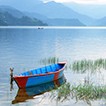
May 12 2016
We did Gokyo, Everest Base Camp and Kalapattar trekking in the late November. It was really great time on Himalaya!!! We were 9 members in our group and it was operated by Trekking Team Group. This leading Adventure Company is very professional and provided us very good service during our 17 days trekking At first we did Kathmandu sightseeing tour. Next day we flew around half hour to Lukla and started our trekking up to Gokyo Lake through Tyangboche Monastery, Everest Base Camp and Kalapattar. Mr Krishna was our guide, he was very excellent and always helpful and there were other 5 porters who were very responsible. When we were at Gokyo the weather was wonderful and offering the amazing views of Himalayas. The entire trip was perfect, experience and Valuable on Himalaya. So we would like to thanks for Krishna and Trekking Team Group who operated us very good and unforgettable trip. As well we would like to recommend this company who is planning to visit Nepal at first time with group, single, children, couple etc.
Have you been to this trip? Write Your Own Review

After you click “Submit” your review will be entered into our database for final approval before it is posted live to the public. We will edit only to address inappropriate or offensive content.
Book With Confidence
- Over 30 years in Business.
- Certified by Travelife & FTA.
- Winner of Travellers Choice Award.
- 100% safety record.
- Value for money.
- Guaranteed departure.
- Top Notch Customer Service 24/7.
- Tailormade holiday.
- Expert guides to lead the trip.
- Highly recommended by Rough Guide, Lonely Planet, Stefan Loose and Petit Futé.
Know Before You Go
- Financial security
- Our philosophy
- Responsible business
- Altitude sickness
- Equipment Checklist
GET TRIP NOTES
You will receive the pdf in your email automatically. If you do not find please check your spam message as well.
Similar Packages
Annapurna base camp trek, everest base camp trek, manaslu trekking, annapurna circuit trek, have a question.

Talk to our Experts
Not Sure Yet ?
- Ask a Question
- Request For Brochure
- Print the trip details
- Customize this trip
- Get Trip Notes
Quick Inquiry ?
Additional information.
This is ADVENTURE travel, and many of the trip destinations in this site are remote areas, within under developed countries, where events are less predictable than is usually the case in. The unexpected is the norm in these areas and, despite painstaking planning and organization, our adventure trips can never be taken for granted like regular trips. Many of the places that we visit do not have the same quality of emergency health and safety services that you are used to in the developed world. Internal flights can be canceled, road transport is generally uncomfortable and unreliable, and hotels often do not approach the standards of the West.
IF YOU ARE NOT PREPARED FOR THIS, YOU SHOULD NOT TRAVEL WITH US. This unpredictability also means that the itineraries that we put forward for each of our trips should be seen as statements of intent, rather than as contractual obligations. A variety of factors, including weather, transport difficulties and political instability, might dictate that we change any itinerary. The trip leader will make any changes that are necessary, after consultation with the group. Only rarely will such changes be significant, and we will always do everything within our powers to minimize the effects of the enforced changes. We cannot be held responsible for the results of changes or delays, irrespective of how they are caused.
What makes this trip different ?
Trekking Team Group is the major supporter of Ambe Foundation, an apolitical and not-for-profit organisation. We contribute our support for the development of some community schools in remote villages in Nuwakot district. We have been supporting Gramin Devi School and Khumbeshwori School, both community-based educational institutions, through donation, sponsorship and partnership in various projects.
Trekking Team Group donates one percentage of its total business profits to the foundation on yearly basis. The donated amount supports the ongoing maintenance of Gramin Devi School and Khumbeshwori School in Nuwakot.
Sponsorship
One of the major activities of Ambe Foundation is the children sponsorship programme. It is conducted in full collaboration with Trekking Team Group.
Partnership (Volunteering Program)
The Ambe Volunteer Programme, organised by Ambe Foundation and Trekking Team Group, aims to mobilise teams of experts and interested individuals effectively for education, health and community development in Nuwakot district.
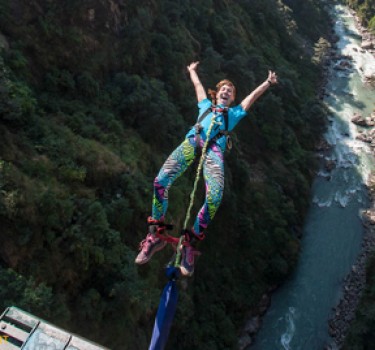
Chitlang Homestay Trek
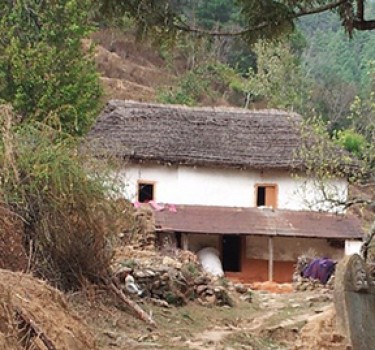

Chitwan Tour
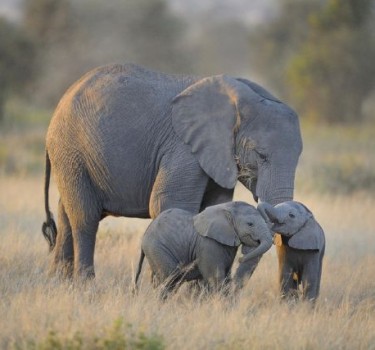
OTHER TOURS YOU MIGHT LIKE
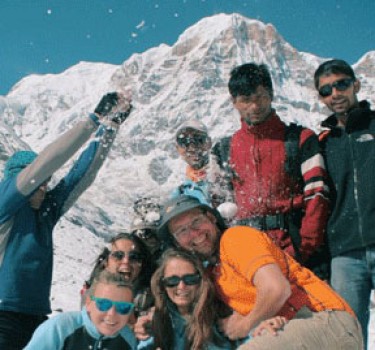
- +977 01-5905506
- trekkingteam
Essential Info
- Terms and conditions
- Trips Grading Info
- Equipment Check List
- Altitude Sickness
- Travelife Report
- Staying Healthy In Nepal
- Trekking Permit Information and Cost
- Plugs and Socket applied in Nepal, Tibet and Bhutan
- Heritage Sites Entry Fee
- Secure Payment
Nepal Trips
Travel to nepal.
- Overland To Nepal
- Visa & Immigration
- Do's And Don't
Thank you for subscribing.
- (+977) 9803397710 Call / WhatsApp / Viber

- Your cart is empty
Gokyo Lake Trek

11 Days 10 Nights
English, Nepali
About this tour
The Gokyo Lake Trek is a captivating journey that takes you to the heart of the Everest region in Nepal. This trek offers an alternative route to the popular Everest Base Camp trek , taking you through picturesque valleys, Sherpa villages, and the stunning Gokyo Lakes.
The trek begins with a scenic flight from Kathmandu to Lukla , where you’ll embark on a trail that leads you through charming Sherpa settlements like Namche Bazaar, Dhole, and Machhermo. Along the way, you’ll be treated to breathtaking views of towering Himalayan peaks, including Mount Everest , Lhotse , Makalu , and Cho Oyu .
The highlight of the trek is the exploration of the beautiful Gokyo Lakes , a series of glacial lakes with crystal-clear waters. Surrounded by snow-capped peaks, the lakes create a tranquil and awe-inspiring atmosphere that is simply unforgettable.
To enhance your experience, you’ll have the opportunity to hike to Gokyo Ri , a viewpoint that offers panoramic vistas of the entire Everest region . From here, you can witness the sunrise or sunset casting a golden glow upon the majestic Himalayas.
Essential Tips for a Successful Gokyo Lake Trek
- Ensure proper acclimatization by ascending gradually and including rest days in your itinerary.
- Stay hydrated by drinking plenty of water throughout the trek.
- Pack appropriate clothing layers and gear to adapt to changing weather conditions.
- Train and prepare physically before the trek to build endurance and stamina.
- Hire a local guide or join a guided trek for safety and navigation expertise.
- Obtain the necessary permits, including the Sagarmatha National Park Entry Permit and TIMS Card.
- Be aware of the symptoms of altitude sickness and take necessary precautions.
- Respect the local culture and customs, and be mindful of environmental conservation.
- Carry basic first aid supplies and medications for common ailments.
- Stay connected with your trekking group and communicate any concerns or issues promptly.
Gokyo Lake Trek Safety Considerations
- Acclimatize properly to the high altitude by following a gradual ascent and taking rest days.
- Stay hydrated and drink plenty of water to prevent dehydration.
- Follow the instructions and guidance of your guide or trekking agency.
- Be aware of the symptoms of altitude sickness and notify your guide if you experience any discomfort.
- Listen to your body and take breaks as needed during the trek.
- Dress appropriately for the weather conditions and carry necessary gear, including warm clothing, a rain jacket, and sturdy hiking boots.
- Carry a comprehensive first aid kit and any personal medications you may require.
- Avoid drinking untreated water and opt for purified or bottled water.
- Respect local customs, traditions, and wildlife. Follow guidelines for waste management and environmental conservation.
- Stay on designated trails and avoid taking unnecessary risks.
- Maintain a good level of physical fitness and consult a healthcare professional before undertaking the trek.
- Stay updated on weather conditions and be prepared for changes in the mountain environment.
- Purchase travel insurance that covers trekking activities and emergency medical evacuation if needed.
- Communicate any concerns or issues to your guide or trekking agency promptly.
About Gokyo Lake And Gokyo Ri
Gokyo Lakes are six beautiful glacial lakes in the Nepalese Himalayas, specifically in the Solu-Khumbu region. These lakes are very high up and surrounded by big mountains, like Cho Oyu. The lakes are a peaceful and amazing place for people who love trekking and nature. There’s also a special spot called Gokyo Ri View Point nearby, where you can see a wide and beautiful view of the area. Gokyo Ri is like a high hill that lets you look down at the Gokyo Lakes and the mountains all around. People who go there not only get to enjoy an exciting trek but also see the stunning nature from this high spot. You can see how the sunlight creates patterns on the calm lakes and how big and majestic the peaks are on the horizon. The journey to Gokyo Lakes and Gokyo Ri is a mix of exploring nature and having an adventure.
Best time for Gokyo Lake Trek
The best time for the Gokyo Lake Trek is during the pre-monsoon (spring) and post-monsoon (autumn) seasons. Specifically, the ideal months for this trek are:
- During spring, the weather is relatively stable, with mild temperatures.
- The trail is adorned with blooming rhododendron flowers, adding color to the landscape.
- Clear skies offer excellent visibility of the surrounding Himalayan peaks.
- Autumn is another optimal time for the Gokyo Lake Trek, featuring stable weather conditions.
- The skies are generally clear, providing stunning views of the mountains.
- Moderate temperatures during the day make trekking comfortable.
Both of these seasons offer favorable conditions for trekking, with less chance of precipitation and better visibility. Winter (December to February) brings extremely cold temperatures, snow, and challenging trekking conditions, while the monsoon season (June to August) brings heavy rainfall, making trails slippery and challenging. It’s crucial to plan your trek during the recommended seasons to ensure a safe and enjoyable experience.
Gokyo Lake Trek Cost
In planning for the Gokyo Lake Trek, understanding the cost breakdown is essential. In General this trek cost you around USD 1200$ – USD 1400$ per person include most of the service. Our Company typically offer packages ranging from basic to more comprehensive options. The Package total cost covers services like a knowledgeable guide to navigate the trail, assistance from porters to carry equipment, accommodations in tea houses along the route, and meals. Additionally,Flight from Kathmandu to Lukla and Lukla to Kathmandu, permits such as the Sagarmatha National Park entry permit and the TIMS card are also included. However, trekkers should be aware of potential additional costs, including fees for travel insurance to cover unforeseen circumstances, international flights to and from Nepal, tips for guides and porters, and personal expenses. We recommended to communicate openly with our trekking agency to clarify what is included in the cost and what may incur extra charges. This communication ensures a smoother and more transparent trekking experience.
- Breathtaking views of the Everest region, including Mount Everest, Lhotse, Makalu, Cho Oyu, and other magnificent peaks.
- Gokyo Lakes, a series of stunning glacial lakes with turquoise blue waters, set against a backdrop of snowy mountains.
- Gokyo Ri, a panoramic viewpoint offering a 360-degree view of the Himalayan range and the Gokyo Lakes below.
- Exploring the traditional Sherpa villages of Namche Bazaar, Dhole, and Machhermo, experiencing the rich Sherpa culture and hospitality.
- Sagarmatha National Park, a UNESCO World Heritage Site, showcasing diverse flora, fauna, and alpine landscapes.
- The vibrant town of Namche Bazaar, a bustling hub of trade and culture in the Everest region.
- Walking along the Dudh Koshi River, passing through rhododendron forests, suspension bridges, and charming Sherpa settlements.
- Opportunities for wildlife sightings, including Himalayan Thar, musk deer, colorful birds, and elusive snow leopards.
Included/Excluded
- International and Domestic Airport Pick Up and Drop.
- Kathmandu Lukla , Lukla Kathmandu Flight.
- Breakfast/Lunch/Dinner from the Teahouses menu during the treks.
- Overnight Sleep at Standard tea house with basic facility during the treks.
- Government licensed holder trekking guide including all his meals, accommodation, salary, transportation, insurance.
- One porter for two person who carry only two trekking member’s bags, including all his meals, accommodation, salary, transportation, insurance.
- If single trekker booked then guide will help you to carry some of your stuffs.
- Equipment like sleeping bags, down jackets, duffle bags, trekking poles, and Crampons will be provided (Returned after the trip is complete).
- First aid kid box included and carry by guide.
- Emergency helicopter rescue services provided, Pay By your Insurance or By Your Self.
- All needed Trekking Permit and National park Entry fees.
- All needed ground transportation mention on the itinerary.
- Government Tax and Company service charge.
- Personal expenses as like the Phone Bill, Camera Charging, Hot Shower, Wifi.
- All kind of drinks as like Mineral Water, Tea, Coffee, Juice, Coke, Fanta, Beer and Bar Bills.
- Breakfast, Lunch and Dinner during your stay in city like Pokhara, Kathmandu.
- Extra Nights’ Accommodation in Kathmandu and Pokhara, in case if you return earlier from the Treks.
- Tips to your Guide and Porter. (It is expected)
- Travel insurance.
Day 1 Fly from Kathmandu to Lukla Airport (2840m) & trek to Monjo (2830m) - 5-6 Hrs Trek
- Take an early morning flight from Kathmandu to Lukla, a scenic mountain flight.
- Meet your trekking crew in Lukla and start the trek.
- Trek through picturesque Sherpa villages, lush forests, and suspension bridges.
- Reach Monjo, a small village near the entrance of Sagarmatha National Park.
- Overnight stay in Monjo.
- Breakfast, Lunch, and Dinner at the teahouse.
Day 2 Trek from Monjo to Namche Bazaar (3440m) - 4-5 Hrs Trek
- Enter Sagarmatha National Park and trek along the Dudh Koshi River.
- Cross suspension bridges and ascend gradually to Namche Bazaar.
- Enjoy the stunning views of Everest, Lhotse, and other surrounding peaks.
- Explore Namche Bazaar, the vibrant trading hub of the Everest region.
- Overnight stay in Namche Bazaar.
Day 3 Acclimatization Day in Namche Bazaar
- Rest and acclimatize to the high altitude in Namche Bazaar.
- Take a short hike to Everest View Hotel or explore the surrounding areas.
- Visit the Sherpa Cultural Museum and learn about the local Sherpa culture.
Day 4 Trek from Namche Bazaar to Dhole (4110m) - 5-6 Hrs Trek
- Resume the trek and follow the trail towards Dhole.
- Enjoy panoramic views of Everest, Ama Dablam, and other peaks along the way.
- Trek through rhododendron forests and pass through the villages of Sanasa and Mongla.
- Reach Dhole, a small settlement surrounded by stunning mountain vistas.
- Overnight stay in Dhole.
Day 5 Trek from Dhole to Machhermo (4470m) - 4-5 Hrs Trek
- Continue the trek through alpine landscapes and gradual ascents.
- Pass through scenic ridges and enjoy views of the Himalayan peaks.
- Arrive in Machhermo, a small village nestled in the mountains.
- Learn about the Yeti legends associated with this area.
- Overnight stay in Machhermo.
Day 6 Trek from Machhermo to Gokyo Lake (4750m) - 4-5 Hrs Trek
- Trek alongside the Dudh Koshi River and ascend towards Gokyo.
- Pass by stunning glacial lakes and enjoy the pristine mountain scenery.
- Reach Gokyo, a beautiful lakeside village with panoramic views of Cho Oyu and other peaks.
- Overnight stay in Gokyo.
Day 7 Early Morning Hike to Gokyo Ri (5360 m) for a Sunrise View and Explore Gokyo Lake (4790 m)
- Start early in the morning for the hike to Gokyo Ri.
- Witness a breathtaking sunrise view over the Everest region from the summit.
- Enjoy panoramic views of Everest, Makalu, Cho Oyu, and other peaks.
- Descend back to Gokyo and explore the turquoise Gokyo Lake.
Day 8 Trek from Gokyo to Dhole (4200m) - 5-6 Hrs Trek
- Descend from Gokyo and retrace your steps towards Dhole.
- Enjoy the views of the surrounding mountains and landscapes.
- Pass through Machhermo and continue trekking to Dhole.
Day 9 Trek from Dhole to Namche Bazaar (3440m) - 5-6 Hrs Trek
- Trek back to Namche Bazaar through familiar trails.
- Descend through rhododendron forests and Sherpa villages.
- Arrive in Namche Bazaar and spend the evening exploring the town.
Day 10 Trek from Namche Bazaar to Lukla (2840 m) - 6-7 Hrs Trek
- Begin the final day of trekking, descending from Namche Bazaar to Lukla.
- Pass through Phakding and enjoy the last views of the Everest region.
- Reach Lukla and celebrate the successful completion of your trek.
- Overnight stay in Lukla.
Day 11 Fly back to Kathmandu
- Take an early morning flight from Lukla to Kathmandu.
- Transfer to your hotel in Kathmandu.
- Rest and relax or explore the vibrant city.
- Overnight stay in Kathmandu.
- Breakfast and Lunch at the teahouse.
Frequently asked questions
Is it possible to do the gokyo lake trek without prior trekking experience.
While prior trekking experience is not mandatory, it is recommended to have some level of hiking experience, especially at high altitudes. Adequate physical fitness, preparation, and acclimatization are crucial for a successful and enjoyable trek.
What is the maximum altitude reached during the Gokyo Lake Trek?
The highest point reached during the Gokyo Lake Trek is the summit of Gokyo Ri, which stands at an altitude of 5,360 meters (17,585 feet).
How difficult is the Gokyo Lake Trek?
The Gokyo Lake Trek is considered a moderately challenging trek. It involves several days of trekking at high altitude, with some steep ascents and descents. Good physical fitness and prior hiking experience are recommended.
What is the best time to do the Gokyo Lake Trek?
The best time to do the Gokyo Lake Trek is during the spring (March to May) and autumn (September to November) seasons. These months offer stable weather, clear skies, and moderate temperatures, making for comfortable trekking conditions.
Are permits required for the Gokyo Lake Trek?
Yes, you will need to obtain permits for the Gokyo Lake Trek. This includes the Sagarmatha National Park Entry Permit and the TIMS (Trekkers' Information Management System) Card. Your trekking agency can assist you in obtaining these permits.
Is it necessary to hire a guide for the Gokyo Lake Trek?
While it is not mandatory, it is highly recommended to hire a guide for the Gokyo Lake Trek. A guide can provide valuable assistance, navigate the trail, offer insights into the local culture, and ensure your safety throughout the trek.
What kind of accommodation can I expect during the trek?
Accommodation during the trek is in teahouses or lodges along the trail. These basic yet comfortable accommodations offer private or shared rooms with twin beds, blankets, and simple toilet facilities. Please note that the higher you go, the more basic the facilities may become.
How is the food and water situation during the trek?
Meals during the trek are provided at teahouses and lodges along the trail. The menu typically includes a variety of Nepali, Tibetan, and international dishes. It is recommended to consume bottled or purified water to prevent any waterborne illnesses.
Is it safe to drink the water from the streams and rivers?
It is not recommended to drink water directly from streams or rivers during the trek. It is best to carry a water purification method or purchase bottled water from teahouses along the trail.
Tour's Location
Write a review, leave a review cancel reply.
Your email address will not be published. Required fields are marked *
Sign me up for the newsletter!
Pathfinder Treks And Expedition
Member Since 2023
Information Contact
https://pathfindertreks.com
+9779803397710
+97714350244
Explore other options

Everest Base Camp Trek

Everest Three Pass Trek

Island Peak Climbing With EBC Trek

Everest Base Camp Chola Pass Gokyo Trek

Salleri To Everest Base Camp Trek

Pikey Peak Trek

Gokyo Lake Renjo La Pass Trek

Island Peak Climbing
Enter the e-mail address associated with the account. We'll e-mail a link to reset your password.


Himalaya Discovery Adventures
Gokyo Ri Trek Cost
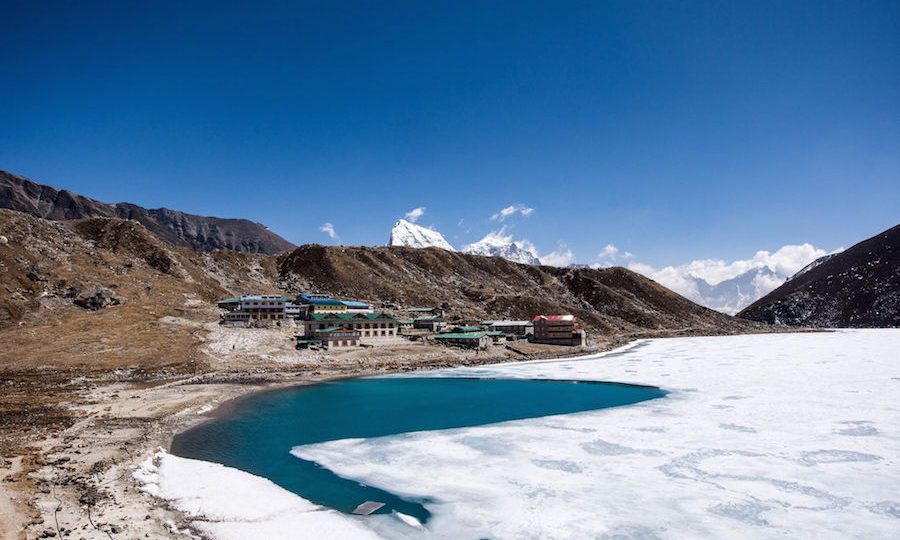
The Gokyo Ri trek, the best alternative hike to the Everest Base Camp (EBC trek), offering spectacular views of the Himalayan peaks along with lakes and glaciers. The highlights of this Gokyo Ri trek is Gokyo Ri summit. The views from the summit are simply amazing, standing at over 5000 meters. You can see the summits of Everest, Lhotse, Makalu and Cho Oyu!
The view is often seen as one of Nepal’s finest and it’s simple to see why. It is also a lovely time to hike Gokyo Ri in the afternoon, as you will see the sunset over the lovely Gokyo Lakes. And like any other treks in Nepal, the Gokyo Ri Trek cost depends on various factors.
The Gokyo Ri trek itself is much quieter than the EBC trek as there are far fewer trekkers on the route. After your flight from Kathmandu, the trek begins at Lukla.
The trail follows the traditional Everest Base Camp trekking route for the first three days to Namche Bazaar for the first three days. Just after Namche, the trail heads northwest through the towns of Dole and Machhermo, and then to the beautiful Goyko Lakes.
How Much Does the Gokyo Ri Trek Cost?
The Gokyo Ri trek cost ranges from USD 1200 to USD 1800 per person. It covers your flight cost, permit, transportation, accommodation, guide, porter, etc.
The cost depends, however, on the season you are traveling in and the activities you want to do during your trek.
Gokyo Ri Trek features the remote Gokyo Valley’s incredible scenery. It is a glacial turquoise valley. It offers amazing mountain views including Mount Everest, Lhotse, Nuptse, Mount Makalu, etc.
As with the cost of any other trek in Nepal, the Gokyo Ri trek cost depends on different factors such as:
- Trekking length
- Trekking season
- Number of people in a group
- Transportation and accommodation types you choose
- Food and drink type you get
- Extra services you get
Why You Should Consider Gokyo Ri Trek?
For beginners, the spectacularly beautiful Gokyo Lakes. A pretty unforgettable experience is the panoramic views over the turquoise lakes with 8,000m-plus peaks in the background.
You will also have the chance to hike Gokyo Ri, the mountain that overlooks the small village of Gokyo. This climb offers some of the most amazing views of Mt. Everest and Cho Oyu.
Perhaps the views are even better than Kalapathar, which is the most popular point of view along the traditional EBC trekking route.
The side trip to Gokyo Lakes is still a relatively quiet route, meaning you can walk a few hours without seeing other people. The traditional EBC trekking route is quite crowded, sometimes taking away from the atmosphere.
Also, a rewarding extra challenge is the side trip of Gokyo Lakes, climbing Gokyo Ri and crossing the Cho-La Pass or Renjo La Pass are the challenging things in this region.
How Difficult is the Gokyo Ri Trek?
The trek to Gokyo Ri is a moderately difficult trek. While the trek does not require any technical climbing, the difficulty of the Gokyo Ri trek is due to the long-day trek.
While no prior trekking experience is needed, the trek involves 5-7 hours of trekking per day on hilly/rocky terrain at high altitude. Most of the trek is spent above 4,000m and altitudes of over 5,500m are reached when crossing passes and trekking peaks.
We recommend training a couple of weeks to months in advance to make you comfortable walking similar distances on the trek.
Tips for Altitude Sickness During Gokyo Ri Trek
During the Gokyo Ri trek, there is nothing dangerous, no exposed terrain. The only thing that could cause you trouble is altitude sickness;
It’s a very individual thing. Some people have no problems at all, others already in 3000m begin to feel “sick.” The best advice I can give is to walk slowly, very slowly above 4000m. Drink plenty of tea and water, have a good meal. (Locals think garlic soup is good to prevent sickness from altitude).
If you start experiencing some symptoms of altitude sickness (which can be very different for everyone), such as dizziness, feeling like having a cold, headache, nausea, you can go down to a lower altitude and wait overnight. You can carry on if it gets better. This is another reason you’re supposed to have enough additional days.
A medicine called Diamox is also available to prevent and reduce the symptoms of altitude sickness . We advise patience and slow pace during the trek.
Detailed Itinerary of Gokyo Ri Trek
Day 1, Arrive in Kathmandu (1,400m)
Upon arrival at the airport in Kathmandu after your Visa custom formalities etc. Pick up your luggage and look for our representative from Himalaya Discovery Airport to show your name on the board at the gate of your arrival. Our representative welcomes you and then transferred you to the hotel by private tourist vehicle. Overnight in Kathmandu.
Day 2, Fly to Lukla (2,800m) and trek to Phakding (2,652m), 3-4 hrs walk
Take a short flight to the tiny airstrip at Lukla. Have time to walk around while the guide will sort and divide the load baggage to be carried by porters. Enjoy lunch before starting the easy walk to the village of Phakding. Overnight at Phakding.
Day 3, Trek to Namche Bazaar (3,445m), 5-6 hrs walk
We will continue up the banks of the Dudh Kosi after breakfast, crossing it twice through small suspension bridges before reaching the village of Monjo, the Sagarmatha National Park entrance gate. Descend for a bit and then a gradual walk takes us to Jorsalle village, the last village before Namche Bazaar, to the suspension bridge over the Bhote-Koshi river. Namche is the Khumbu Region’s capital. Overnight at Namche.
Day 4, Acclimatize day.
We’re going to spend an acclimatization day at Namche Bazaar. For a wonderful panoramic view or a stroll around the market, you have a full day of leisure to visit the Everest View Point hotel. There’s also a Sherpa museum, a great place to learn about Sherpa culture and mountaineering history. Overnight at Namche
Day 5, Trek to Dole (4200m), 5-6 hrs walk
We’ll be rewarded with a magnificent view of the great giant snow peaks at Shanasa after a gradual trail with a few short ups and downs. Climb to the hill of Mongla and go down to Phortse Thanga. A few more hours of climbing will take us to Dole after lunch. Overnight at Dole.
Day 6, Trek to Machhermo (4470m), 4-5 hrs walk
Today we climb to the scenic ridge above Dole. The trail continues to climb along the valley side, high above the river, where we arrive at Machhermo. Late in the afternoon, we visit the Himalayan Rescue Association. Overnight at Machhermo.
Day 7, Trek to Gokyo (4790m), 3-4 hrs walk
Trekking up a ridge provides excellent views down the valley to Khangtega and north to Cho-Oyu (8153m/26741 ft). Our route descends to the bank of the river before starting the climb to the Ngazumpa glacier’s terminal moraine. The trail then rises as it follows the valley past a second lake, 4690m/15383 ft known as Longponga. Another hour’s walk will take us to the third lake edge of Gokyo village. Overnight at Gokyo.
Day 8, Discover Gokyo
We trek up to Gokyo Ri early in the morning for a breathtaking view of a mountain sunrise including Mt. Everest. You’ll have unforgettable memories of many of the famous Himalayan mountains and glaciers. Overnight at Gokyo.
Day 9, Trek to Phorse Village/ Phorste Thanga (3680m), 5 to 6 hrs walk.
We will start our walk back through the same valley after breakfast. We cross a valley and go uphill for overnight to the village of Phorse. Phorse Village is interesting as it lies in the center of the mountains above the valley of the river with the surroundings of the pine and Rhododendron forest. You can also see the pheasant of the Himalayas and some other Himalayan livestock. Overnight at Phorse.
Day 10, Trek to Tengboche (3,867m), 5-6 hrs walk
We’re mostly heading down this morning, following a narrow trail to reach the valley of the river. Then, through the forested hills of pine and rhododendron, a gradually steep walk up hills reach Tengboche, situated on top of the hill.
You have a great view of Mt. Ama Dablam from Tengboche, as well as of Thamserku, the top of Mt. Everest and Nuptse. Tengboche has the largest Buddhist monastery in Tengboche, where you can witness the evening prayer ceremony of the monks. Overnight at Tengboche.
Day 11, Trek to Namche Bazaar via Khumjung (3,790m), 5 hrs walk
Today’s trail leads down to the wooded hills called Phungithanka, crossing the Dudh Koshi River with local suspension bridge, and then a long walk uphill to the junction of Kyanjuma. Another gradual walk of 30-40mins takes you to the Khumjung Valley.
We will spend some time here visiting the Khunde Hospital, founded by Sir Edmund Hillary, The Hillary School, and the legendary Yeti scalps of the old monastery. Enjoy the panorama of the mountains, then continue on to Syangboche airstrip, which is the highest airport in the world at 3700 m. We’ll continue overnight down to Namche Bazaar.
Day 12, Lukla (2,800m), 4-5 hrs walk
Continue downhill to Lukla, an easy trek, even though there are small hills up and down. The path goes back to the same one we walked on our first day. It will take about four to five hours to get to Lukla. The guide will re-confirm the flights to Kathmandu for the next day while you freshen up with a warm shower. Celebrate your trek success in the bars, restaurants and pubs of Lukla. Overnight at Lukla.
Day 13, Fly back to Kathmandu (1,400m)
After an early morning flight to Kathmandu our guide transfers you to your hotel. You may have time to relax after long journey and take back your breath and rest at your hotel with ending your Himalayan trip with us.
In the evening we will have a farewell dinner in a traditional Nepalese restaurant with cultural performances.
Day 14, Free Day / Fly to home.
Enjoy your final moments in Kathmandu. Our staff will meet you at your hotel and drive you to the airport for your return flight to home.
Gokyo Ri Trek Alternative Routes
You can extend the Gokyo Ri trek and continue through the Chola Pass (5420 m) to the Everest Base Camp (5360 m) including the Kala Patthar hike (5550m).
In that case, you’re going to do two wonderful treks at the same time and you’re not going to have to go back the same way. You will need about 16 days for this variation, including the flight to/from Kathmandu.
Gokyo Ri Trek Map
It is the greatest relief to have a good budget for your trek. The detailed information of Gokyo Ri Trek cost, this allows you to fully enjoy yourself and make the most of the journey.
While you work so hard, investing your time in something you like to do is equally important. And it is nothing less than traveling and exploring new places.
The trek through the Gokyo Ri is an affordable trek. It allows you to immerse yourself in the mountains’ beauty and adventure.
This trek will take you through the world’s highest passes including the Cho-La Pass and Gokyo Ri. Moreover, you’ll be spellbound by the beauty of cobalt blue lakes.
Please feel free to contact us for further questions and inquiries.
Do you have any question about trip to Nepal?
- Solo Traveller
- Number of child (if you have child in your family/group) (Optional)
- When will you be traveling?* * Day 1 2 3 4 5 6 7 8 9 10 11 12 13 14 15 16 17 18 19 20 21 22 23 24 25 26 27 28 29 30 31 Month 1 2 3 4 5 6 7 8 9 10 11 12 Year 2025 2024 2023 2022 2021 2020 2019 2018 2017 2016 2015 2014 2013 2012 2011 2010 2009 2008 2007 2006 2005 2004 2003 2002 2001 2000 1999 1998 1997 1996 1995 1994 1993 1992 1991 1990 1989 1988 1987 1986 1985 1984 1983 1982 1981 1980 1979 1978 1977 1976 1975 1974 1973 1972 1971 1970 1969 1968 1967 1966 1965 1964 1963 1962 1961 1960 1959 1958 1957 1956 1955 1954 1953 1952 1951 1950 1949 1948 1947 1946 1945 1944 1943 1942 1941 1940 1939 1938 1937 1936 1935 1934 1933 1932 1931 1930 1929 1928 1927 1926 1925 1924 1923 1922 1921 1920
- How many days do you have?* *
- Give your trip a short title* *
- Private Trip
- Bellow 200$
- 200$ - 500$
- 500$ - 800$
- 800$ - 1200$
- 1200$- 2000$
- 2000$ and above
- Describe your trip* *
- Full Name* *
- Your Email* *
- Country* * Afghanistan Albania Algeria American Samoa Andorra Angola Anguilla Antarctica Antigua and Barbuda Argentina Armenia Aruba Australia Austria Azerbaijan Bahamas Bahrain Bangladesh Barbados Belarus Belgium Belize Benin Bermuda Bhutan Bolivia Bonaire, Sint Eustatius and Saba Bosnia and Herzegovina Botswana Bouvet Island Brazil British Indian Ocean Territory Brunei Darussalam Bulgaria Burkina Faso Burundi Cabo Verde Cambodia Cameroon Canada Cayman Islands Central African Republic Chad Chile China Christmas Island Cocos Islands Colombia Comoros Congo Congo, Democratic Republic of the Cook Islands Costa Rica Croatia Cuba Curaçao Cyprus Czechia Côte d'Ivoire Denmark Djibouti Dominica Dominican Republic Ecuador Egypt El Salvador Equatorial Guinea Eritrea Estonia Eswatini Ethiopia Falkland Islands Faroe Islands Fiji Finland France French Guiana French Polynesia French Southern Territories Gabon Gambia Georgia Germany Ghana Gibraltar Greece Greenland Grenada Guadeloupe Guam Guatemala Guernsey Guinea Guinea-Bissau Guyana Haiti Heard Island and McDonald Islands Holy See Honduras Hong Kong Hungary Iceland India Indonesia Iran Iraq Ireland Isle of Man Israel Italy Jamaica Japan Jersey Jordan Kazakhstan Kenya Kiribati Korea, Democratic People's Republic of Korea, Republic of Kuwait Kyrgyzstan Lao People's Democratic Republic Latvia Lebanon Lesotho Liberia Libya Liechtenstein Lithuania Luxembourg Macao Madagascar Malawi Malaysia Maldives Mali Malta Marshall Islands Martinique Mauritania Mauritius Mayotte Mexico Micronesia Moldova Monaco Mongolia Montenegro Montserrat Morocco Mozambique Myanmar Namibia Nauru Nepal Netherlands New Caledonia New Zealand Nicaragua Niger Nigeria Niue Norfolk Island North Macedonia Northern Mariana Islands Norway Oman Pakistan Palau Palestine, State of Panama Papua New Guinea Paraguay Peru Philippines Pitcairn Poland Portugal Puerto Rico Qatar Romania Russian Federation Rwanda Réunion Saint Barthélemy Saint Helena, Ascension and Tristan da Cunha Saint Kitts and Nevis Saint Lucia Saint Martin Saint Pierre and Miquelon Saint Vincent and the Grenadines Samoa San Marino Sao Tome and Principe Saudi Arabia Senegal Serbia Seychelles Sierra Leone Singapore Sint Maarten Slovakia Slovenia Solomon Islands Somalia South Africa South Georgia and the South Sandwich Islands South Sudan Spain Sri Lanka Sudan Suriname Svalbard and Jan Mayen Sweden Switzerland Syria Arab Republic Taiwan Tajikistan Tanzania, the United Republic of Thailand Timor-Leste Togo Tokelau Tonga Trinidad and Tobago Tunisia Turkmenistan Turks and Caicos Islands Tuvalu Türkiye US Minor Outlying Islands Uganda Ukraine United Arab Emirates United Kingdom United States Uruguay Uzbekistan Vanuatu Venezuela Viet Nam Virgin Islands, British Virgin Islands, U.S. Wallis and Futuna Western Sahara Yemen Zambia Zimbabwe Åland Islands Country
- Phone Number (Optional)
You May Also Like...
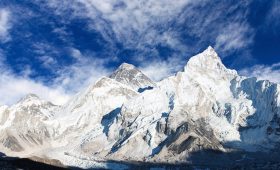
Everest Base Camp Trek Guide – All Questions Answered

Training for Everest Base Camp Trek Nepal
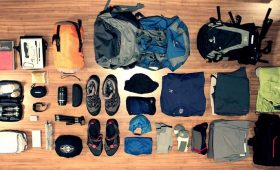
Everest Base Camp Trek Packing List
Leave a reply cancel reply.
Your email address will not be published. Required fields are marked *

“I was born and raised in Nepal, nearby Everest region. I am proud to be a native Sherpa, and I have been a Mountain guide over a decade now. Following my passion, I decided to start helping travelers with their travel plans! I think life is a journey, a trip where you collect experiences when you share with other people and with nature.”
Privacy Overview
- [email protected]
- +977 9841161593
- +977 9851149890
- You are here:
- Destinations
- Everest Region Trek
Gokyo lakes and Gokyo Ri Trek
..Takes you to one of the most deserved land to explore the hidden lake on earth
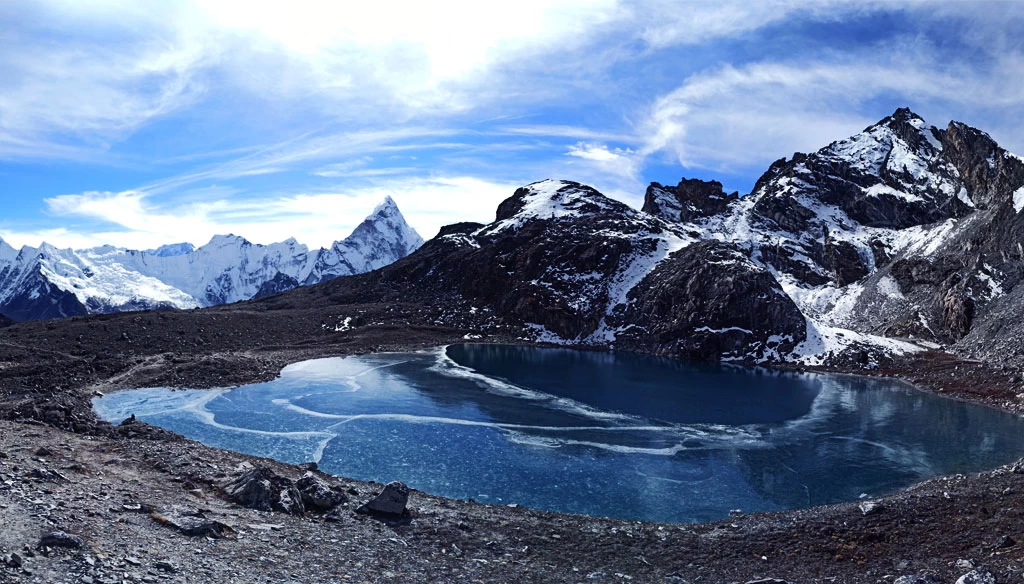
Gokyo Lakes and Gokyo Ri Trek is one of the most incredible classical treks in the Khumbu Region of Nepal . Filled with an abundance of different vegetation, flora, and fauna, the trail is a diversification of nature and culture. It is a moderate trek for those trekkers who wish to try something new and challenging in the Himalayas.
The trail will lead us to an abundance of scenic views of the mighty Himalayas along with Mt. Everest the highest mountain on the earth. Gokyo Lakes trek will lead us to six main freshwater lakes of the area located from an elevation of 4700m-5000m , all fall under Sagarmatha National Park comprising an area of 443 sq. mile.
Along with the conserved area, the Gokyo Lake and the surrounding lakes occupy an area of 30 sq. miles and have been designated as a Ramsar Site which has hydrological importance.
These lakes are the main sources of water flowing into the Dudh Koshi River and another stream of the Himalayas, water in the lake is all filled by the snow melted from the surrounding mountains.
Apart from these, Gokyo and the surrounding lakes have religious significance for both Hindu and Buddhist followers, regarded as the abode of Nag Raj (serpent god), which makes strong faint not to harm any animals of the surrounding region, during the month of August there is a festival known as Janai Purnima , a flock of devotee trek into the lake for a holy dip for purification of the inner soul.
As the trail is less crowded as compared to other trekking areas trekkers can enjoy their time in a solitary way.
The main attraction of the trek will be the Gokyo Lake also known as Dudh Pokahari covering an area of 42.9 ha, followed by Thonak Lake (62 ha) one of the largest lakes, Gyazumpa Lake (29 ha), Tanjung Lake (17 ha), Ngojumba Lake (14 ha) and Longbanga Lake among these lakes Thonak Lake is the deepest lake (62.4 m), followed by Gokyo Lake (43 m).
The trail will further take us to Gokyo Ri also known as Gokyo Peak which lies at the elevation of 5357m/17575ft , it will be a day hike for us but the trail further leads to some of the majestic passes including Cho La Pass, and also to Everest Base Camp.
Gokyo Ri is one of the majestic peaks for the panoramic views of the massif Himalayas helping us to view four of the most famous 8000m+ mountains i.e. Mt. Everest (8848m) highest mountain , Mt. Lhotse (8516m) is the fourth highest mountain , Mt. Cho Oyu (8188m) is the sixth highest mountain and Mt. Makalu (8485m) is the fifth highest mountain along with other surrounding Himalayas.
Apart from the Himalayas, the Gokyo Peak will be a viewpoint to observe the Ngozumpa Glacier just below Mt. Cho Oyu covering an area of 22 miles. It is the longest glacier in the Himalayan region, and view of the majestic Gokyo Lakes all blue in color and Gokyo village will be one of the fabulous views to experience making it the real paradise on the earth.
Apart from the majestic Himalayas, the trek starts with the lowland view, rivers, crossing suspension bridges, passing by the most incredible town on the Himalayas Namche Bazaar, the Buddhist monasteries, praying wheel, praying flag, etc.
Besides all these majestic experiences the hospitality of the Sherpas community and their lifestyle will be the center of attraction for travelers. The surviving culture and religion of the Sherpa community along with the Gokyo lakes and Gokyo Ri will energize us with its beauty.
Discover Altitude has specially designed Gokyo Lakes and Gokyo Ri Trek Itinerary with frequent field visits by our professional staff to make sure the program goes according to the itinerary mentioned below.
For the convenience of our client minute detailed itinerary, cost, highlights, pictures, and the map has been provided. As it is an energetic trek in the Himalayas, so the trekkers can visit this trail every season throughout the year. Regarding the Gokyo Lakes and Gokyo Ri Trekking Cost, it varies on the number of days and people.
We are flexible to revise and customize the itinerary according to the allocated time and interest as far as possible to make sure the need and interests of our valuable clients are accomplished.
- Adventurous trek in one of the most incredible regions on the earth.
- Experience the domestic flight to one of the most incredible airports Lukla.
- Magnificent view of the Himalayas.
- Meet and know the people of the mountain, their culture, and their daily activities.
- Experience nature with the panoramic view of the Himalayas.
- View the sunrise over the top of the world Mt. Everest along with other three 8000m mountains.
- Feel the thrill of Paradise on the earth.
- Magnificent views of the six lakes
- Enjoy the panoramic view of Gokyo Lake and Gokyo Ri
- Experience the climbing to Gokyo Ri (Peak)
- Enjoy the unique culture and hospitality of the Himalayan kingdom
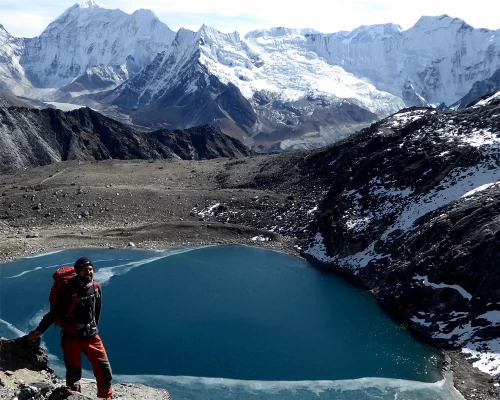
Day 1: : Fly from Kathmandu to Lukla(2840m/9318ft/ 35minute flight) and trek to Phakding. (2610m/8563ft)- 4 hours
- Accommodation Tea-House
- Meals Breakfast, Lunch and Dinner
- Time 4 Hours trek
- Maximum Altitude 2610M/8563Ft
- From today our journey to the Everest Base Camp will start, after having our breakfast we will drive to the airport for 15 minutes and start our 35-minute flight to one of the loveliest airports in the world between the Himalayas.
- On arrival in Lukla, we will enjoy a couple of hours for the view and also to acclimatize our body to the drastic change in altitude compared to Kathmandu.
- Now we will be heading ahead to our clear trail of the first day, enjoying beautiful scenic views.
- The trail goes downhill, with the view of Kusum Kangaru(6367m/20889ft), and on the way with a Buddhist monastery, a praying flag hanging, the praying wheel, farmland, teahouses on the way, etc can be seen.
- Finally, we will be able to reach Phakdin village, a small Sherpa village with enormous hospitality.
- Overnight at our tea house.
Day 2: Trek from Phakding to Namche Bazaar. (3446m/11306ft)- 7 hours
- Time 7 Hours trek
- Maximum Altitude 3446M/11306Ft
- Today will be a bit tough day for us as compared to the first day, so after our breakfast, we will be heading a little downhill to cross the suspension bridge of Phakdin.
- After crossing the bridge we will be heading uphill for almost 3 hours with stony steep before we reach a beautiful Monjo village on the top of the hill, this village is the entrance point of Sagarmatha National Park, we rest here for a short period.
- Further 4 hours trek before we reach Namche Bazaar, crossing the hills with beautiful views of the Himalayas, crossing the Dudh Koshi river through a long suspension bridge, we will be reaching Jorsale(2775m/9104ft) the last village before Namche Bazaar.
- From Jorsale we will be heading uphill at a steady pace to reach Namche Bazaar, the capital of Sherpa, Namche Bazaar is the oldest inhabitant settlement of the Sherpa community.
- This spot is now occupied with special hospitals, post offices, ATMs, banks, etc, and a beautiful town on the Himalayas, further uphill there is an army camp to monitor and also help trekkers and climbers in times of need.
- On arrival in this beautiful town, we can enjoy our free time watching the first view of the gain Himalayas like Mt. Everest, Nuptse, Lhotse, etc.
Day 3: Acclimatization Day in Namche Bazaar. (3446m/11306ft)- 5 hours
- Time 5 Hours
- Today will be our rest day to acclimatize our body before we head further up to our final destination.
- Although it is a rest day we need to make sure we are using the day according to the instruction of our trekking guide.
- After our breakfast we will be heading to Everest View Point, as a day excursion tour guided by our trekking guide, this will take some 3-4 hours to complete with the stunning views of Mt. Everest.
- Then we will be descending downhill to Namche Bazaar, for the rest of our day, here we can enjoy our free time exploring this beautiful town and the people living around.
Day 4: Trek from Namche Bazaar to Phortse. (3810m/12496ft)- 6 hours
- Time 6 Hours
- Maximum Altitude 3810M/12496Ft
- After breakfast we make a steady ascend to the Khumjung hill passing by a village towards the Dudh Koshi River.
- The trail will be diverted towards the north with a couple of trail different trails but the best will be our choice.
- As we move to pass by a chorten on the top of the mountain, we will visit Mohang the birthplace of the re-incarnate Lama of Rongbuk Monastery situated in Tibet, he is the Lama who bought Buddhism in the Khumbu region of Nepal.
- The trail now descends downhill towards the Dudh Koshi River leading to Phorse, a small overnight place situated by the bank of the river.
- Overnight at our lodge.
Day 5: Trek from Phortse to Machhermo. (4470m/14663ft)- 6 hours
- Maximum Altitude 4470M/14663Ft
- Today our trail will be all the way through the Dudh Koshi River, climbing the steep mountain uphill.
- The trail will pass by the rhododendron forest and waterfall before reaching the small village of Tongba.
- Further climbing uphill passing by some more villages like Dole, Labarma, and Luza village with magnificent views of the Himalayas and the surrounding areas we will arrive in the village of Machhermo.
- Overnight at our lodge
Day 6: Trek from Machhermo to Gokyo. (4800m/15744ft)- 5 hours
- Maximum Altitude 4800M/15744Ft
- Our day will start after our breakfast, climbing uphill the trail will lead us to the mesmerizing views of Cho Oyu (8153m)
- The trail now widens through Phangkha, the very spot where the avalanche occurred in 1995 killing 40 trekkers
- Trekking downhill now we will descend towards the river crossing the iron bridge over the snow melted stream, leveling the trail we pass by the three lakes regularly i.e. Longpongo at the altitude of 4690 m, Taboche Tsho, and Dudh Pokhari.
- As we descend we will be fascinated with the surrounding views of the giant Himalayas, further, we will head towards the Gokyo village just by the giant lake boarding with the majestic mountain Cho Oyu.
Day 7: Explore around Gokyo and hike to Gokyo Ri. (5357m/17570ft)- 4 hours
- Time 4 Hours
- Maximum Altitude 5357M/17570Ft
- Today will be a free day but will make it busy.
- As an acclimatization day, we hike to Gokyo Ri for some astonishing views of the Himalayan vista.
- Further, we can take a tour of some of the beautiful Gokyo lakes (a total of six in number)
- Visiting some of the lakes we can hike (Optional) towards Gokyo Ri for the magnificent views of the Himalayas.
- Further, the views of the mountains like Cho-Oyo, Gyachung Kang, Mt. Everest, Lhotse, Makalu, Nuptse, and the huge Ngozumba glacier will be jaw-dropping.
- Overnight at Gokyo.
Day 8: Trek down to Dole. (4030m/13221ft)- 5 hours
- Maximum Altitude 4030M/13221Ft.
- Descending all the way downhill on the way through the Dudh Koshi River, we pass by the first Gokyo Lake.
- The trail will support us with the view of mountains like Cholatse, Taboche Peak, Thamserku, Cho Oyu, and Kangtand.
- Climbing further uphill we pass by the villages Machhermo, Luza, and Lhafarma before reaching Dole.
- Overnight at our lodge/ tea house
Day 9: Dole to Namche Bazaar/ Monjo (2835m/9301ft)- 6 hours
- Maximum Altitude 2835M/9301Ft
- An easy day for us descending downhill today with the surrounding views of mountains we pass by Phortse Thanga.
- Passing by beautiful rhododendron forest and waterfall, we will view wild mountain goats, yaks, birds, etc before reaching Namche Army Camp Hill, a good place to bid farewell to Mt. Everest, Mt Lhotse, and Tengboche for the last time.
- Descending further for 40 minutes we reach Namche Bazaar.
- Today we will be descending to Monjo if we are not interested in Namche Bazaar. Monjo is a small village that lies just by the Dudh Koshi River below the Namche Bazaar.
- With the views of the hilly green valley and Snowy Mountain behind, we descend at a nominal pace in a more relaxing way.
- Passing by Namche Bazaar, we will descend further downhill through the Sagarmatha National Park entrance gate for an hour to reach Monjo.
Day 10: Trek from Monjo to Lukla. (2840m/9318ft)- 6 hours
- Maximum Altitude 2840M/9318Ft
- Passing the Monjo village and re-crossing the Dudh Koshi River through the suspension bridge we reach Phakding village where we can have our lunch.
- With the views of the farmland and villages all the way we will arrive at Lukla.
- This is the end of our day and a beautiful experience to be remembered, so it’s a celebration day as well.
- Today we can grandly enjoy our evening as we love sharing our experience with our team, shining and dancing will be another asset to remember to make our trip a memorable one.
- We thank our Sherpa porter for their help and kindness and bid them farewell promising to meet someday.
Day 11: Fly from Lukla to Kathmandu- 30 minutes
- Accommodation Star Category Hotel
- Meals Breakfast
- Time 30 Minute flight
- Maximum Altitude 1350M/4430Ft
- After breakfast, we get ready for our domestic flight back to the capital city of Kathmandu.
- On arrival at Kathmandu, we will be picked up by our private car to our respective hotel.
- After check-in and refreshments, we have a free day to visit around Thamel and enjoy some Trekking Massage and visit the office of Discover Altitude to share our experience.
- Overnight at our hotel.
- Download PDF
Not happy with this regular itinerary?
Rearrange according to your timeframe.
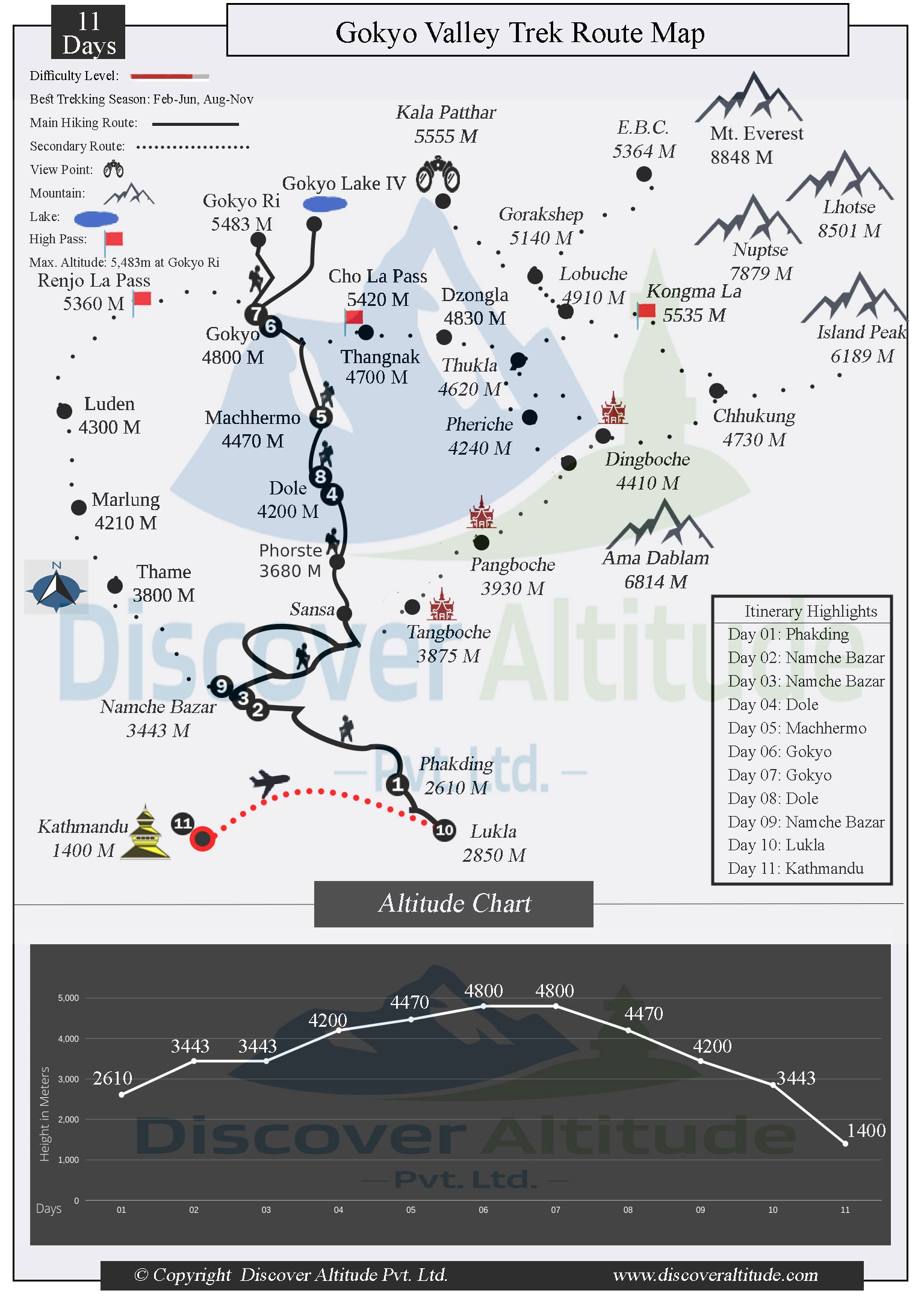
Cost Details
- International Airport Pick up an Drop
- All Ground Transpotation
- Round trip flight in and out to Lukla by plane.
- 3 Meals during the trek ( Breakfast | Lunch | Dinner )
- All night accommodation in lodge during the trek
- Sagarmatha National Park Permits
- Pasang Lhamnu VDC Permit
- TIMS Permit
- Registered Trekking Guide
- Accommodation and food for guide
- First Aid Medical Kit
- Water Purification Tablet/Liquid
- Trekkking Pole
- All Government Taxes and Service Charges
- Hotel in Kathmandu
- Personal Expenses (Bottled Mineral Water, Hot Drink, Hot Shower, Mobile Charging)
- Tips to your Guide
Risk free booking & Free Cancellation.
Useful Info
- Gokyo Lake and Gokyo Ri lie in the Khumbu Region of Nepal on the way to Everest Base Camp.
- Gokyo and Gokyo Ri Trek is one of the most incredible treks for trekkers who accept the challenges in the Himalayas.
- The trek will lead us to one of the most diverse regions at a high altitude, filled with different vegetation, flora, and fauna.
- Gokyo Lake lies at an altitude of 4800 meters is a conserved area of the Sagarmatha National Park and has been designated as a Ramsar Site.
- Apart from Gokyo Lake, the trail will lead us to numerous other freshwater lakes of the Himalayas, one of the main sources of snow-melted water of the Himalayas.
- Further, the trail will be diverted into the Gokyo Ri also known as Gokyo Peak at an elevation of 5357 meters for the magnificent views of the high Himalayas which includes Mt. Everest (8848m) highest mountain, Mt. Lhotse (8516m) is the fourth highest mountain, Mt. Cho Oyu (8188m) is the sixth highest mountain and Mt. Makalu (8485m) is the fifth highest mountain along with the surrounding panoramic views of the Himalayas.
- Along with the Himalayas, the trail is filled with the living Buddhist culture of the Sherpa people, monasteries, museums, hospitality, etc., and the region will be an enchanting experience.
- It is one of the most incredible trails which can be diverted into different trekking trails of the Everest region depending upon the interest and time schedule of the trekkers.
- Gokyo Trek lies in Sagarmatha National Conservation Area which is the UNESCO natural world heritage site that starts from Lukla to Lukla a gateway to Mt. Everest.
- We can take a helicopter to and from Lukla airport via Kathmandu airport but not the normal domestic flight.
- It is a bit challenging trek due to its altitude, the best time to experience the Gokyo trek will be August- November, and February- May but during another month also we can trek into the region if there is less snowfall.
- Due to its remoteness and altitude the Gokyo region has a limited number of tea houses and lodges, so heavy snowfall means blocking the trail, and lodges and tea houses will not be operated.
Trip Reviews
Discover altitude is the best.
Discover Altitude is the best trekking guide / tour operator in Nepal. Two days ago my friend and I reached Everest Base Camp on May 4th (trekking day 8). On day 9, helicopter picked us up at Gorakshep - last tea house before EBC. Helicopter transported us back to Kathmandu via Lukla — 2.5 hour stop for refueling and other logistics. Hiking back down 3 extra days is not for everyone. Reaching EBC was a small miracle for me. I was the biggest person (XXL) trekking. I trained for over a year… lost significant amount of weight to even attempt EBC. Everything had to go perfectly and it did. Planning was key. Some days were incredibly challenging and required very-very slow / steady pace. At every step my guide was right there to support as needed. On some hills my guide was 12 inches behind me in case I lost balance from exhaustion. We were blessed to have Amar as our guide and his younger brother, Shukla, as porter. They did everything for us … from finding bathrooms, ordering meals, dealing with hotels, first aid, and fun to talk with too. Multiple times during the trek other guides whispered to us that Amar is one of the best guides in the region. We opted for the luxury tour with nicer hotels + helicopter ride to Lukla to start + helicopter return from the top. Paying extra for luxury tour is worth every penny. We met some hikers not having a good experience. Painfully obvious they chose the wrong guide / tour operator. If you are in perfect shape and you’ve trekked Nepal many times before- maybe having the best guide isn’t as critical. But for us we relied on our guides for every decision … even down to what to eat and drink at different altitudes. TIPS: 1- take diamox right from the start (1 day before starting the trek) 2- take helicopter to/from Lukla. If you don’t take helicopter, be prepared to sit around for days waiting on weather to clear for airplane flight. People stuck at the airport waiting multiple days to get out aren’t having a good time. 3- go vegetarian. You’ll love ra-ra noodle vegetable soup 4- bring tons of electrolyte packets and drink 5 liters/day 5- pack for very cold days at the end (EBC). Both outer-wear gear and warm jackets for nights at the hotel. Be prepared for extremely dry air at night. Bring nasal spray to help breath through your nose. 6- get plenty NPR cash in Lukla or Kathmandu. In a pinch, tea house hotels can run your CC to give you NPR cash… will cost 10% extra charge. 7- tip your guides as generously as you can 8- don’t bring huge camera unless you are ok lugging the extra weight. Newer iPhone or Android do fantastic job. 9- go slow. Don’t skip rest (acclimatizing) days. 10- Book your trip with Discover Altitude. Kumar will email you immediately with details to help you customize your trip. He will work through every question / idea with patience. We had at least a dozen unusual requests including special activities in Kathmandu after the trek. Kumar and our guides made them all happen. Remember to request booking at nicer hotels. 11- go with friend or family you really enjoy being with for two weeks. Having someone to motivate you and just hang out together makes the trip so much better. 12- day 2 to Namche might be your hardest day, particularly after Hillary Bridge… 1-2 hours straight uphill at the end. Don’t give up. Go slow and ask for help (horse available if can’t make it up that hill).

James T , United States
Awesome 10 day ebc trekking experience.
I’m towards the tail end of my 10 day EBC trek arranged by Discover Altitude. Overall, I’ve been very happy with the trip so far. Santosh did his best to make sure my trip went according to plan. He was also extremely accommodating to my request for alterations to itinerary during the trip. Always ready to help, no questions asked. I also wanted to take this opportunity to thank my guide, Sandip Lama. He is an energetic and hardworking young man that went above and beyond to make me trip as comfortable as possible. He’s also flexible in accommodating my last minute change request. For example, when I saw Ama Dablam for the first time, I was blown by its beauty and came up with the idea of doing a side trip to its base camp. It’s require at least half a days time. Sandip agreed without any hesitation and helped with the trip planning. In the end, the side trip didn’t happen simply because I ran out of steam. As a guide, Sandip’s main responsibility is leading me with the trip. But he also offered to carry my bag when I got very tired. This is what I call above and beyond. Again, thank you Sandip and I hope we’ll embark on my adventures in the future!
Hongtao Chen , United States
Great service from begining to end.
We reached out to a number of treking companies, quite last minute when the opportunity came up to go to Nepal. We got a lot of responses but in the end, Discover Altitude had exactly what we were looking for and very helpful along the way. When we arrived in Kathmandu we met at their office and they went into detail about what we could expect and answered all our weird questions!!(first timers!) We were picked up by an excellent driver, met our guide ahead of time( that was the only confusion was if we were getting a guide/ a guide/porter or a guide and porter, it all worked out very well despite zero training on our part. On the last day we hiked up out of Namche,to the helicopter that took us over base camp with a short landing on Kala Patthar before returning back to Lukla and then Kathmandu where Discover Altitude picked us up and generally looked after us from start to finish including a couple of day tours around Kathmandu. It was spectacular , Santosh and Kumar were very caring and you could tell how proud they were of their company and employees.
dallasbc , Canada
Unforgettable experience in beautiful mountains.
This was my first trek in Nepal and it was truly amazing. The trip was very well organized, our guide Thakur was very friendly and always selected great places for rest and food. Our porter Chandra was very helpful and always in the good mood, although he needed to carry a lot more than we did. The surrounding of Manaslu is amazing piece of nature full of wild animals, beautiful plants, breathtaking views and nice locals in the villages. Also the journey to the start of the trek by local transport was unforgettable experience. I would recommend this tour to all trekkers, who are looking for great adventure in beautiful mountains and don't want to share the track with crowds as it could happen at the better known treks around Everest or Annapurna. You should be ready to step out of the comfort zone for few moments - yes, few ascents were challenging due to high altitude and it was very cold one night we spent at Dharmasala - the last village before Larkey Pass. After our comeback to Kathmandu we had very nice lunch with Kumar and Santosh - the guys from Discover Altitude who told us many interesting facts about life in Nepal. All in all it was one of the best experiences in my life and in few years I will definitely come back to Nepal and go for another trek with Discover Altitude.
Martin , Czech Republic
Best of nepal.
Excellent. Very intelligent crew and warm-hearted people.😃🙏❤️ Good Organisation and professional. I can recommend for all, young or older. The best company in Nepal. I will soon back in Nepal and I will immediately with the Agency. You can go to the office and trink tee or coffee together and organize together the Trip to everywhere. Trust and professional makes the travel better. And the crew so nice and funny 😀❤️🙏😃
Adrianna R , Australia
Fabulous day with fantastic guide kumar.
Great tour with fantastic guide Kumar! We did a full day Bhaktapur trip and then Nagarkot hike. Kumal was an awesome guide, he had so many stories to share and answered our many many questions. The hike to Nagarkot was nice, unfortunately the view of the Himalayas was obstructed by clouds but a nice easy walk through some forest and then along a paved road through Nepalese villages. A great trip!
Amy , Australia
Fabulous tour & excellent organisation..
I have just completed a private six day tour with three of my Australian girlfriends through Discover Altitude. Dealing with Kumar right from my initial contact has been seamless, communication & planning was excellent. The entire Discover Altitude team gave us an unforgettable holiday & it couldn't have been planned better, fitting in all of our wish list, with Kumar adding rafting on the Trishuli River, a homestay in beautiful Bandipur, hiking to Ramkot, visiting Nagrakot, and a personal tour of Kathmandu by Kumar. One highlight was a cooking class at Sungabha (formerly Seven Sisters), what a worthwhile organisation & an unforgettable afternoon, and thank you Santosh for taking such great photos! We also enjoyed our hike from Telkot to Changunarayan village with Kumar, fabulous day. Our very safe & considerate driver for the entire trip was brilliant. It was a dream holiday & we can't thank Kumar & his team enough for giving us a holiday of a lifetime!
Leanne C , Australia
Amazing tour company.
My husband and I did a number of day tours with Discover Altitude. Kumal, our guide was amazing. He is so knowledgeable and makes his tours so interesting. He was very helpful and tailored the tours to ensure we had the best experience. Our driver Ram, was also excellent. I highly recommend Kumal and his company if you are visiting Nepal. Thanks so much for making our visit so memorable. I hope to see you again.
kim h , Australia
Q1. where is gokyo lake and gokyo ri located.
Gokyo Lake and Gokyo Ri are located in the Khumbu region of Nepal, it is a conservation area under Sagarmatha National Park.
Gokyo Lake lies at an altitude of 4800 meters and Gokyo Ri or Gokyo Peak with an altitude of 5357 meters. Gokyo Ri is an incredible hike for the magnificent views of the high Himalayas along with other lakes of the region.
Q2. How can we get to Gokyo Lake?
the easiest and only way to get to Gokyo is to fly from Kathmandu( Manthali airport) to Lukla and trek into Sagarmatha national park.
This will be some 10 days trek depending upon the physical condition and interest of the trekker.
Q3. How far is Gokyo Ri from Gokyo Lake?
Gokyo Ri or Gokyo Peak is a hiking trail from Gokyo (an overnight stay), trekkers mainly hike the other day for the magnificent view of the Himalayas and other existing famous lakes.
Q4. Can we see Mt. Everest from Gokyo?
A big yes, Gokyo Ri which lies at an altitude of 5357 meters is one of the most incredible spots to experience the panoramic views of the high Himalayas and the surrounding lakes of the Khumbu region.
Trekkers can view Mt. Everest (8848 meters) the highest mountain on earth, Mt. Lhotse (8516 meters) fourth highest mountain, Mt. Makalu (8485 meters) fifth highest mountain, Mt. Cho Oyu (8188 meters) sixth highest mountain above 8000 meters along with the numerous Himalayas.
Apart from the panoramic views of the Himalayas, Gokyo Ri will entrail us with magnificent views of the different lakes of the region.
Q5. Is swimming possible in the Gokyo Lake?
Swimming at the 4800 meters won’t be a good idea, during winter the lake gets frozen and other times of the year it's very cold to experience swimming in the Gokyo Lake.
Moreover, Sherpa the local community of the Himalayas doesn’t practice swimming in the Himalayas, apart from this the lakes of the Himalayas carry religious and cultural importance for the Sherpa. Recently, there was news about three school children being drowned in the Gokyo lake.
So, we don’t suggest swimming in the Gokyo lake.
Q6. Can we trek from Gokyo to Everest Base Camp?
Trekking from Gokyo to Everest Base Camp or vice versa is possible, only the point here is it will take couple of more days. When we are into the Khumbu/Everest region the trail can be diverted into different areas.
As the Everest region has numerous trekking trail which can be enjoyed, the only point here it matters is about the interest of the trekkers
Similar Trips
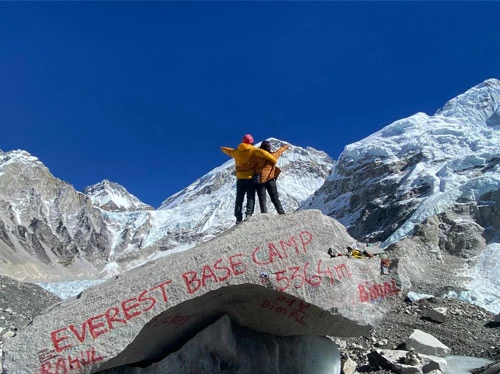
Everest Base Camp Trek Deals 2024-15 Days
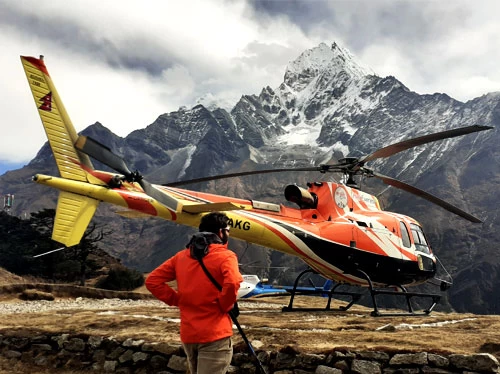
Everest Base Camp Luxury Trek Cost 2024-2025
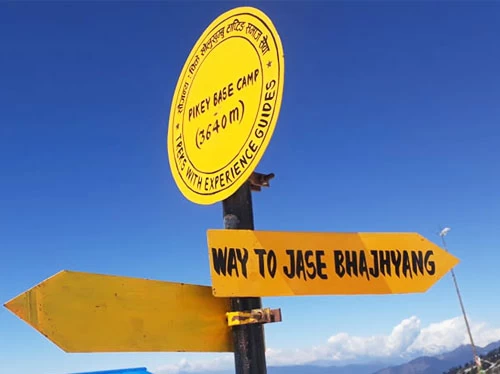
Short Pikey Peak Trek Cost 2024
Send an inquiry.
We use cookies to ensure that we give you the best experience on our website.
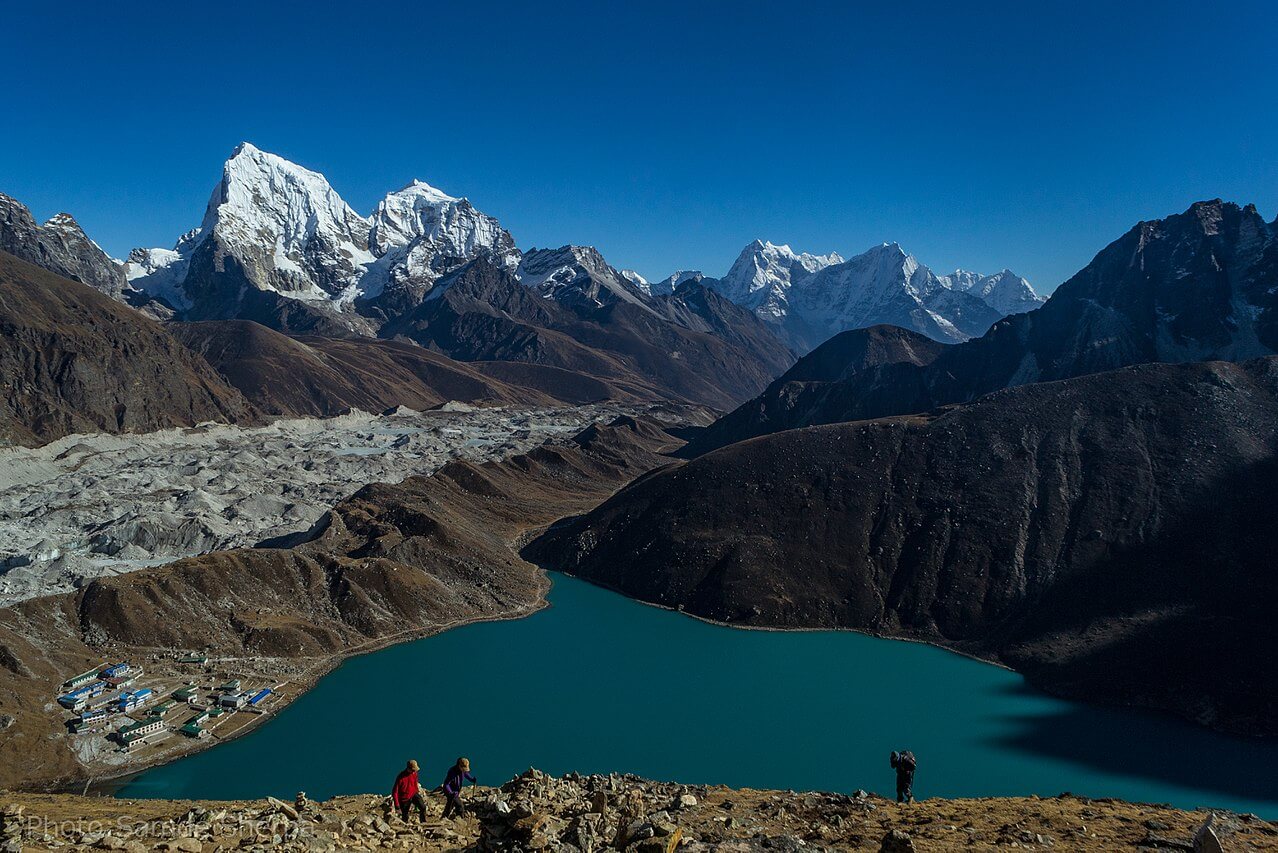
Gokyo Ri Trek
Gokyo Ri Trek, the best alternative trail to the Everest Base Camp Trek , offers exceptional views of the Himalayan peaks along with lakes and glaciers.
Gokyo Ri Trek is a moderate trek in the high Himalayas of the Everest region. Instead of traveling to the more commercial Everest Trek, trekkers often choose this itinerary to enjoy the less crowded trails. It is an excellent choice for both experienced trekkers as well as novice travelers.
The summit of Gokyo Ri offers panoramic mountain views, including four 8,000m peaks — Mt. Everest, Lhotse, Cho Oyu, and Makalu. Many argue the view from the top of this vantage point is far better than that from the famous Kala Patthar.
Gokyo Ri Trek begins with a scenic flight from Kathmandu to Lukla, one of the most extreme airports in the world. The trail traverses through famous Sherpa villages like Phakding, Namche, and Dole, all the way up to Gokyo Valley. If you have a few additional days, you can also extend Gokyo Ri Trek with the classic Everest Base Camp Trek.
Table of Content
Highlights of Gokyo Ri Trek
- Embark the adventure with a scenic flight to Lukla airport.
- Traverse through the off-the-beaten and less crowded trails in the Everest region.
- Hike to the vantage point of Gokyo Ri (5,357m) for a panoramic view of Everest, Lhotse, and Cho Oyu.
- Stand in the shore of turquoise Gokyo Lakes and relish its pristine ambiance.
- Trek through the famous Sherpa center, Namche Bazaar.
Gokyo Ri Trek Facts
Getting there and away.
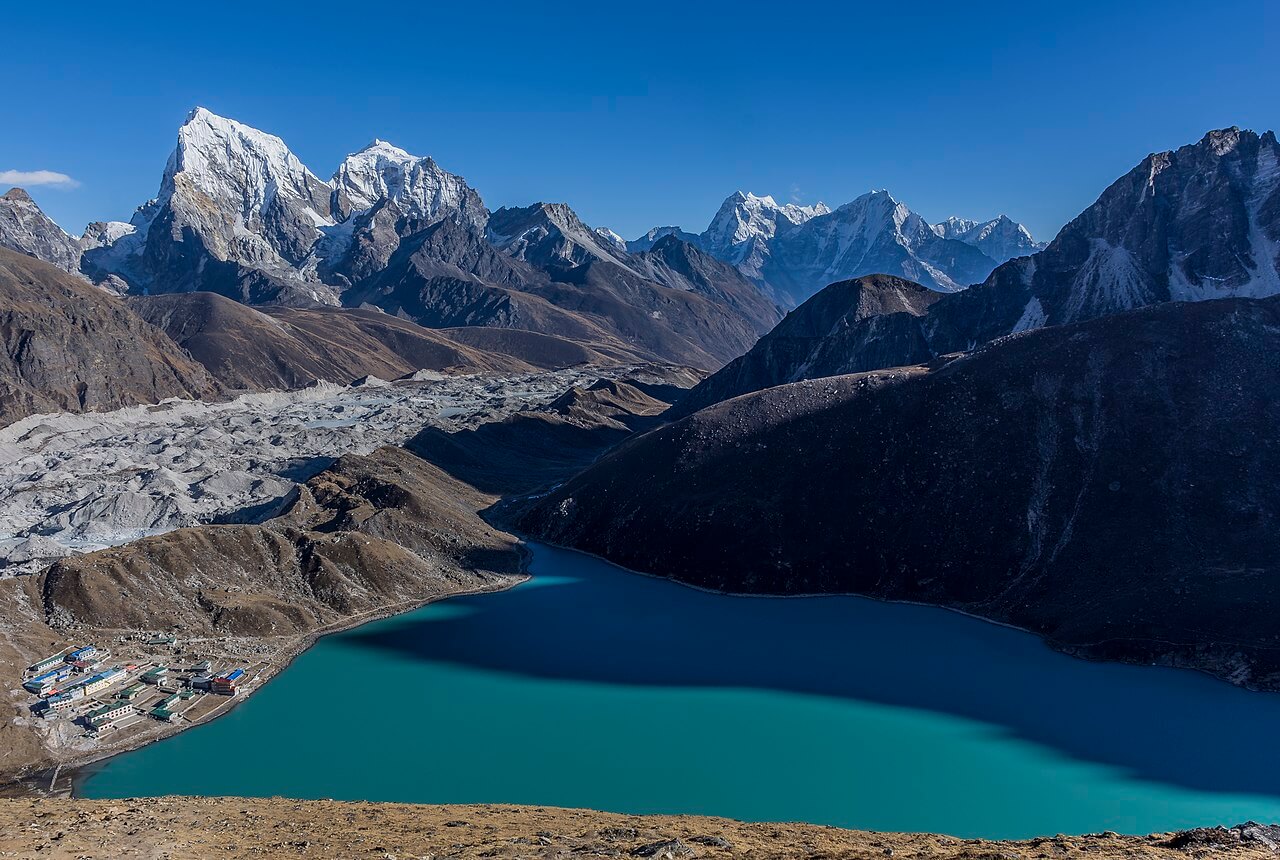
Start of the Trek:
The most common method to begin the adventure of Gokyo Ri is by flight to a small town of Lukla. At an elevation of 2,800m, Lukla airport is one of the most extreme airports in the world. This exhilarating flight from Kathmandu to Lukla takes about 35-40 minutes.
In peak seasons, the airport becomes extremely busy with several flights operating back and forth. However, it is noted that unpredictable weather conditions may lead to flight delays. In worse situations, flight cancellation is quite common in Lukla. So, while booking a flight to Lukla, it is recommended to book first flights in the morning.
If you want to avoid the uncertainty of Lukla flights, the best alternative is to take the helicopter charter from Kathmandu. However, the chopper option is very costlier than regular flights.
Another alternative to escaping the Lukla flight is to drive to Jiri from Kathmandu and trek overland to Lukla or Phakding. It takes roughly 8 hours to drive to Jiri and a week to reach Lukla. Keep in mind that if you take this route to Gokyo Ri, you need to acquire an additional permit for Gaurishankar Conservation Area Project (GCAP).
End of the Trek:
Gokyo Ri Trek starts and ends at Lukla, retracing your route back to Kathmandu once you finish the trek. The most obvious way to get back to Kathmandu is by flight from Lukla. However, you can also take a helicopter option for convenience.
11 Days Gokyo Ri Trek Outline Itinerary
Gokyo ri trek detailed 11 days itinerary, day 1: fly from kathmandu (1,400m) to lukla (2,800m) and trek to phakding (2,652m) – 3 to 4 hours.
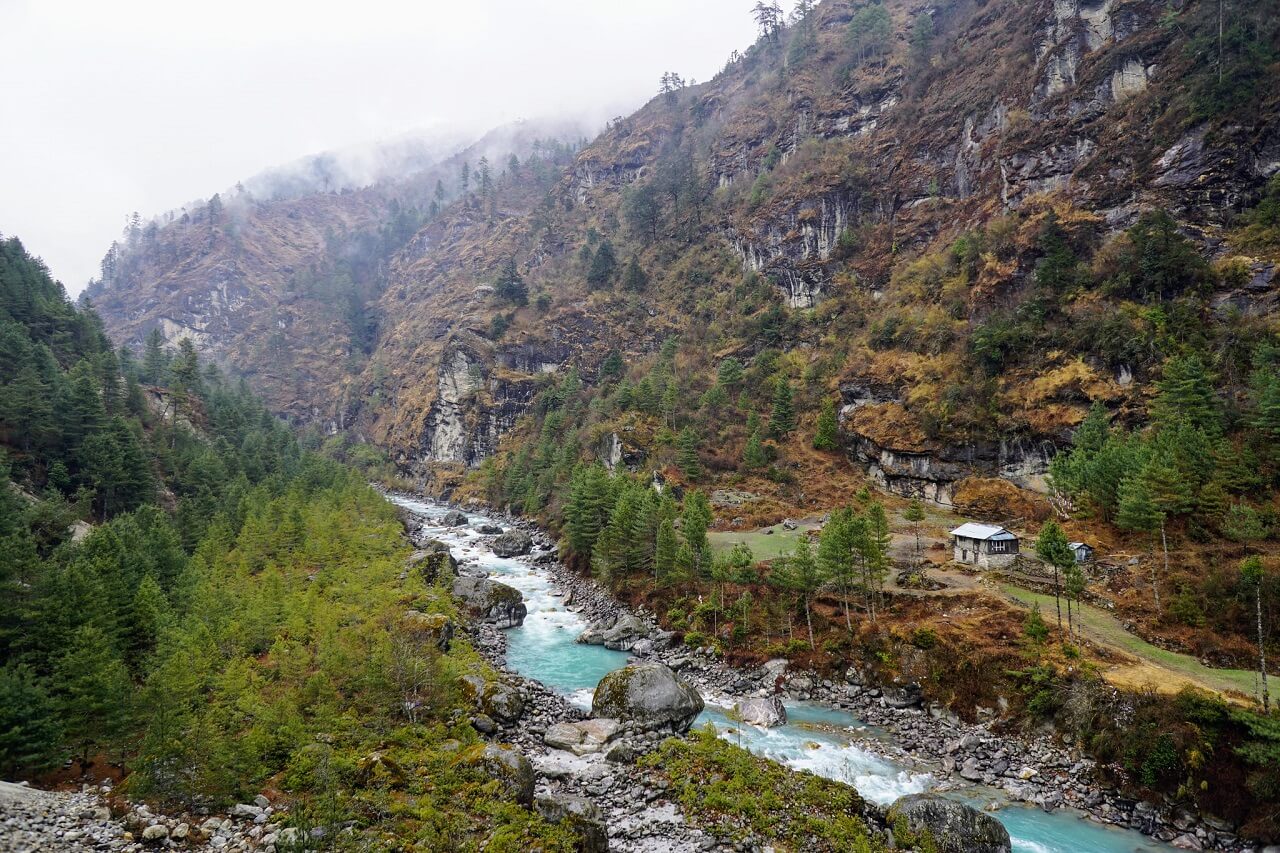
The thrilling adventure of Gokyo Ri begins with a 40-minute flight from Kathmandu to Tenzing-Hillary Airport, Lukla. Since most of aerial trips to this town take place early in the morning, you’ll have plenty of time for yourself. Take advantage of the time and trek to the small village of Phakding instead.
The trail to Phakding is short and gentle through the valleys until you reach the Dudh Koshi River. You’ll come across several suspension bridges, chortens, Mani walls, and prayer flags. It takes approximately 3 to 4 hours to reach Phakding.
Day 2: Trek from Phakding (2,652m) to Namche Bazaar (3,440m) – 5 to 6 hours

You start the day with a pleasant walk alongside the Dudh Koshi River towards Monjo. The route traverses through the shades of rhododendron and magnolia trees.
You enter through the Sagarmatha National Park gate at Monjo. Before you check-in to the National Park, you’ll have to show your TIMS Card and permit in the checkpoint. As you walk further into the village, the views of the mountains begin to unfold on the faraway horizon.
After crossing the Hillary Suspension Bridge over the Dudh Koshi River, the route is slightly strenuous with a steep uphill to Namche Bazaar.
Day 3: Acclimatization Day at Namche Bazaar (3,440m)
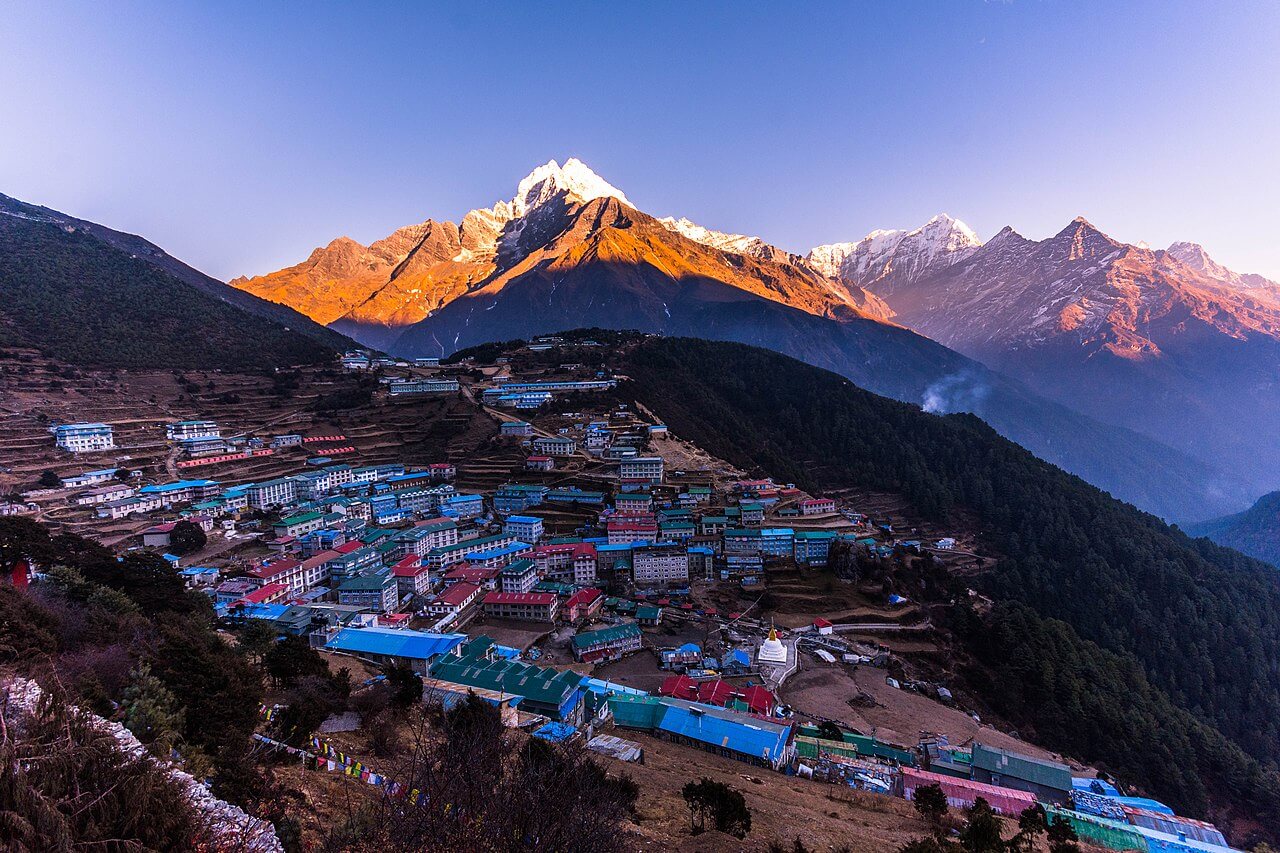
A much-needed rest day at Namche Bazaar is acclimatizing in the higher elevation. Namche Bazaar represents a historic trading hub with colorful markets, ancient culture, and lively ambiance.
Stroll around the prosperous Sherpa town of Namche or hike over the ridge towards Hotel Everest View to enjoy the breathtaking sceneries of mountains. If time permits, you can also walk to a nearby village of Khumjung and visit the ancient monastery.
Day 4: Trek from Namche Bazaar (3,440m) to Dole (3,680m) – 5 to 6 hours
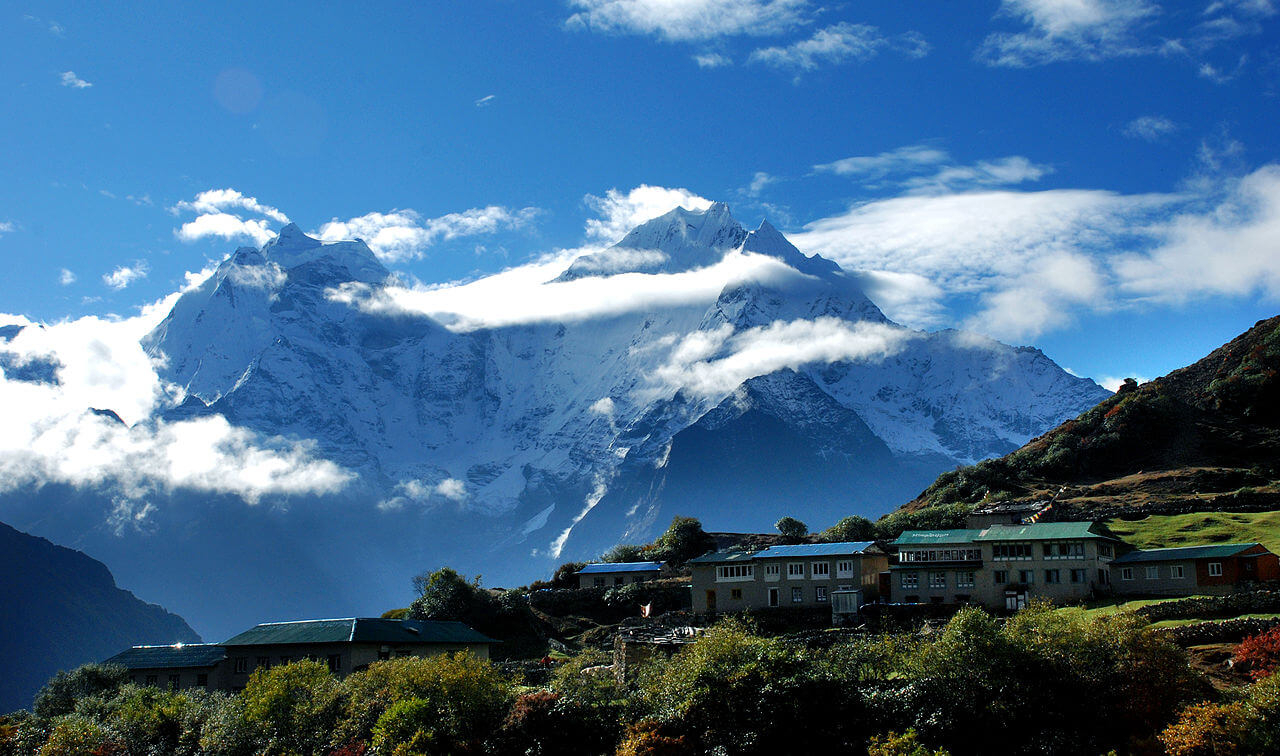
The trek day begins with a gentle climb to Kyangjuma village. The village rewards you the marvelous spectacles of Ama Dablam, Thamserku, and Kangtega. Then, the trail leads to the steeper section before reaching a small settlement at Mong La.
On your lucky day, it is quite common for you to spot animals like mountain goats and musk deer on this trail. You’ll reach Dole in about 5 to 6 hours from Namche Bazaar.
Day 5: Trek from Dole (3,680m) to Machhermo (4,470m) – 4 hours
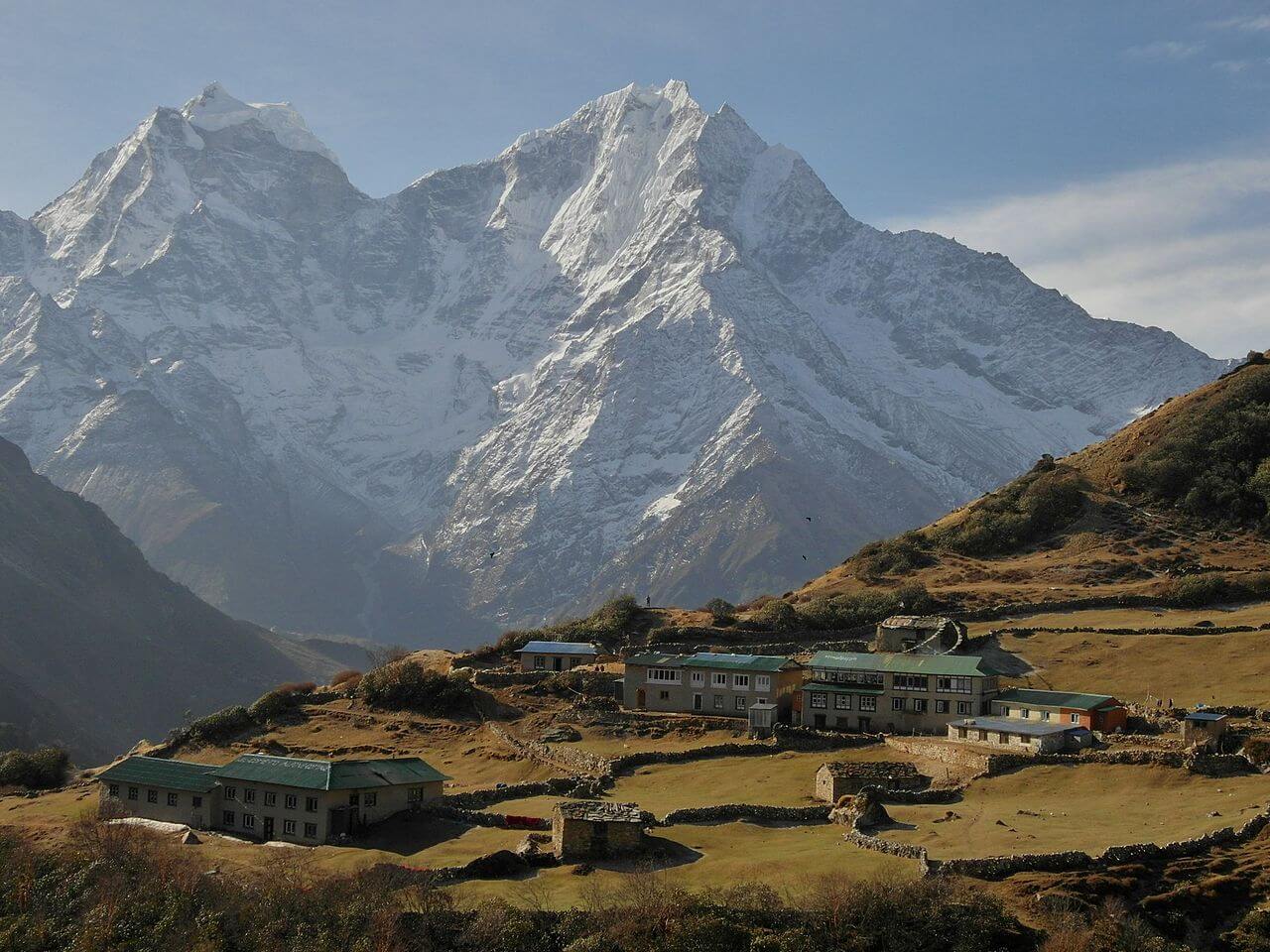
On this day, you resume the trek with a steep ascent through the ridge just above Dole. Thorny bushes surround the path as it leads to the beautiful hamlet of Luza via Lhabarma. Significantly, the fascinating vistas of Cho Oyu, Kantega, and Thamserku embellish the backdrop throughout the day. Walking through the hills above the raging Dudh Koshi, you’ll reach Marchhermo in approximately 4 hours.
Day 6: Trek from Machhermo (4,470m) to Gokyo Valley (4,800m) – 4 hours
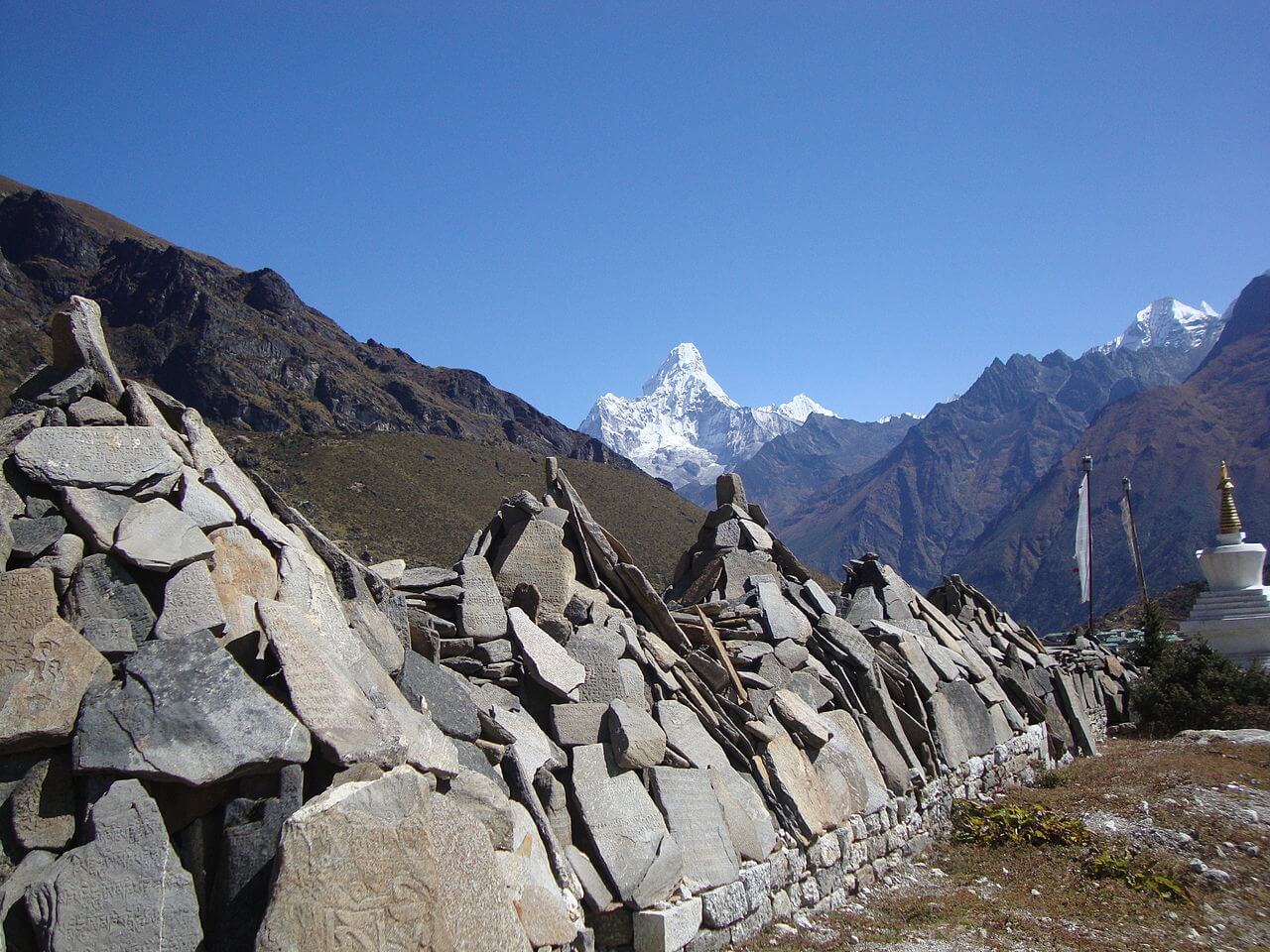
You climb the ridge above Macchermo to relish the beautiful sight of the mountains and the valley. The trail descends to the riverbanks and then climbs up through the terminal moraine of Ngozumpa Glacier, the Himalayas’ longest glacier.
As you walk past the challenging path of the moraine, you’ll reach the first lake of Gokyo, known as Longpongo. The second lake, Taboche Tsho, is situated slightly ahead of the first one. Furthermore, the third lake glittering with sunlight lies a little ahead of the second lake.
The Gokyo valley stands on the shore of the third lake with Cho Oyu looming magnificently in the backdrop.
Day 7: Excursion to Gokyo Ri (5,357m) and back to Gokyo Valley (4,800m) – 4 hours
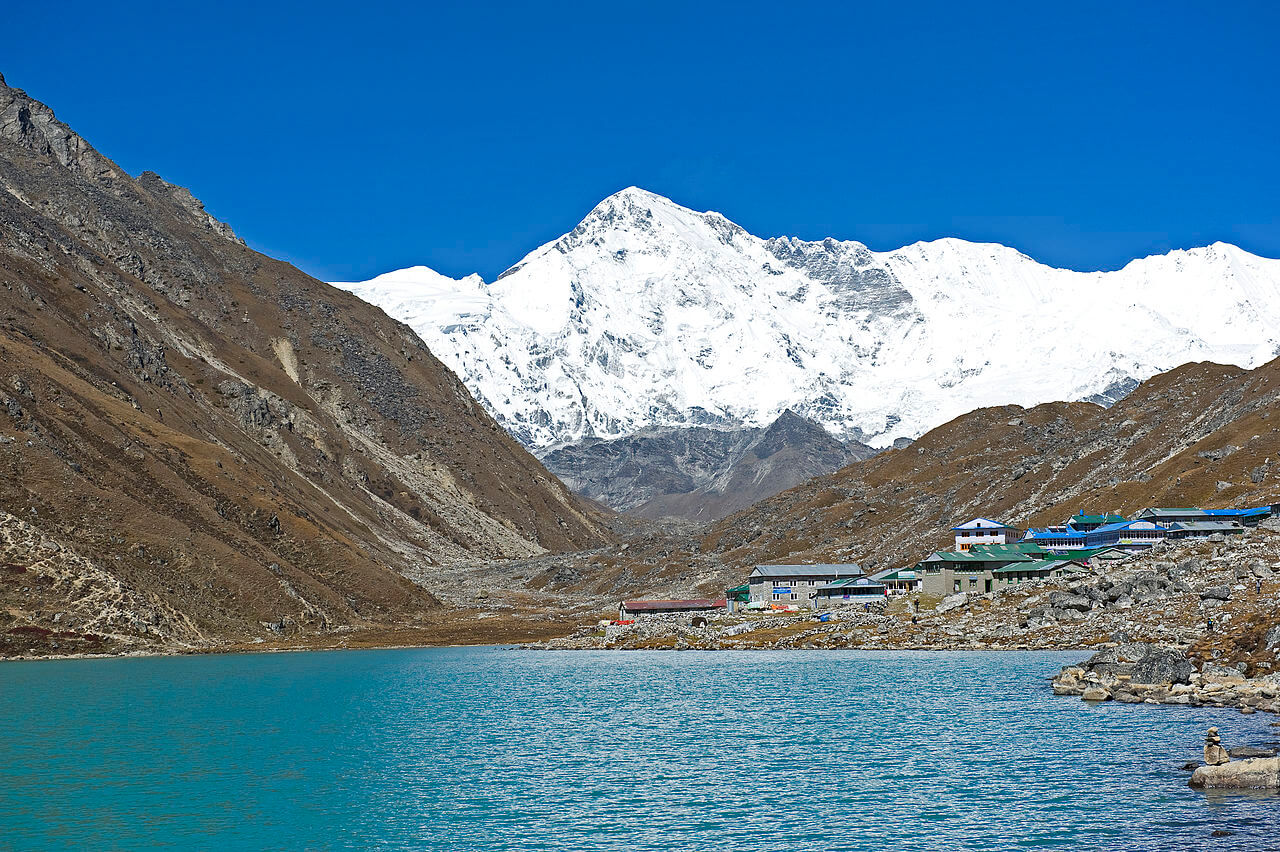
This day marks the major highlights of the entire trek. On this day, you’ll hike to the vantage point of Gokyo Ri at an elevation of 5,357 meters. The climb to the viewpoint is strenuous and takes 3 to 4 hours to reach the top.
Relish the panoramic spectacles of mountains like Everest, Nuptse, Thamserku, Makalu, Lhotse, and Pumori from the top. The exhilarating views of Gokyo lakes and Ngozumba glaciers will surpass your expectations.
You’ll retrace your route back to Gokyo Valley for the night.
Day 8: Trek from Gokyo Valley (4,800m) to Dole (3,680m) – 6 to 7 hours
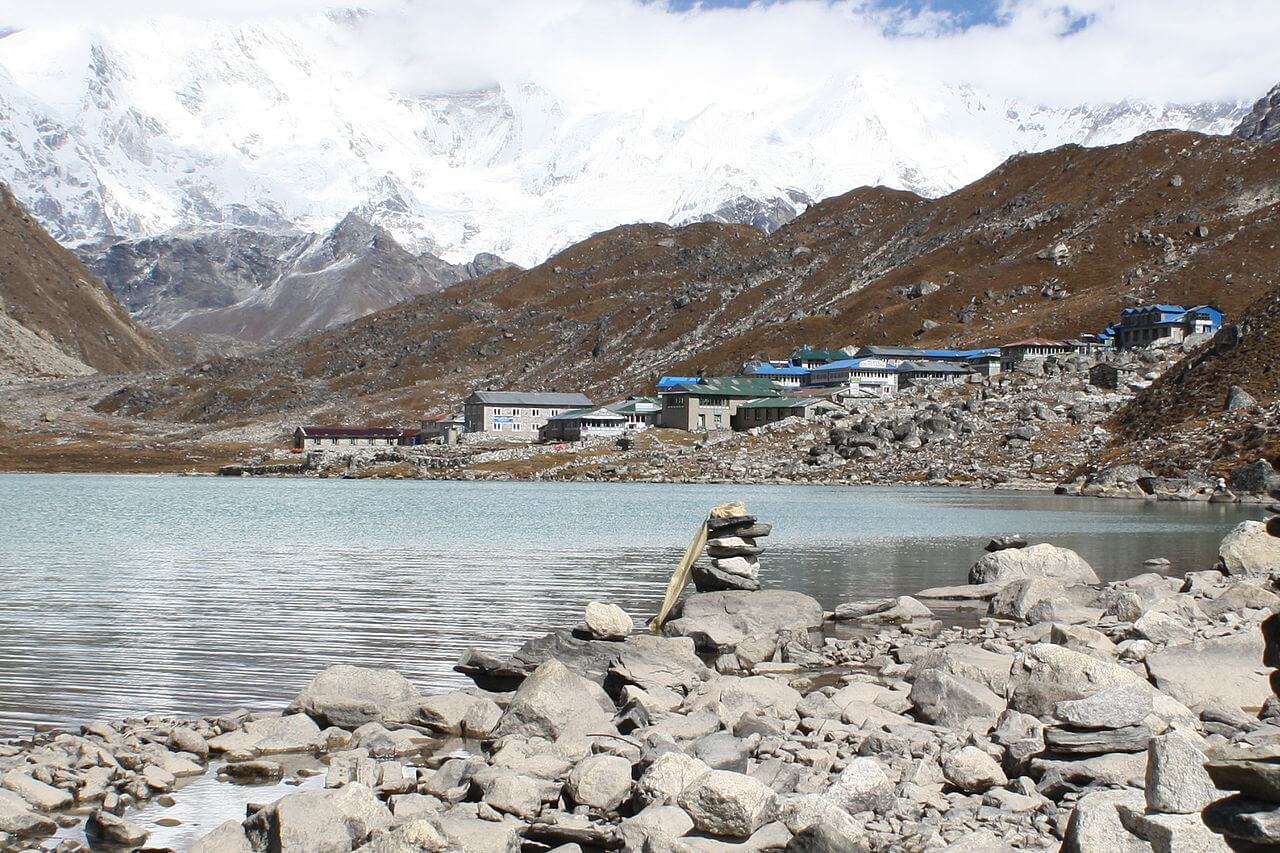
The day begins retracing the exact route departing from the lakes and through the moraines of Ngozumba glaciers. You’ll come across several stone chortens along the way. The splendid views of Thamserku and Kangtega will accompany you on the way down from Gokyo Valley. You’ll reach Dole in approximately 6 to 7 hours of walking.
Day 9: Trek from Dole (3,680m) to Namche Bazaar (3,440m) – 5 to 6 hours
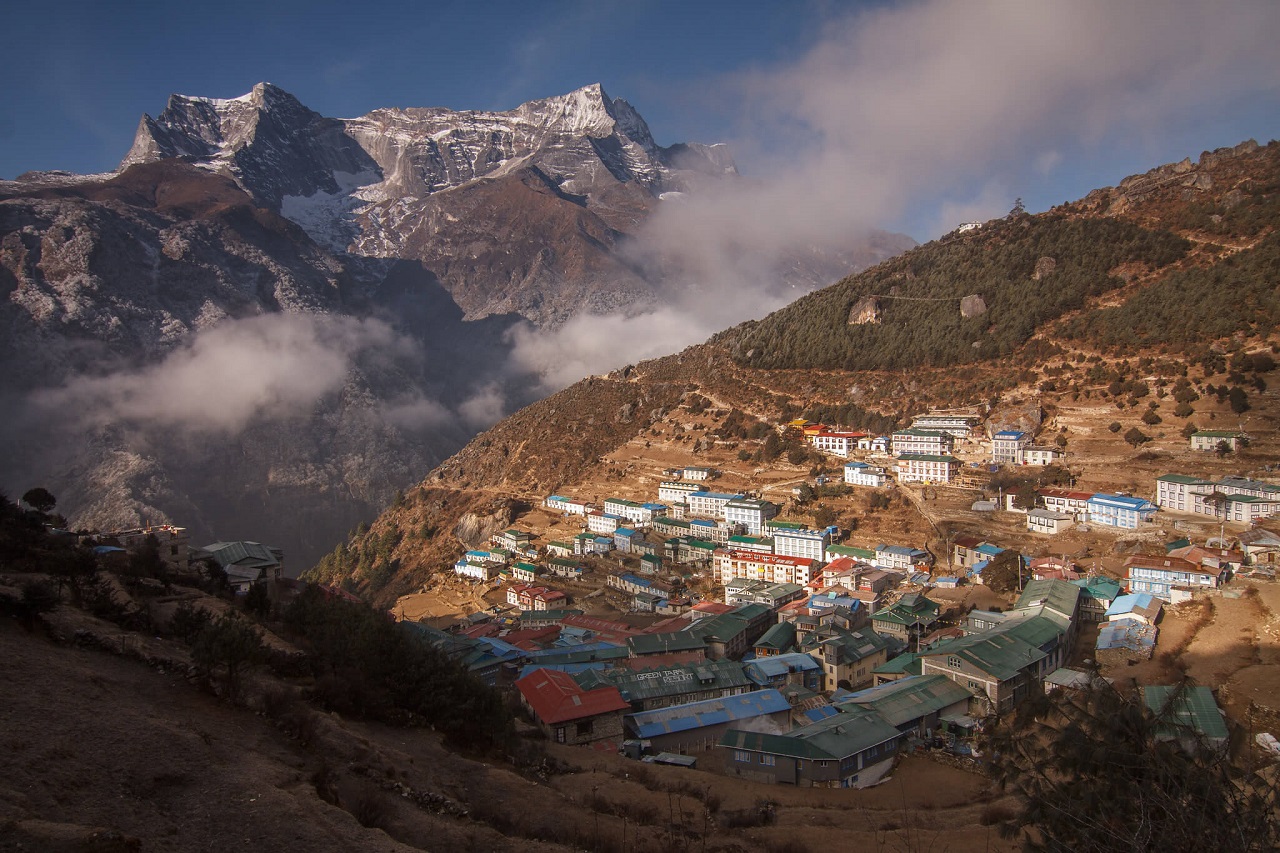
The day begins with a steep downhill toward Phortse Tenga. It takes approximately ONE and a half hours to reach Phortse Tenga from Dole. Then, the trail ascends steeply from Phortse Tenga up to the village of Mongla.
Furthermore, the trail descends towards Kyangjuma before reaching the Sherpa Capital at Namche Bazaar. It takes approximately 5 to 6 hours of gentle walk from Dole to Namche Bazaar.
Day 10: Trek from Namche Bazaar (3,440m) to Lukla (2,800m) – 7 to 8 hours
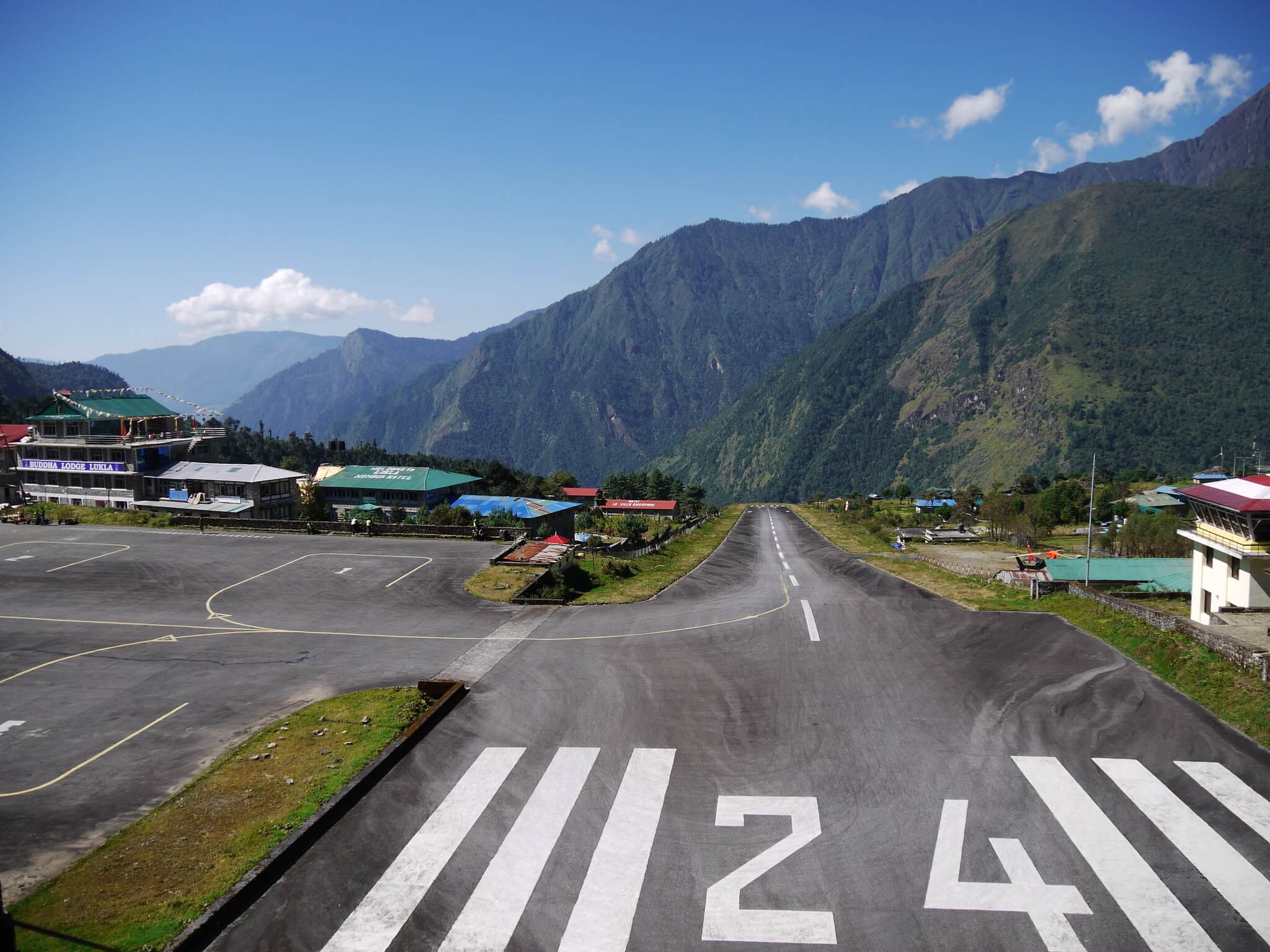
On this day, you retrace the route back to Lukla from Namche Bazaar. The trail descends through the shades of pine trees. Walking alongside the Dudh Koshi River and crossing the suspension bridges over the river several times, you’ll reach Phakding.
After Phakding village, the walk is gentle and enjoyable till you reach Lukla.
Day 11: Fly from Lukla (2,800m) to Kathmandu (1,400m) – 40 minutes
Final day in the mountains. You’ll take an early morning flight from Lukla airport to Kathmandu. It takes about 35 to 40 minutes to reach Kathmandu airport.
Gokyo Ri with Everest Base Camp
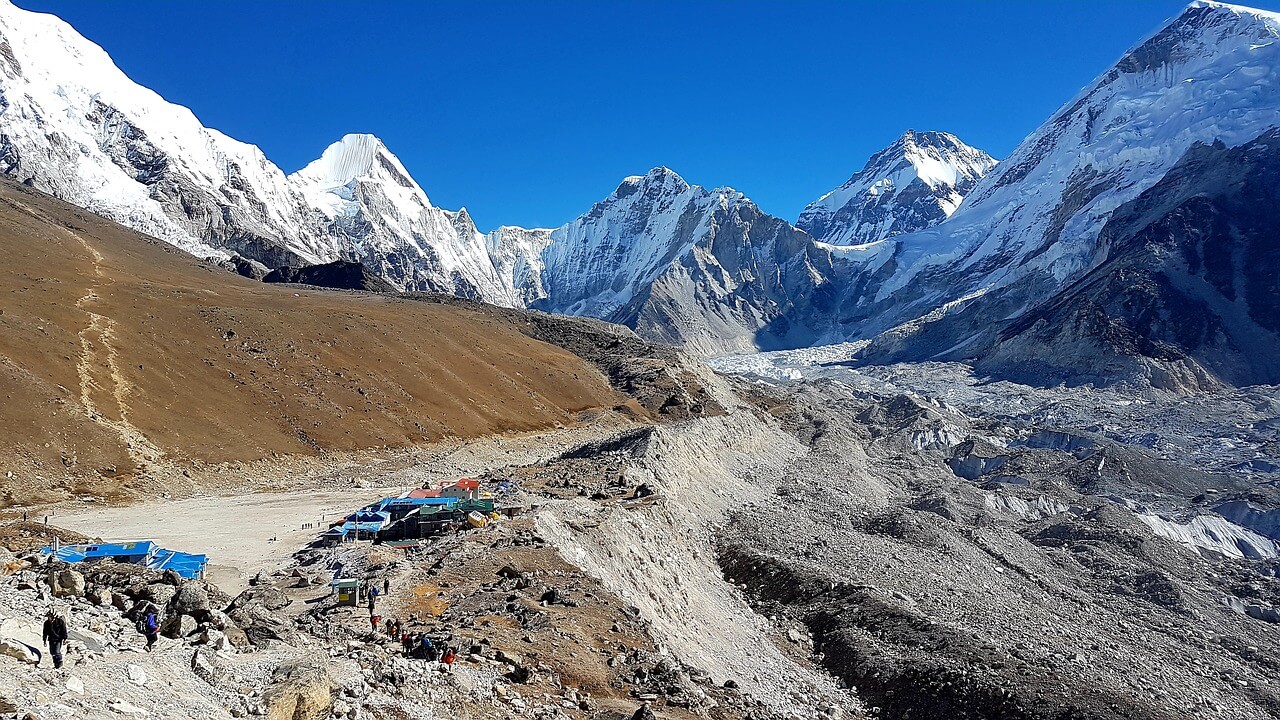
If you have a few additional days, you can combine Gokyo Ri Trek with the Everest Base Camp. Crossing the Cho La Pass over the Gokyo valley, the route of Gokyo connects with Everest Base Camp.
This trek is slightly technical compared to most of the treks in Nepal . It takes you through two of the best viewpoints in the Everest region — Gokyo Ri and Kala Patthar. It takes 14 days to complete the entire trek.
Gokyo Ri with Renjo La Pass
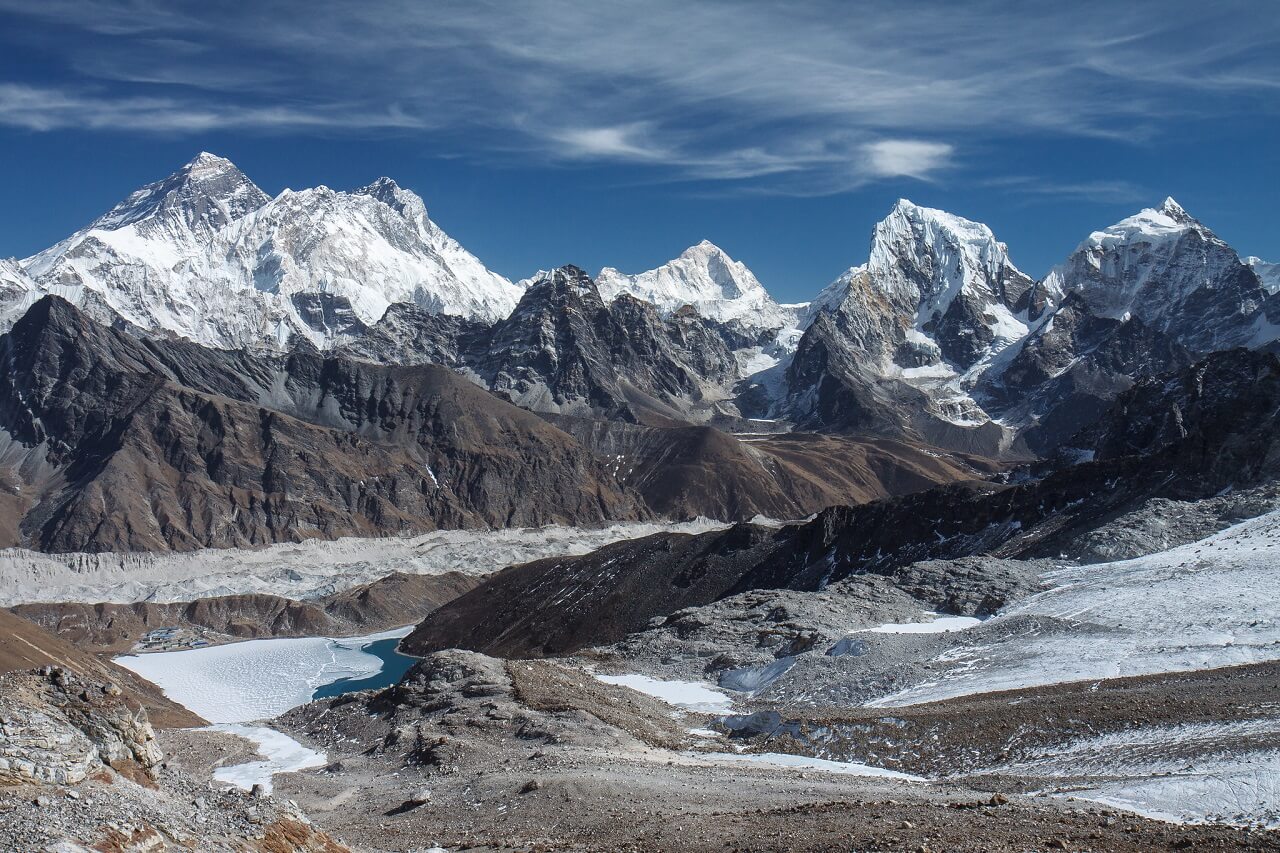
Instead of retracing the same route back to Namche Bazaar, you can cross over Renjo La Pass, west to Gokyo valley and finally descend to Namche Bazaar via Thame. This trail is remote and far less trodden in the Khumbu region.
Traveling via this itinerary means you’ll have the opportunity to cross one of the significant high passes of the Everest region at Renjo La Pass.
Jiri to Gokyo Trek
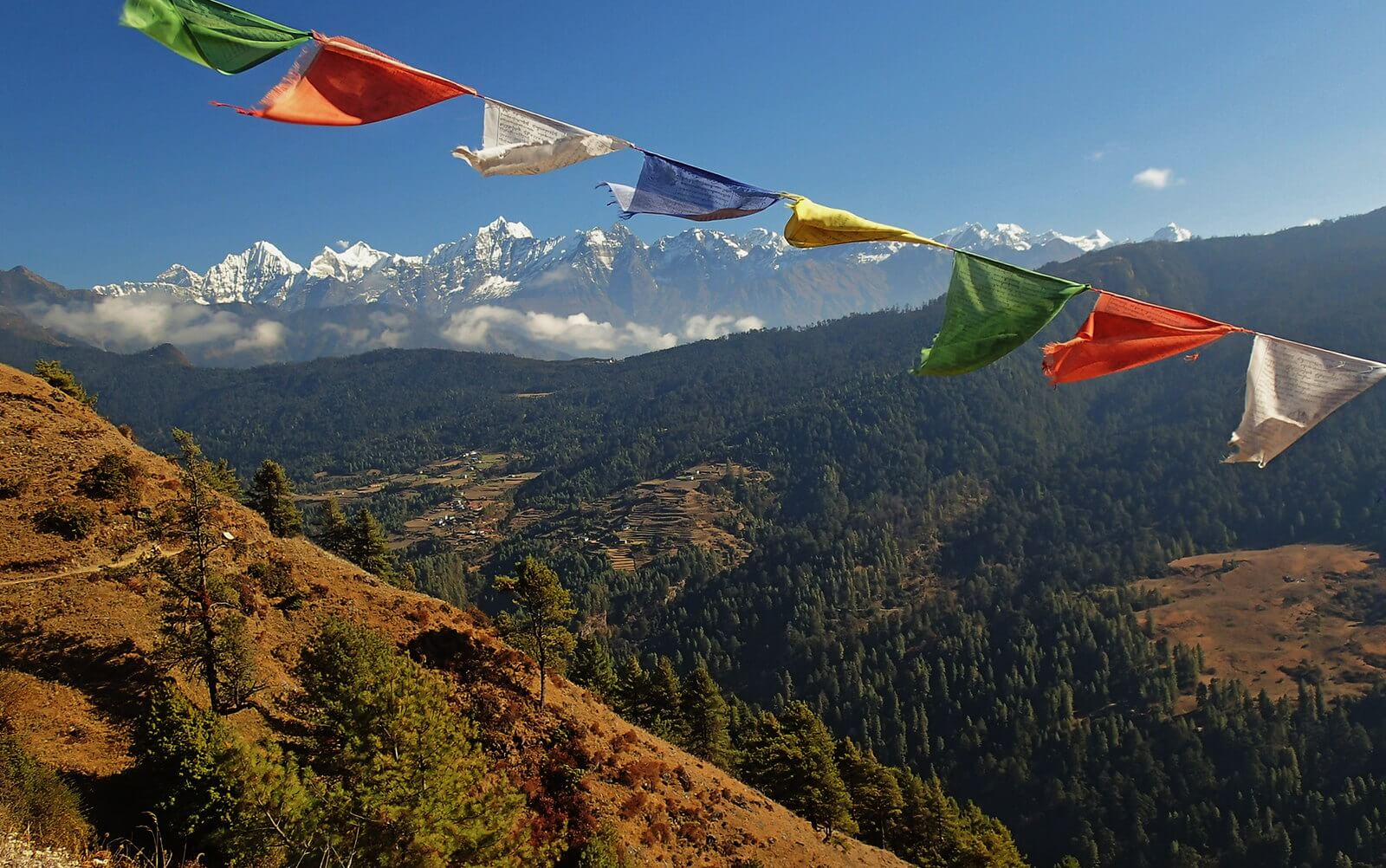
Starting the trek from Jiri is the oldest route option to the Everest region. This adventure begins with a 7, 8-hour drive from Kathmandu to Jiri and connects to the trail of Gokyo Ri at Phakding village. It takes EIGHT days on foot to reach Phakding from Jiri.
This trek starts from the lowlands of the Solu region at 1,950 meters at Jiri to the highlands of Khumbu region, all the way up to 5,357 meters at Gokyo Ri. The trail passes through enchanting forests, countrysides, and several monasteries en-route to Phakding.
Best Time to Trek Gokyo Ri
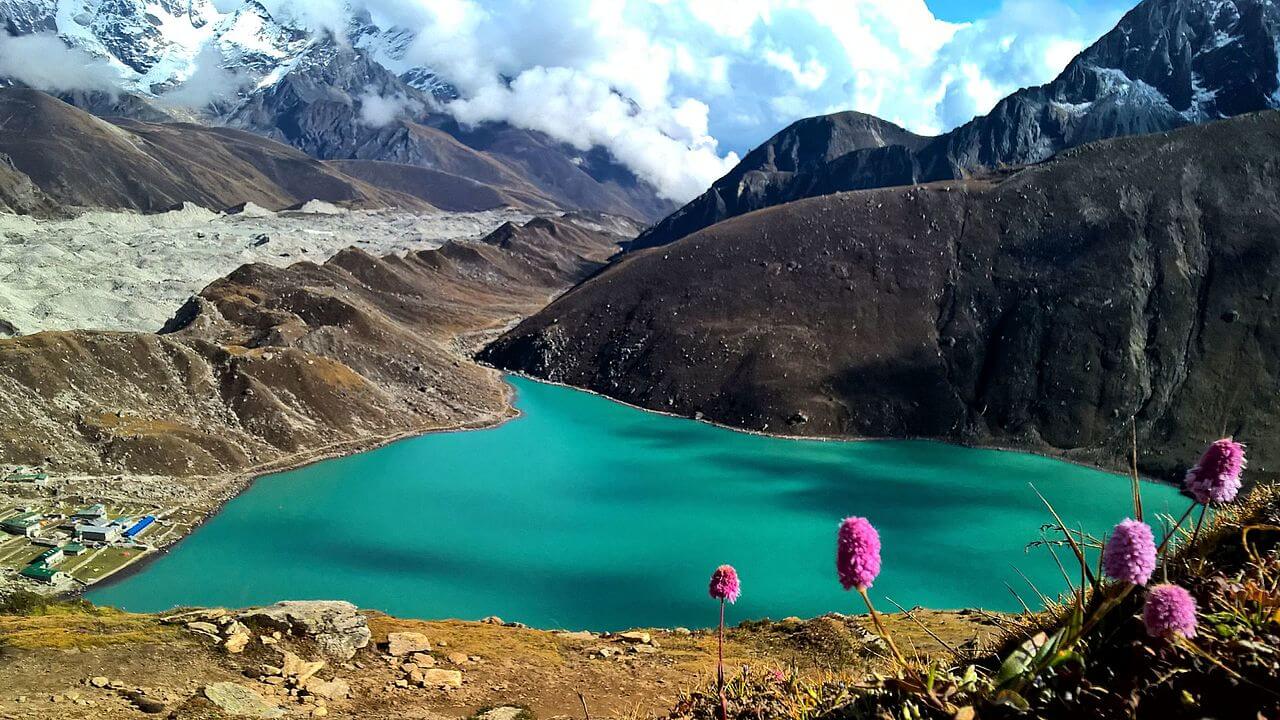
Autumn (September to November) and Spring (March to May) is by far the most favorable time to trek in Nepal, and Gokyo Ri Trek is no exception. Weather conditions in Autumn and Spring are moderately warm and stable; excellent for trekking. The skies also tend to stay clear in these seasons, offering the breathtaking spectacles of the mountains.
During the Autumn season, the average temperature of Nepal ranges from 16 to 24 degrees Celsius. Similarly, in Spring, the average temperature ranges from 15 to 23 degrees Celsius in Nepal.
During the Winter (December to February) season, snow covers the trail massively. In extreme conditions, excessive snow may even block the route. If you travel in late February or early March, the turquoise lakes of Gokyo can be completely frozen. However, the trail in the winter season can be tricky and challenging to walk.
Unlike most of the treks in Nepal, Gokyo Ri is not a year-long trekking destination. During the Monsoon (June to August), the trails are wet and slippery, so it is not advisable to trek during this period of the year.
Here’s a table with average temperature and rainfall details throughout the year for locations en-route to Gokyo Ri:
Gokyo Ri Trek Difficulty
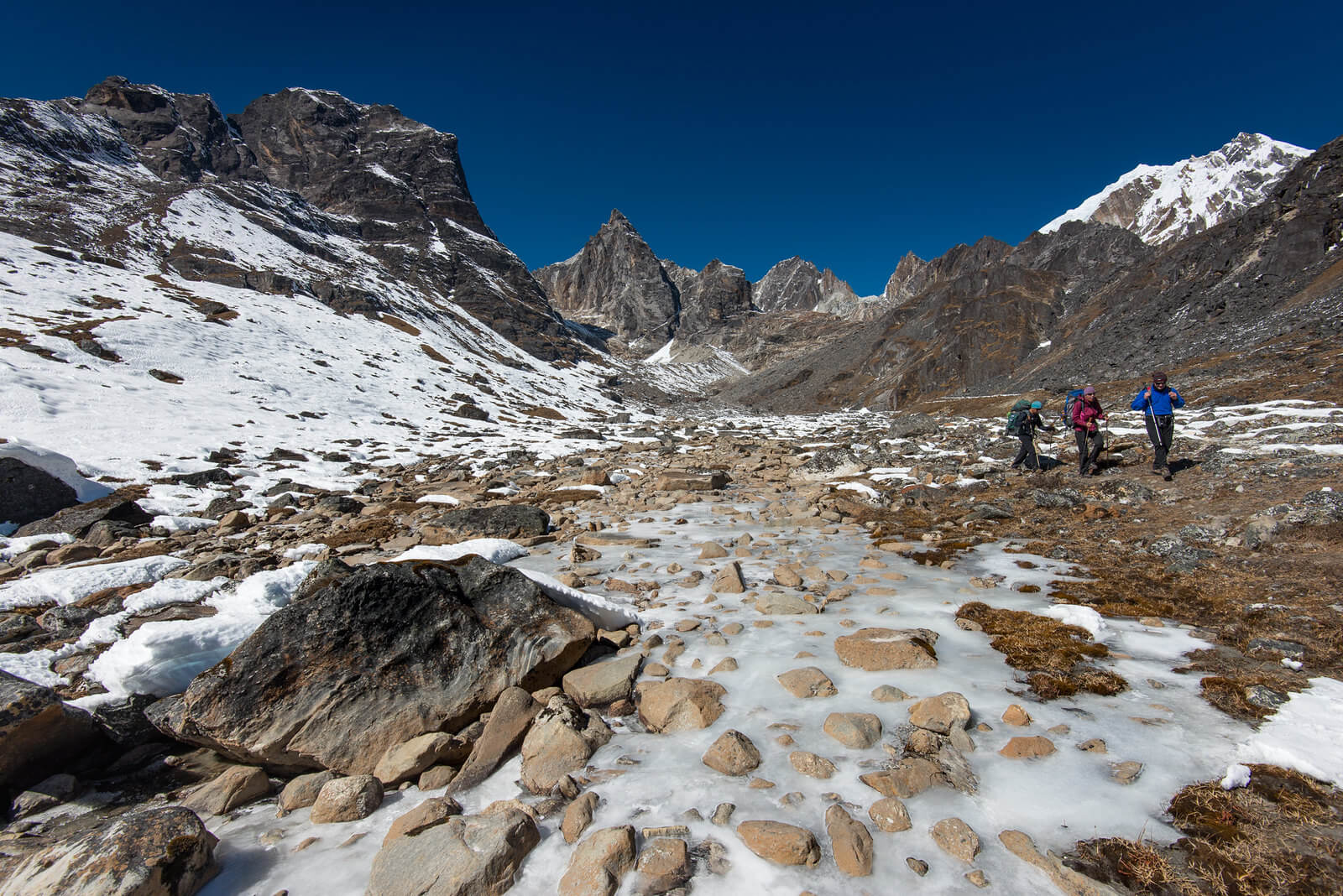
Gokyo Ri Trek is moderate in difficulty, without any requirement of technical skills. For this particular itinerary, the entire trek takes 10 days of walking from Lukla to Gokyo Ri and back.
You’ll have to walk 5 to 6 hours daily on average in the trek. Although this route is less traveled compared to Everest Base Camp, the trail is easily navigable with signposts throughout the trek.
Altitude is the most significant factor that you need to consider while trekking to Gokyo Ri. You’ll spend a few nights above 4,000m on this trek. It means the possibility of suffering from Acute Mountain Sickness (AMS) is higher. Therefore, it is highly advisable not to rush while walking on the upper reaches of the trek and stay cautious regarding the elevation.
Another factor you need to keep in mind on this trek is the weather. The weather in the mountains is unpredictable and likely to change. Therefore, we recommend you to prepare for the harsh weather. Even during Autumn or Spring, though rainfalls and cold weather are less of a concern, always carry a waterproof jacket, sleeping bag, and a down jacket to avoid the risks of bad weather.
Although Gokyo Ri Trek is considered a moderate walk, it requires you to walk through steep uphills and downhills in the rough terrains of the Himalayas. Some of the trails in higher reaches are quite demanding. So, you must tackle these routes with proper preparations and decent physical fitness. Engage in cardio-oriented exercises like hiking, jogging, cycling, and swimming to prepare for the trek.
Gokyo Ri Trek Permit
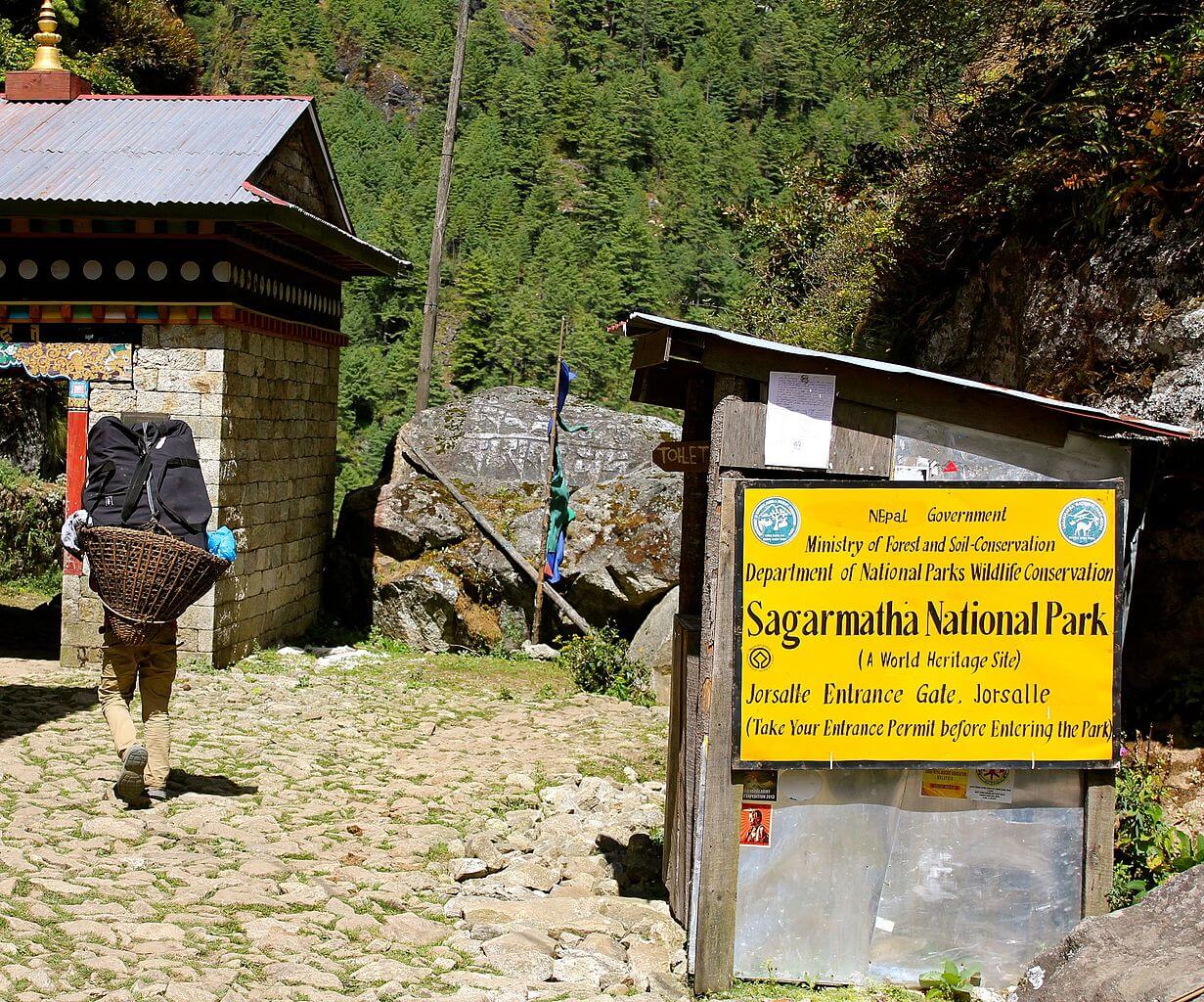
Since October 2018, the local government of the Khumbu region has imposed a new permit, replacing the TIMS Card. So, while trekking in the Khumbu region, you no longer require TIMS Card; instead, you need to acquire Khumbu Pasang Lhamu Rural Municipality Permit.
You cannot get this permit in Kathmandu. You can only acquire this permit from either Lukla or Monjo. The cost of Khumbu Pasang Lhamu Rural Municipality Permit is about US$ 18 per person.
Additionally, you need to hold the national park permit to enter the Sagarmatha National Park. You can get this permit either from Nepal Tourism Board in Kathmandu or directly from Monjo. The cost of Sagarmatha National Park Permit is US$ 27 per person.
If you want to embark on the Gokyo Ri Trek from the classic Jiri route, you also need to obtain Gaurishankar Conservation Area Project Permit (GCAP). The cost of the permit is US$ 27 per person and is available at Nepal Tourism Board, Kathmandu.
Remember, all the permit fees are payable in Nepalese currency only. So, make sure to exchange all your cash to local rupees before trekking in this region.
Insurance for the Trek
When it comes to trekking in the high Himalayas of Nepal, safety should always be a top priority of the travelers. Although Gokyo Ri Trek is considered as moderately challenging as of the experienced trekkers, it is not so easy as morning walks. At times, this trek goes hugely strenuous.
Additionally, the high altitude is always a threat. Even the most experienced trekkers can suffer from high altitude sickness. Therefore, proper travel insurance is essential while trekking in this region. Make sure to get a policy that comprises all the necessary charges, including helicopter evacuations, medical fees, trip cancellation, natural disasters, accidents, and even theft.
If you’re looking to buy proper travel insurance for Gokyo Ri Trek, we recommend you to buy it from World Nomads.
Guided VS Independent Trek
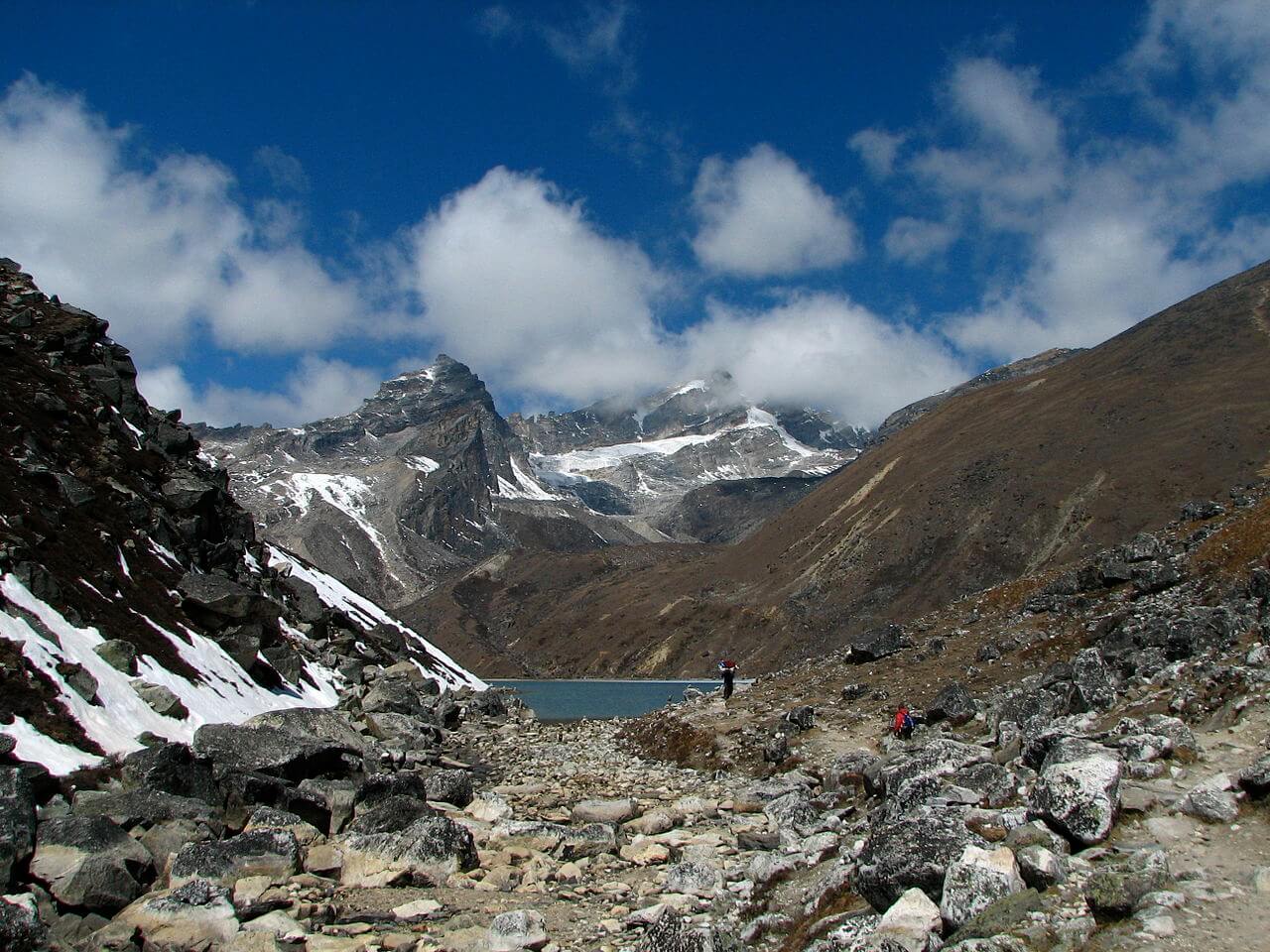
Independent Trek
The trails of Gokyo Ri is easily navigable as the entire trail is well-marked with signposts. Therefore, it is possible to trek here independently without hiring any guide and porter. If you choose to travel by yourself, you’ll have the flexibility of changing the plans as per your preference.
If you opt for trekking during the peak seasons, many travelers will accompany you throughout the trail. However, trekking independently means you’ll have to take care of all the hassles, including your backpacks, transportation, permits, and accommodations.
- Trekking independently is much cheaper than a guided trek.
- You’ll have the luxury to adjust your itineraries and plans as per your will.
- If you’re into photography, you can take as much time as you want to capture the picture-perfect sceneries.
- Traveling without a guide means more adventure and fun as you’ll be dealing with all the logistics.
- Trekking in high elevation on your own can be risky, as the situations can be unforeseeable in the Himalayas.
- At times, handling all the logistics by yourself can be hectic.
- In case you get into any trouble, you will not have anyone to assist you on the trail.
Guided Trek
While trekking above 5,000 meters, it is more advisable to travel with a licensed guide. If you choose to go on a guided trip, the guide will be responsible for arranging the accommodations, permits, and transportation.
On a guided trek, the guide handles all the logistics but in turn, restricts a certain amount of freedom to travel. But in case you get into any unforeseeable situations, the guide will assist you the entire time.
- It saves you an abundance of time and energy for planning the entire trip.
- Having a guide in the mountains is comfortable and safe.
- You’ll get the in-depth knowledge of the destination while trekking with a guide.
- In case of difficult situations, they provide experienced assistance.
- Hiring a guide is more expensive.
- With guides assisting you throughout the trek, guided trips are slightly less adventurous.
- You’ll be bound to follow the itinerary as per the guide.
Accommodation and Food
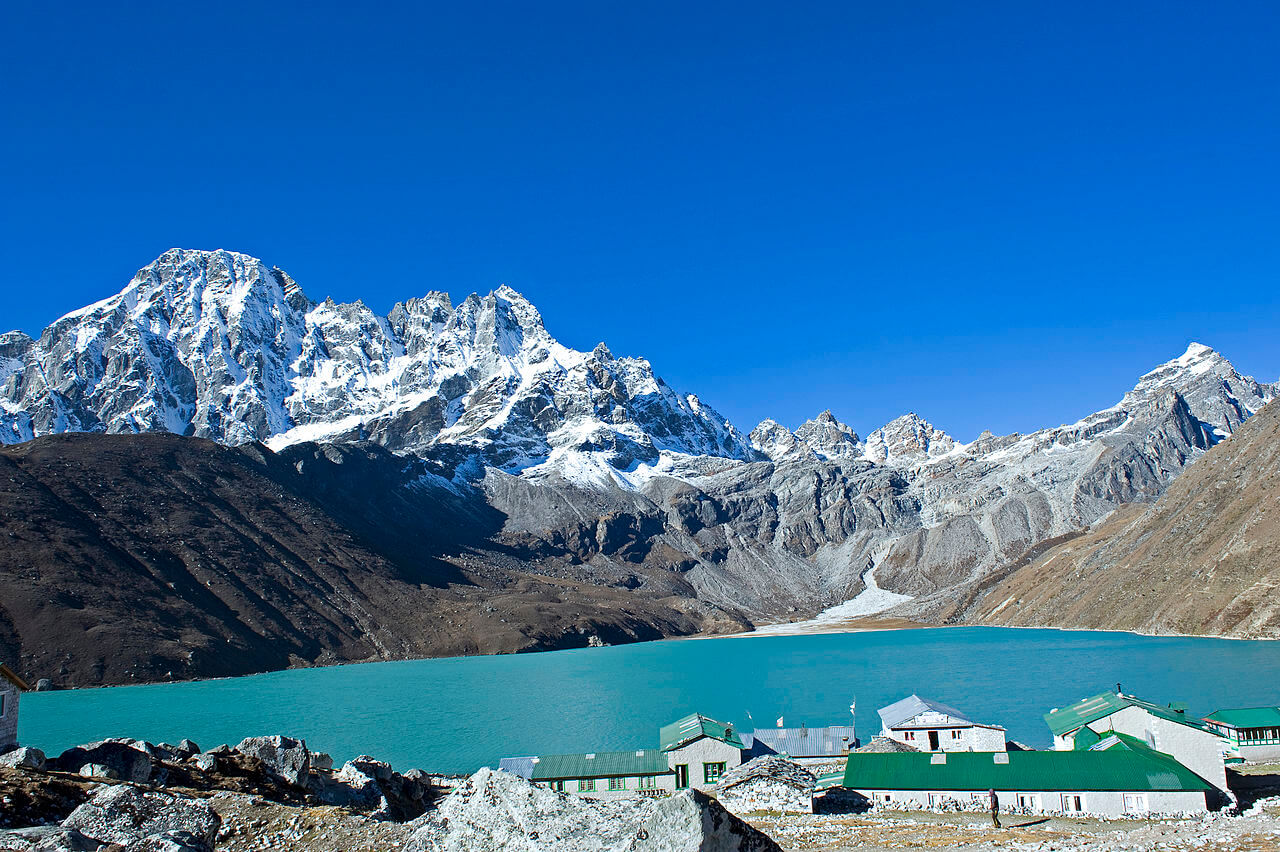
Like elsewhere in the Khumbu region, most of the teahouses in Gokyo Ri Trek are relatively comfortable and well-developed. From cheap hotels with necessary amenities to luxurious hotels with hot showers and electric blankets, there are plenty of teahouses in Gokyo Ri.
Most of the teahouses, although not luxurious, will provide the necessary facilities like rooms, food, charging facilities, WiFi, and a hot shower. The rooms offer twin beds, a thin mattress, a cushion, and a pair of bedsheets. Attached bathrooms are not available in most of the teahouses. Keep in mind that if you want to use amenities like WiFi, charging facilities, and a hot shower, the teahouse will charge you extra money for it!
The teahouses of Gokyo Ri serve both Nepali foods as well as western cuisines on their menu. Although the food choices are limited, the portion of the meal is quite substantial. Dal Bhat is the most preferred meal in the Himalayas along with pancakes, Tibetan bread, and soups. They also serve tea and coffee to keep you warm.
Gokyo Ri Trek Cost
On average, the total cost of the trek is around US$ 1,500 to 2,000 per person. Keep in mind, the value of the trek may vary depending upon various factors like mode of transportation, route, and number of days.
If you are planning to travel independently, the cost of the trek decrease to US$ 500-1,000 per person.
Here’s the cost breakdown of the services just in case you’re planning to go backpacking in Gokyo Ri Trek instead of the guided trek:
Packing List for Gokyo Ri Trek
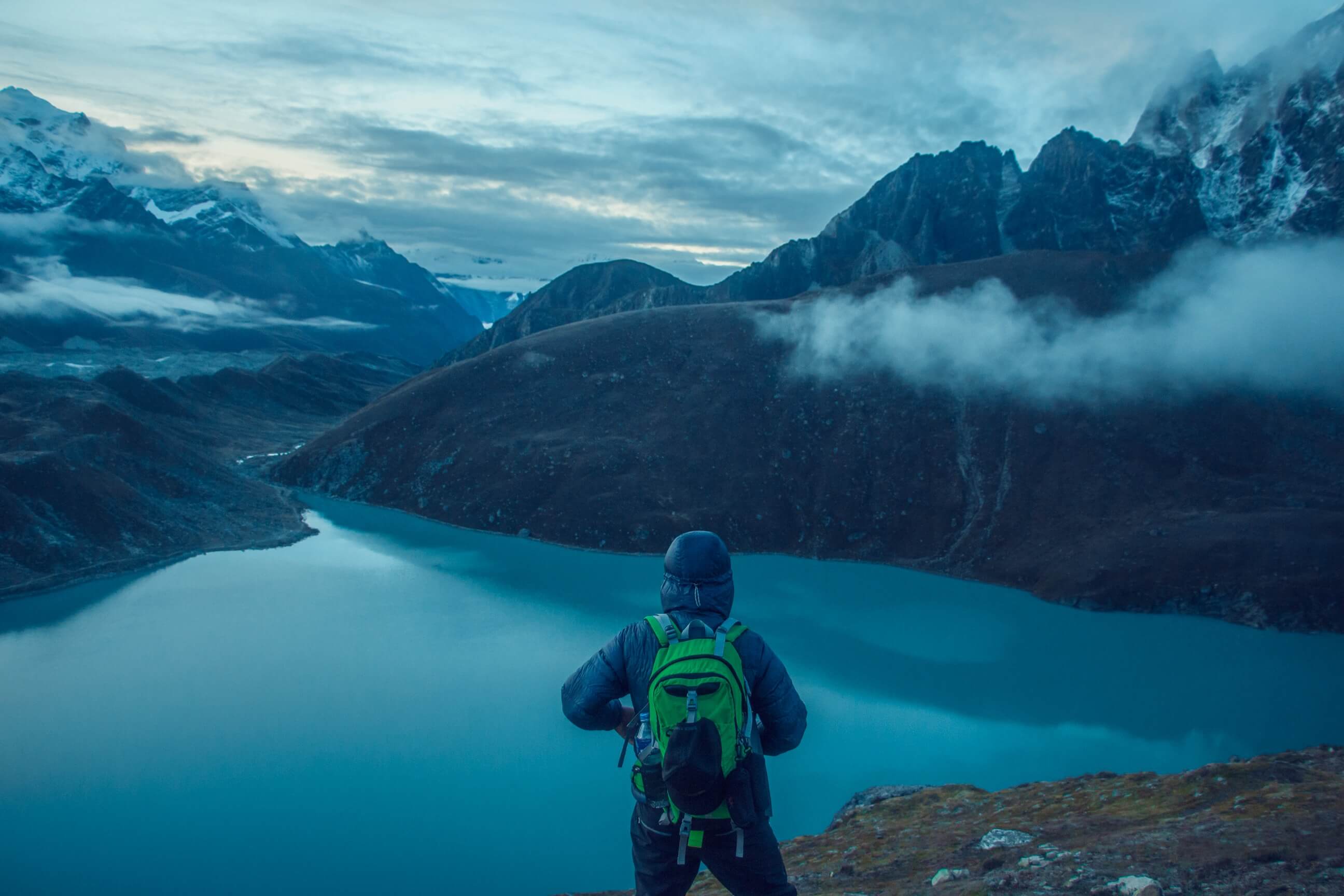
If you’re planning to trek to Gokyo Ri, here is the list of essential gears you need to pack:
- Duffel Bag – If you’re planning to join a guided trek with porters who will help you carry your stuff, bring an 80-90L duffle bag.
- Daypack – Bring a lightweight daypack to carry your essential belongings.
- Backpack – If your trekking independently, a waterproof bag is a must. A 45-65L bag is highly advisable.
- Trekking Shirt – Carry 4-5 breathable trekking shirts. Make sure to balance both half and full sleeves.
- Trekking Trousers – Pack a couple of wind-resistant trekking pants and a pair of shorts.
- Thermal Layer – Pack a pair of a thermal layer to keep you warm in the evenings and at night.
- Fleece Jacket – Carry ONE light-weight fleece jacket to keep you warm in the lower region.
- Down Jacket – A warm down jacket to stay protected from extreme weather in the upper reaches of the trek.
- Waterproof Shell Jacket – Pack a high-quality waterproof jacket for wet weather.
- Breathable Underwear – Carry 5-6 pairs of comfortable and breathable underwear.
- Hiking Boots
- Trainers/Sandals
- Hiking Socks
- Thermal Socks
- Gaiter (For Winter)
Head Wears:
- Sun Protection Hat
- Buff/Neck Gaiter
- Inner Gloves
- Outer Gloves.
Important Accessories:
- Sleeping Bag
- Trekking Poles
- Water Bottle
- Basic Medical Kits
- UV Protection Sunglasses
- Water Purification Tablets
- Hand Sanitizers
- Sunscreen/Lip Balm
- Trekking Towels
- Portable Chargers
Network Information
The network coverage in Gokyo Ri Trek is average. Both Ncell and NTC services are available throughout the trek. However, the network connection stays unstable, especially in the higher regions.
Most of the teahouses in Gokyo Ri Trek offer WiFi services, but they’ll charge you extra bucks for the service. WiFi connection may not be reliable to communicate with your friends and family.
Mobile data works decently in the lower region of the trek. At Namche Bazaar, you can expect 4G connection, but once you trek further than the town, the internet connection gets weaker. You can buy Ncell data packages usable up to Namche Bazaar.
Once you go beyond Namche, we highly recommend you to buy Everest Link WiFi. Everest Link is the wireless internet facility available in most of the main areas of the Khumbu region. It is cheap and most reliable ways to stay connected while on this trek.
Useful Tips for Gokyo Ri Trek
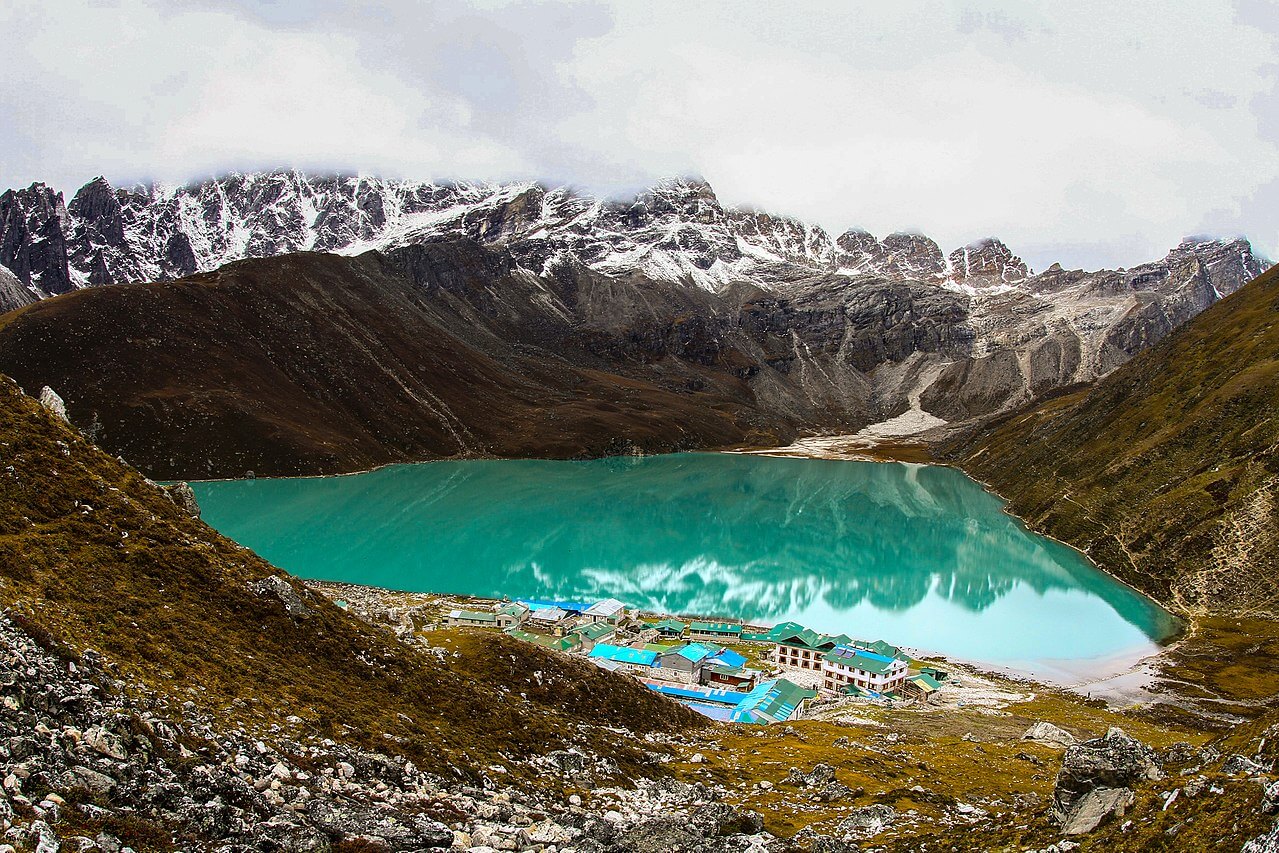
- Since there are no ATMs after Namche Bazaar, carry enough cash for the trek.
- Make sure to carry a sleeping bag.
- Bring a universal travel adaptor as the charging sockets in the teahouses may not pair with your charger.
- It is also convenient to carry a portable charger on the trek.
- Before heading off to the Himalayas, engage in cardio-related exercises to stay physically fit.
- Carry a DSLR camera, so you can capture the mesmerizing views of the mountains.
- Bring a warm down jacket to keep you warm during the night and a hardshell jacket to stay protected from the rain.
Accommodation in Kathmandu
Recommended travel agencies.
- Himalayas on Foot
- Magical Nepal
- Mosaic Adventure
- Nepal Eco Adventure
Recommended Books and Guidebooks
- Everest: A Trekker’s Guide
- Lonely Planet – Trekking in the Nepal Himalaya
- The Rough Guide to Nepal
- Into Thin Air
- High Adventure
1. How fit do I need to go trekking in Gokyo Ri?
While trekking above 4,500m, you need to be in excellent health condition and decent body shape. Your fitness level should be good enough to walk for a minimum of 5-6 hours per day. In some days, the trek can be quite challenging with a steep climb. So, engage in cardio exercises a month before the trek to keep your body fit.
2. Can I do Gokyo Ri Trek without a guide?
Yes! You can do Gokyo Ri Trek independently without hiring a guide. The route is navigable with occasional signposts along the trail. However, we highly recommend you to hire a guide, considering the elevation of the trek.
3. Is drinking water safe on the trek?
Bottled water is available to buy throughout the trek. However, we suggest you carry a water bottle and fill the water in the teahouses instead. Don’t forget to pack a water purifier or tablet to treat it.
4. What is the standard of the accommodation on the trek?
Most of the teahouses in Gokyo Ri Trek are standard that generally provide shared rooms, food, and basic amenities. The beds are usually comfortable. But, it is advisable to carry a decent sleeping bag to keep you warm during the night.
5. Is there any possibility of Acute Mountain Sickness?
Acute Mountain Sickness (AMS) generally occurs above the elevation of 3,500 meters. Standing at the height of 5,357 meters, Gokyo Ri marks as the highest elevation point on this trek.
Even the most experienced trekkers can suffer from high altitude sickness. Therefore, be aware and keep your body hydrated with plenty of water and fluids to prevent AMS.
6. Do I need travel insurance for Gokyo Ri Trek?
Definitely! It is mandatory to have travel insurance while trekking in such high altitudes. Make sure your travel insurance includes all the medical charges, helicopter evacuation, theft, accidents, and natural disasters.
Gokyo Ri Trek is the best alternative trek to the classic Everest Base Camp. This 11-day itinerary offers abundant diversity from breathtaking mountain scenery to high-altitude turquoise lakes to the massive Ngozumpa glacier.
Although this trek is considered moderate in difficulty, there are some challenging sections, especially in the higher reaches of the trek. So, physical fitness and mental preparation are essential while trekking in this region.
Similar Posts
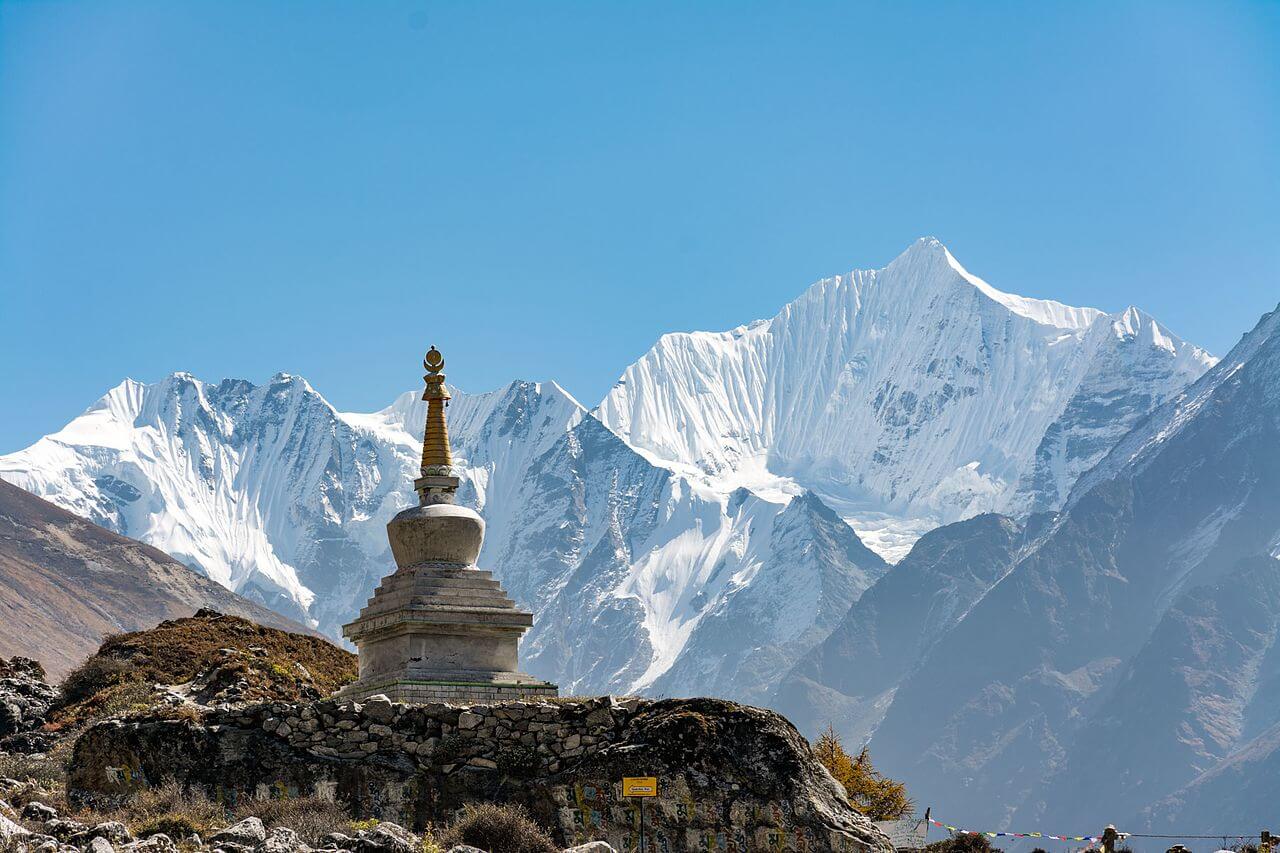
Langtang Valley Trek
Langtang Valley is a classic trekking destination, located only 61.8km away from aerial distance, north of Kathmandu. Although the Langtang Valley Trek is relatively short, accessible, and cheap, the trails are quieter with less number of trekkers compared to other classic trekking destinations in Nepal. The trek is ideal for both experienced trekkers as well…
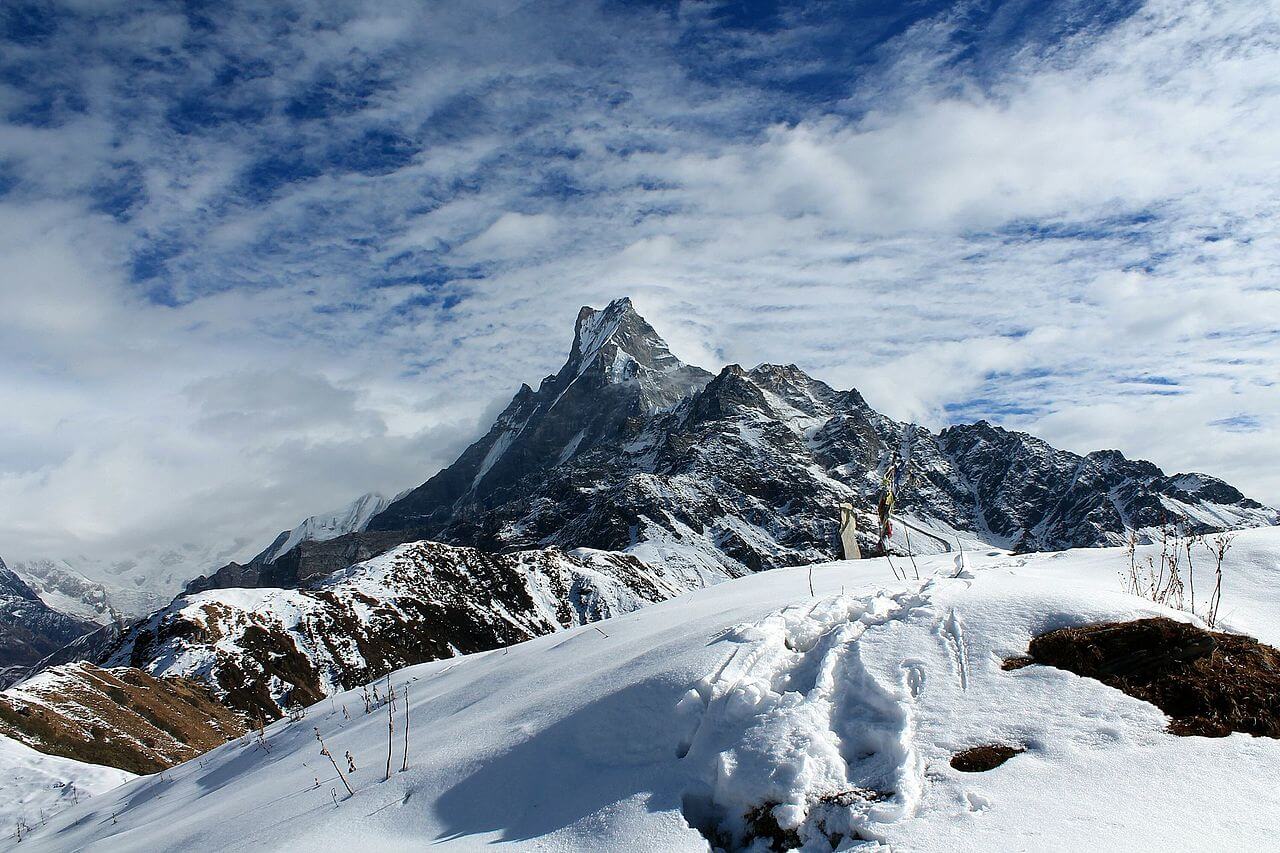
Mardi Himal Trek
Mardi Himal Trek is a hidden gem for the dedicated trekkers and backpackers. Located eastwards of the classic Annapurna Base Camp, this trekking route is yet to witness a large crowd like other commercial treks in Nepal though it officially opened for all in 2012. The richly diverse terrains of Mardi Himal takes you across…
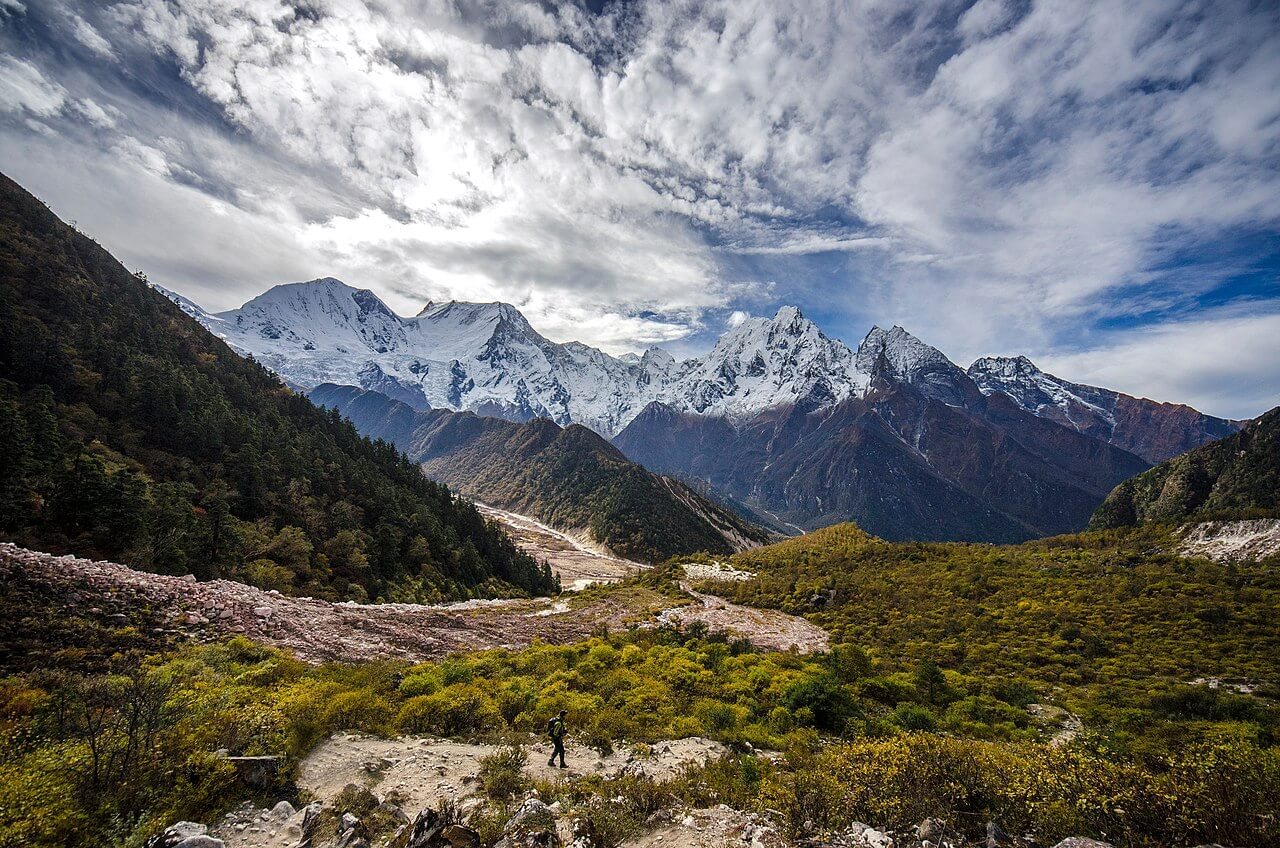
Manaslu Circuit Trek
Manaslu Circuit Trek stands less beaten and secluded compared to treks like Everest or Annapurna, but it is equally as impressive as other classic treks. Manaslu Circuit Trek is the most beautiful as well as demanding treks in Nepal. Trekking in Manaslu is a delightful experience with a blend of adventure, scenery, culture, lifestyle, and…
Mera Peak Climbing: Best Offerings 2024/25. Learn More
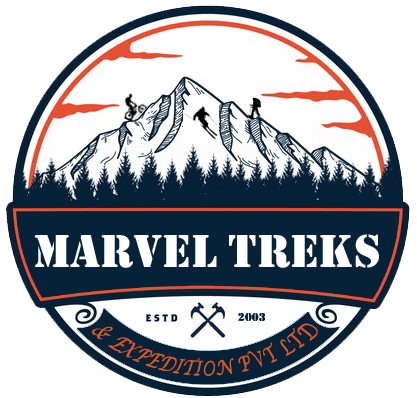
Gokyo Lake Trek
Home » Trip » Gokyo Lake Trek
Trip Downloads
Challenging
Flight/Private Vehicle
Spring/Fall
Gokyo Lake Trek Overview
Gokyo Lake Trek is a popular trekking route in the Khumbu region of Nepal. It is notable for its pristine views, cultural diversity, and proximity to Mount Everest . Trekkers will pass through remote communities, woodlands, and high-altitude lakes along the way, including the iconic Gokyo Lakes, a chain of blue glacial lakes encircled by soaring peaks.
Gokyo Lake is located at an altitude of 4700-5000m in, Solukhumbu district , Sagarmatha Zone. Comprising the 6 main lakes, these lakes are the world’s highest freshwater lakes. Gokyo Cho, also known as Dudh Pokhari, is the main lake with an area of 106 acres. While Thonak Cho Lake is the largest among all with an area of 160.8 acres.
Besides them, the other lakes are Gyazumpa Cho Lake (72 acres), Tanjung Cho (41.9 acres), Ngojumba Cho (35.6 acres), and Kyajumba Cho. Gokyo Lakes is highly believed to be a sacred lake for both Hindus and Buddhists. Every year at Janai Purnima Festival, about 500 Hindus take a holy bath in this lake. There is also a temple of Hindu deities Vishnu and Shiva . It is located at the western corner of the lake making this place the holiest.
The trail passes through Sagarmatha National Park where you can see many endangered animals like red panda, Himalayan Tahr, snow leopard, wild boar, etc. There is no doubt, Gokyo Lakes is a very popular destination leading toward the Everest base camp . Gokyo village at 4790m, is another major attraction of this trek which includes climbing Gokyo Ri.
Additionally, the Gokyo Lake trek offers breathtaking views of the Himalayas, including the world’s highest mountain, Mount Everest, as well as other peaks like Cho Oyu , Lhotse , Makalu , and more.
Highlights of Gokyo Lake Trek
- Climbing Gokyo Ri and crossing the challenging Cho La pass
- Walk through the Ngojumba glacier, one of the longest glaciers in the Himalayas
- Diverse flora and fauna of Sagarmatha National park
- Trek through one of the less explored areas with off-beaten trails
- Ancient Buddhist monasteries , monuments, and prayer walls
- Explore the beautiful Gokyo valley
Gallery of Gokyo Lake Trek
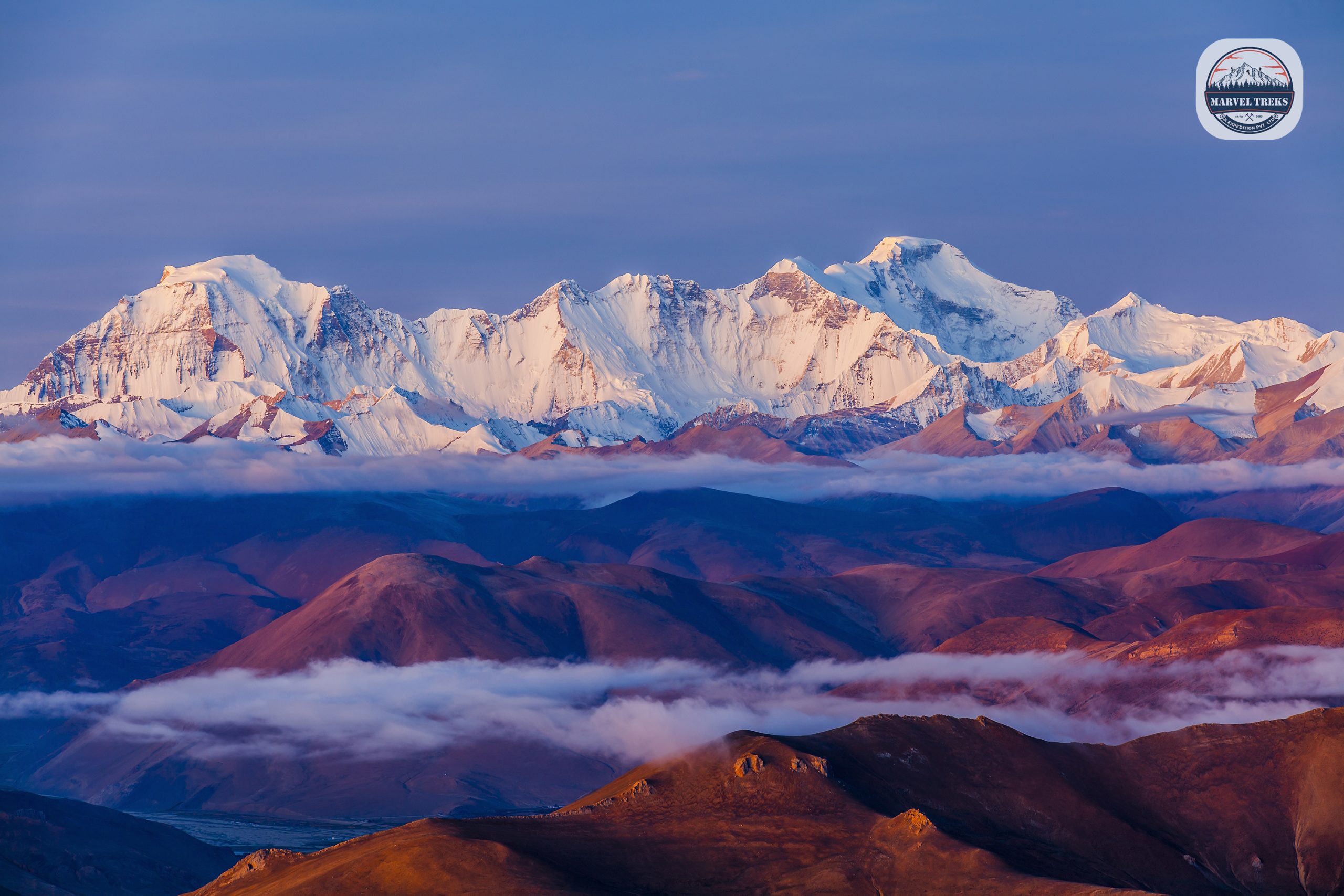
Outline Itinerary
- Day 1- Kathmandu - Lukla - Phakding, 40 minutes flight, 4 hours walk
- Day 2- Phakding - Namche Bazar, 6 hours walk
- Day 3- Namche Bazar - Dole, 4 hours walk
- Day 4- Dole - Macchermo, 4 hours walk
- Day 5- Macchermo - Gokyo, 4-5 hours walk
- Day 6- Gokyo - Gokyo Ri, back to Macchermo, 5-6 hours walk
- Day 7- Macchermo - Namche ,7 hours walk
- Day 8- Namche - Lukla, 8-9 hours walk
- Day 9- Lukla - Kathmandu, 40 minutes flight
Best Season to Visit
The best time to visit the Gokyo Lake trek is in autumn between September and November and in spring between March and May. Monsoon is just over and you can see beautiful greenery and different crops. The skies are very clear and blue and you can enjoy the view of the mountains.
During the winter season, there is huge snowfall at Gokyo Lake which might block all your way. During summer, also called the Monsoon season in Nepal the trails are slippery and muddy due to heavy rainfall.
Other Requirements
Travel Insurance
Travel insurance is mandatory thing before traveling anywhere. Don’t forget to mention the maximum altitude you will be reaching since the insurance depends on it. You can contact your travel agencies or the insurance company itself for the insurance.
If you in any case will be needing medical emergencies your travel insurance will be bearing for it. You need to say the details clearly before traveling. Travel insurance generally costs you 150$ and lasts for 30 days.
Visa/passports
If you are a foreigner you might already know that valid visas and passports are compulsory in Nepal. Only Indians are not required to have visas.
You can have your Nepalese visa at Tribhuwan International Airport , Kathmandu. You need to also bring a few passport-size photographs in case you need them.
Packing List
Clothing and equipment
Payment and Cancellation
Policy regarding Payment and Cancellation Payment:
1) To confirm a reservation, a deposit equal to 30% of the total price is required. 2) If the payment is made online, the remaining balance is due 10 days before the Tour, Trekking, Peak Climbing, or Expedition begins. If the payment is made in cash, it can be made after arrival. 3) If the booking is made within 30 days of the expedition beginning, full payment must be made at the time of booking.
Cancellation:
1) A full refund of the deposit will be given if a Tour, Trek, Peak Climbing, or Expedition is canceled more than 60 days before the start date. 2) The deposit will not be refunded if a Tour, Trek, Peak Climbing, or Expedition is canceled within 30 days of its start date. 3) A tour, trek, peak climbing, or expedition will not be refunded if it is canceled prior to or on the start date. 4) All participants should strongly consider purchasing travel insurance to cover any unforeseen cancellations or other occurrences.
Note: We reserve the right to modify or cancel any trek in the event of a natural disaster, political unrest, or any other unforeseen circumstances beyond our control. In such cases, a full refund or an alternative option will be provided.
Dates of Trip
450 Save 500
Group Discount Prices
Frequently asked questions, booking details.
- A detailed certificate from Marvel Treks and Expedition (after accomplishment)
- A complimentary raincoat to shed you during the rainy season. (returnable)
- A Complimentary Duffel Bag throughout the trek from our company. (returnable)
- A warm complimentary Down Jacket during the entire trek on behalf of Marvel Treks. (returnable)
- A complimentary sleeping bag for your icy trek. (returnable)
- The essential climbing gear like mountain axe, trekking sticks, etc, for your need throughout the trek. (returnable)
- Delightful complimentary Authentic Nepali cuisine as dinner to embark on your arrival and departure
- Critical complimentary First Aid Service (in times of need)
- An informative trekking map for you to cherish on behalf of our company
- Trendy Sunhat and t-shirt as souvenirs on behalf of Marvel Treks and Expedition.
- All the crucial services about airport transfer to and from the hotel via a private tourist vehicle ($60)
- TIMS (Trekkers’ Information Management Systems )($10)
- National park entry fees / ACAP permits / Conservation entry fees. ( $30)
- Khumbu Rural Municipality Permit($20)
- All essential local tax and, office service charges Gov tax ($100 )
- 2 nights accommodation in a Kathmandu (Kathmandu hotel or similar) ($40)
- Porter Guide ($240)
- Marvel Treks and Expedition won’t be responsible for all the Lunch and dinner in Kathmandu.
- Extra nights in any city that’s not accommodated in the itinerary of Marvel Treks and Expedition.
- All the International flight checks and airfares.
- Marvel Treks and Expedition won’t be responsible for alcoholic/ non-alcoholic liquors.
- Additional porter fees along with tips for guides and porters.
- Electronic gadgets like chargers, and headphones.
- Individual costs like a hot shower, phone calls, laundry, and souvenirs.
- Travel coverage and emergency evacuations.
- Tips for our staff’s drivers.
Price: US$ 500 per person
$ 550.00 $ 500.00 $ 500.00 ,
Your Full Name
Your Phone Number
Your Country Expected No. of Persons In Trip
Your message (If any)
Price W/O Addons: US$ 500 per person
There are no reviews yet.
Your email address will not be published. Required fields are marked *
Your review *
Name *
Email *
Save my name, email, and website in this browser for the next time I comment.

9 days from 550
$ 500 /pax
- Best Price Guarantee
- Hassle-Free Booking
- No Booking or Credit Card Fees
- Team of highly experienced Experts
- Your Happiness Guaranteed
Enquire 24/7
We are featured on

POPULAR TRIPS

Bidding For - Gokyo Lake Trek
Bidding Price*
Your message (optional)

- Adventure Activities
- Festivals And Culture
- Hiking And Trekking
- Peak Climbing
- Sightseeing Information
Tourism Info
Trekking information, ultimate guide for gokyo lake and everest base camp trek 2024.
A big Teahouse shelter trekking in the Himalayan heaven encircling Gokyo Lake and Everest Base Camp Trek leads trails over Himalayan grassland, Glacial lakes, and into the alpine scenery. In between 5 to 7 hours periods daily, the trekking over 12 to 14 days in a teahouse to teahouse alone the Cho Oyu Himalayas world.
The hiking starts and ends at Lukla. Across the complete routes few treks away from modern human social and cultural developments from lodges to lodges. Alongside the routes are full of Rhododendron flowers and a few Alpino Flores and the nearest face-to-face Huge Himalayas chains including Mt. Everest, Lhotse, and Cho Oyu with its amazing petrified South Face.

At every step, the cozy Himalayan guest house anticipates where the sherpa owners saturate the trekkers. Those Sherpas well recognize the Himalayas heaven surroundings, Everest . Nepal’s guide tells the story of the Himalayas to describe.
Gokyo Lake and Chola Pass with Everest Base Camp Treks provide dissimilar features and 15 to 17 days of attractiveness in Everest and Cho Oyu Himalayas heavens.
- Please bring a Camera or a good Mobile Phone.
- observance of the admiration at several secret and seen parts of Everest and Cho Oyu.
- Everest Base camp trek beginner officially after the moments of first success ascend climbing of Mt. Everest.
- This extensive trek lasting for 17 days in an alpine and sub-alpine territory, Mt. Everest Base camp, and Gokyo Lake hike is essential the attentive planning.
When to Trek Everest Base Camp and Chola Pass?

According to our twenty years of experience, geologists predict that Gokyo Lake, Everest Base Camp, and any mountainous region of Nepal will have heavy rainfall from July to August. Therefore, the time before the rain and the time after the rain are considered suitable times for trekking in the hilly parts of Nepal.
At such times the sky is very clear. There is less chance of rain and snow. But the Everest Base Camp is a tourist hotspot at that time. If you do not want to hike in a crowded time, then the cold season or winter season is suitable. Sometimes the footpath is closed due to heavy snowfall.
Compared to Everest Base Camp, Gokyo Lake is a quiet trekking trail. November end is considered the most appropriate time for trekking there.
During that period less probability of rain, sunrises during the day and it is warm when walking. Trekkers stay inside the guesthouse at night. So even when the temperature is negative 15, it doesn’t feel so cold. But the clothes should be well prepared.
Ultimate Guide for Gokyo Lake and Everest Base Camp Trek:
Gokyo lake, cho la pass, and everest base camp trek cost breakdown:.
Below we include the costs for the combined route of Gokyo Lake, Gokyo Peak, Chola Pass, and Everest Base Camp Trek for 2024 – 2025. The cost of each 15-day-by-day trek is below and the total cost is also included.
Day 01. Kathmandu to Lukla Flight and Trek from Lukla to Phakding.
- Drive cost from Hotel to Airport: US$ 10
- Flight fare: US$ 180
- Teahouses Cost: US$ 5
- 3 meals cost: US$ 7*3= 21
- Khumbu Pasang Lhamu Gaunpalika Permits fee: US$ 20
- Total cost for day 01: US$236
Day 02. Trek from Phakding to Namche
- 3 meals cost: US$ 8*3= 24
- Sagarmatha National Park Entry Permit: US$ 30
- Total cost for day 2: US$59
Day 03. Rest Day in Namche:
- 3 meals cost: US$ 8*3= US$24
- Everest View Hotel Coffee Cost: US$5
- Total cost For Day 03: US$34
Day 04. Tyangboche Monastery trek from Namche Bazaar:
- 3 meals cost: US$ 9*3= US$27
- Total cost for Day 4: US$32
Day 05. Tyangboche to Dingboche trek:
- Coffee or Bakery strolling in Dingboche: US$10
- Total cost For Day 05: US$39
Day 06: Rest in Dingboche:
- Coffee break in the afternoon: US$5
- Total cost For Day 06: US$34
Day 07: Dingboche to Lobuche Trek:
- Teahouses Cost: US$ 6
- Coffee break in the afternoon: US$7(highest altitude coffee House)
- Total cost For Day 07: US$40
Day 08: Lobuche to Gorakshep:
- Teahouses Cost: US$ 7
- 3 meals cost: US$ 10*3= US$30
- The coffee takeaway for the Everest Base Camp hike: US$ 10
- Total cost For Day 08: US$47
Day 09: Gorakshep to Dzongla:
- Higher elevated coffee second break: US$7
- Total cost For Day 09: US$44
Day 10: Dzongla to Thaknak via Chola Pass:
- Packing Food for Chola: US$10
- Total cost For Day 10: US$47
Day 11: Thaknak to Gokyo:
- Teahouses Cost: US$ 10
- Lakeside Coffee: US$10
- Total cost For Day 11: US$50
Day 12: Gokyo to Dole:
- Total cost For Day 12: US$34
Day 13: Dole to Monjo:
- Namche Coffee time: US$7
- Total cost For Day 13: US$37
Day 14: Monjo to Lukla:
- 3 meals cost: US$ 7*2= US$14
- Treat Dinner for the Trekking crew: US$30
- Total cost For Day 14: US$49
Day 15: Fly to Kathmandu and Drive to the Hotel:
- Flight Cost: US$ 180
- Drive cost: US$10
- Breakfast in Lukla: US$7
- Total cost For Day 15: US$ 197
Total Cost Breakdown:
- Teahouse Accommodation Cost: US$85
- Personal Flight Fare: US$360
- Transportation cost from and to Airport: US$20
- Extra coffee cost: US$71
- National Park and Local Permits Cost: US$50
- Meals and Drinks cost: US$393
The Lump sum of 15 days Gokyo RI and Everest base camp trek cost:
From the above cost breakdown calculations, the total cost for Everest Base Camp Chola pass, Gokyo lakes, and Its RI are as follows.
- Minimum cost per person for solo trekking: 979
- Extra Optional Cost: Drinks, Hot water, Hot Shower, battery Charging, WIFI and Internet, personal snacks, Pastry, soup, and desert US$ 300
- Total cost per person: US$ 1279
- Note: Cost could be different due to guest budget, requirements, food category, and extra items used during the trip.
- Dependent organized Trek:
- Guide and Porter Salary: US$ 20*2*15=600
- Guide flight fare: US$ 100
Note: Tips for staff are extra, Group trekking for more than 2 people should be much cheaper due to sharing a guide and porter salary, flight, and your accommodation.
The total cost is US$ 1979 per person for the dependent trek with a guide and porter from the agency.
How cost Minimization for Chola Pass and Everest BC Trek:
Although we gave the day-by-day breakdown of cost, according to our prior high experience in Nepal Himalayas trekking we will give you some tips to minimize your traveling cost through Nepal trekking. Below are the tips for cost minimization that will be better to understand before your Himalayan treks.
Bring enough water-purified medicine:
Due to the high labor cost of transportation, the bottled mineral water cost on Everest trekking routes is very expensive starting from US$1 to US$ 5 at different elevations. A reasonable way to minimize this is to fill your normal water bottle with tap water and use personal water purification pills or chlorine drops.
Note: Nepali people and some trekkers are not affected even if they drink direct water from taps. But we suggest trekkers use the medicine before drinking.
Bring Extra Battery and Power Bank:
Trekking in the higher elevation of Nepal has no electricity supply. Many tea houses have solar panels for light and charging facilities. At higher altitudes the charging is expensive and the battery cost is also expensive. We suggest our valuable trekkers bring at least a 20000MAH Power bank for your charging. If possible you can bring a small solar charger for the camera battery and mobiles. If you have your power bank you can recharge your battery from time to time even during the day hiking.
Traveling in the group:
Traveling in Nepal in the Everest region is costly and traveling solo is more costly. If you traveling in a group you can share your teahouse accommodation cost with your teammates which decreases your teahouse lodging cost by half. Trekking in Nepal with a guide and porter is also costly so if you share a guide and share porter with your travel mates it reduces the half cost.

Packing with some snacks:
Trekking in Everest base camp and Chola pass is sometimes not shorter. During the long day, you need to eat many times on the trails because it’s difficult, and hungry sometimes. If you have your snacks you can take them anytime when you want which saves your extra food cost arriving to your trekking difficulty and length.
Choose Vegetarian foods:
In trekking places in Nepal, Vegetable foods are cheaper than meat items. Himalayan vegetarian foods are fresh and cheaper so choosing vegetarian food is the way to reduce your Everest base camp cost.
Many trekkers take meat items during the trek but the meat is not fresh they feel some stomach problems and cannot complete the trek. They need to eat medicine and necessary rescue in higher elevations which is very costly. So for health and cost-benefit try to eat veggie food.
Combined Everest Base Camp with Chola pass and Gokyo lake Trek Difficulty:

This trek starts from Hillary Airport, Lukla, along with the Everest base camp, Chola pass, Gokyo, and back to Lukla lasts for a total of 15 days. The total length of the trek is 125 kilometers and the duration of the trek is 14 days. The approximate daily walking time is five to eight hours. Your trek journey will be over 2800m above sea level.
Most of the footpaths are wide, well recognized, and find a way easily. However, it is advisable to travel with a trekking guide as you have to travel above the melting glacier on the day of Chola Pass.
This is a difficult trek because trekkers carry a day backpack like 5kg and hike from 5 to 8 hours on higher elevated trails.
Height is considered to be the main factor in making this trek difficult. Because in this trek you travel up to 5555 meters, we can’t say right now how your body reacts to the height. You sleep at an altitude of over 4500 meters total of 5 days. You may have a problem with High altitude sickness.
When hiking over 3500 meters, you are advised not to sleep at more than 650 altitudes in one day. Drinking around 3 to 4 liters of water/fluid in a day and walking slowly is the golden advice to reduce AMS.
Things to know before trekking Gokyo RI and Everest Base Camp:
Exchange enough local currency:.
Normally ATMs and banks are not available after Namche Bazaar during EBC and Chola Pass Trek. In those places, ATMs are not reliable and do not work all the time. So we warmly suggest you bring enough local currency from Kathmandu ATMs or exchange your cash with money exchange stalls or banks in Kathmandu. The teahouse has availability for money exchange service but the exchange rate is very low.
Poor Quality Meat Items:
This trek is very well-developed in Nepal. So there are many types of vegetarian and non-vegetarian foods available in teahouses. Meat products take a long time to reach and may not be reliable to eat due to the lack of a refrigerator. So we warmly advise eating vegetarian food for our trekkers.
Mountain Sickness is Dangerous:
Tell your walking partner or guide if you feel any symptoms of acute Mountain Sickness. If you have any of these symptoms, going up the route is dangerous so you should go back down immediately. Or you can rest at the same altitude where you have symptoms and go up the next day. If the symptoms appear again. Canceling the trip is the best idea because your health is your wealth.
Protect your Lungs with cold dry air:
Due to higher elevation hiking expertise, we were clear that after hiking Everest base camp trekkers have a common cold and cough from dust and dry cold air. So please wear a buff and mask during the trekking that saves your lungs and neck. Many trekkers had that problem until 10 days after they finished the trek to Everest Regions.
Do not buy trekking gear:
Rent Trekking gear instead of buying it if you are trekking in Nepal. Buying gear or renting in Nepal is a very cheap price. If you do not have trekking gear like a down jacket, Sleeping bag, Trekking shoes, and trekking poles you can rent them in Thamel Kathmandu instead of buying them in your country and the gear is reasonably fine.
Start your daily trekking in the Morning:
Start hiking early morning instead of late or afternoon due to clouds and fog covering the clear Himalayan ranges. Trekking in the morning makes you warm due to sunrise and the afternoon can be cold and windy so we suggest all hikers start the trek in the morning is better.
Beware of Yaks and Donkeys:
During Everest base camp and Gokyo Lake trekking lots of Donkeys, Naks, and Yaks passed on the trails. When they are crossing please do not forget to follow the mountain Cliffside instead of the riverside. They can hit you by legs or by their loads so you can fall into the river or they have accidents. Giving way to the animals is the best way because they are unknown what they transport with them.
How to Reach Tenzing Hillary Airport Lukla:

In the beginning, you need to get into the capital Kathmandu from your country. Numerous airlines fly to Katmandu from different countries.
The famous airlines are Turkish Airlines from Istanbul, Emirates (flies Dubai for Nepal), Etihad Airways, Cathy Pacific from Hong Kong, and Thai Airways from Bangkok.
Except for that airline many airlines from India, Bangladesh, China, Malaysia, and Saudi Arabia the flights to Nepal. Please choose the best and most reasonable airlines you prefer.
From the capital city of Kathmandu, there are just a few airlines that have flights to Lukla. Tara Airlines, Sita Airlines, and Goma Airlines have flights to Lukla every morning.
Note that flight delays and cancellations due to weather are normal in the Nepal Himalayas regions. Flight cost for Lukla is normally US$ 178 for foreigners.
Few trekkers who have enough time and prefer road trails drive to Jiri or Salleri and start trekking from there. That is a budget trekking way for Everest base camp and it needs 7 days extra to reach Lukla from Kathmandu.
Due to airport construction and heavy air traffic sometimes from Kathmandu, trekkers cannot fly to Lukla. They need to drive to Manthali Ramechap for their Lukla flight and vice versa when they back from the trip.
Where to stay in Kathmandu?

There are several types of accommodation in Kathmandu. Please you can book or we can help you to book the accommodation according to your budget and requirements. From US$ 5 to US$ 300 per night accommodation is available in the capital Kathmandu.
Where to stay during the Chola Pass and Everest Base Camp trek?
Everest base camp trekking is a very well-known trekking trail in the world. Basic to luxury accommodation is available during your EBC journey. Everest View Hotel and Yeti Mountain Home are the most expensive lodges in that region. If you prefer to stay in that lodge please book the luxury Cho la pass and Everest base camp trek with us and inform us before the trip. Except for those lodges, some lodges and basic and some are normal. According to your budget and availability of accommodation, we will provide you with the best accommodation for our valuable clients.
Below is our normal teahouse accommodation that we booked our clients before for a normal trek.
1. Phakding: Hotel Azalia or Hotel Beer Garden(inside toilet room)
2. Namche: Hotel Sakura(room with attached toilet)
3. Tyangboche: Himalayan hotel or Tashi Delek Hotel (Himalaya View room)
4. Dingboche: Dingboche resort(inside toilet accommodation)
5. Lobuche: Oxygen Lodge or Alpine lodges
6. Gorakshep: Hotel Himalaya
7. Dzongla: HOTEL Mountain home(inside toilet room)
8. Thaknak: Hotel Khumbi La(attached toilet room)
9. Gokyo: Hotel Namaste(inside toilet room)
10. Dole: Alpine cottage(Room with attached toilet)
11. Monjo: Hotel Kailash(inside toilet room)
12. Lukla: Hotel Northpoint or Paradise(attached toilet and shower room)
Noted that access to the internet in the Khumbu region or other trekking destinations of Nepal is poor. Do not forget to buy a prepaid sim card from Ncell or Namaste in Kathmandu after your arrival. What cards can have access to the internet till the lower region of Khumbu? Lukla to Pangboche or Somare that sim cards have internet access but the signal is not strong. That sim card can work in Gorakshep for 1 day as well. When you back from Chola pass that card works data after Mongla near Namche.
The wifi and internet in the Khumbu region are expensive. Many teahouses sell Wifi prepaid cards of Everest Link. If you buy 20 GB cards that can work during all the trials in higher elevations until your data is left.
You Might Also Like

Best Photography Places in Nepal

Everest Base Camp Trek Permits And Associated Costs.

Sherpa Dishes You Must Try in EBC Trek

Top 10 Scenic Lakes In Nepal To Visit


Gokyo Ri And Gokyo Lake Cost

Gokyo Lake, a.k.a Gokyo Ri Trek, is the most popular highlight of the mainstream Everest region right after the Everest Base Camp (5,364 meters). The exploration of these pristine lakes, the highest freshwater system on earth, is a tranquil experience. Route to this hidden enchanting valley of the most popular trekking destination in the world takes you across the serene trails filled with wonders of wilderness within the Gokyo Valley.
If you are considering this iconic trekking adventure in the eastern Himalayas and wondering about the Gokyo Ri and Gokyo Lake Cost, you have landed on the right page. Gokyo Ri and Gokyo Lake Trek, which last around 11 days to 16 days, cost approximately around US$ 1,250 to US$ 1,700 . There are various factors that influence the cost of the trekking package, and you also have to be careful about various aspects of the package before buying it.
In this article, we will discuss all the major components that the standard Gokyo Ri and Gokyo Lake cost will get you, what kind of services/amenities you can expect from your package, and some helpful tips to properly allocate for this classical Himalayan endeavor. Understanding these aspects of the package will help you to choose the most ideal deal for your trek and, of course, assist you in properly allocating the budget if you are managing the trip on your own by evaluating inclusion and exclusion elements.
Gokyo Ri and Gokyo Lake Cost- Overall Package and Duration Overview

The standard Gokyo Ri and Gokyo Lake Trek can last somewhere between 11 days to 16 days . If your trekking package handles all your itinerary plans during your stay in the country, it might be lengthy. In case it just handles your adventure on the mountain, then it can be comparatively shorter. The overall number of acclimatization periods and side detours around the region also affect the duration of your trekking package.
Generally, the Gokyo Ri and Gokyo Lake cost for a standard trekking package ranges from around US$ 1,250 to US$ 1,700 . Your overall Gokyo Lake Trek cost will be influenced by various factors, including the length of your trip, route taken, highlight exploration, quality of the offers, services/amenities, and cost inclusions. Great Adventure Treks offers this wonderful trekking experience in the most popular trekking destination in the world with our 13 Day Gokyo Ri and Gokyo Lake Trek at just US$ 1,290 .
This is a fully guided trekking adventure where we will take care of all your itinerary plans from your arrival date to departure. We guarantee a safe, exhilarating, and remarkable experience in these pristine glacial lakes of the Everest region with our exciting trekking package.
If you are wondering whether you will get some sort of discount or not in your Gokyo Ri Trek cost, we offer a discounted rate for group travelers on the pre-determined package cost. For instance, if you are planning to take part in this exploration, you will have to pay US$ 1,290 . However, if you are partaking in this adventure with friends or family, a group size of 2 to 4 can buy this package at just US$ 1,265 .
Similarly, if your group size is 5 to 10 , then you can do this trek at just US$ 1,230 . The heaviest discount we offer is for the trekking group with 11+ members ; the trekkers in this large group will have to pay only US$ 1,199 each. For any kind of question regarding the trekking package or booking our service, please get in touch with us via our Contact Page .
Package Inclusion and Exclusion- Gokyo Ri and Gokyo Lake Cost

When buying any kind of trekking package, you have to consider the cost inclusion and exclusion factors of the package. Just going for the packages with cheap face value can be disappointing when you learn about the expenses heads that your package doesn’t cover. Thus, the best way to buy a trekking package is to only check out the package offered by the registered trekking agencies in Nepal instead of booking through a third-party platform.
Also, if you want to avoid paying extra costs for the same packages , avoid the middle person. Only Nepali companies are allowed to operate for the trekking routes in Nepal, you will be just paying extra for the same service if you book through a middleman.
Here are some insights into what the general inclusion and exclusion are of the Gokyo Ri and Gokyo Lakes cost. Understanding these included and excluded factors of the general packages will help you to choose the most ideal package for you. Also, understanding these cost factors will help you properly manage your budgeting during the trip or if you are managing the overall adventure on your own.
Send us a Quick Enquiry
- Full Name *
- Your Email *
- Your Country *
- Contact Number
- Your Message *
Package Includes of Gokyo Ri and Gokyo Lake Trek

Permits for Trek
Gokyo Ri and Gokyo Lake Trek take you across the thrilling Himalayan trails that pass across the protected and restricted areas of the region. This should be the foremost priority for your Himalayan trek, even if you’re managing the trek on your own. You will not be able to access the conserved and restricted areas in this mainstream trekking destination without the required permits.
You will basically need to collect three permits for this thrilling Himalayan endeavor:
- Khumbu Pasang Lhamu Rural Municipality Entrance Permit– costs about US$ 20
- Sagarmatha National Park Entry Permit– costs about US$ 30
- Trekker’s Information Management System (TIMS) Card– costs about US$ 17
You can collect the Sagarmatha National Park Entry Permit and Trekker’s Information Management System (TIMS) Card at the Nepali Tourism Board Office located in Pradarshani Marg, Kathmandu . You can also get the national park entry permit at Monjo after landing in Lukla. However, for the Khumbu Pasang Lhamu Rural Municipality Entrance Permit, you can only get it at the Sagarmatha National Park Counter in Monjo .
Note: Great Adventure Treks handles all the permit requirements for this trip and will collect them on your behalf so you can enjoy a seamless journey.
You need to eat a well-balanced diet during your Himalayan journey to fuel yourself with enough energy to trek for long hours. Generally, the standard Gokyo Ri and Gokyo Lake cost package covers the expenses of all the standard meals throughout the trekking period. Your trekking package will get you three meals a day: breakfast, lunch, and dinner. However, during your stay in Kathmandu , your package will not cover your lunch and dinner costs.
During your stay in Kathmandu, you can enjoy a diverse range of delicacies that fit your palate. Also, as the Gokyo Lake Trek takes you across the mainstream Everest region trail, you can expect a moderate to luxurious level of food and accommodation facilities. The teahouses/lodges prepare healthy and nutritious traditional dishes that keep you warm and energized throughout the trip. Similarly, other Asian country specialties and Western menus are also available at the teahouses.
Cost of Standard Meals in Kathmandu: around US$ 10 to US$ 20
Cost of Standard Meals at Teahouses/Lodges in Everest Region: around US$ 10 to US$ 15
Accomodation
In your Gokyo Ri and Gokyo Lake Trek, you will spend around 10 nights at the teahouses/lodges on the mountain and around 3 nights at a hotel in Kathmandu. As you will stay at a star hotel during your stay in the capital city, you can expect an extensive and luxurious set of amenities. Similarly, as this trekking journey takes you across the charming trails of the mainstream region, the teahouses/lodges on the mountain also offer moderate to luxurious levels of facilities.
During your Himalayan journey, you can rest at warm and cozy teahouses/lodges that are mostly run by the natives of the region. You will also be able to use all types of services, from the internet, charging, shower, laundry, etc at the lower region; however, as you navigate to higher remote regions, the facilities are rather limited.
Cost of Accomodation in Kathmandu: starting price at US$ 20
Cost of Standard Meals at Teahouses/Lodges in Everest Region: starting price at US$ 10
Transportation
If your trekking package is a fully-guided adventure like our 13 Day Gokyo Ri and Gokyo Lake Trek , it will take care of all your land transportation as well as the cost of the two-way flight in Kathmandu-Lukla flight. Transportation is one of the significant expenses head of the Gokyo Ri and Gokyo Lake cost as unlike other trekking destinations that can be reached by road, the Kathmandu-Lukla flight is the only viable and convenient option on this route.
This package will take care of all your land transportation needs, i.e., airport pick-up and drop-off, hotel pick-up and drop-off, as well as the comfortable touring bus or convenient van during the sightseeing day at Kathmandu. So, even if you are managing the trek on your own, you have to appropriately budget the transportation aspect of the Gokyo Lake trek cost. You will fly over a total distance of 135 km to reach Lukla from Kathmandu, and the flight will take approximately 45 minutes .
Cost of Transporation in Kathmandu: starting price at US$ 10 (for city areas)
Cost of Transportation (Kathmandu to Lukla Flight) : starting price at US$ 180 (for one-way)
Guide and Porter
It is not possible to do the high altitude treks in Nepal without guides anymore. Since 1st April 2023 , the Nepali Government has made it mandatory for travelers to trek with government-registered trekking guides. Due to the alarming rate of rescue and search operations required for the high-altitude trekkers in the Himalayas, the government made it compulsory to trek with a professional guide to enhance the safety features of the travelers.
The journey also becomes more immersive and informative if you trek with guides. They are familiar with the region like the back of their hand and will ensure a safer, comfortable, and memorable adventure. Your guides also take care of your health and all the logistic details of your overall trip so you can just enjoy the exploration without worrying about anything.
Similarly, the porters are also the backbones of the trekking and mountaineering industry. These helpful and strong professionals assist you with your luggage throughout the trip so you can travel more lightly and relish the experience rather than despairing about the heavy load. P.S. porters are generally the natives of the region, so you can count on them for helpful tips, exploration of hidden gems, and more interactive communication with the locals.
Gokyo Lake Trek Cost for Guide: US$ 30 to US$ 35
Gokyo Lake Trek Cost for Porters: US$ 20 to US$ 25
First-aid Kit
While doing remote explorations, especially high-altitude treks, it is important to be prepared for unforeseen circumstances. You will navigate the remote, rugged, and uneven trails of the Himalayan region to reach the pristine lakes, so it is necessary to carry all the first-aid boxes along the trip for immediate care if you sustain any minor injuries. Similarly, you will also traverse the remote and physically demanding landscapes of the region for well over a week.
Thus, you should also take care of your general health, so the medications that care of minor health issues should be on your priority list as well. As you ascend to significant altitude points in this trek, it will be a wise move to pack altitude sickness like Diamox . If you trek with Great Adventure Treks, we will provide a comprehensive first aid kit with an oximeter to your trekking group.
Furthermore, your team will also be guided by our expert and licensed trekking guides, who have also received certifications for high altitude and first-aid response training. So, you will be able to enjoy your once-in-a-lifetime Himalayan journey without worrying about anything.
Cost of Comprehensive First-aid Kit: US$ 150 to US$ 200
Package Excludes of Gokyo Ri and Gokyo Lake Trek

International Airfare and Visa
Even if your trek is a fully guided adventure, it will not cover the expenses of the international airfare and Nepali visa factors of the Gokyo Ri and Gokyo Lake cost. As the cost of international flights can differ depending on the distance and the trekker’s preference, trekking agencies don’t cover this expense factor of the Gokyo Ri trek cost.
Similarly, the Nepali Visa cost can vary depending on the intended period of stay which can vary. Thus, you will need to manage both of these expenses on your own. To get the Nepali visa on arrival, you can either fill out the form at the airport or submit it online prior to your departure.
There are generally three variants of Nepali visa that you can get on arrival. The cost of the visa varies with the valid duration of the visa.
Cost of Nepali Visa
- Nepali Visa with 15-Day Valid Period– US$ 30
- Nepali Visa with 30-Day Valid Period– US$ 50
- Nepali Visa with 90-Day Valid Period– US$ 125
Note: You can also extend the visa if you plan to stay longer in this Himalayan country. You can get a minimum of 15 days visa extension which will cost about US$ 45 .
Entrance Fees at Cultural Sites
During the sightseeing day that takes place a day before the start of this exciting Himalayan journey, you will explore some of the fascinating cultural, religious, and historic sites of the capital valley. Although your trekking agencies will handle the cost of the transportation for the trip, you will have to pay for the entrance fees by yourself.
The activities travelers prefer inside the sites may vary i.e., some may want photography permission, some may prefer guided trips, museum entry, etc; thus, agencies generally don’t cover this expense factor of Gokyo Ri and Gokyo Lake cost.
Cost of Entrance Feess in Kathmandu: US$ 2 to US$ 15
Snacks and Drinks

Your trekking package does take care of all the standard meals during your trip i.e., breakfast, lunch, and dinner. However, the cost of snacks, desserts, and drinks beyond the mentioned itinerary plans should be covered by you. You will be able to enjoy a wide range of snacks and desserts during the trip on this mainstream route, especially in major towns like Lukla and Namche Bazaar.
Still, it will be best if you pack your favorite snacks before your trek and buy them at Kathmandu, as the cost can be high on the mountain. As for the drinks, it is okay to drink refreshing cold or nourishing warm beverages, but you should steer off alcoholic beverages as they can put you at risk of altitude sickness.
Cost of Snacks/Dessert in Everest Region : cost starts at US$ 2
Cost of Beverages in Everest Region: cost starts at US$ 5
Although tipping isn’t mandatory during your trekking adventures in Nepal, like any other service industry, it is expected. Your Gokyo Ri and Gokyo Lake cost doesn’t cover the tipping for the staff of your trekking team. There isn’t any specific amount set for the tipping, and you can pay them considering the experience of your journey. Take it as a way to thank them for their service, as they add value to your experience.
Remember, just handing out the tip may feel a little disrespectful, so the best practice here would be to present them with an envelope. Feel free to put the tip you feel fit for the experience you had during your journey; these down-to-earth professionals won’t complain about it.
Most of professionals in the trekking industry rely on this season’s business, so definitely your tipping will certainly mean a lot to them. Moreover, it also contributes to the development of the region, which ultimately comes back as more comfort to the trekkers.
General Tips Margin for Guides in Everest Region: around US$ 5 to US$ 10 per day
General Tips Margin for Porters in Everest Region: around US$ 10 to US$ 15 per day
Other Personal Natured Expenses
Although the personal nature of expenses may not feel significant initially, in the long run, they take up a major portion of your budgeting. You will spend 10 nights and 11 days on the mountain during your trekking adventure. Miscellaneous expenses head of Gokyo Ri Trek cost like charging , hot shower , internet , drinking water , personal trekking gear (if you are renting), etc, you will have to manage them on your own.
Your trekking package doesn’t cover these personal natured expenses in the standard mode. The luxurious or custom-tailored packages do offer these expenses head for absolutely free, including the heated bed.
Cost of Miscellaneous Personal Natured Expenses in Everest Region: US$ 2 to US$ 5 per service (depending on the altitude)
You may also like:
- Kanchenjunga Trekking Cost
- Manaslu Circuit Trek Cost
- Mardi Himal Trek Cost
- Langtang Trek Cost
- Everest Three Passes Trek Costs
Tips for Efficnitely Managing Gokyo Ri and Gokyo Lake Cost

- Always check package inclusion and exclusion to avoid any kind of hidden cost
- Instead of buying water bottles, use reusable bottles and fill the bottles at clean stations or at teahouses
- Optimize your luggage and pack efficiently; if you have to hire an extra porter, the general cost and tips can affect your overall budget
- Be more attentive to your hygiene and sanitation; falling sick on the mountain can be both risky and costly
- Plan your trip ahead so you can take your time and won’t have to rush with high-priced booking
- Buy snacks and your favorite energy bars at Kathmandu; they can be costly on the mountain due to all the extra transportation cost
- Eat healthy and filling food that nourishes you for long trekking hours; don’t just value the taste
- Convert enough cash to local currency at Kathmandu; you may have to pay a higher rate on the mountain
- If you are an avid trekking lover, you should consider buying trekking gear instead of renting them; it more beneficial in the long run
- Tek in groups to get the best-discounted price
You may also like...

Everest Base Camp Trek Difficulty

Everest Base Camp, Gokyo Lake, and Three Passes Trek

Everest Base Camp Trek in November
Leave a reply cancel reply.
Your email address will not be published. Required fields are marked *
Save my name, email, and website in this browser for the next time I comment.

Classic EBC Trek
- EBC + Gokyo Trek
- Jiri to EBC
- 3 Passes Trek to EBC
- Island Peak and EBC
- Acclimatisation
- Packing List
Get a Trek Quote
Gokyo lakes trek to everest base camp (expert guide) .
The Gokyo Lakes Trek to Everest Base Camp is a variation of the traditional trek to Base Camp that offers additional sights and the wonderful opportunity to experience the beauty of the highest freshwater lake system in the world. This is all in addition to visiting the Everest Base Camp and high-point of Kala Patthar – two of the highlights of the standard base camp trek.
The route parts with the classic Everest Base Camp Trek at Namche Bazaar and heads west up the Dudh Koshi valley towards Gokyo Lakes and the trekking peak of Gokyo Ri. Expect quiet trails that allow you to focus on the sheer natural beauty of your surrounds – a much more varied and verdant landscape than on the classic trek.
Because of the route’s circular nature, you will not have to retrace your footsteps on the return leg of the trip as you would have done on the standard base camp trek. After spending some time relaxing at the turquoise glacial lakes you will summit Gokyo Ri only to be blown away by some of the most stunning views of Everest (8,848m), Lhotse (8,516m) and Cho Oyu (8,201m).
From there you will ascend one of the iconic ‘Three Passes’ in the region – Cho La pass – over which you will re-join with the main trek up to Gorak Shep. You will have the opportunity to visit the trekker’s photo point at Everest Base Camp before setting out on the trek up Kala Patthar the next day – another iconic viewpoint in the region.
This article covers the Gokyo Lakes to Everest Base Camp Trek by providing a detailed, day-to-day itinerary, map and by answering various questions on when to go, what to pack and how much it will cost.
Get the latest information on the Coronavirus situation in Nepal and how it may effect your travel plans.
We do not sell tours, we simply provide impartial advice . If you would like an exact quote from our recommended tour operator click Get a Quote.
[adinserter block="2"]
Gokyo Lakes Trek
Regional map.
The trek takes place in the Everest or Khumbu region of Nepal as shown by the orange block on the map below. After flying into the capital, Kathmandu, you will take a short flight into Lukla where the classic Everest Base Camp Trek as well as the Gokyo Lakes Trek begins.

For an alternative to flying into Lukla airport, consider the Jiri to Everest Base Camp Trek – a variation which starts with a bus ride before trekking most of the way in a fashion similar to the early pioneers of the region.
[adinserter block="3"]
Trekking Map
This map provides a schematic representation of the trek to Everest Base Camp via Gokyo Lakes. After flying into Lukla, the trek starts along with the classic trek heading north through Phadking. At Namche Bazaar, the route forks left and passes through the small town of Dole and Machhermo before reaching the Gokyo Lakes in the north-west.
After the summit of Gokyo Ri is completed, the route heads east over the Cho La pass towards Tengboche and Pheriche, where it joins up with the main Everest route. From here you follow the Khumbu Glacier up to Gorak Shep and eventually Everest Base Camp. After climbing up Kala Patthar, the route descends through Dingboche on the classic trail before reaching Namche Bazaar and finally Lukla.
[adinserter block="4"]
Recommended Guidebooks
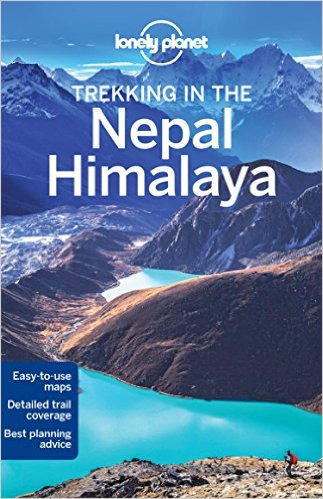
Taking a guide on the Gokyo Lakes Trek is a great way of ensuring you make the most of your time spent in the Khumbu region. The Gokyo Lakes variation is also much quieter than the classic trek, so an easy-to-read map can come in handy when navigating through the valley.
The Lonely Planet Trekking in Nepal Himalaya guide is updated regularly and is a well-known, trusted resource used by many trekkers worldwide. The guide is very detailed and contains information for many treks, meaning you can use it more than once!
For an excellent trekking map we recommend: Nepa Maps 1:50,000 Gokyo and Everest Region Map .
Detailed Itinerary
As with the popular classic trek, the Gokyo Lakes Trek also starts in Lukla after a short, yet memorable flight from Kathmandu. The outward leg of the trek takes you north-west through the Dudh Koshi valley before looping around after Gokyo and returning along the classic route.
The entire trips lasts around 17 days, of which 2/3 days will be spent in Kathmandu pre and post the trek. This is a few days longer than the traditional Everest trek – accommodating the countless extra sights you will come across as you make your way to the base camp.
Day 1: Kathmandu, baby!
Arrive in the capital city of Kathmandu. If you have booked your trip with a tour operator they will usually provide airport transfers and will have arranged your hotel. If you are travelling independently there are loads of taxis at Kathmandu airport (just make sure you agree a price before you get in the taxi) and we recommend staying in the Thamel district.
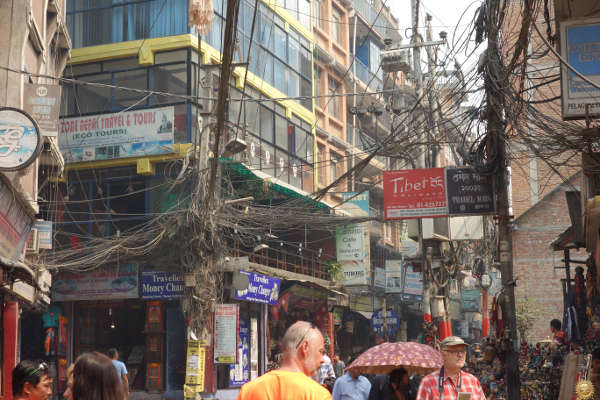
Vibrant streets of Thamel, Kathmandu
Day 2: Fly from Kathmandu to Lukla. Trek to Phadking
A short morning flight will take you to Lukla Airport. The flight is quite an experience itself so be sure to bring your camera with! After touching down in Lukla, the trek begins with a short descent to Phadking, passing various Buddhist sights along the way. Find our more about the flight to Lukla here .
Day 3: Phakding to Namche Bazaar
A full day’s trekking will take you into the start of the Sagarmatha National Park . A steep finish to the day will bring you to Namche Bazaar (3,440m), the central trading outpost of the region. Explore the village and stock up on some much-needed snacks for the next few days. Be sure to check out the weekly market if you happen to be there on a Saturday! Please note: many people split day 3 into two parts, stopping for the night in Phakding before continuing onto Namche on day 4.
Day 4: Acclimatisation Day
Spend the day acclimatizing in Namche Bazaar by exploring the area steeped in tradition. A short hike to the Everest View Hotel will give you a chance to catch your first glimpse of the famous mountain, as well as the imposing Ama Dablam.
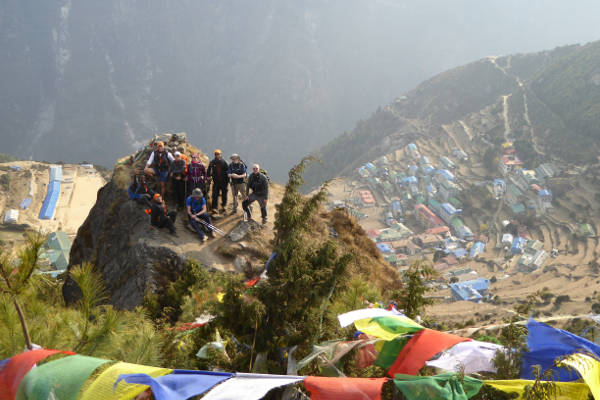
Day 5: Trek to Dole
The trek now separates from the main Everest route and heads north-west up the Dudh Koshi valley towards Dole. You should be able to snap some amazing pics of Everest, Lhotse and Ama Dablam as you cross one of the early ridges.
Day 6: Trek to Machhermo
A fairly steep day of trekking will take you up 500m in altitude towards Machhermo. Keep your eyes peeled to see some of the yaks during the summer months. Once again, you will be treated with some of the best views of Cho Oyu and the surrounding peaks as you trek. Try to keep your head up to take in some of the beauty!
Day 7: Acclimatisation Day
Your second acclimatization day will be spent at Machhermo. Use the time to seek out the views of the Ngozumpa Glacier – the largest glacier in the Himalayas.
[adinserter block="5"]
Day 8: Trek to Gokyo
After a good day’s rest, make your way to the first of the lakes – you won’t be able to miss them with their striking turquoise water standing in stark contrast to the landscape of the region. After the third lake, you will reach the village of Gokyo where you will be staying for the night.
Day 9: Gokyo Ri and then hike to Dragnag
An early start to the day is needed for the summit of Gokyo Ri. At just below 5,500m, the summit offers wonderful views of Everest, Lhotse and Cho Oyu. Keep your fingers crossed for good weather! Descend later that morning and then cross the Ngozumpa glacier before heading to Dragnag for the night.
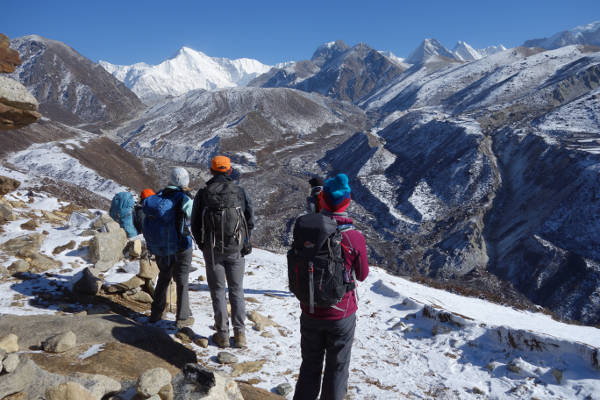
Day 10: Over the Cho La Pass and onto Dzongla
Be prepared for a long day as you traverse one of the ‘Three Passes’ – Cho La. Take your time as you tackle the rocky trail over the pass, reaching 5,420 at its highest point. From here you will cross the glacier on the other side of the Cho La and descend to Dzongla.
Day 11: Rejoin the classic trail and hike to Lobuche
Rejoin with the main Everest route as you pass through Pheriche and Tengboche, where you will find the largest monastery in the area. The trek from Pheriche to Lobuche passes many memorials to Sherpas and climbers who have died climbing Everest. You will spend the night in Lobuche.
Day 12: Lobuche to Gorak Shep (hike to EBC and back to Gorak Shep)
The day is spent hugging the Khumbu Glacier as you make your way up to Gorak Shep and eventually Everest Base Camp. Tour groups are not typically allowed to stay in base camp for long, so take the opportunity to get a feeling of the buzz and excitement of potential summiteers of Everest (if you visit during the climbing season – April / May). Descend back to Gorak Shep for the night, passing great views of the infamous Khumbu icefall.
Day 13: Ascend Kala Patthar and then hike to Dingboche
Ascend the trekking peak of Kala Patthar for more breath-taking views of Everest and the surrounding peaks. Descend that afternoon to Dingboche, following the classic route.
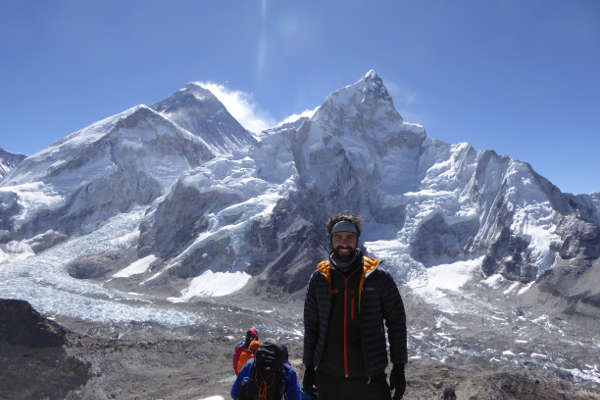
View from Kala Patthar with EBC, the Khumbu Glacier, Nuptse and Mount Everest in the background
Day 14: Return to Namche
Descend back to Namche Bazaar via Tengboche. Keep your camera on you as you pass through the rhododendron covered slopes – making for a great photo.
Day 15: Hike to Lukla
Finish the trek with the descent to Lukla, through the Dudh Koshi valley. Catch up on some much-needed rest and possibly a few drinks to celebrate what is sure to have been a memorable trip!
Day 16: Fly back to Kathmandu
Fly back to Kathmandu early in the morning.
Altitude Profile
This chart shows the altitude profile of the typical Gokyo Lakes to Everest Base Camp Trek, starting in Lukla and reaching the high-points of Gokyo Ri, Cho La Pass and Kala Patthar.
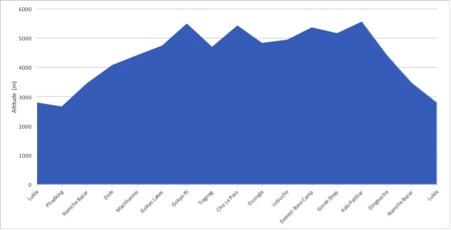
A significantly greater part of the trek is spent above 4,000m when compared to the traditional Everest Base Camp Trek. The ascent profile is also steeper than the traditional trek – contributing to the increased difficulty of this variation.
Gokyo Lakes Trek FAQ
How much does the gokyo lakes trek cost.
The Gokyo Lakes to Everest Base Camp Trek tour package tends to cost £400-£500 more than the classic Everest Base Camp Trek – mainly because the trek is longer, therefore requiring more accommodation, food and guides.
Trekking independently is not recommended for this variation because the routes are much less busy and the trek in general is more challenging. A tour operator will organise all accommodation, food, permits and communal equipment as well as provide well-trained guides. Packages will cost in the region of £1,200 to £2,500.
Read our detailed article on the breakdown of costs for the classic Everest Base Camp Trek here .
When is the best time to trek the Gokyo Lakes route?
As with most treks in the region, it is best to avoid the peak of summer when the monsoon season is at its zenith by trekking in the shoulder months either side of it. During these months, the weather tends to be stable and dry – making for good trekking and sightseeing conditions.
The pre-monsoon months of February to May are a popular time when the mountain is at its greenest. September to October are considered the best months to trek on the other side of summer.
Trekking during peak season should not be much of an issue on the Gokyo Lakes to Everest Base Camp trek as the route avoids the crowds of people tackling the classic trek.
Find out more information on weather and the best time to trek in the Everest region .
How difficult is the trek?
If the classic Everest trek is considered an easy trek, then the Gokyo Lakes variation may be considered moderate. While no previous trekking experience is required, the trek does involve 5-7 hours of trekking per day on hilly/rocky terrain at high altitudes. Much of the trek is spent above 4,000m and altitudes of over 5,500m are reached when traversing passes and trekking peaks.
We do recommend training a few weeks to months beforehand so that you will be comfortable walking similar distances on the trek. Here is our EBC trek training guide .
Will I get altitude sickness?
The itinerary of the trek is designed to provide enough time for the body to acclimatize to the high altitudes. If you follow the guide and don’t rush the ascents, you should be fine. Most high-points on the trek are peaks or passes which will be descended shortly after reaching the top – following the principle of ‘climb high, sleep low’.
Altitude sickness can affect anyone, regardless of fitness or age, so it is still vital to read up on the symptoms and different variations of the condition. Our detailed article on acclimatization and altitude sickness is sufficient reading preparation for the trek.
What gear should I pack for the Gokyo Lakes Trek?
The packing list for a trip of this length is quite extensive, so we have compiled an article that details what you should bring and which brands offer the best value for money.
Read the Everest Base Camp packing list for our recommendations based on past experience of trekking in Everest.
What insurance do I need?
The short answer is yes. Trekking in Nepal at high altitudes comes along with various risks that are not covered by typical travel insurance. We recommend taking out insurance that covers trekking to altitudes up to 6,000m as well as medical evacuation from the mountain.
We have a detailed article to help to find the best policy that will suit your needs. Alternatively, use the quote calculator below from our recommended partner, World Nomads. They offer insurance that covers guided hikes up to 6000m and include a premium for Helicopter Evacuation in Nepal.
Route Variations
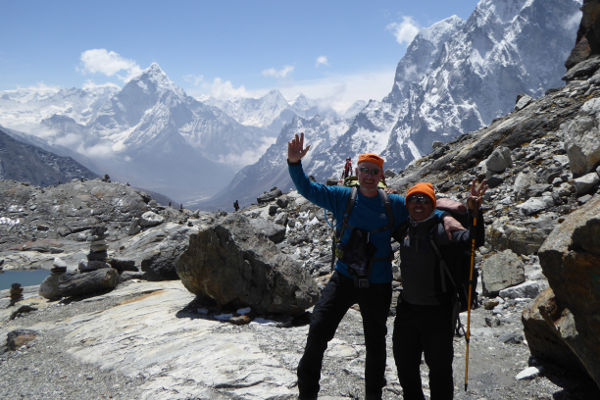
The most popular trek in the region, the classic Everest Base Camp Trek starts after a flight into Lukla. From there the hike begins with gradual ascents each day through various villages and small towns as you head north through the Khumbu Valley.
The trek takes you through the villages of Phadking, Namche Bazar, Tengboche, Pheriche and Gorak Shep before reaching the Everest Base Camp. You then retrace your footsteps as you head back down the valley, using the same route.
The trek is very popular during peak trekking season with over 30,000 people completing it annually. It typically lasts 14 days and covers 130km of trekking that involves covering an average of 15km per day over 5/6 hours.
Three Passes Trek

The Three Passes Trek is a tougher variation than the classic Everest Base Camp Trek because it involves crossing three very high passes as well as summiting some walking peaks which are not included on the classic trek.
The variation starts by following the classic trek from Lukla to Namche Bazar before veering west towards Thame and the remote Nangpa Valley. The first of the three passes encountered is the Renjo La, where you will be afforded magnificent views of Everest before descending to the idyllic Gokyo lakes.
The next pass, Cho La, involves walking up a fairly steep and icy trail before reaching a small glacier at the top. From here, you descend and re-join the main base camp trek where you summit Kala Patthar – the iconic viewpoint. You continue onto base camp itself before descending to Lobuche.
You then head east over the third pass of Kongma La and continue onwards to summit the third peak of Chukking Ri. Once again you will have amazing views of the surrounding peaks that you would not get to see on the classic trek. The circuit is completed by returning to Lukla through the main Everest trail.
Jiri to Everest Base Camp

This variation of the classic trek offers an alternative to flying into to Lukla from Kathmandu to start the trek. The Jiri variation starts with an 8-hour bus ride from Kathmandu to Jiri, where the trek begins.
The variation adds an extra 5/6 days onto the trip as you trek through the Solu-Khumbu region and make your way past Lukla, where the trek then follows the same route as the classic Everest Base Camp Trek.
It involves a scenic, yet very long, bus ride as well as a lot more exposure to the Tibetan and Sherpa cultures. Expect to trek through more forests and streams as you start at the relatively low altitude of 1,800m and work your way up to Lukla and beyond.
Island Peak Climb

The variation trek that involves summiting Island Peak is significantly harder than the classic Everest Base Camp Trek. The climb to the peak is somewhat technical although and requires basic knowledge of using crampons and ice axes. Standing at just under 6,200m, however, altitude can be the real challenge.
Most climbers of Island Peak use the traditional base camp trek as a means of acclimatising before heading to the Island Peak Base Camp via Dingboche on the main trail, or by traversing the Chongma La pass. Summiting from the base camp typically takes two days and the whole variation will add around 4 days onto the classic trek.
Tags: Gokyo Lakes Trek, Trek to Gokyo Lakes, Gokyo Lakes Trek to Everest Base Camp, Gokyo Lakes Trek Map
Mark Whitman
Hi, I'm Mark! Welcome to EBC Trek Guide - the Web's No.1 Trekking Guide to Everest Base Camp. I have trekked all over Nepal, but the Everest region remains my favourite. I hope you find all the answers you are looking for on this site. If you have any questions don't hesitate to drop a comment below! Happy Trekking!
Leave a Reply
Your email address will not be published. Required fields are marked
mark you are pictured with a guide, he was my guide to Gokyo Ri in 2016, but Ive lost his contact details can you remember his name please. I lives with is family in a tea shop about half way between Lukla and Phadping
Hi Ray, his name is Pimba. All the best!
Hi Mark, lots of good info on your site. Thank you. I am 53 and planning to do the Gokyo Valley Trek returning down the Eastern side of the valley in November with my 17 year old son. We have done hikes of up to 7 days in NZ but never at altitude. I have starting a training program but a little concerned about the difficulty of this trek. We will take it slow and have lots of rest days however and get to Gokyo in 7 or 8 days before returning. Any other tips ?
Hi Emma, you both sound fit and more experienced than the average trekker in Nepal. As long as you take a slow ascend to Gokyo you should be absolutely fine and have a blast. My only tip would be to take yak tracks for the Cho La pass. It can get quite snowy in November so additional grip is never a bad thing.
Hello Mark,
We are planning to do Jiri to Ebc with the Gokyo Ri and Cho la pass. We would like to start from Jiri around the last week of february. Do you think the Gokyo ri and Cho la pass will be open and safe when we will be there? Also, we want to buy or rent a third layer in Katmandu. Do you have any shop you would recommand?
Thank you very much for all the informations and the advice,
Hi Cedrik, Gokyo Ri and Cho La should be open around this time – as long as there isn’t a late massive snowfall in late Feb / early March. In terms of gear, there are loads of gear shops in the Thamel district of Kathmandu – just make sure you avoid bad ripoffs – these will fail on the trek.
Hey Mark, Great web site! My son and I are considering the Gokyo Lakes route. We went up Kilimanjaro last year and the only altitude effect I experienced was loss of appetite. Although the quality of food was not the issue, I’d like to take food quality out as a factor I have to worry about. Hence I’m leaning toward trekking companies that cook their own food and provide boiled water. Am I being too squeamish?
Hi Jim, most trek operators use teahouses, where food is prepared by the teahouse proprietors for trekkers. teahouses on all Everest trails are pretty good nowadays. Most offer a wide and varied menus. Trek companies arrange your stays at each teahouse and will provide purified water. To find our more about teahouses see here: https://ebctrekguide.com/teahouses-on-the-everest-base-camp-trek . Cheers!
HI There. I was thinking of taking the Gokyo Lakes trek from Lukla to Dhole and Gokyo and then take the extra step ChoLa Lobuche and Everett Base Camp. When you say hug the Khumbu Glacier – is this a dangerous hike or if we are fit and have hiked before, is this something that is doable or do we need to be experts in hiking glaciers. Also how many extra days should I be thinking of if we decide to do the extra route? Thanks!
Hi Donna, the hike is not particularly dangerous, apart from altitude sickness risks, but there are areas where more caution should be taken. For example, crossing the Ngozumba glacier and the Cho La Pass comes with more risk than other areas of the hike. I would recommend taking 3-4 days more to do the Gokyo Lakes trek (i.e. 17-18 days in total).
Whether is it advisable to do first EBC and then Go Kyo Ri i.e. anti-clockwise instead of conventional Go Kyo Ri first and then EBC later?
Hi Hermant, I prefer the anti-clockwise approach as their is more time to acclimatise, but many people follow a clockwise route too. My advise would be to do an anti-clockwise route though.
We are both retired .age 71( male) n we intend to trek in sept 2022 when Cov 19 is expected to be over to the Gokyo lakes to EBC then back to Lukla.WE are regular Hills n Mtns hikers 2-3 times per week since 2018 n we r good walkers n fairly fit.Which route do U suggest is a better n easier route:1) Namche Bz to Dole,Machhermo,Gokyo Lakes,Gokyo Ri,Chola pass,Dzongla,Lobuche,Gorakshep-EBC then Kala Patthar to Pheriche,Tengboche n back to Namche Bazar or 2) Nche Bz -Tengboche,Lobuche-EBC then Kala Patthar -Dzongla,Chola Pass,Gokyo Ri & Lakes,Machhermo,Dole backtoNamch Bzr. What is the difference in terms of Days N cost? our Group :2 persons aged 72 & 2 persons below 50 years ( regular hills hikers & fairly fit)T.Q
Hi, I have only done the clockwise route from Namche to Dole etc. Personally, I think this is a better route as you get lots of acclimatisation in before getting to EBC (i.e. hiking Gokyo Ri and Cho La). There is no difference in terms of days and cost. Hope this helps!
Hi Mark, its pretty much a year to the day when I'm going (along with my wife). I want to record the hike (Strava). Is this fairly straight forward (with a phone), rather than using anything too expensive? I cannot find that much information about recording via Strava. Perhaps others aren't as sad as me..! Thanks, John
Hi John, I’ve never used Strava. But in principle if you can maintain an internet connection or a way to track offline when there is no internet, I don’t see why it wouldn’t track. Hope you’re able to do it!
Get a quote from the best local trek operator in Nepal!
Ask me your questions.
Get your EBC questions answered
Join my Free Facebook Group
Get my recommendations on the Best EBC trek operators

Himalayas on Foot
Local Trekking Company in Nepal
Gokyo Ri Trek Cost

The Gokyo Ri Trek Cost roughly ranges from USD 1400 to USD 2500 per person . It covers the cost of your permit, transportation, accommodation, guide, porter, and so on.
However, the cost varies depending on the season you travel in and the activities you want to do during your trek.
Gokyo Ri trek features the unbelievable scenery of the remote Gokyo valley. It is a valley of turquoise glacial lakes. It offers the stunning mountain vistas which include Mount Everest, Lhotse, Nuptse, Mount Makalu, etc.
Like the cost of any other treks in Nepal, the cost of Gokyo Ri trek depends on various factors like:
- The length of your trek
- The season you trek
- Number of trekkers in a group
- Types of transportation and accommodation you choose
- The type of food and drinks you’re getting
- Extra services you’re getting etc.
Now, let’s go to the detailed explanation of Gokyo Ri Trek cost:
Transportation Cost

The cost of transportation is the largest portion of your budget. If you choose to travel with a package, then it will cover all the national transportation costs, except international.
But if you are traveling on your own, then, here is an idea of how much Everest Gokyo Ri transportation will cost.
There are two options to start the Gokyo Ri trek. One is by flight from Kathmandu to Lukla, while the other is travel by road in local transport.
It saves a lot of your time if you choose to travel by air. It will take around 30 minutes to reach Lukla from Kathmandu. You will get a chance to get the aerial view of spectacular mountains.
The Gokyo Ri Trek Cost in the flight can take you around USD 150 (NPR 15000) per person one way.
Another alternative is to travel by road. Especially if you are traveling with a big group, then traveling by road is a good option. You can travel either by local buses or hire a jeep.
The local buses cost around USD 10 to 12 (NPR 1000 to 1200) per person, one way. It will take about 6 to 9 hrs from Kathmandu to Lukla.
You can also opt for a helicopter ride, which is on the expensive side.
Thus, you can choose any means of transportation according to your preferences.
- Contact Number *
- Your Message *
- Please press 5 to submit *
Accommodation Cost

Your Gokyo Ri Trek Cost of accommodation is included in the Gokyo Ri trek package. You will stay at five-star hotels if you choose a luxury package. And if you choose the normal package you will be staying at three-star hotels.
They will also take care of your accommodation and have everything ready on your arrival.
But, if you are trekking without any package, then the cost of accommodation will be as below:
You can find good and standard accommodation on the lower altitudes. And as you go higher or once you reach Gokyo valley, you are actually left with a limited option regarding accommodation.
The most popular mode of this trekking is tea-house. As this trek follows the remote trail, you will be staying at plenty of tea-houses.
Most tea-houses will cost around USD 4 to 5 (NPR 400 to 500) per night per bed, which is very affordable. You can get rooms at a cheap rate during the off-season.
During the off-season, it will cost around USD 2 to 3 (NPR 200 to 300) per night.
Most of the tea-houses provide basic facilities like two single bed with pillow and blankets. Although blankets are available, it is better to carry a sleeping bag with you.
Cost of Food and Drinks

In Kathmandu, a meal will cost you approximately USD 5 to 10 (NPR 500 to 1000) in a standard restaurant.
You will find a large variety of options to choose from in the restaurants from vegetarian to non-vegetarian. There are also places for fine dining which can cost you about USD 25 to 50 (NPR 2500 to 5000).
As you climb to higher elevations the cost of the food will get more expensive. And as you get to the Gokyo valley, there will be a lesser variety of food available in the tea houses.
The local Nepali staple food which is Dal-Bhat is the most popular menu on the trail. It is a healthy and wholesome dish made from organic products. It consists of rice served with curried vegetables, greens, and a bowl of dal( lentil soup).
You can find this Nepali local food throughout the trail of Gokyo Ri trek. In addition to the staple food, you can also find Momo, fried rice, etc. Plus, tea, coffee, and soft drinks are easily available in the tea houses.
The cost of an average meal on the lower section of the trail is around USD 2 to 3 ( NPR 200 to 300).
The same meal in the higher section of the trail could cost you about USD 4 to 6 (NPR 400 to 600).
You can also add some light snacks like chocolates, energy bars, nuts, etc to your packing list. It will help you replenish your energy while trekking.
Staying hydrated is very essential for your body during the trek. Water in Kathmandu can cost you from USD 0.25 to 2 (NPR 25 to 200) depending on the brand of choice. But on the trail, local bottled water will cost you USD 2 to 3 (NPR 200 to 300).
You can also get hot water in the tea houses for about USD 1 to 2 (NPR 100 to 200).
Cost of Guide and Porter

Hiring a guide or porter is very necessary while taking the Gokyo Ri trek. A guide will help you with the navigation. Plus they are important for safety reasons as the trail in the Gokyo Ri trek is demanding and challenging.
While having a porter will help you make the most of your Gokyo Ri trek. Trekking with a porter can reduce your burden of luggage to a huge extent.
The average rate of a guide is USD 20 to 25 (NPR 2000 to 2500) per day. The average rate of a porter is USD 15 to 20 (NPR 1500 to 2000) per day.
You can also hire a porter- guide. A guide-porter is someone who does the work of both a guide and a porter. The average cost of a guide-porter is USD 20 to 23 (NPR 2000 to 2300) per day.
Please hire a licensed guide and check for the credentials before the trek to avoid any problems.
Permit Cost
For this Gokyo Ri trek, you will require trekking permits issued by the regional government and national parks.
The two permits that you will need to take the Everest Gokyo Ri trek are:
- Local Area Permit, USD 20 (NPR 2000) per person
- Sagarmatha National Park entry permit, USD 30 (NPR 3000) including VAT
You can get the local area permit at the entry point of Sagarmatha National Park , Monjo. While you can get the Sagarmatha National Park Entry Permit either at Monjo or at Tourism Board Office, Kathmandu.
Travel Insurance Cost
The Gokyo Ri Trek Cost of travel insurance is not included in your travel package. Having travel insurance is a must while trekking into the mountains.
Trekking at higher elevations always comes with various risks. Hence, it is ideal to travel with reliable travel insurance. And this is best when you get it in your own home country.
Make sure that your travel insurance covers up to an elevation of 6000 m along with medical emergency and evacuation. Further, you can also look for insurance that covers for baggage loss or trip cancellation to remain on the safer side.
And the cost of travel insurance cost you around USD 120 (NPR 12000) per person. But the cost varies depending on the policy you choose and on the duration of the policy.
Equipment Cost

You will need the proper equipment to undertake this Gokyo Ri Trek.
You can take certain things like clothing and trekking boot from your home country. But you also need many other things for trekking.
There are many good rental shops in Nepal that offer good quality trekking gear. Trekking poles, crampons, waterproof jackets, tents, backpacks, and sleeping bags are some of the few things that you can rent.
The price ranges from USD 1 to 10 (NPR 100 to 1000) per day. This varies on the equipment and the quality of the product you choose.
Miscellaneous Costs
There are many local shops in Nepal where you can find lots of beautiful handmade things. It will be a perfect unique gift for your loved ones.
The cost of souvenirs depends on what you buy and the quantity of it.
Nepal doesn’t have a culture of tipping and it is also not mandatory. However, you can always tip a small amount if you are very much satisfied with the service.
Tipping your guide and porters is very important as they are the people who help you in every difficult situation and make your trip enjoyable and memorable. And this is the source of extra income for them in the remote region.
Hence by tipping, you can help them a little.
Since there are no facilities such as hot showers in the remote and high altitude regions, you will have to get the water boiled for you to take a bath.
The cost of hot water will cost you around USD 5 (NPR 500).
Charging Ports
While you are on the trek you may carry some gadgets with you. Hence you have to pay around USD 2 to 5 (NPR 200 to 500) per hour to charge your camera, phones, or other gadgets.
Things to Know Regarding Gokyo Ri Trek Cost

- Instead of buying new gears, you can rent most of the gears and equipment at Kathmandu. This will help to reduce much of your cost.
- Stick to Dal-Bhat since it is the cheapest and the most healthy. Avoid eating fancy food.
- Bargain to get good rates on accommodation and also for guide and porters.
- Try hiring a guide-porter rather than spending money on the individual cost of guide and porter.
- Travel by local transportation. It is the cheapest means of transport in Nepal.
- The costs during the peak seasons are slightly more than the non-peak seasons. If you want to have a budget-friendly trek, then you can trek in the off-season too.
- Have enough small denominations of the local currency to last you for the duration of the trek. Cash is the way to go on the trails. ATM’s are only available in Namche Bazaar and less reliable.
In Conclusion,
Gokyo Ri trek gives you an opportunity to immerse yourself into the beauty and adventure of the mountains. To explore this forbidden land in the Himalayas, you will spend in the cost of food, accommodation, permits, insurance, and so on.
Depending on your trek preference, the Gokyo Ri cost may get affected. However, you will collect the most unaffected memories.
If you have any further queries or questions related to this trek, feel free to contact us .
About Author
Mukti is is the founder and CEO of Himalayas on Foot. He started Himalayas on Foot in 2008 after working as a trekking porter, guide and then a sales manager for a decade.
He has done most of the treks in Nepal such as Everest Base Camp, Annapurna Base Camp, Manaslu Circuit Trek, Poon Hill, Langtang Trek, Annapurna Circuit, etc. Apart from Nepal, he has also travelled to Japan, Thailand, Malaysia, Hong Kong, China, Finland, Norway, Germany, Belgium, France and USA.
Mukti was also secretary of Trekking Agency Association of Nepal (TAAN) for the year 2015-2017. TAAN is an umbrella association of trekking agencies in the Nepal.
He speaks fluent English, Japanese and Nepali.
Mukti is friendly and he is the one who answers most of your trip questions. So if you have any inquiry about our trip, don't be shy. Write to us.
You may also like...

Everest Base Camp Trek in July

How Much does Everest Base Camp Trek Cost

Everest Base Camp Trek in March

IMAGES
VIDEO
COMMENTS
Itinerary. Show Detail Itinerary. Day 1 Fly to Lukla and trek to Phakding 2840m. (9320 ft.) - Approx. 4 hrs. The journey to the stunning Gokyo region starts with a scenic flight to Lukla. Our team will take you to the TIA. The 45-minute flight offers spectacular views of the Himalayas and lush green hills.
Gokyo Lakes valley The Gokyo Lakes Trek itinerary Day 1: Lukla to Phakding (2700 meters) 9 kilometers, 4 hours, - 100 meters. For most people this is the first day on the Gokyo Lakes trek if you decide to fly from Kathmandu into Lukla. I decided to start my hiking adventure into the Everest region by doing the Jiri to Lukla trek.Few people still do this trek, but it's a great way to see ...
After the awesome experience, we trek back to Gokyo village. Overnight at Gokyo. Day 10 : Gokyo to Dole [4,200m/13,780 ft]: 4-5 hrs:: The day onward shall mark the ending phase of our trekking expedition as we trail back to the path traced earlier on our trek to the Gokyo Valley. We shall have a slower and gradual descent from Gokyo village.
The Cost of a Gokyo Lake Trek. A lot goes into the cost of a Gokyo lake trek. Treks vary in duration and difficulty, so you must consider what type of trek you're looking for before getting started. There are plenty of options, but most treks will cost a minimum of $1,000 per person.
The Gokyo Ri trek cost ranges from USD 1000 to USD 1800 per person. The cost varies on several factors like the number of days you stay, food, accommodation, insurance, flight ticket, Guide, porter, and the route you can choose. Also, the cost may be higher during the peak season.
The Gokyo Lake trek cost on the entire board package is USD 1398. The cost depends on the level of the guest house, the group size, the guide, and the porter. The board includes a guide, porter, meals, accommodation, taxes, and permits. The cost of the Gokyo Lake trek involves a Lukla flight.
The highlight of the Gokyo Lake Trek in Nepal is the hiking of Gokyo Ri as well. Witness either sunrise or sunset from the top of Gokyo Ri (5357 m/17575 ft). You can get the outstanding scenery of mountains as far as Mount Everest, Mount Makalu, Mount Choyou, and Mount Lhotse, and panoramic views of the stunning Himalayas.
The cost of a Gokyo Ri trek package with Gokyo Treks local agency ranges between US$ 998 and US$ 1435. This trek to Gokyo valley price depends on the services you choose and the size of your group. This cost includes Lukla flights, transportation, a guide/porters, hotels, food, accommodation, and hiking permits.
A breathtaking view of Mt.Everest, the highest peak in the world and Gokyo Lake has made Gokyo Lake Trek one of the must-go treks for any adventurous trekkers. [email protected] +977 9856016904 Company Registered No: 162883/073 VAT No: 606006705 Tourism License: 179
The Gokyo Lake Trek at the head of the Dudh Kosi Valley provides a great alternative to the popular Everest Base Camp trek. It is a more tranquil trek through the Sherpa heartland that affords ample time for acclimatization with opportunities to savor mountain panoramas. The highlight of Gokyo lake trek is the ascent of Gokyo Ri (5483m).
Gokyo Lake Trek Cost. In planning for the Gokyo Lake Trek, understanding the cost breakdown is essential. In General this trek cost you around USD 1200$ - USD 1400$ per person include most of the service. Our Company typically offer packages ranging from basic to more comprehensive options. The Package total cost covers services like a ...
The cost of the Gokyo Ri trek depends upon things such as mode of transportation, accommodation, guide and Porter, food, permit cost, etc. An average of around 1100-1800$ per person is required. MyEverestTrek Gokyo Trek's price is only $999, including food, transportation, guide, porter, and permit costs.
The Gokyo Ri trek cost ranges from USD 1200 to USD 1800 per person. It covers your flight cost, permit, transportation, accommodation, guide, porter, etc. The cost depends, however, on the season you are traveling in and the activities you want to do during your trek. Gokyo Ri Trek features the remote Gokyo Valley's incredible scenery.
US$ 1349 x 1 pax. US$1349. Total Price. US$1349. Instant Booking. Customize Trip. Gokyo Lakes and Gokyo Ri Trek is one of the most incredible classical treks in the Khumbu Region of Nepal. Filled with an abundance of different vegetation, flora, and fauna, the trail is a diversification of nature and culture.
Gokyo Ri Trek Cost. On average, the total cost of the trek is around US$ 1,500 to 2,000 per person. Keep in mind, the value of the trek may vary depending upon various factors like mode of transportation, route, and number of days. If you are planning to travel independently, the cost of the trek decrease to US$ 500-1,000 per person.
The Gokyo Lake Trek is an alternative to the traditional Everest Base Camp trek while still providing the trekker with plenty of stunning views of. ... How much does the Gokyo Lake Trek cost? Costs range from $1,250 to $2,400 depending on the itinerary, services included, and duration.
The Gokyo Ri Trek typically ranges in cost from USD 1400 to USD 2500 per person. This price encompasses various elements such as permits, travel arrangements, accommodation, guides, porters, and additional expenses. The price, however, can vary depending on the time of year you choose to travel and the specific activities you plan to engage in ...
Gokyo Lake Trek is a popular trekking route in the Khumbu region of Nepal. ... Individual costs like a hot shower, phone calls, laundry, and souvenirs. Travel coverage and emergency evacuations. Tips for our staff's drivers. Price: US$ 500 per person Gokyo Lake Trek $ 550.00 $ 500.00 $ 500.00,
Below we include the costs for the combined route of Gokyo Lake, Gokyo Peak, Chola Pass, and Everest Base Camp Trek for 2024 - 2025. The cost of each 15-day-by-day trek is below and the total cost is also included. Day 01. Kathmandu to Lukla Flight and Trek from Lukla to Phakding. Drive cost from Hotel to Airport: US$ 10; Flight fare: US$ 180
The highlights of the trek are Sherpa Villages, Gokyo Lakes, Gokyo Ri and Ngozumpa Glacier, offering a unique perspective on the world's highest peaks and the culture of the Sherpa people. Gokyo Lake Trek is Known as a Gokyo Valley trek and located at an altitude of 4700 to 5000m in the Everest Region. It is a wonderful and adventure trip to ...
Gokyo Lake Trek Cost for Guide: US$ 30 to US$ 35. Gokyo Lake Trek Cost for Porters: US$ 20 to US$ 25. First-aid Kit. While doing remote explorations, especially high-altitude treks, it is important to be prepared for unforeseen circumstances. You will navigate the remote, rugged, and uneven trails of the Himalayan region to reach the pristine ...
The Gokyo Lakes to Everest Base Camp Trek tour package tends to cost £400-£500 more than the classic Everest Base Camp Trek - mainly because the trek is longer, therefore requiring more accommodation, food and guides.
The Gokyo Ri Trek Cost roughly ranges from USD 1400 to USD 2500 per person. It covers the cost of your permit, transportation, accommodation, guide, porter, and so on. However, the cost varies depending on the season you travel in and the activities you want to do during your trek. Gokyo Ri trek features the unbelievable scenery of the remote ...